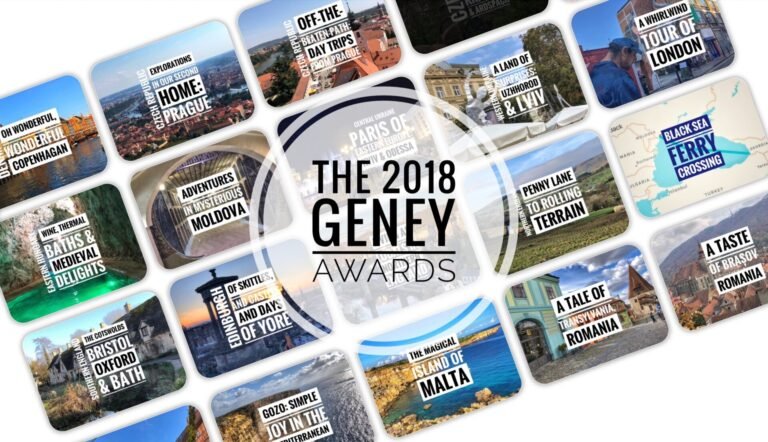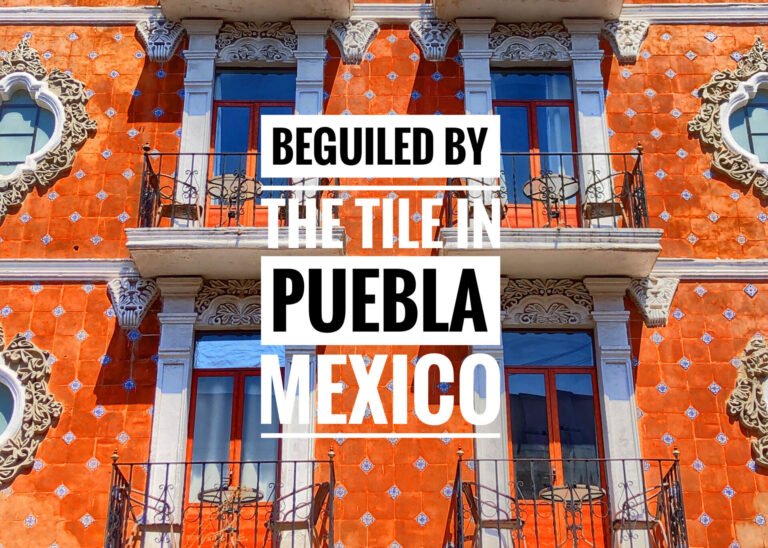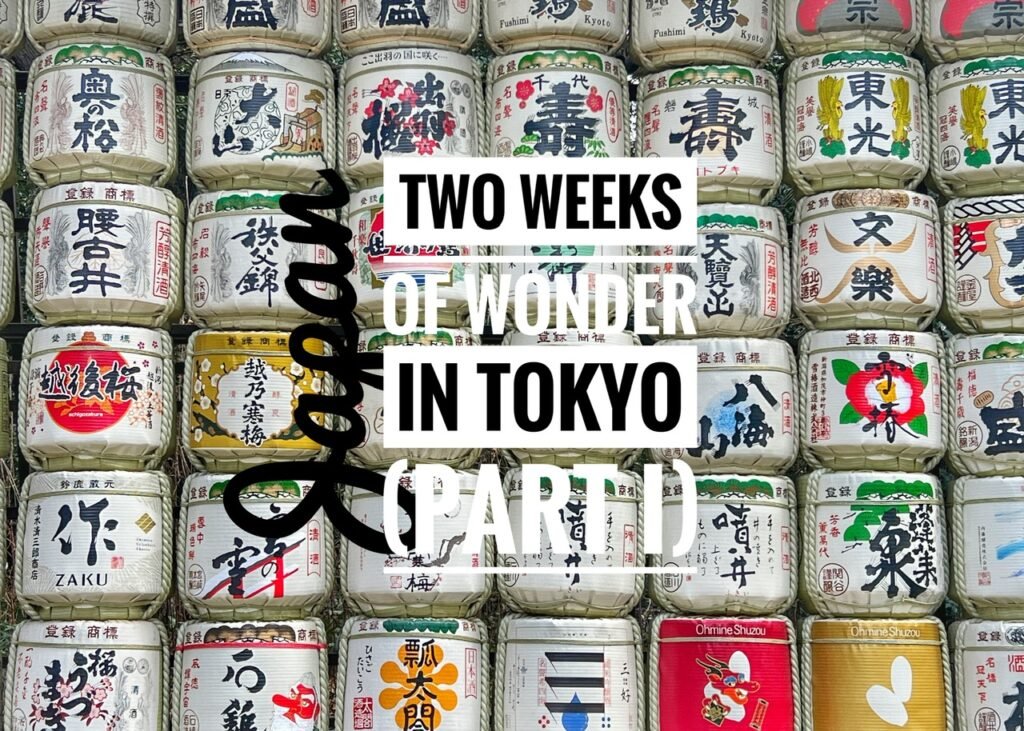
Arriving to Tokyo & the Battle of Jet Lag
In mid-February 2024, the day came for us to leap the pond…again. But, this time we were westward bound just in time to leave US election coverage behind for a year. Shucks.

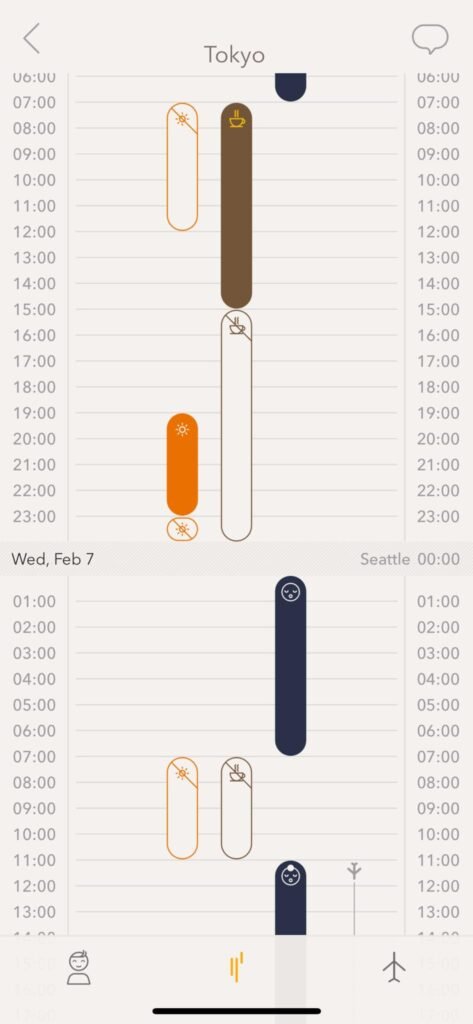
You may not recognize the badasses we were wearing sunglasses inside because we were testing out an app called “Timeshifter” which is supposed to adjust your circadian rhythms for jet lag starting two days prior to your flight. Greg looked like a cool Jughead Jones and Mandy just looks sad. Neither were true and for the record, we were surprisingly not mistaken for any celebrities. In reality it’s very difficult wearing your sunglasses until noon two days in a row. Really messed with your brain.
The app tells you when to be in the dark, when to sleep, when to get bright light, when to take melatonin, and when to drink and avoid caffeine. You can see we got no caffeine this morning. Another reason one of us is grouchy.
We would soon be flying a 10-hour nonstop from Seattle to Tokyo. The flight was $11 and only 42,000 Capital One Venture points for both of us. (That’s the equivalent of about $420.) We grabbed them last March during a deal they were having to transfer our points to Virgin Airlines at a 30% discount….more benefits of our Capital One Venture card.
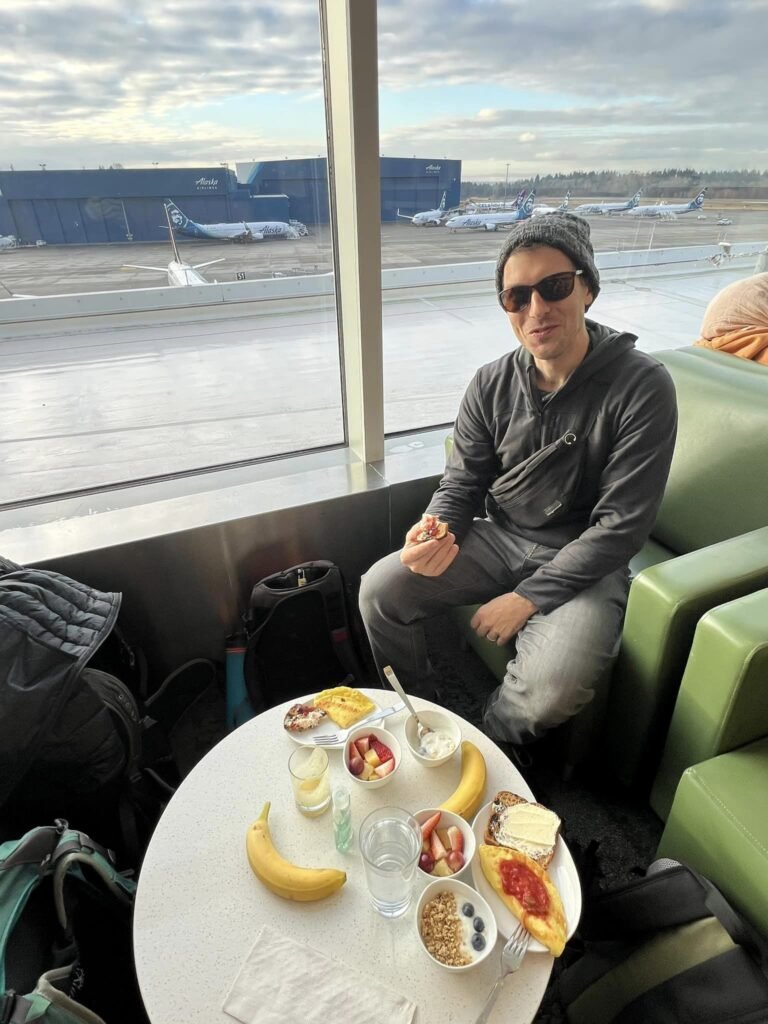

Greg would soon start pouting because Mandy tore him away from a sunshiny Seattle (!) window and tucked him in a dark corner with his free cheddar omelet and 9:45 obligatory glass of lounge wine to go with it. The Club SEA is definitely the nicest US lounge we’ve been in. It’s very roomy, had excellent food options and decaf lattes to “punish” ourselves with. While sitting here, we perused the “Travel Atlas” and continued learning key phrases for our wild tastebud and cultural adventure which was about to begin.

Once on the plane, because our Timeshifter jet lag app recommended we fall immediately to sleep, Greg didn’t waste any time suiting up. Mandy, who prefers to wait until the seat backs can recline a luscious two inches, took unsolicited selfies of her husband in the meantime and incredulously resisted the calls of the planes movie selection.

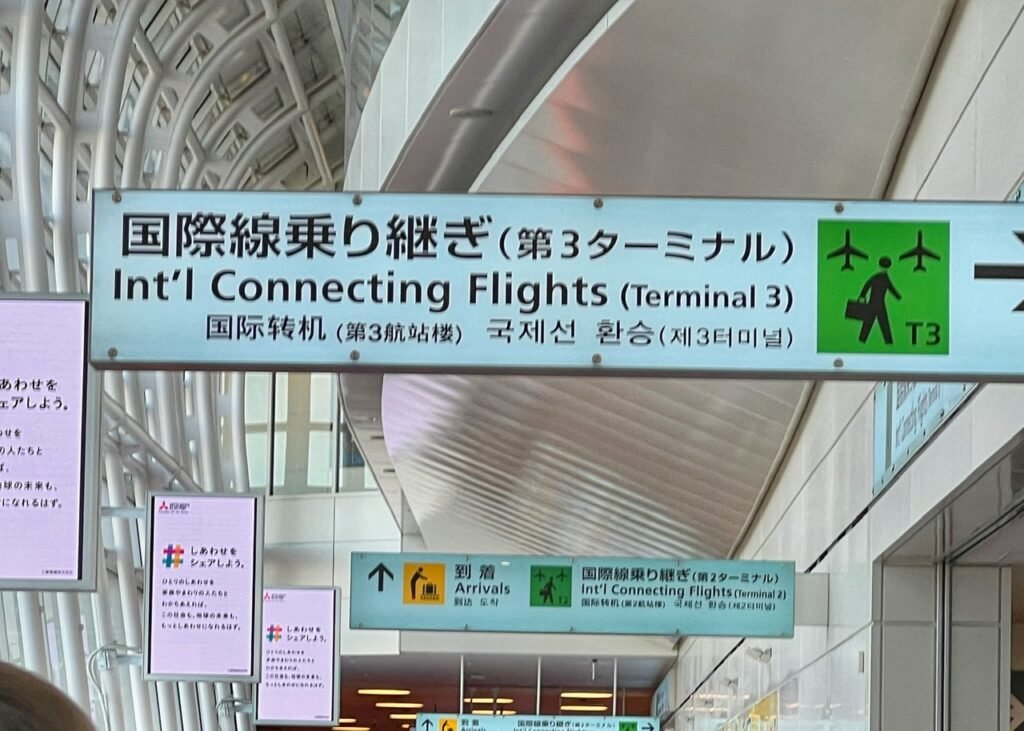
She also tried on her new shoes courtesy of Delta Airlines. For the record, when you fly an Asian airline you typically get exciting treats like toothbrushes and sanitizer as well. Hmmpfff. Thanks to a dose of melatonin taken before boarding, eye masks and ear plugs, we fell fast asleep until the one thing you can’t plug easily started working…our noses, which blasted into overdrive by the aromas of savory plane food. Considering it was 12:00 our time, yes, we woke up for our Indian butter “chicken” and potato salad. It wasn’t terrible and the bottom line is we slept much better with full stomachs. Maybe an equivalent of 4-5 hours each. So not terrible and not terrific.
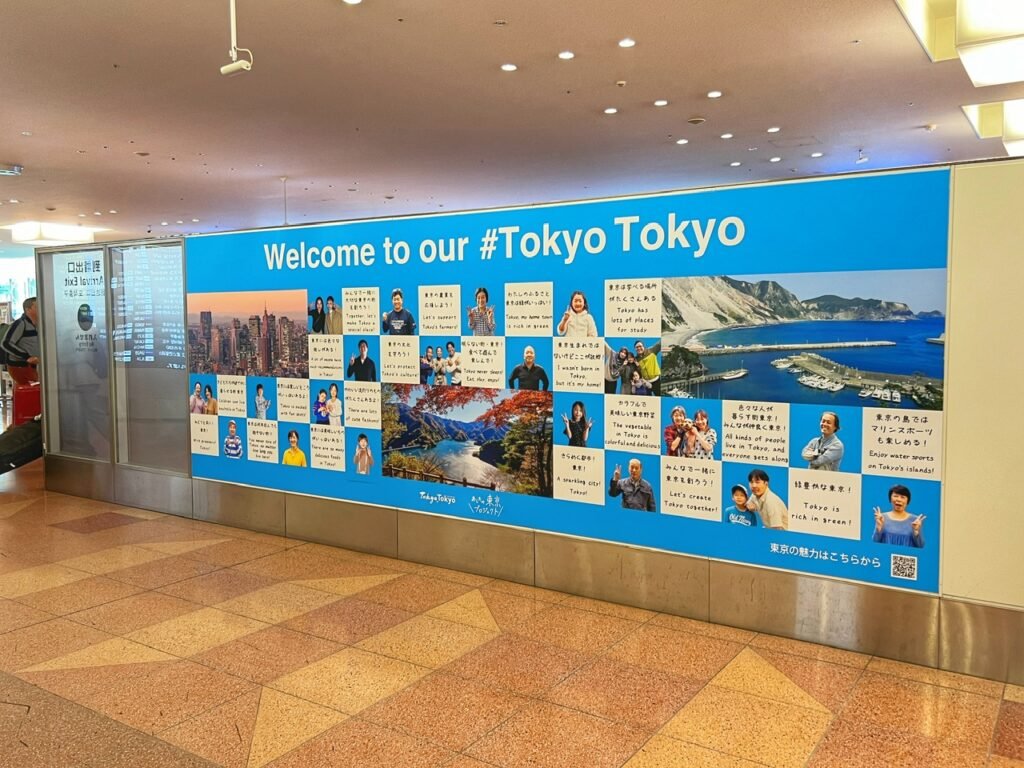
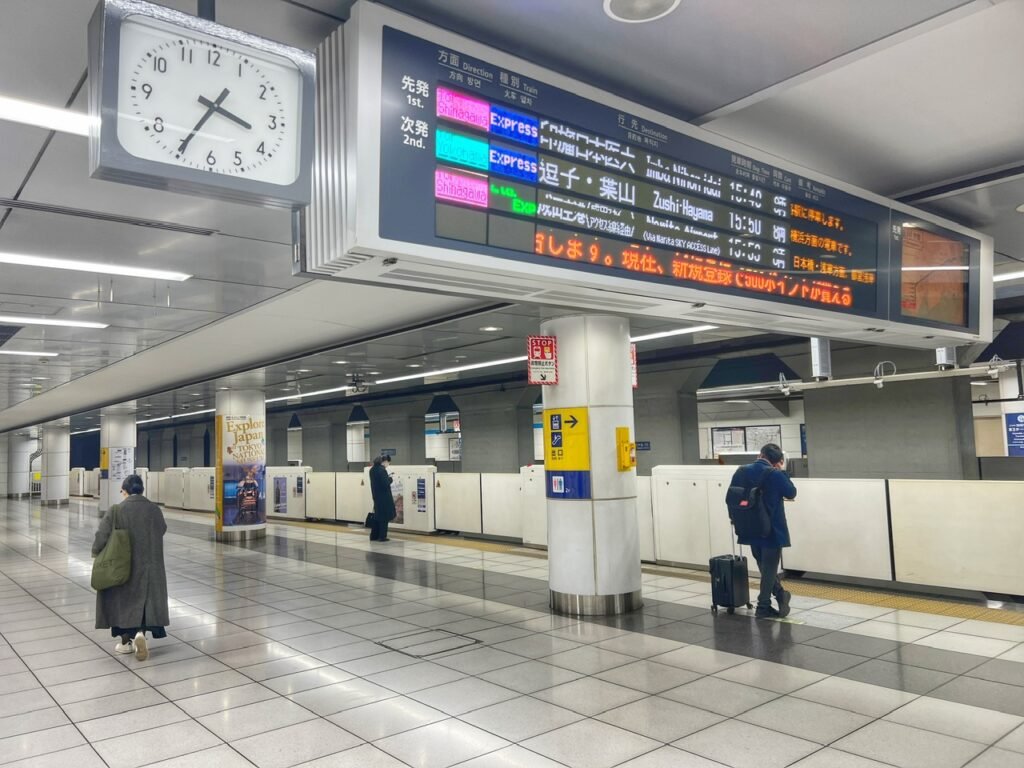
Soon we arrived to the “Land of the Rising Sun.” A notable one for Greg as he reaches his 75th country milestone. The 10-hour flight was smooth and blissfully crying baby and coughing-free as we time traveled to 3 pm February 8, from 10 pm February 7 in Seattle. Otherwise known as, time for bed. Thus, we were diligent about following the jet leg app recommendations.
Upon landing we immediately wandered around a bit in sheer awe at everything, even at the airport, and arrived to our hostel without any major hiccups. When we landed, we were greeted with signs in Japanese, Chinese, Korean and blessedly, good ‘ol global English. Bonus cookies to those who know the difference between the other three.
After efficiently being stamped into the country for our allotted 90 days, we had arrived. And no, we are not staying our full 90. Our budgeting prowess is definitely not that good.
Greg had bought and preloaded our SUICA transit cards from the comfort of our friends in the States through their convenient online app making transit mostly easy. Unfortunately, we did have to also download a card on our backup phone to account for both of us and were unable to share one card. Google maps worked beautifully in helping us navigate to our destination.
Arriving to the train platforms, we encountered a sealed track to avoid the suicide attempts you hear about in other countries. You are supposed to stand on either side of the doors to allow for the opening ones to flow out in an efficient process.
A few things about riding Tokyo transit…
- it cost us about $4 to go an hour from the airport to the Asakusa District
- if you must talk, do it in hushed whispers only
- you will be one of about 50% wearing or not wearing a mask
- you will find yourself in a sea of Juppies. (Japanese yuppies, ©️)
- Try hard to avoid rush hour between 5-8 pm. Thankfully we did.

The complete ramen network of lines that flow through Tokyo is unbelievable…and 6.84 million bodies pass through them each day. Seriously, thank God for Google Maps. Reading this would be quite challenging!
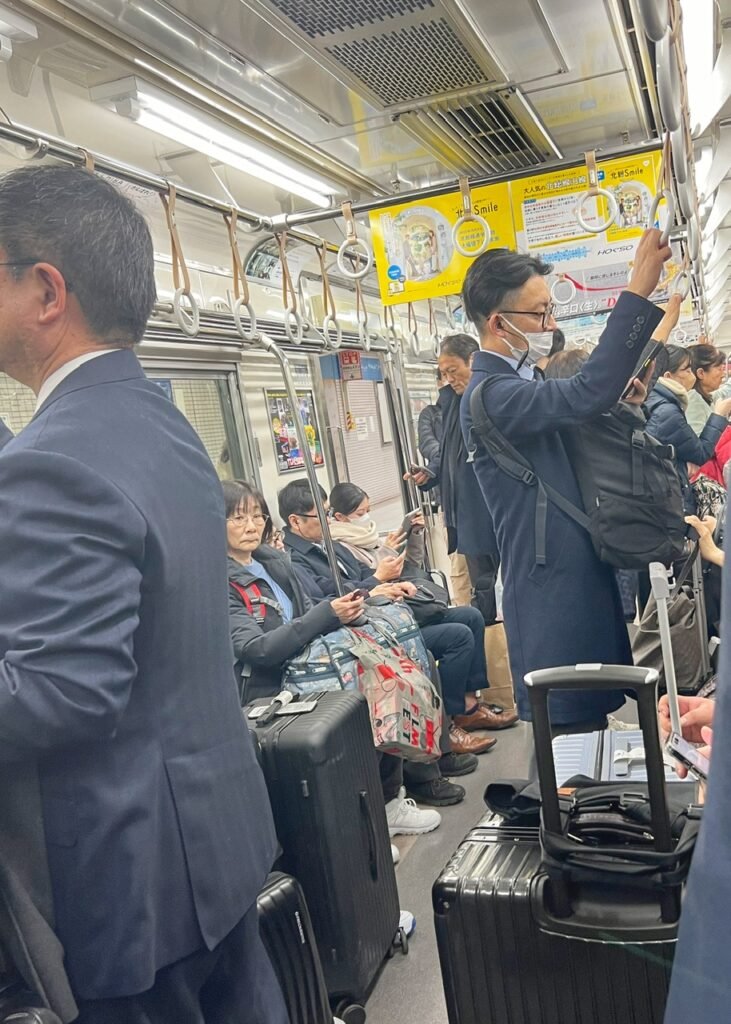
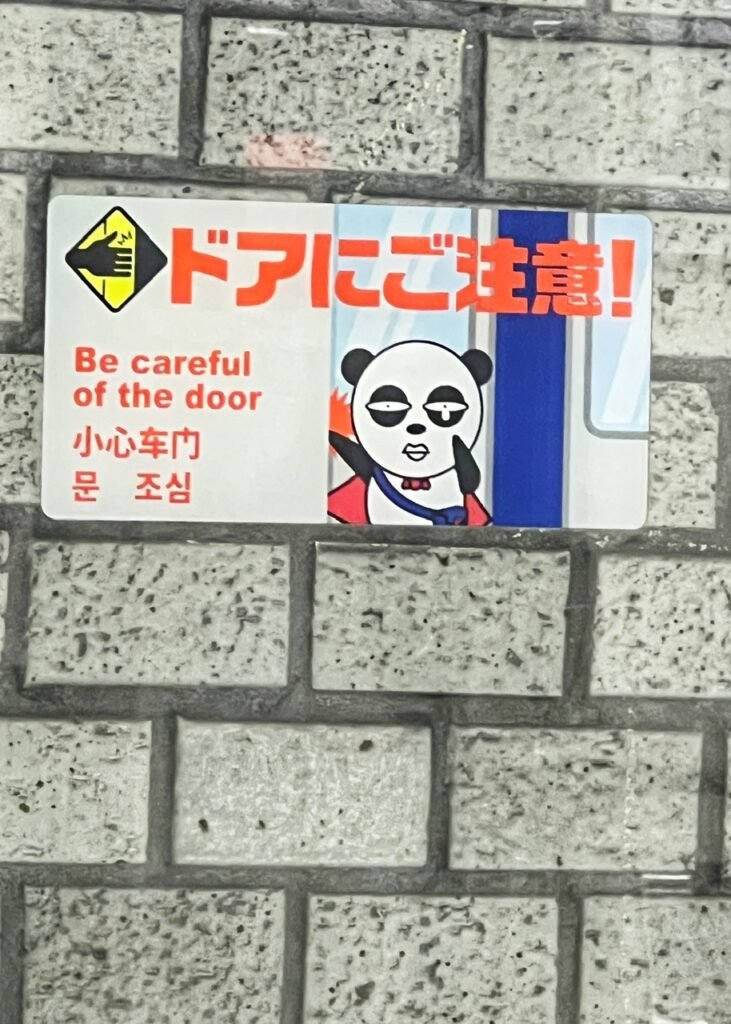
You know when you’re in Tokyo when there’s a crying panda telling you to be careful of the door rather than a staunch Brit telling you to mind the gap.

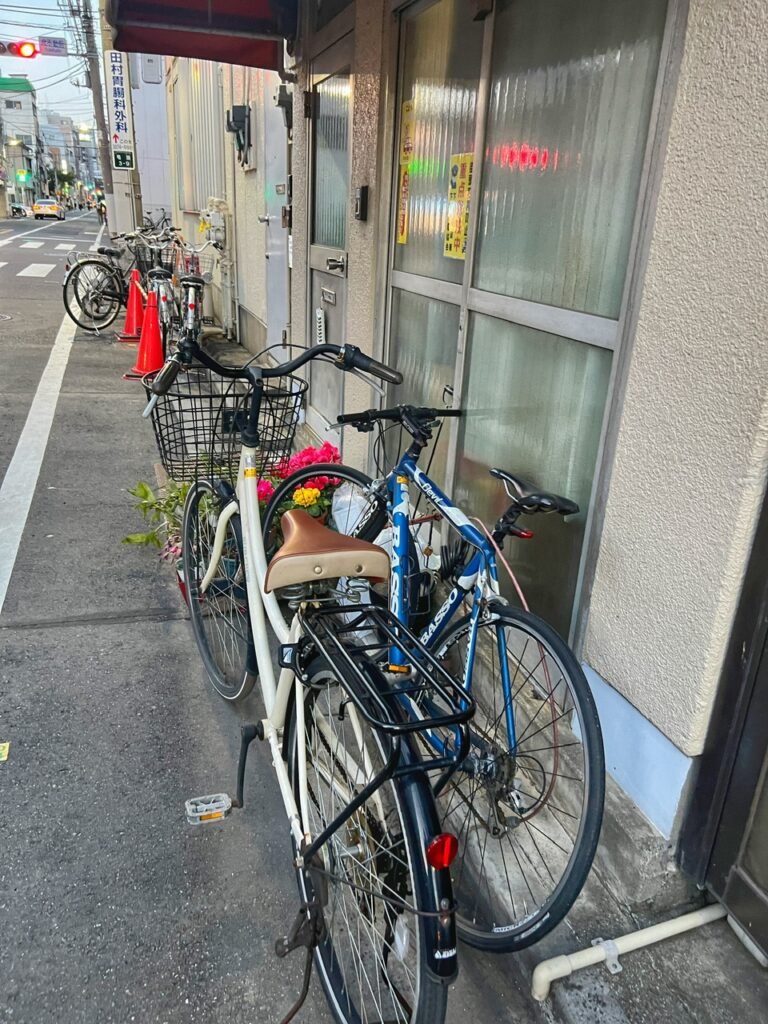
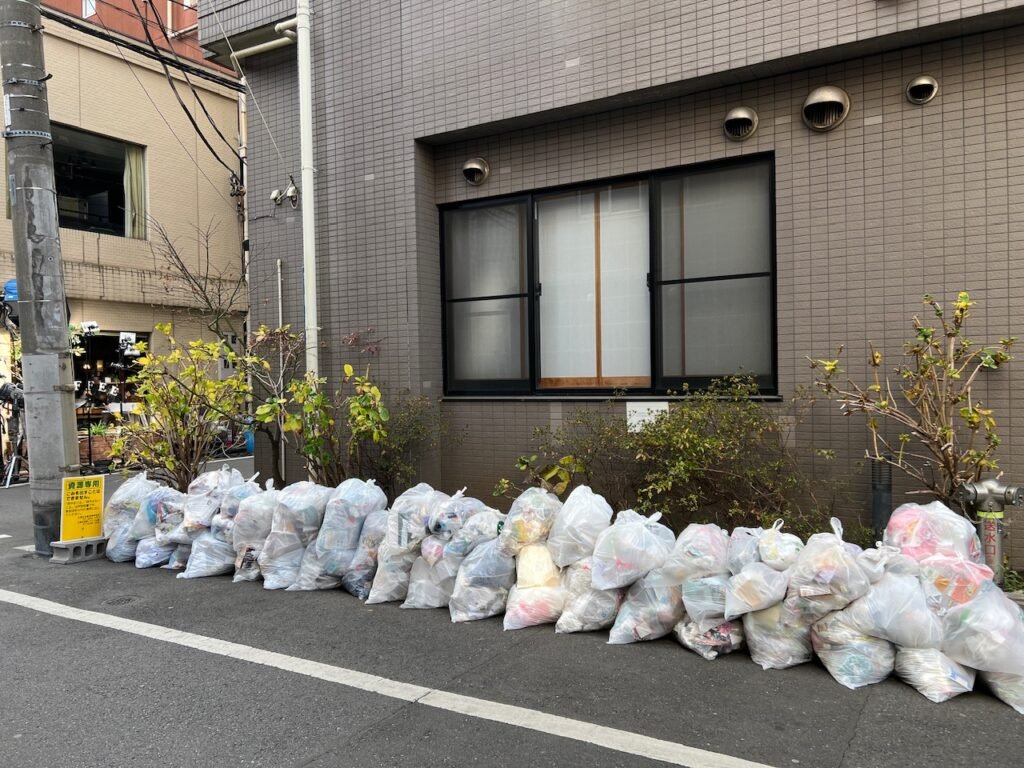
A few other early observations: All walking, stairs and driving should we done on the left in Japan. On the walk to our hotel, we passed multiple bikes that appeared to be unlocked. In a city of 40 milllion?! Unbelievable. We also passed the most organized bags of trash we’ve ever seen.
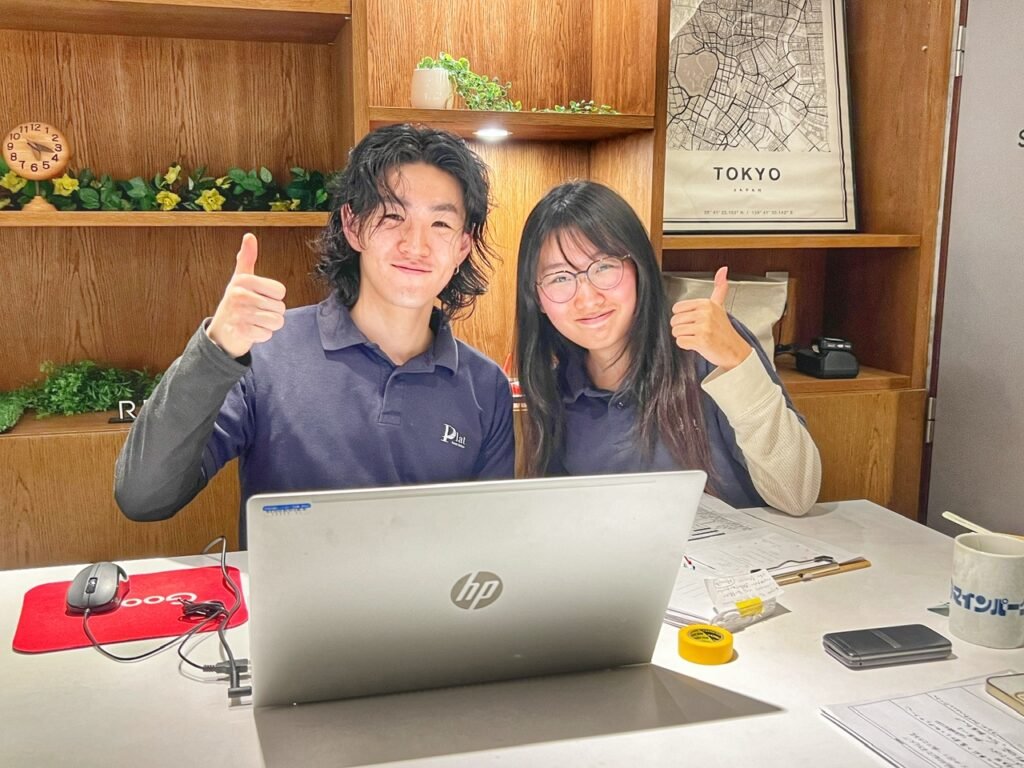
Arriving to our hostel, we were greeted by Yuki and Ayuku who checked us in.

For the first two nights we grabbed a private room so we could get through our jet lag in comfort. It was free, and we used 12,000 United Airline points a night (the equivalent of about $60/night)* and consisted of a small room with a bed on a platform, and a shared bathroom.
*we got this chunk of points through the United Explorer Card last March. Although we don’t have it anymore we still recommend it for a quick points grab, as there is no annual fee for the first year and a 60k sign up bonus.
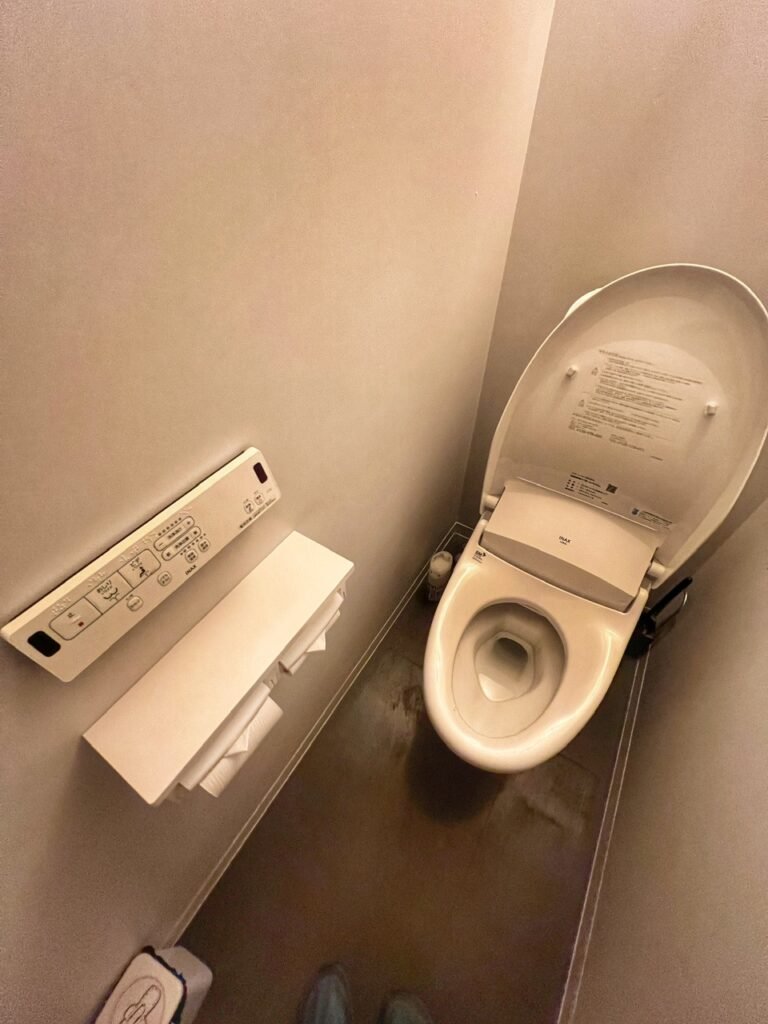

Usually toilet stories from abroad are full of regret, shame or holes in the earth, but in Japan it’s full of wonder, excitement and some serious tushy temptations. That’s right…welcome to the Japanese toilet, where your bidet and spray is built in and adjustable to various water pressures and locations, where you can turn on privacy “music” which is basically the melody of a toilet running, and let’s not forget the most important feature…your bum will never get frosty from that porcelain throne because the seat is heated for your pleasure. How does the rest of the world cope missing out on all this toileting fun?!
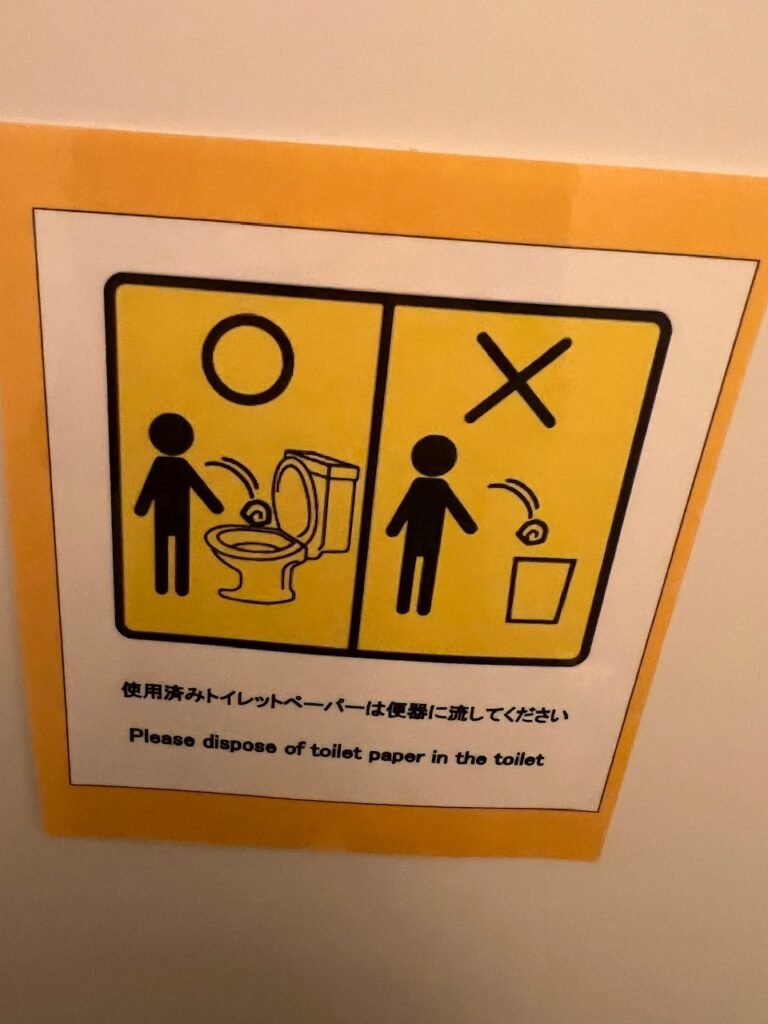
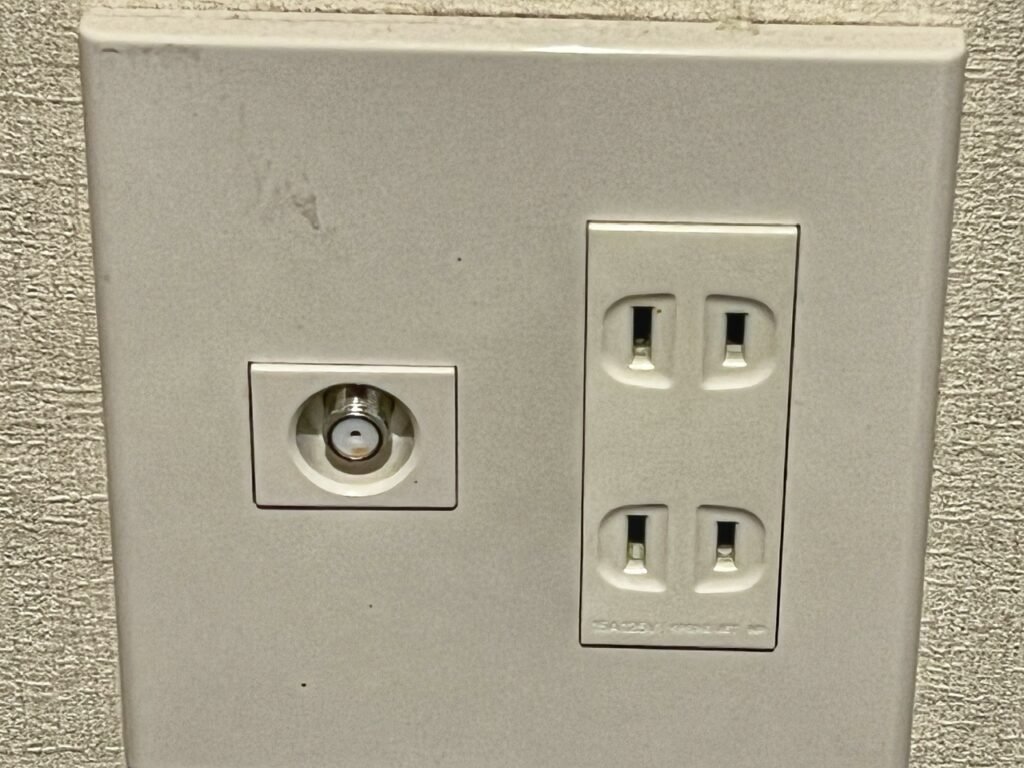
Speaking of the rest of the world, now this is a shift from our last year in Latin America! 🤣 Also, your toilets may be superior but our US devices fit snuggly in these holes!
Fighting Jet Lag on Night One

There’s no better way to boost your jet lagged energy level than wandering out your door and finding yourself in Japan for the first time. It is simply fascinating especially because for a city boasting 37 million, still the largest on earth, it was eerily quiet on that Thursday night. Maybe it was just our floaty jet leg feeling, but it seemed like a Black Mirror episode, where the cars rolled by without engines (god forbid a horn), the sirens were muted and the people were all talking in silent whispers.
A 20-minute walk from our hostel led us to marveling at vending machines, exploring the dreamy and nearly desolate Sensoji Temple Complex, grabbing our first ramen, and having a surprisingly inexpensive beer adjacent to to a golden turd.
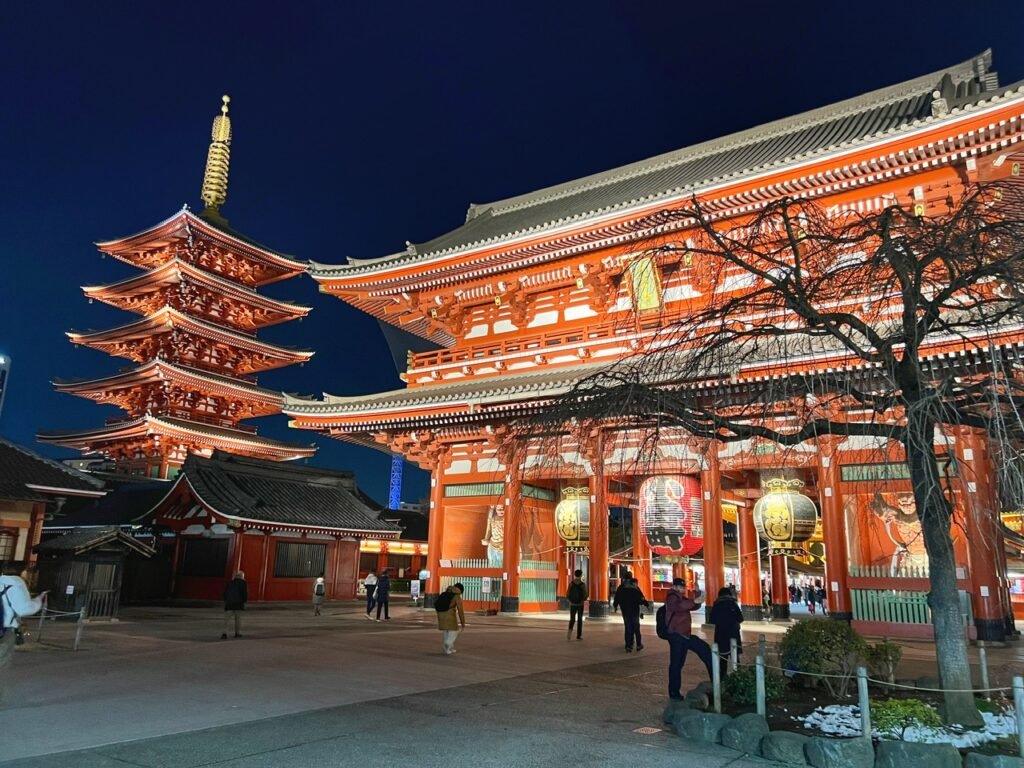
Tokyo’s oldest Buddhist temple, Sensoji, dating from 640 AD, was built to honor Kannon, the goddess of mercy. It’s is framed by the five story Sensoji pagoda, the second tallest in Japan and what we’ve been dreaming of since the fake one at Disney. Pagodas originated from Indian stupa buildings, and were designed as Buddhist monumental structures to hold important relics and artifacts. They were traditionally built in the center of Buddhist temple structures, but later grew to be more stand-alone buildings and were sometimes constructed in pairs. (Study_com)
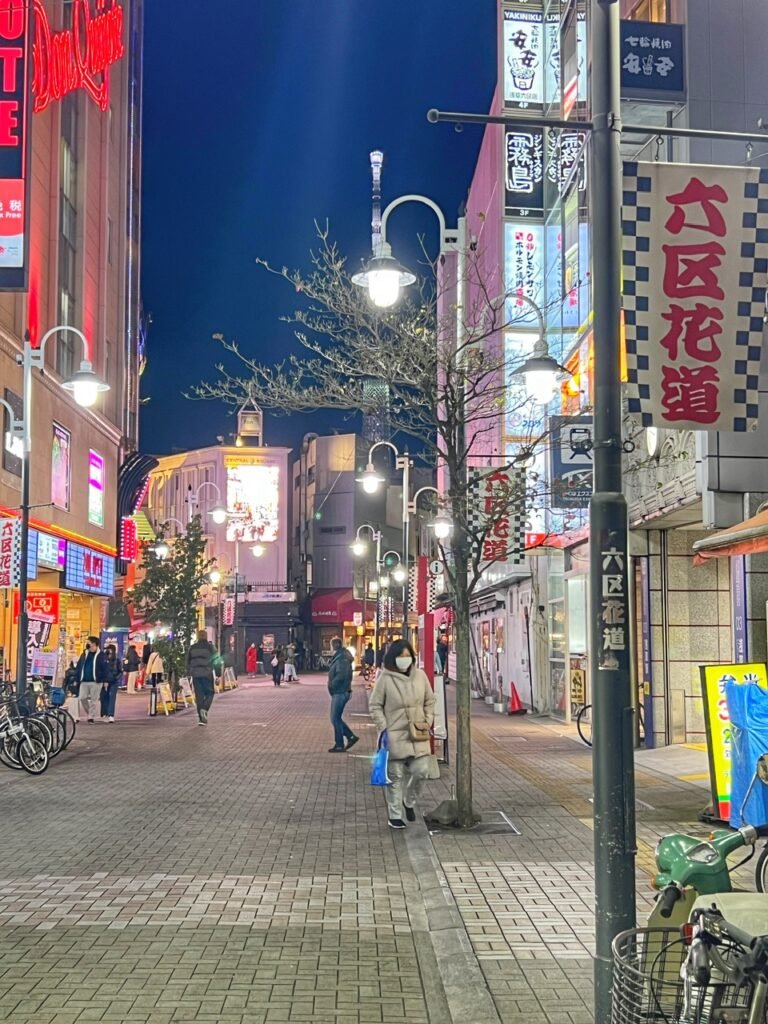
Asakusa (pronounced ah-sak-ooo-sa) street scene with Tokyo Sky Tree in the background
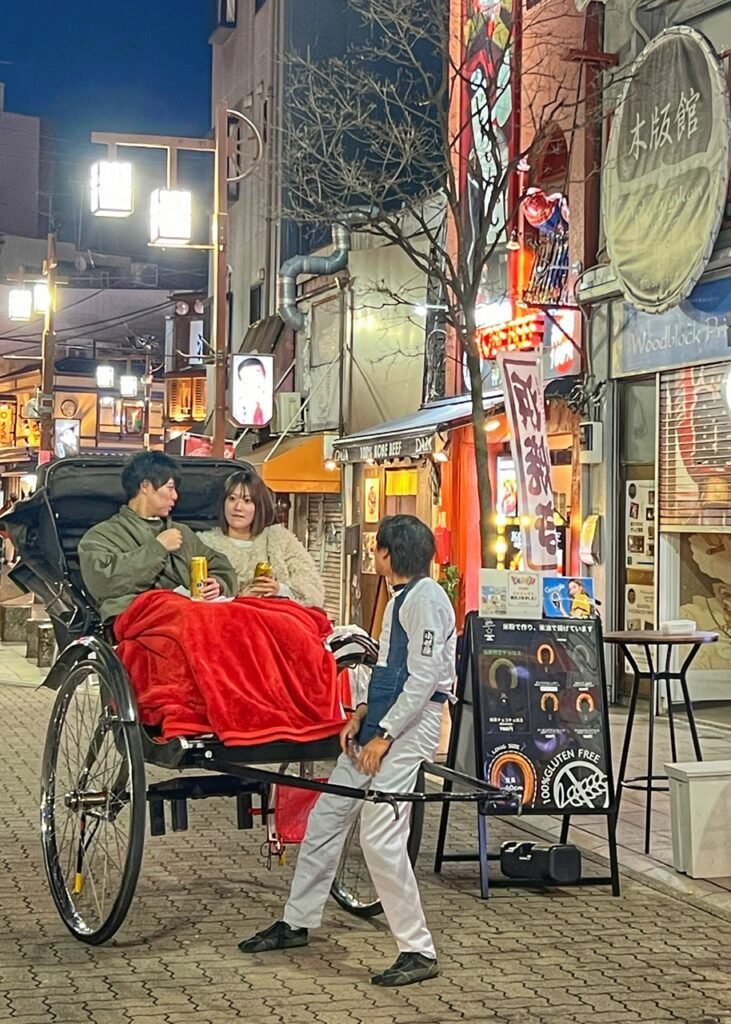
A couple snuggles warmly in the back of a Japanese rickshaw. It dipped into the 30s F (around 0 Celsius) at night so still quite chilly although the daytime temperatures are much more springlike in the 50/60s. (Mid teens C).
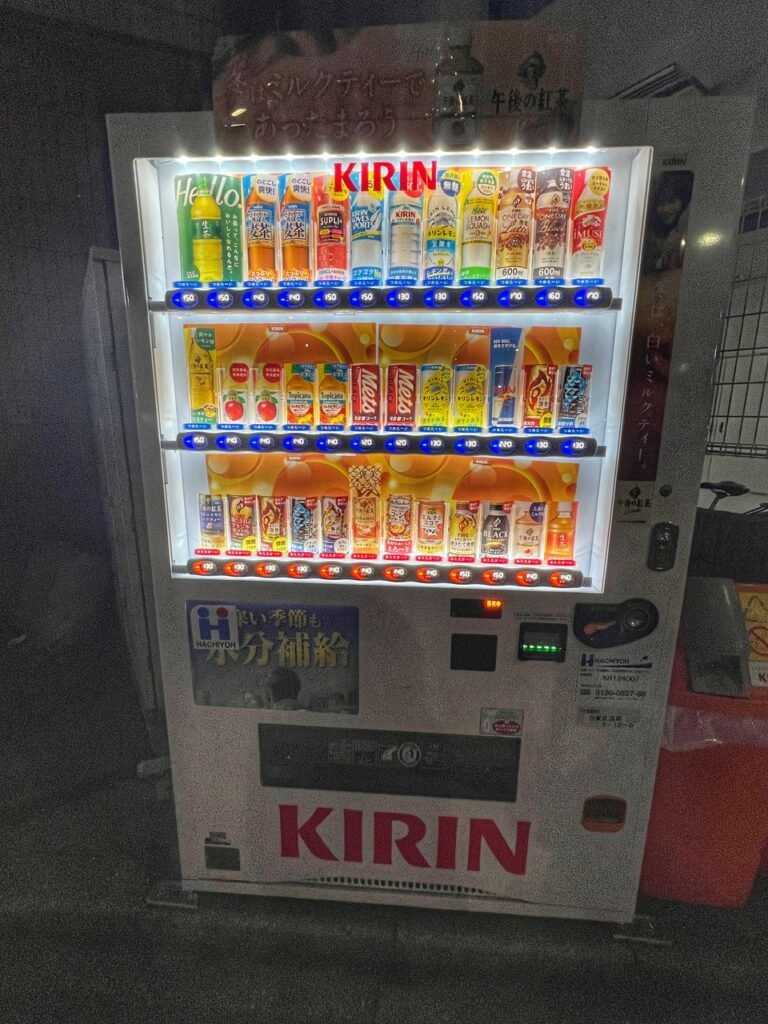
Apparently, Japan has the largest density of vending machines in the world and we quickly discovered it’s about one per block, or about one for every person. Imagine that!! Your own vending machine!!
Based on blogs and instagram, we thought we’d be running into ones with beer, cursed items, pet food, and underwear for sale but in the beginning before we did some searching, it was just coffee, juice and soft drinks. That said, most of them were unrecognizable to us ‘Mericans.
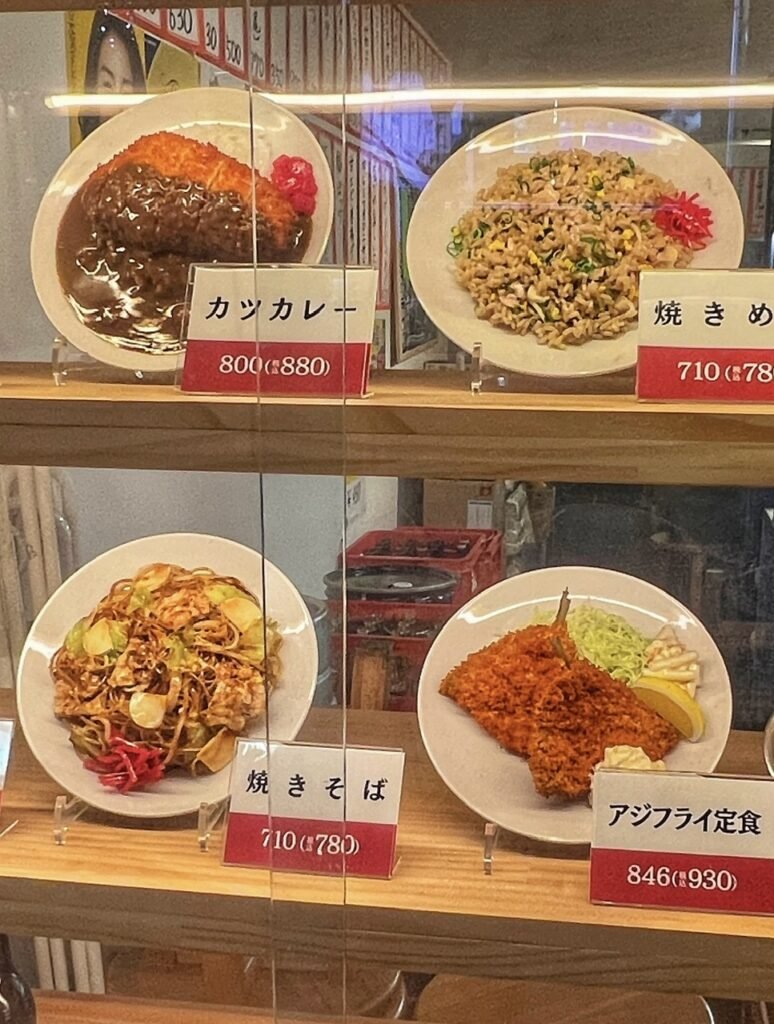
Who needs fake food pictures when you can have the 3-D way better than the Fischer Price version?! These put our plastic eggs, bananas and butter to shame we used to play with. A couple days later we’ve since found where they make these specialty fake food displays on Kitchen Street (Kappabashi Dougu Street.)
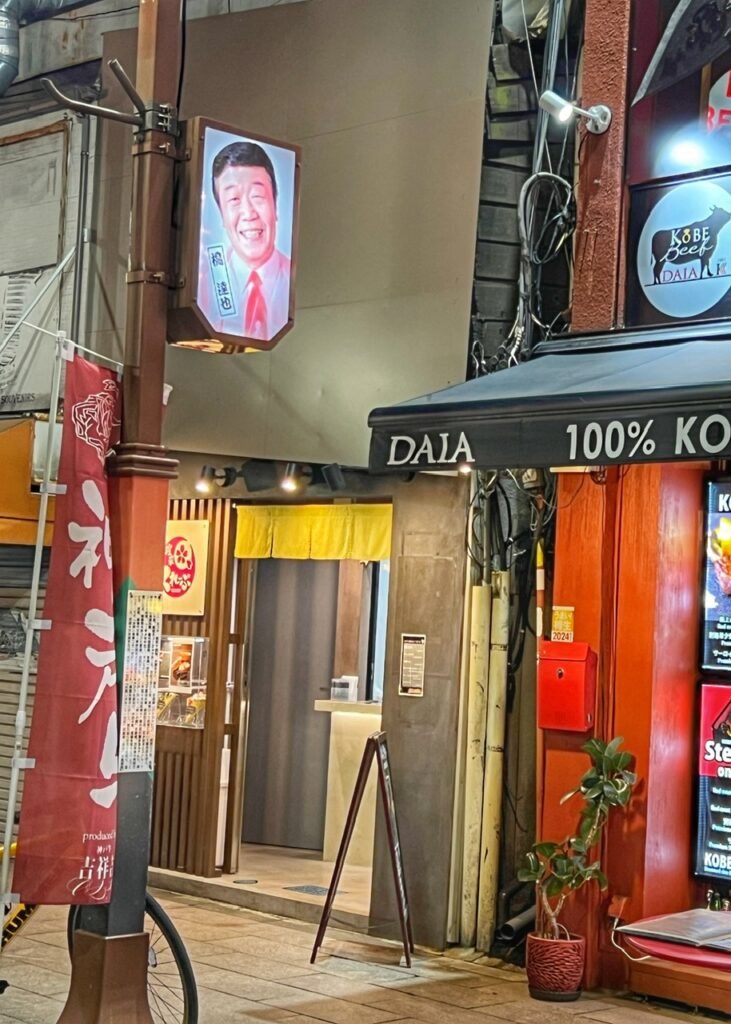
This pedestrian street in Asakusa is flanked by nostalgic and smiling photos of what appears to be VIPs.
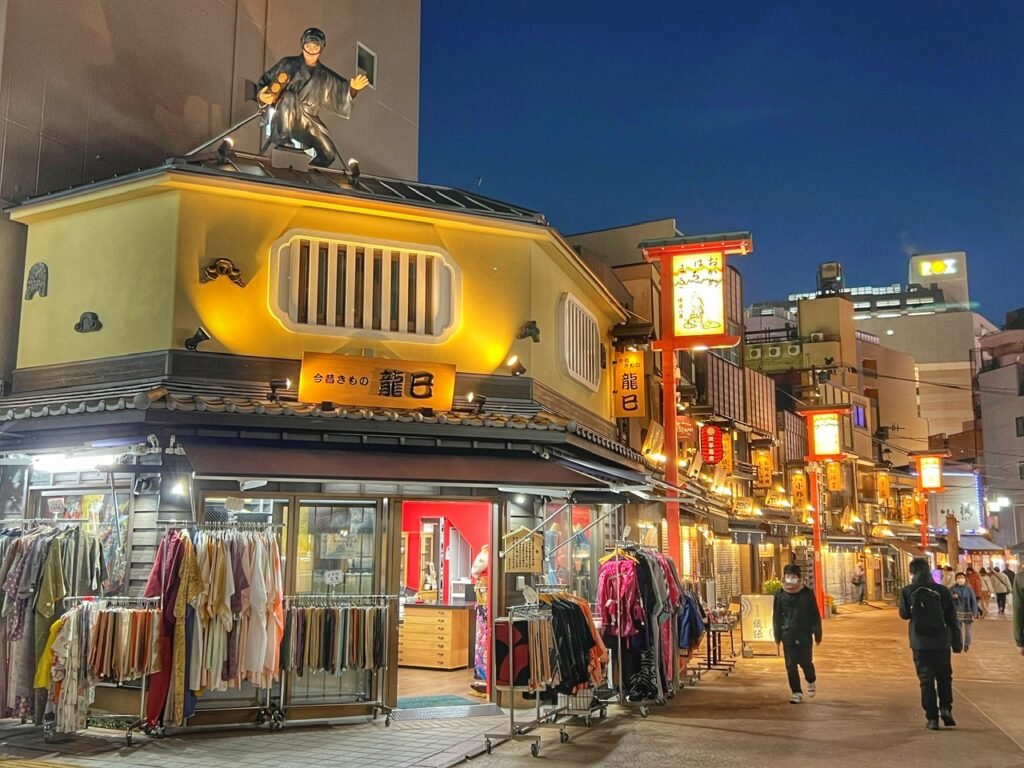
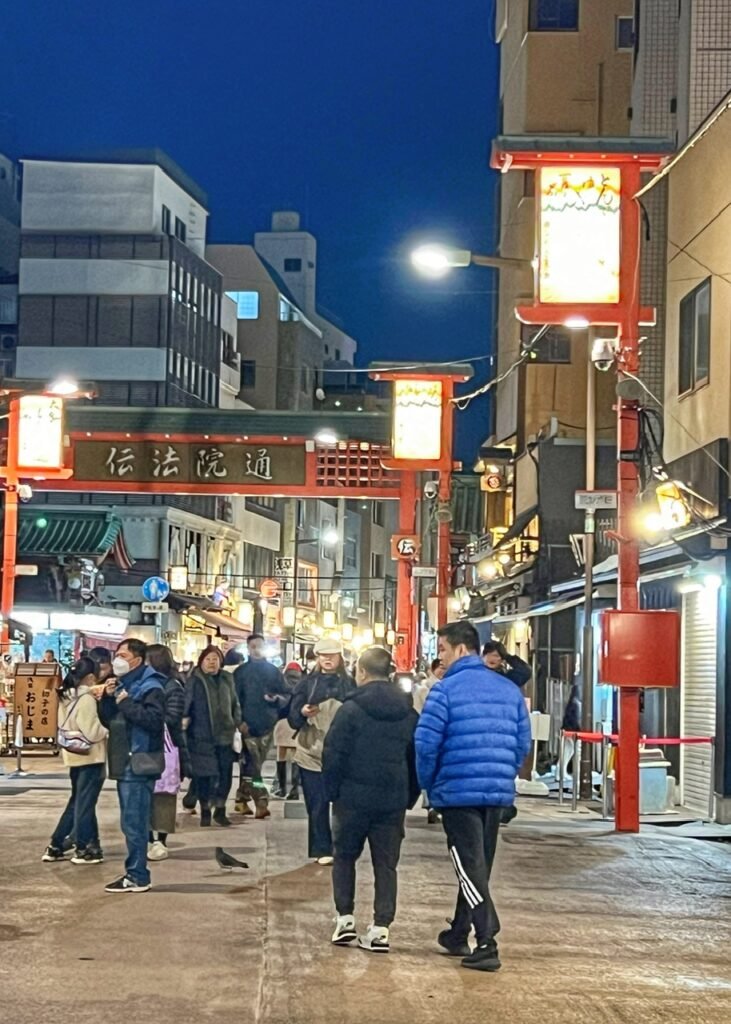

You know you’re in Tokyo when there are ninjas grazing rooftops, Japanese gates accessorizing the street, and signs everywhere telling you where you can and cannot eat. FYI, it’s considered rude in Japanese culture to walk and eat. This is kinda unbelievable considering A. Their rushed and hardworking lifestyle and B. The generous options of food served on sticks. Ah well, you should be savoring that stick meat! It’s a good reminder to live in the moment. P.s you might note the pile of snow. Heavy snow draped the city two days before our arrival. This doesn’t happen often so we’re sorry we missed it.
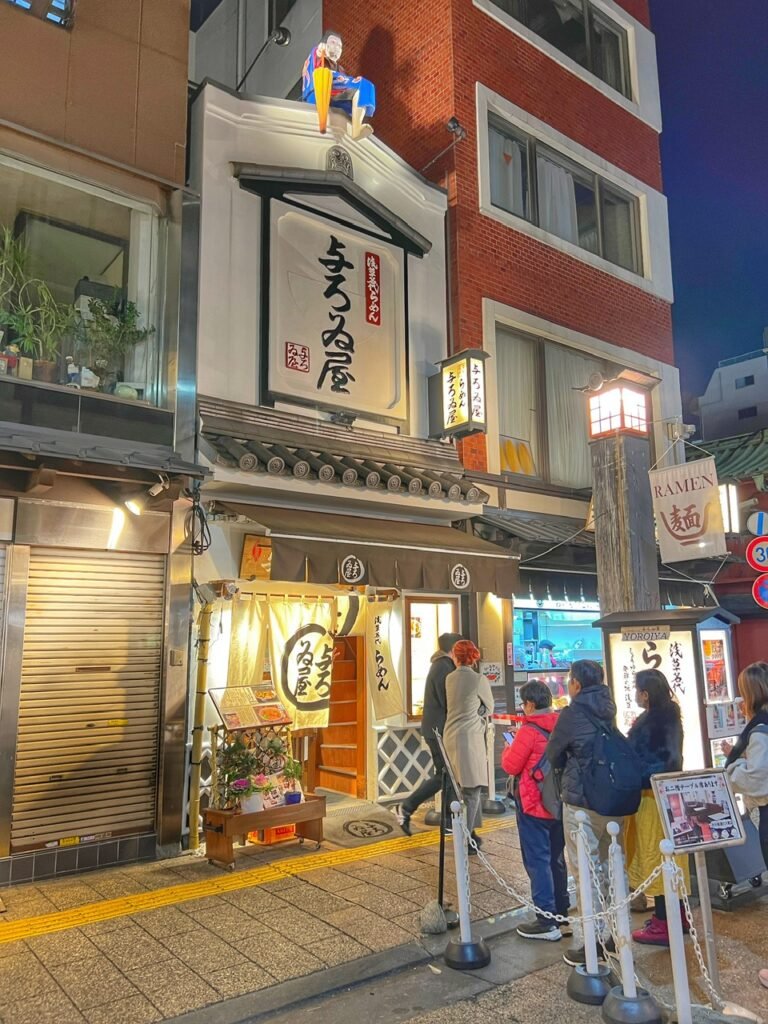
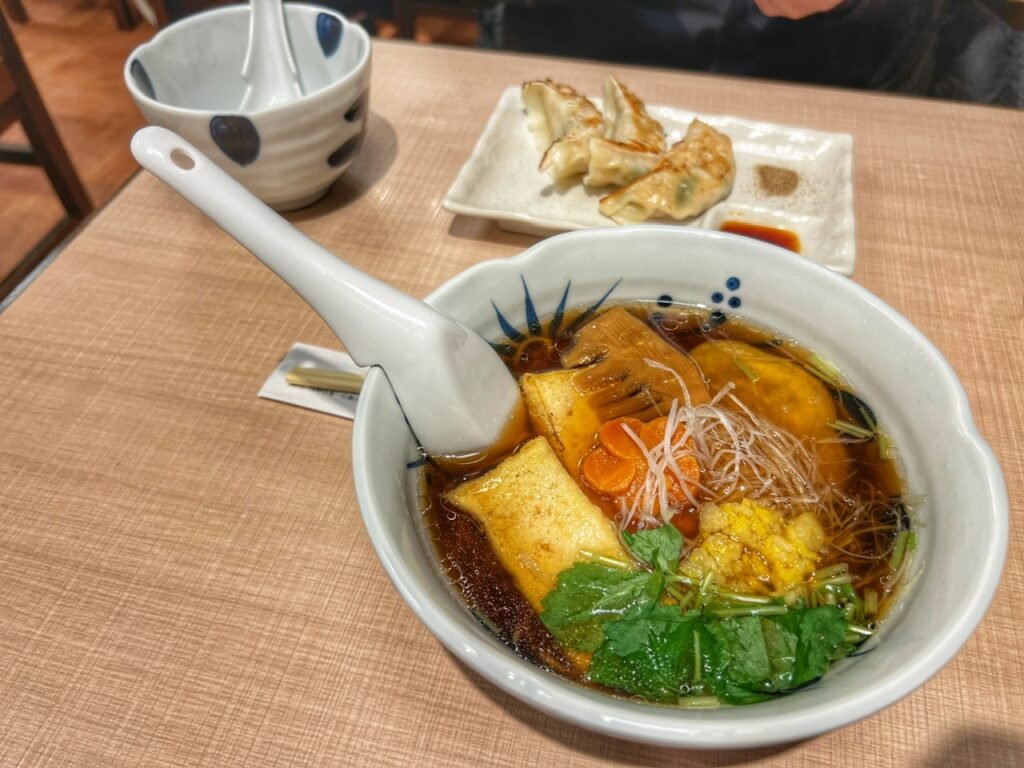
Stopping for our first meal at Yoroiya Ramen. It consisted of vegan ramen and chicken gyoza. It was delicious and cost $10 for both items.
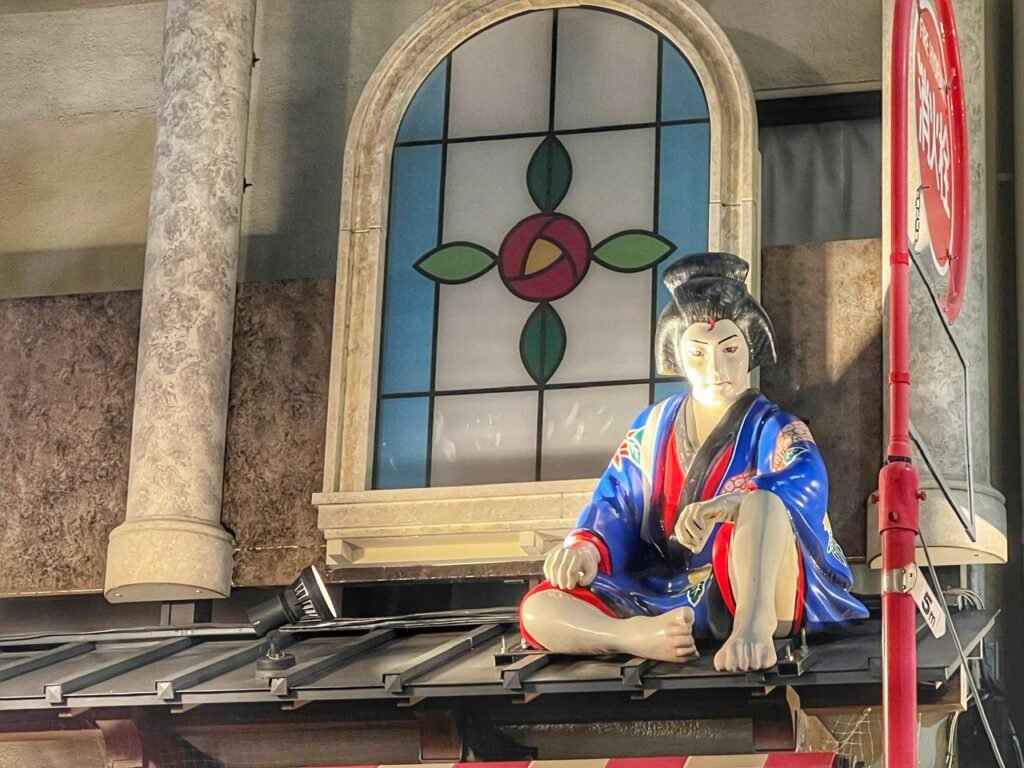
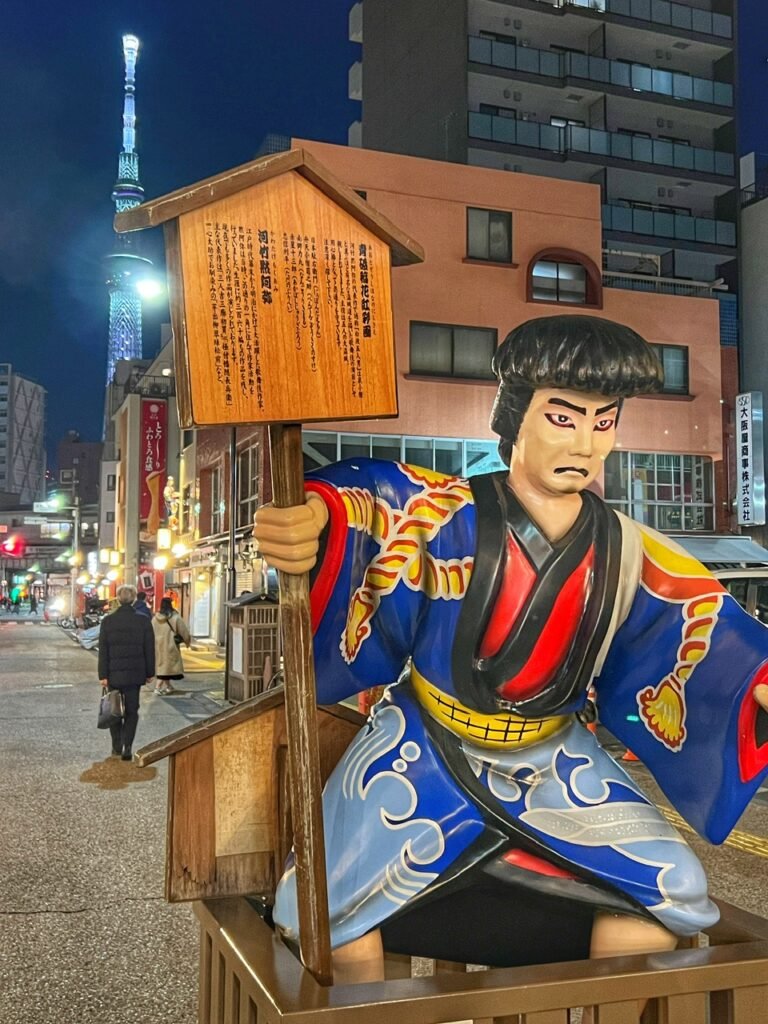
What appears to be a very unladylike geisha perched on a rooftop. This was near a sushi sergeant who seemed to scream, “you seriously ate ramen for your first meal in Japan?!”
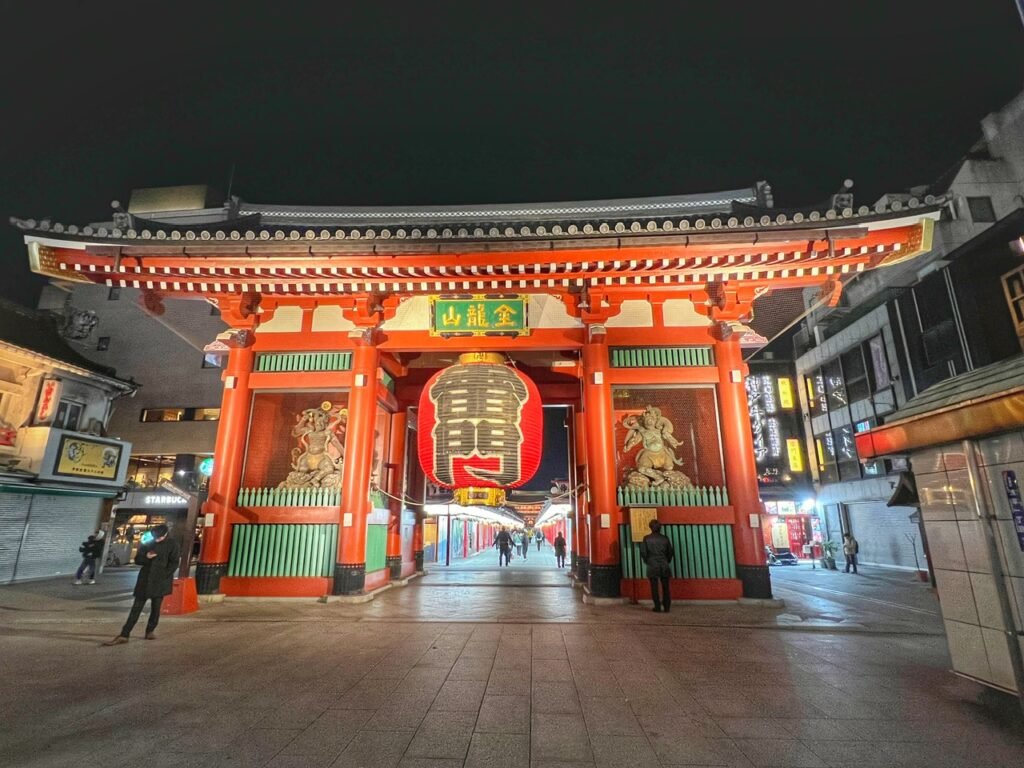
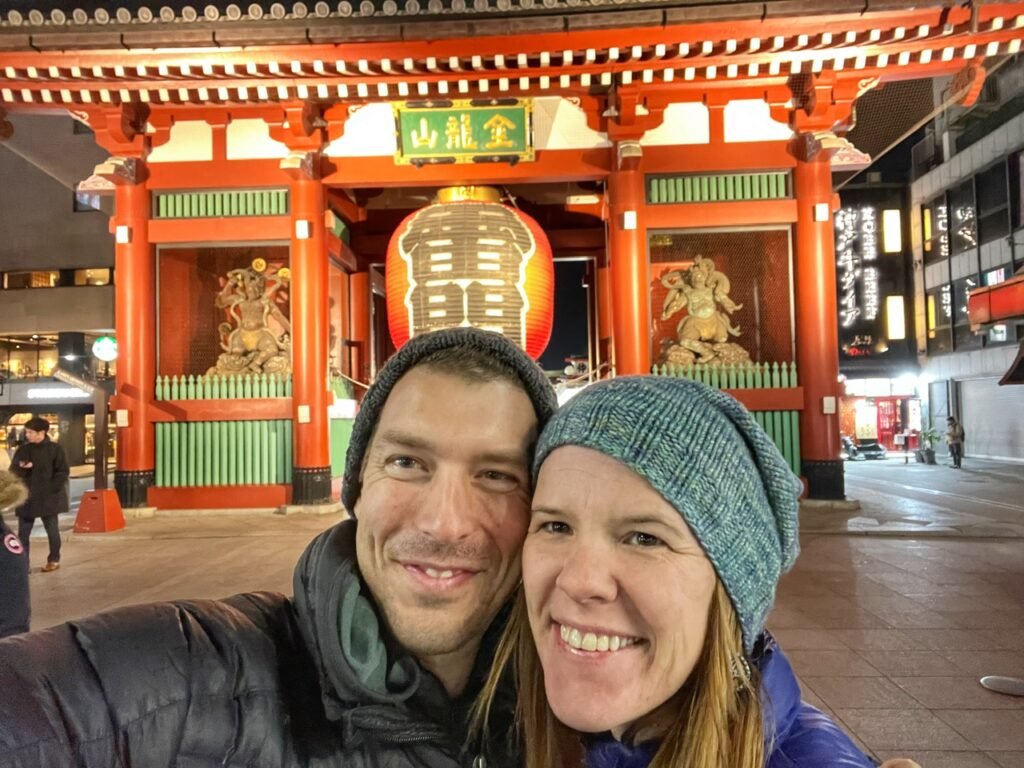
The front gate of Sensoji Temple called the Kaminarimon, or Thunder Gate. The god of thunder is standing on the left; the god of wind, on the right. It was first built 1000 years ago, but because it was set ablaze many times, this current rendition only comes from 1960. We were glad to still have our winter goodies but couldn’t wait to chuck them soon!

This giant red lantern is Asakusa’s most popular landmark and meeting spot. It is 3.9 meters high, 3.3 meters wide, and its weight is 700 kilograms. That’s a helluva lantern!
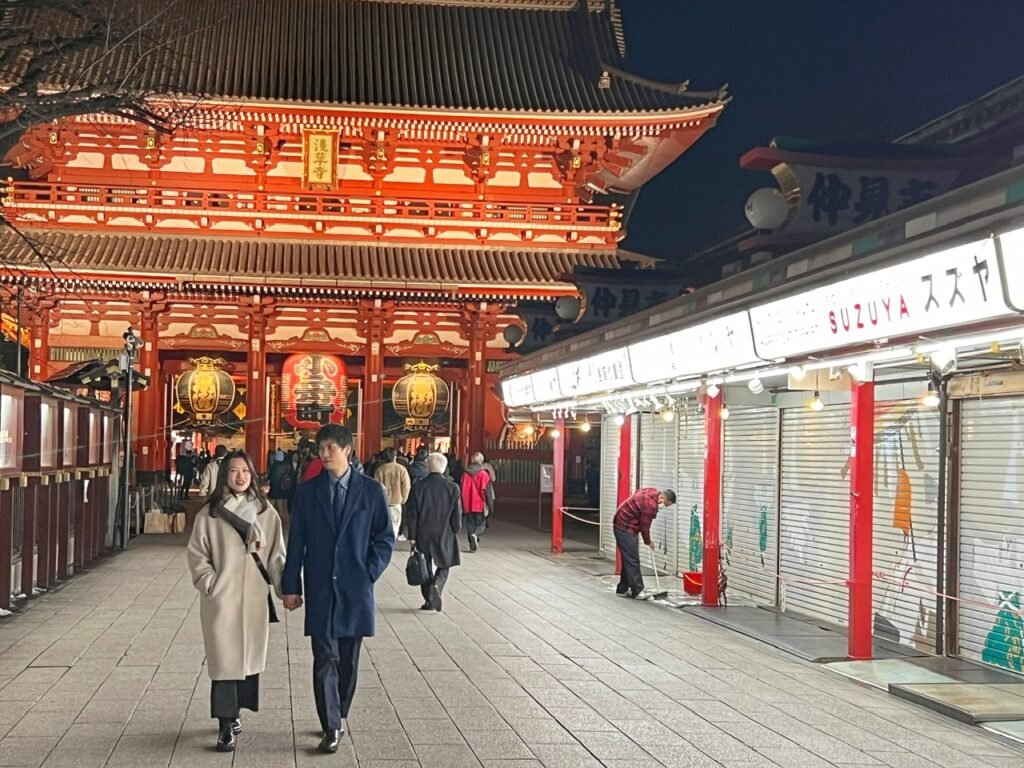
We are so pleased we had this tranquil night time experience because we visited two days later and because of the start of Lunar New Year and a Saturday, was a complete madhouse.
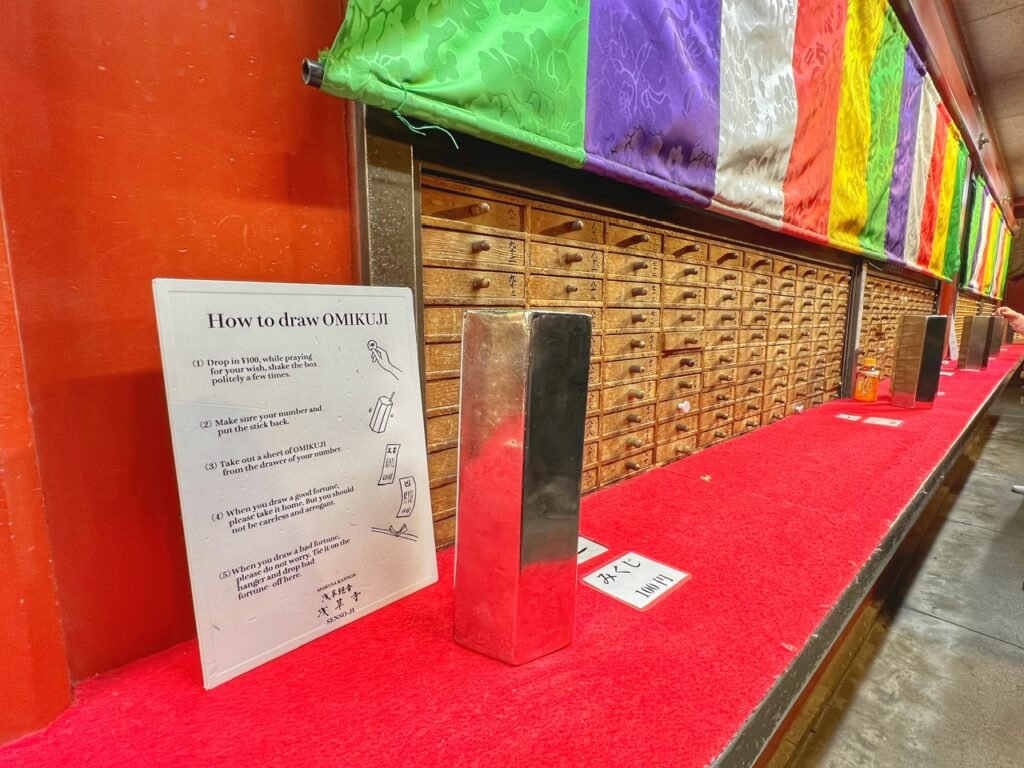

In front of the temple, visitors have the opportunity to do “OMIKUJI,” translated to “sacred lot” or basically a fancy name for temple fortune telling. We didn’t have 100 yen at the time so we had to wait to join the mobs later. If you draw a bad fortune, you have the opportunity let it float away by tying it here.

Heading towards the main temple originally built in 640.
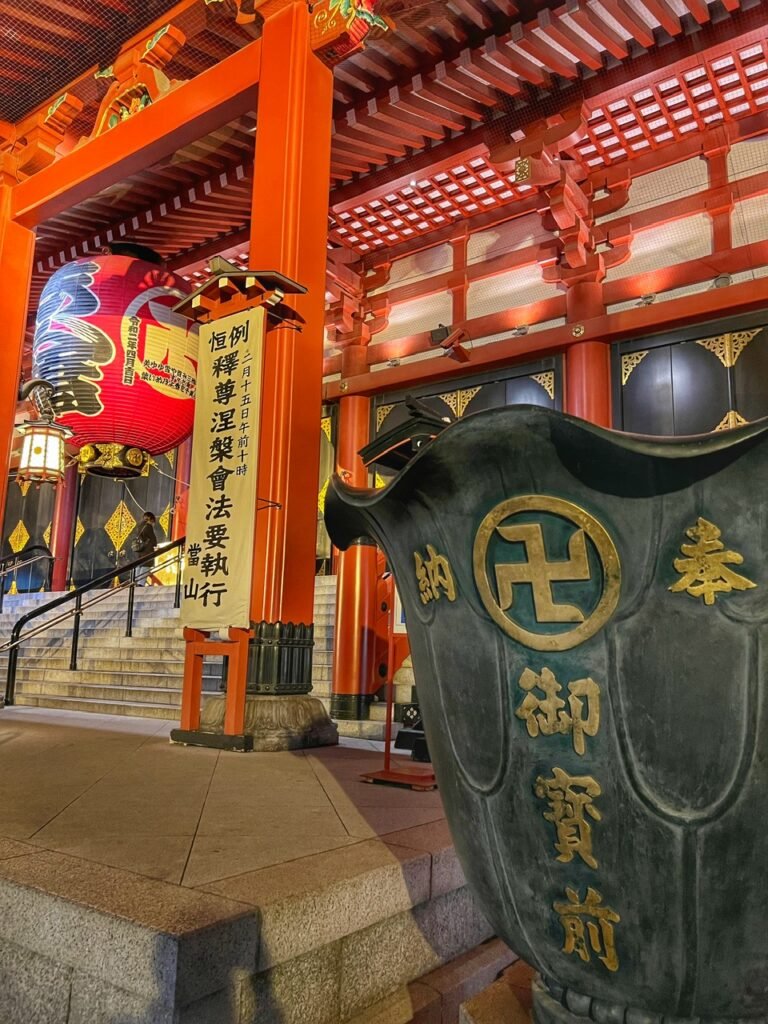
As you walk amongst Japanese temples it’s common to see a symbol that has forever been tarnished. The original meaning of the manji, or swastika symbol was an auspicious symbol of peace and prosperity. In Buddhism, it represents the footprints of the Buddha. It stands for good things and good luck, hence why it’s a common symbol to be found around places of worship. Sad how it was corrupted.
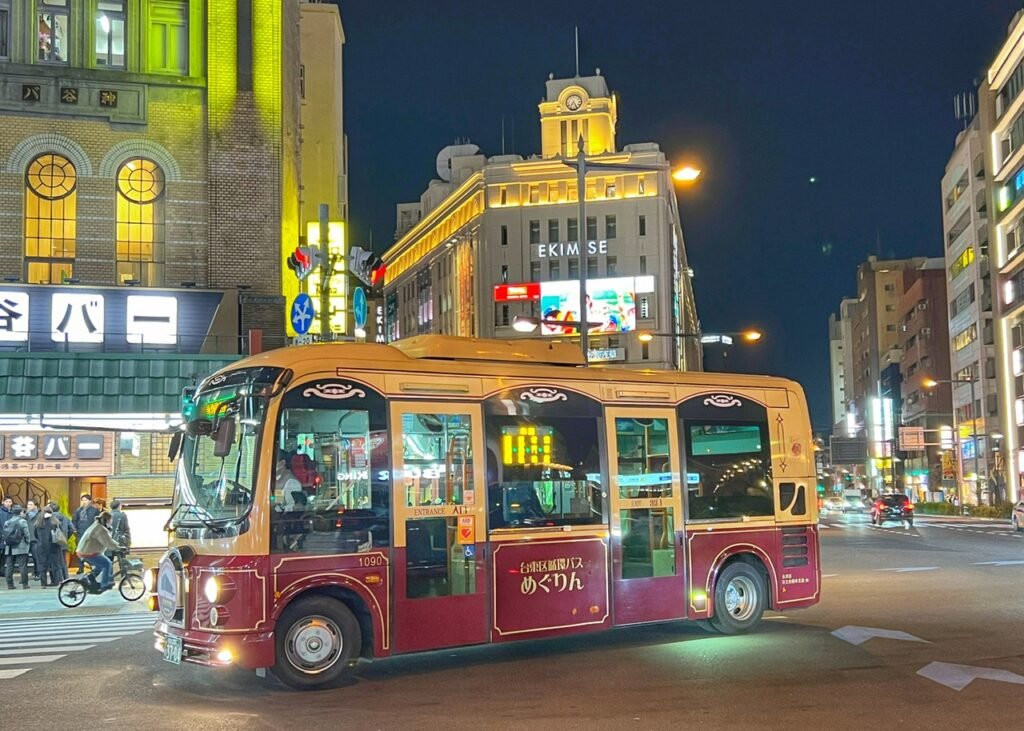

It’s no surprise that Tokyo, renowned for all things cute, has the most adorable little buses. In a different form of cute, tucked next to the Tokyo Skytree is what Tokyoites affectionately call “the golden turd.” It is actually supposed to be “The Asahi Flame” which is one of their national beers. Next to the turd, one can find the Asahi Beer Hall itself, referred to as “the poo building.”
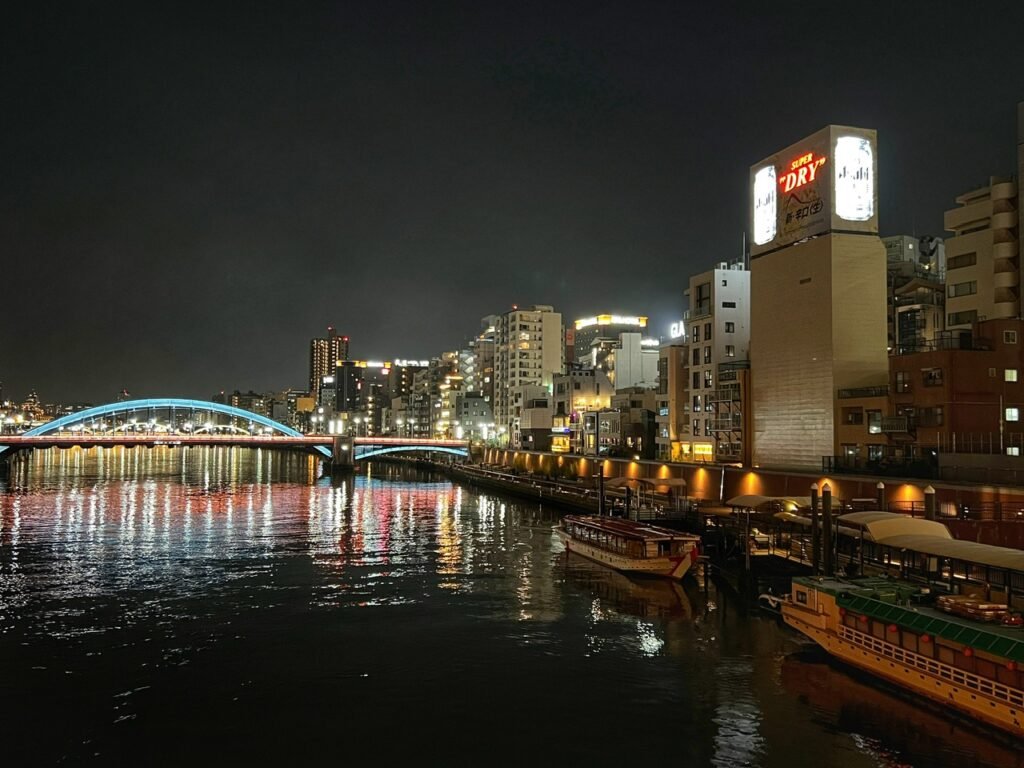
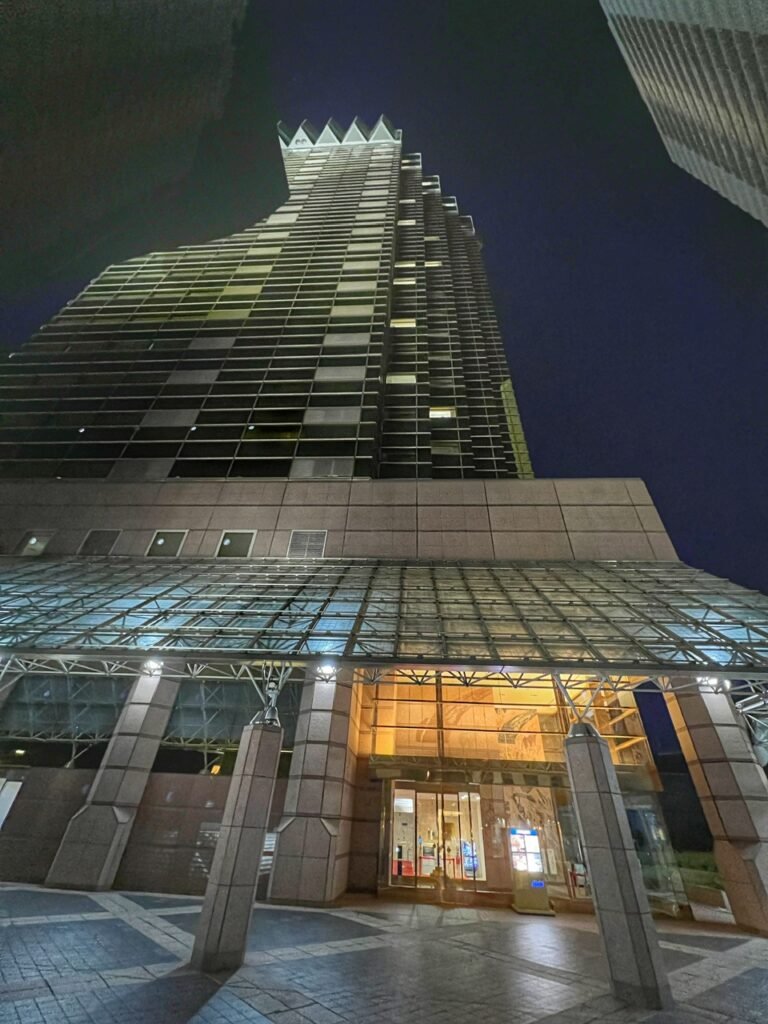
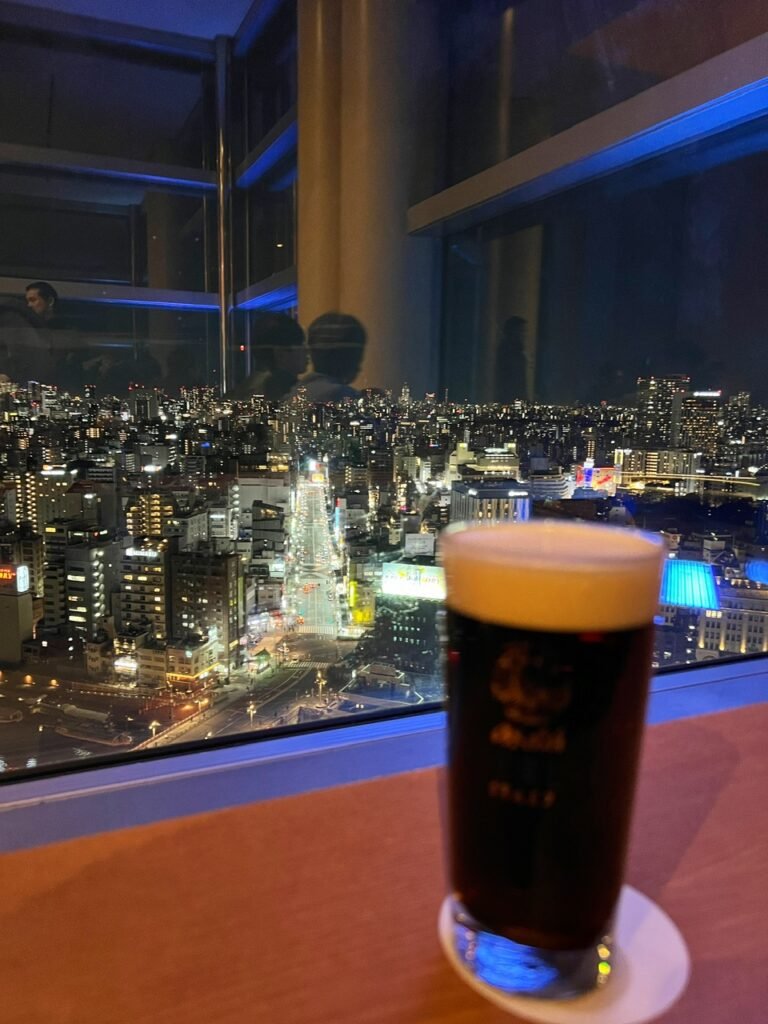
The night time stroll across the Sumida River. If you’d like to go, head to the building to the left of the turd and go to the 22nd floor. It’s here you can have a beery special nightcap and a fabulous view of the city for a very reasonable price ($4/pint.) On that note, we’d made it until 9:00. It was time to finally head to our hotel for a much deserved snooze.
Day One: Asakusa, Tsukuji, and Ginza Neighborhoods
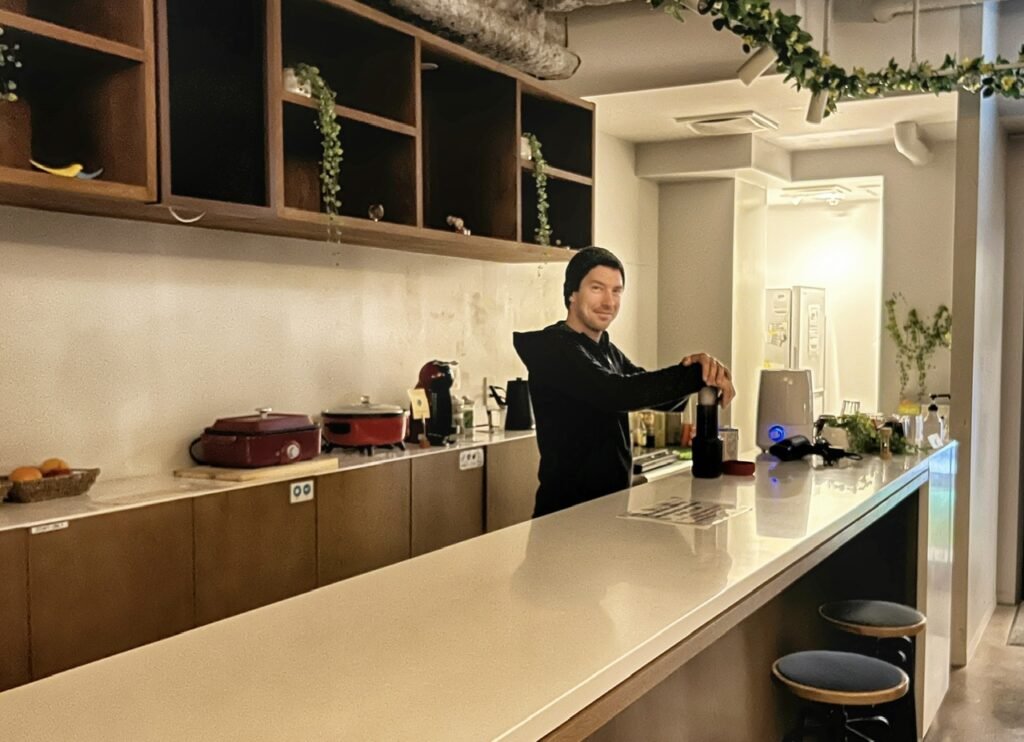
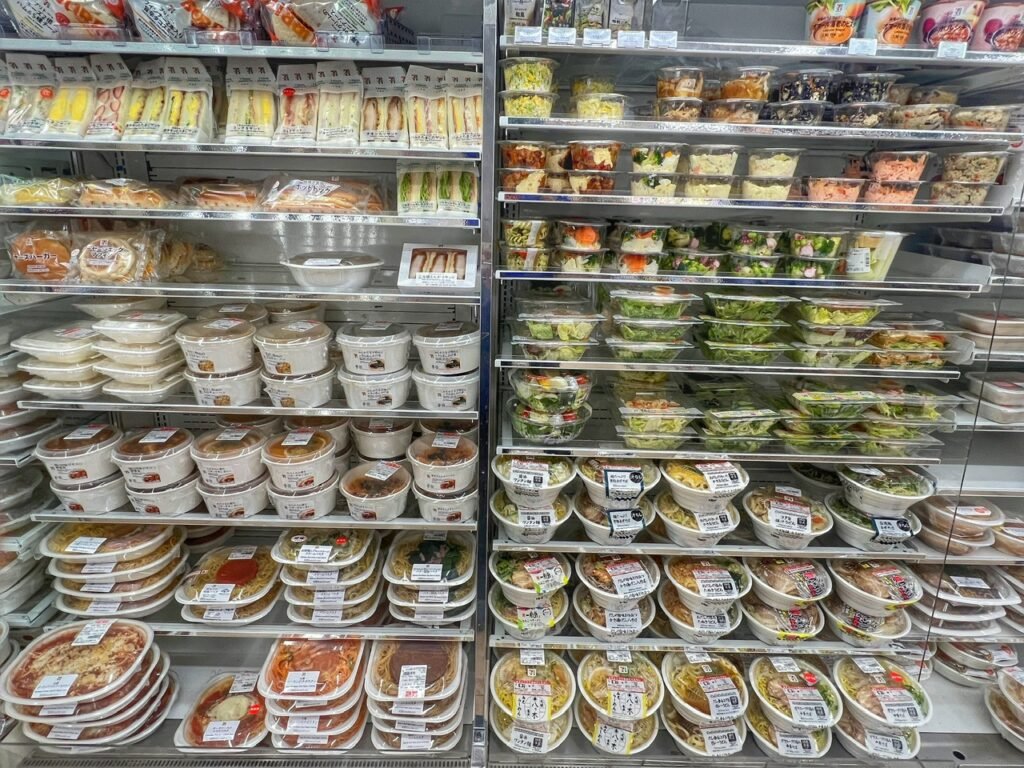
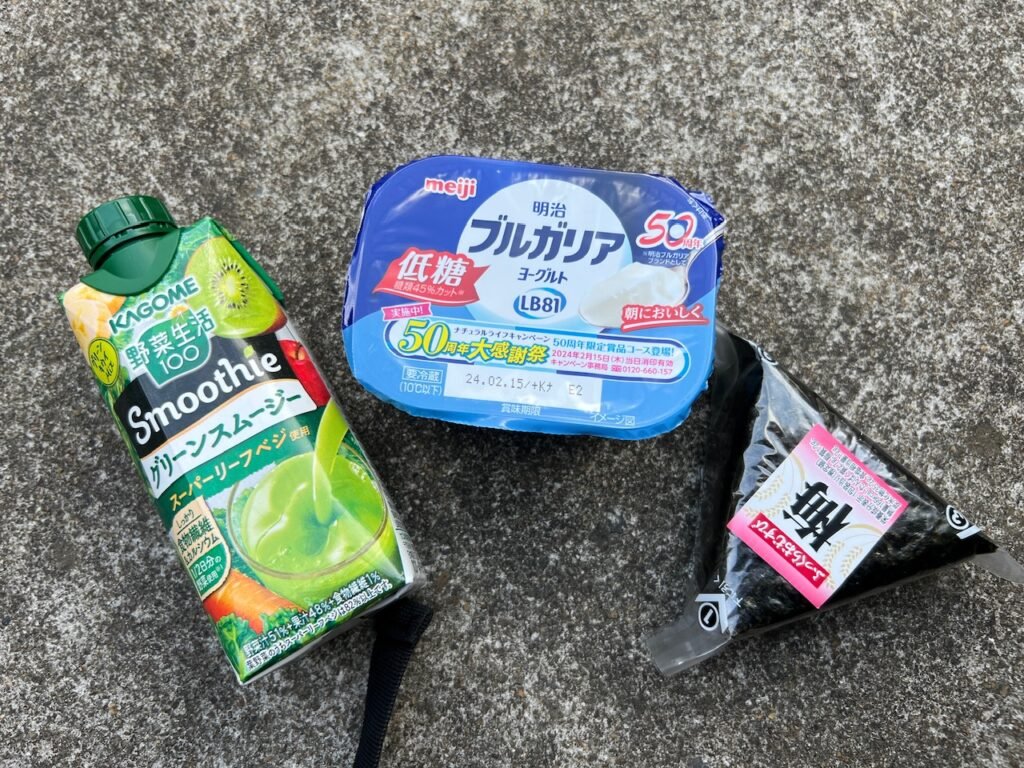
After a reasonably restful first nights’ sleep from 10 pm-5 am, we realized that our jet lag app (Timeshifter) was working pretty well so long as you took Melotonin at night. Not perfect, but a great guide. In the hostel kitchen, Greg prepared his morning coffee using his travel aeropress coffee maker. Aka his “personal luxury item.”
We then stopped by for the Breakfast of Champions for budget backpackers while in Tokyo…the 7-11. We were overwhelmed to see the variety of prepackaged ready-to-eat food items costing about $2-5 each, although not thrilled about the waste component. Fruit was ridiculously pricy ($1/banana) so we settled for a smoothie in a box, a plain yogurt and our mystery item which turned out to be a triangle of rice stuffed with pickled plums wrapped in seaweed. It was ok, but the most peculiar part was figuring out how to open the damn thing. You have to tear the plastic off in a very specific way to release the sea weed from its plastic protected shell which is present so it doesn’t get soggy.
After that mess, it was time to begin our two weeks in and around the biggest city on earth. You might be surprised to hear we spent all of our time in Japan in Tokyo. We did this for two major reasons: budgetary and substance. By substance we mean the sheer abundance of stimulating things to do, including cheap or free ones, in this immense city. We feel it simply deserves this much time to really understand the pulse of it. We also are taking a new tactic unusual for us in which we’re moving around within the city frequently and strategically. We’re also trying to integrate a bit of nature each day so we don’t get city-ed out so quickly. Yes, it will be exhausting. 🤣
Our first day focused on the Asakusa, Tsukuji, and Ginza neighborhoods as well as the Imperial Palace grounds. It took us to our first plum blossoms, what used to be the biggest fish market in the world, to John Lennon’s favorite Tokyo coffee shop, to an underground Japanese wonderland, and to devour our first sushi meal in a traditional restaurant tucked just far enough from crowds. And it may have been the best we’ve ever had.
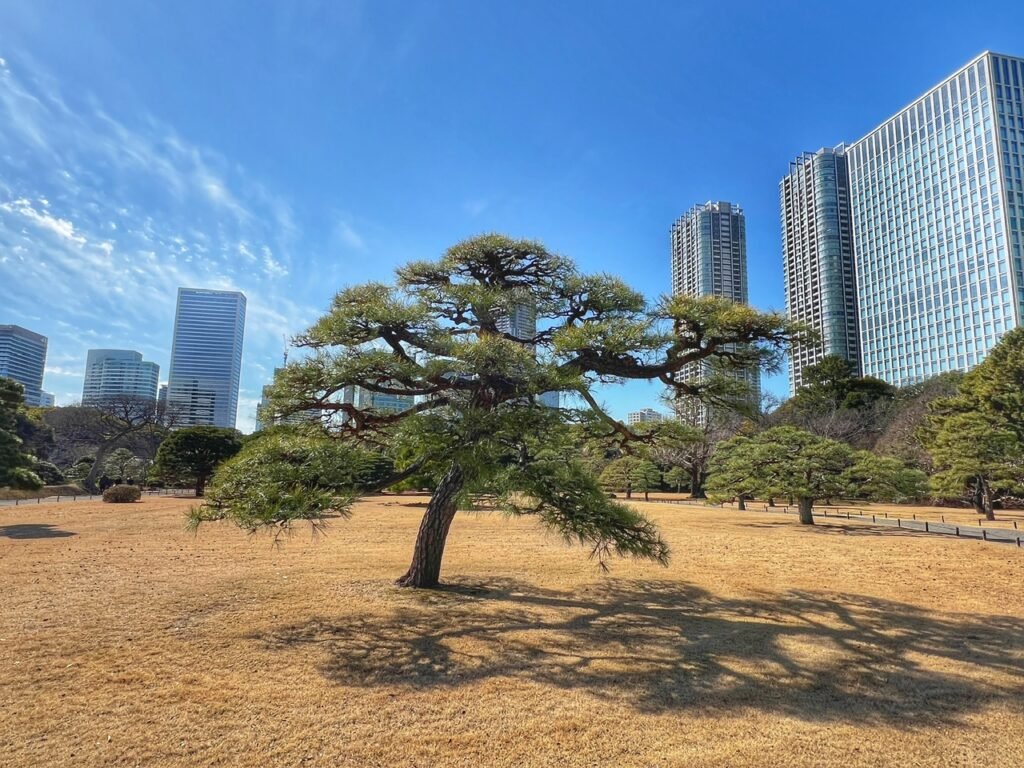
Our first stop took us to Hama-rikyu Gardens ($2/each) which starting in the 1600s was once the gardens of successive Tokugawa shoguns, (military dictators). Today the part we admired the most was our introduction to the sexy craft of Japanese tree pruning, particularly set against the surrounding skyscrapers.
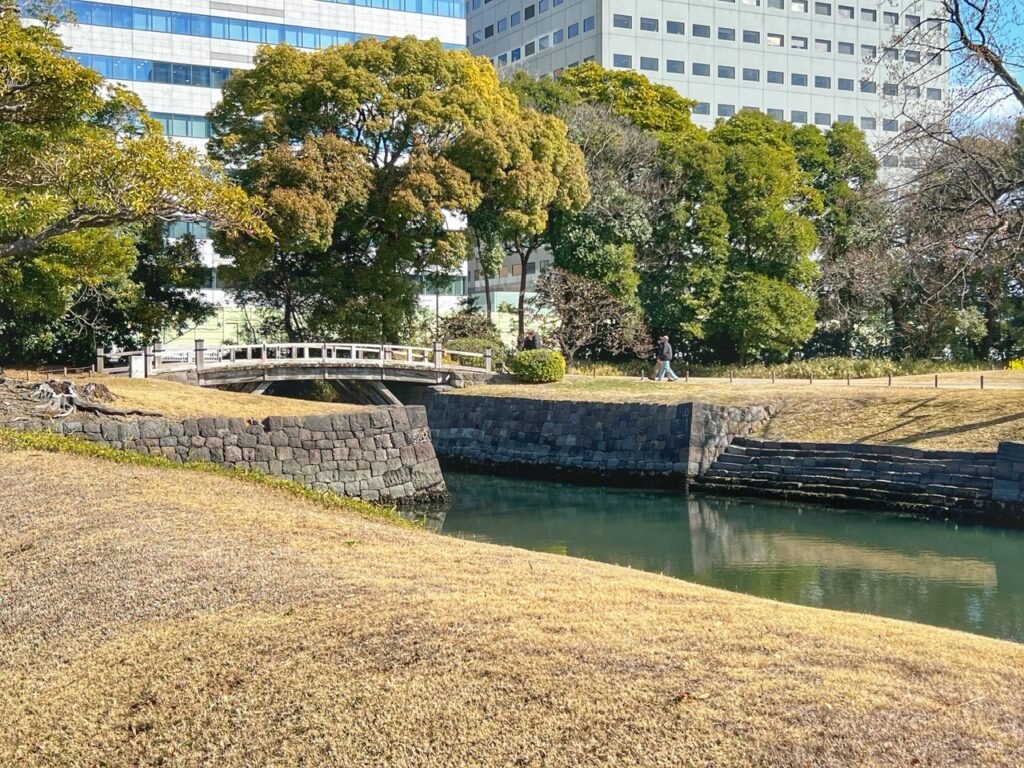

The gardens feature a seawater pond whose levels change with the tides, and two kamoba, or duck hunting sites, within the grounds. It originally functioned as a dejiro, or branch castle, of Edo Castle in the Edo Period. (Edo was the name for Tokyo until the 1870s.) The moat in this photo is called uchibori, meaning “inner moat.” It was originally a transit facility for carrying goods transported by boats from Kyoto, Osaka or Nagasaki etc. to Edo Castle.
This pine tree is believed to have been planted by the 6th shogun, Tokugawa lenobu, around 300 years ago during major renovations of the gardens in 1709. Today, it is one of the largest Japanese black pines in the Tokyo area.
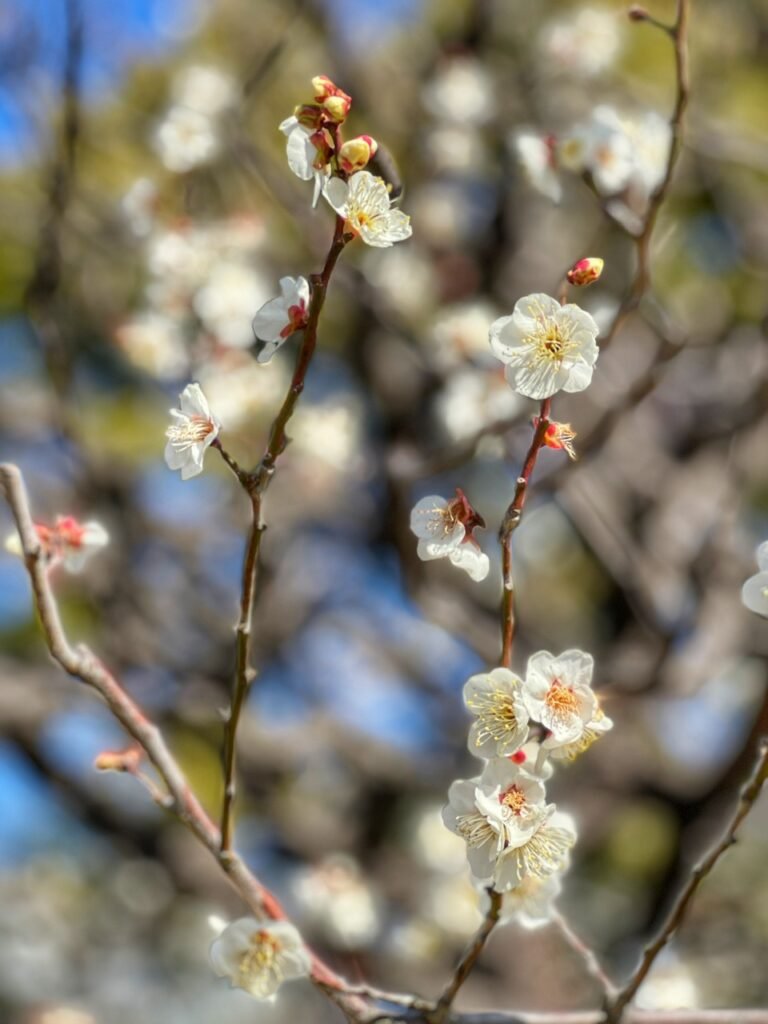
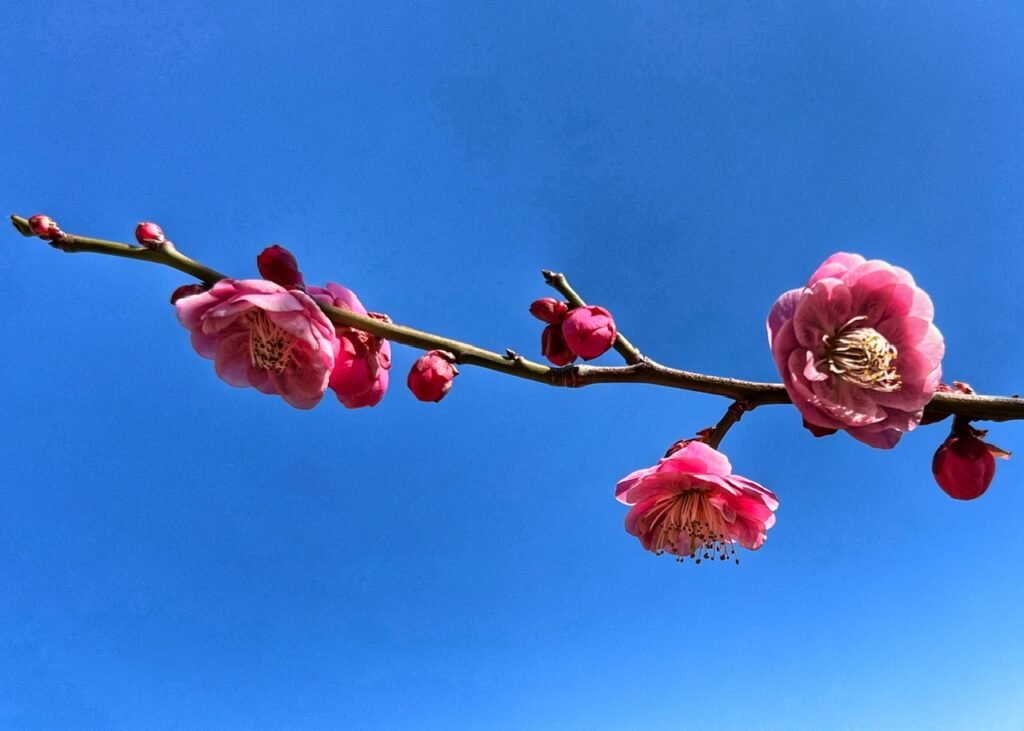
Although we were about a month early for the cherry blossoms, we still got a show from the lesser known stepsister….the plum blossom. She still looked pretty alluring against the sunshiny Tokyo sky.
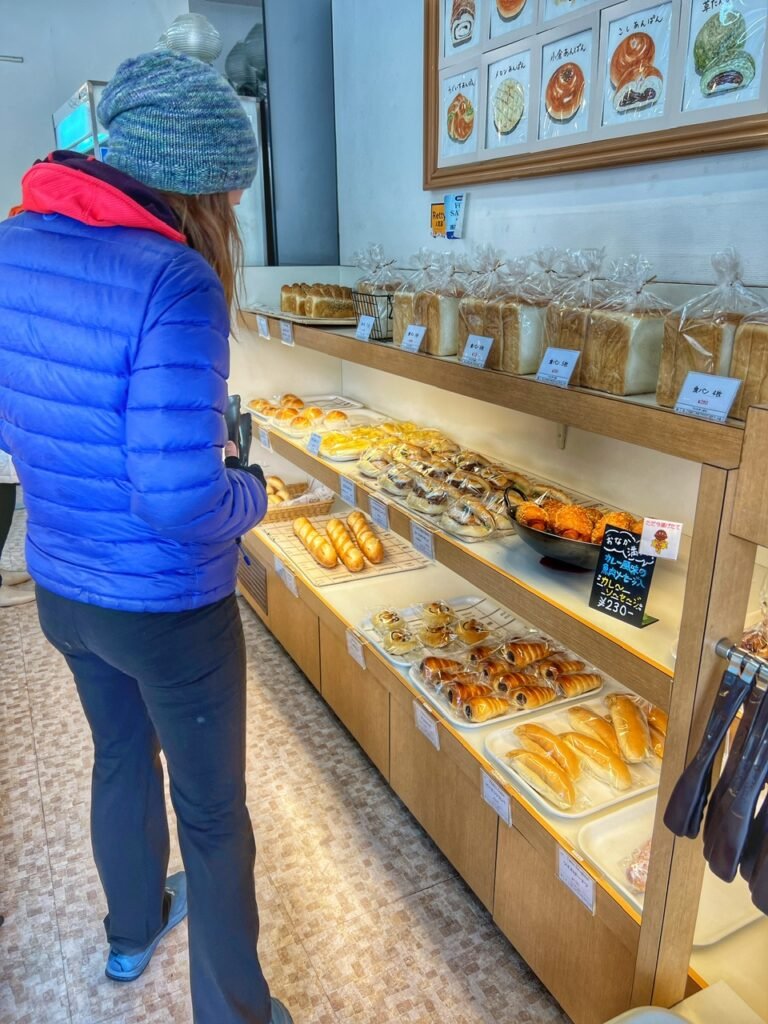
Stopping in for a snack at our first Japanese bakery. Many pastries are crammed with sweet bean and fruit pastes. Does this mean they’re healthy?! 🤣
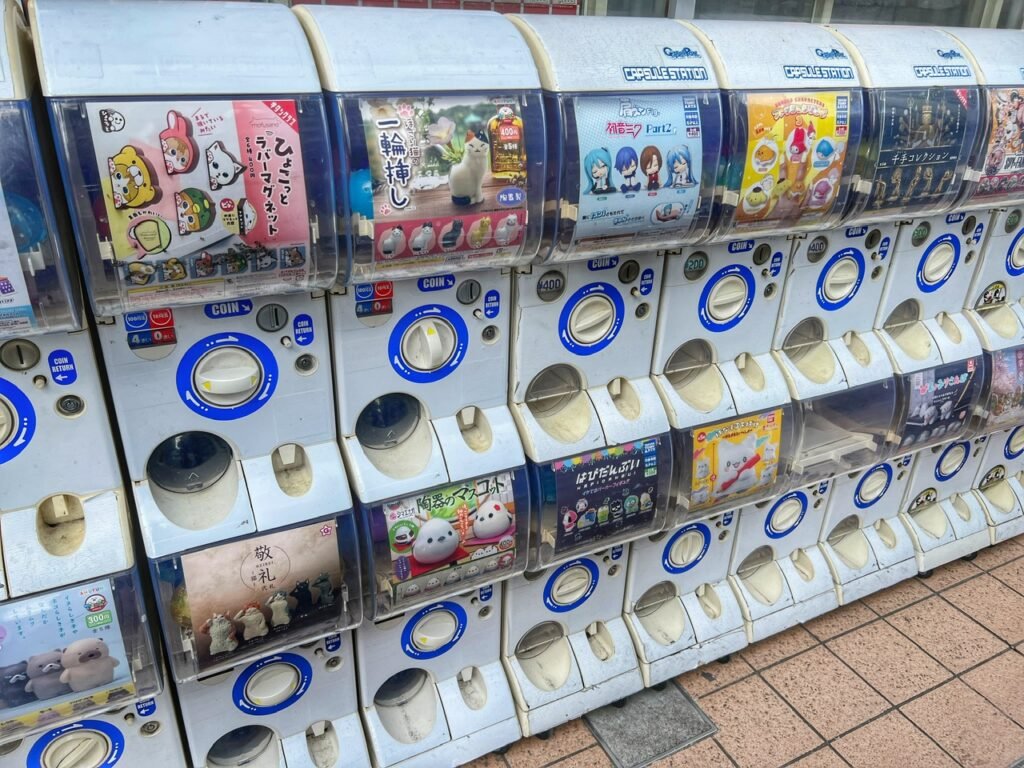
We also ran into our first capsule machines, which dump out cheap gachapons or miniature toys, undoubtedly made across the Sea of Japan. What’s funny is that unlike the gum and rubber ball treasures of our youth, these machines seem to attract not just actual kids but kids of all ages, with change to blow. And there is a LOT of change in Japan because their smallest note is 1000 ¥ or equivalent to about $6.60.
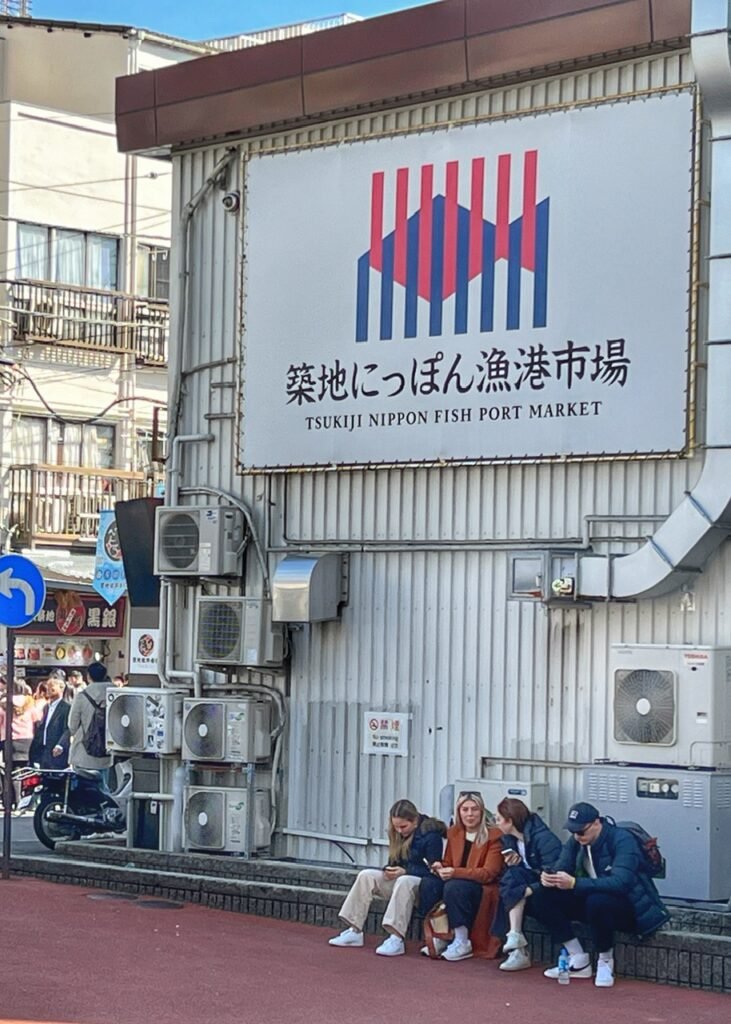
A major tourist attraction in Tokyo is the Tsukuji Fish Market. It used to be the largest wholesale fish and seafood market in the world and even auctioned off tunas every morning. One time a tuna even went for a million dollars!!!The market opened in 1935 as a replacement for an older market destroyed in an earthquake. It was closed in 2018, with wholesale operations moving to the new Toyosu Market.
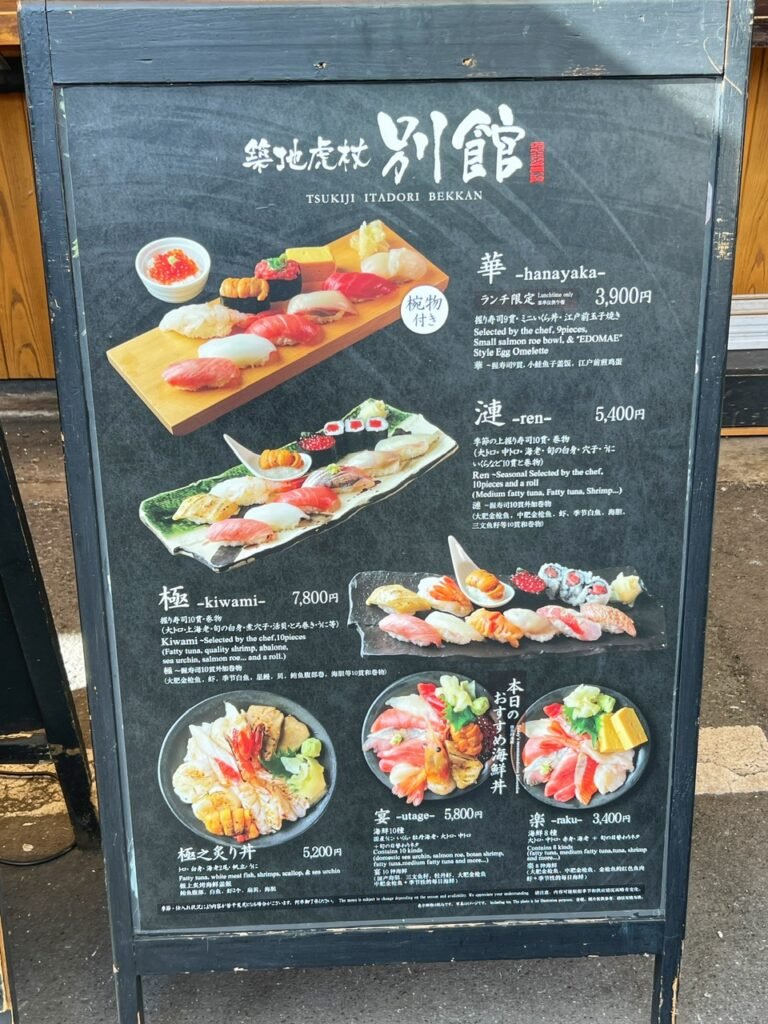
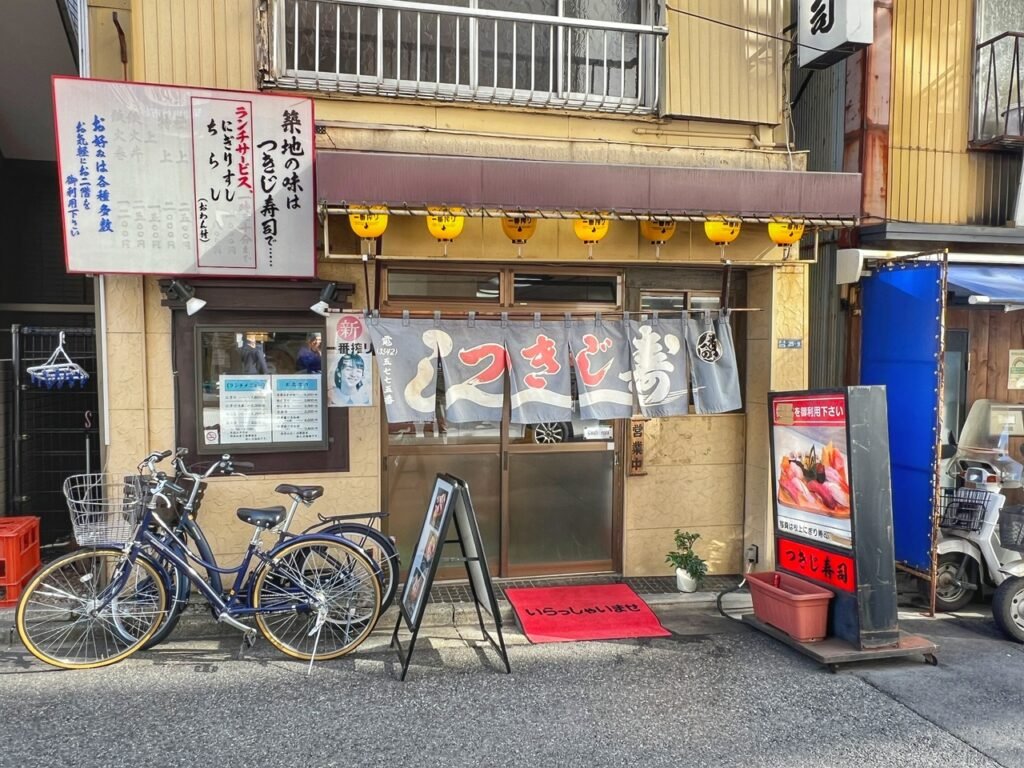
We took one look at the prices in the area and could see they were rip offs, so we instead ambled to Tsukiji Sushi two blocks over and got a nearly empty authentic Japanese counter restaurant and a terrific value.
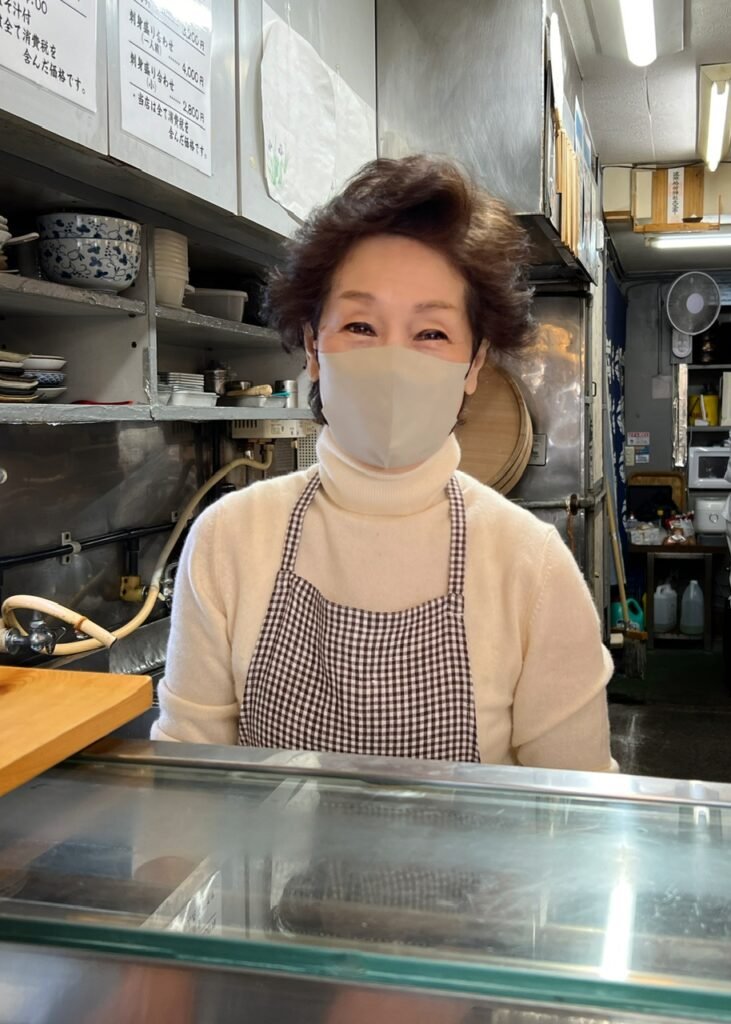
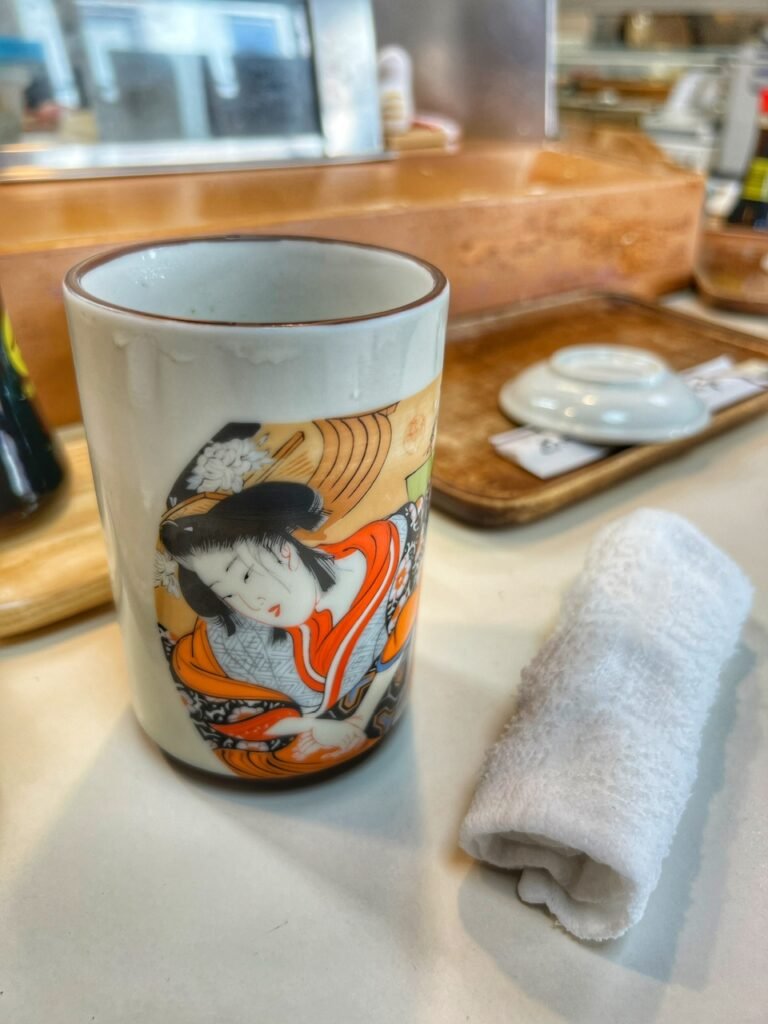
We were greeted by an overwhelmingly cheery lady named Yuki, who immediately served us a warm towel and green tea.
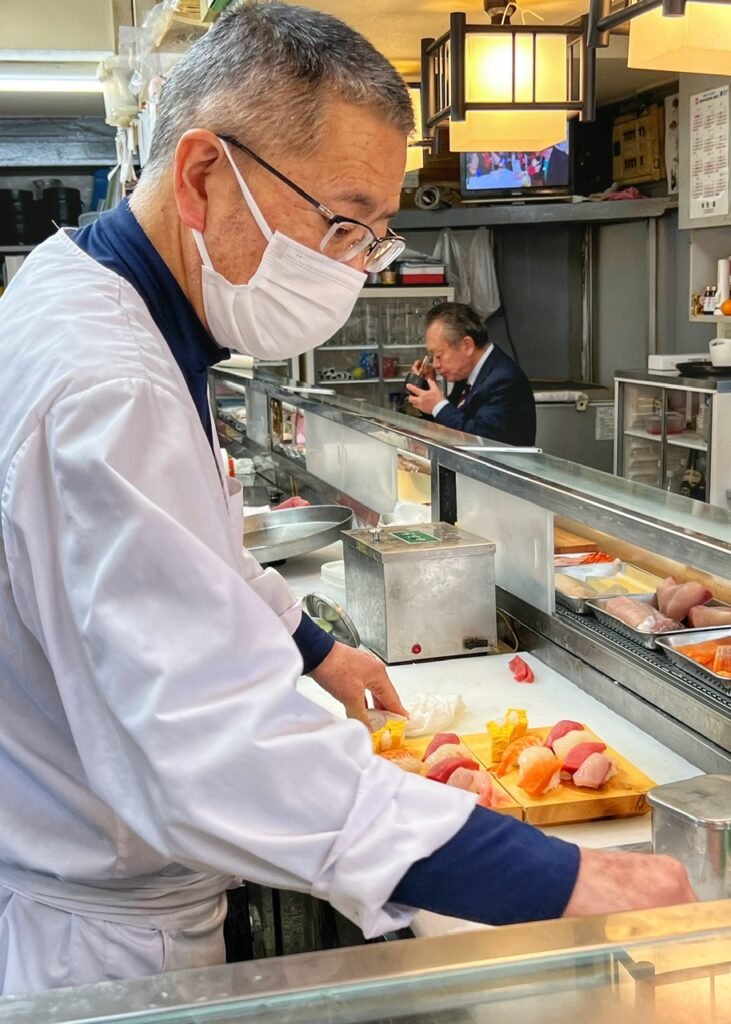
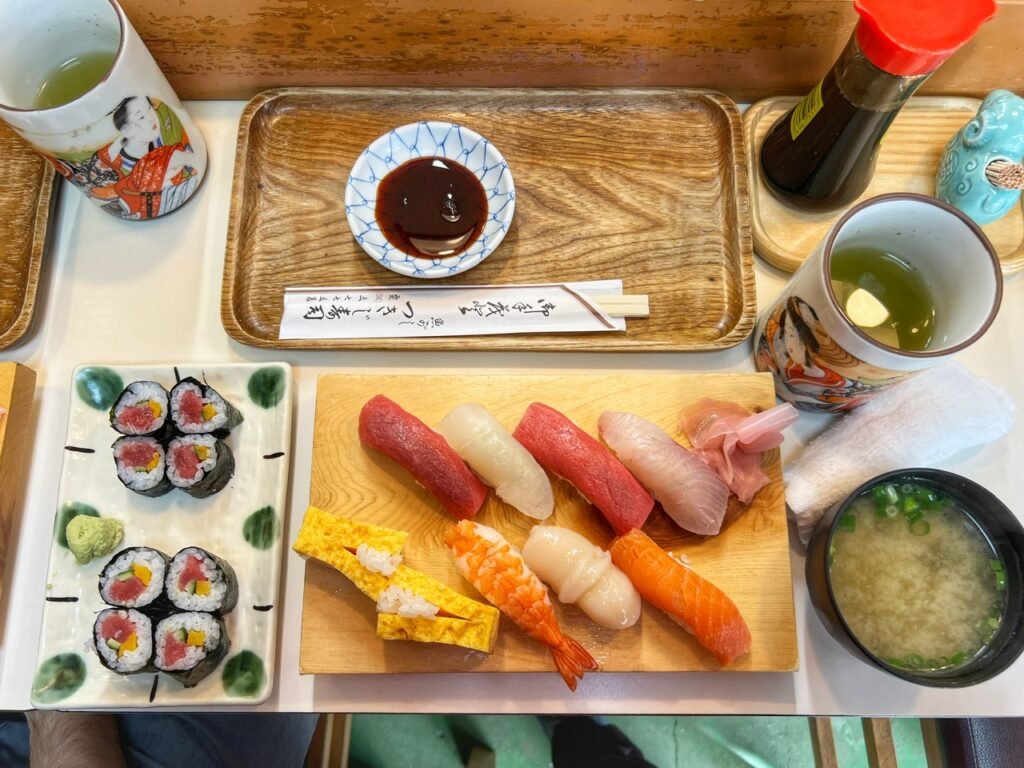
We then got to watch her husband build our sushi masterpiece before us. The two have been running the restaurant for 40 years and it’s truly some of the best sushi we’ve had. Especially the tuna…creamy, soft and just divine. But maybe it all tastes this good in Japan?! 🤨 And a terrific value at $12 for all this! We were lucky to be in Japan at a good time as well because the exchange rate is strongly in our favor. But, careful because two streets over, it would have been more than double the price for something equivalent.

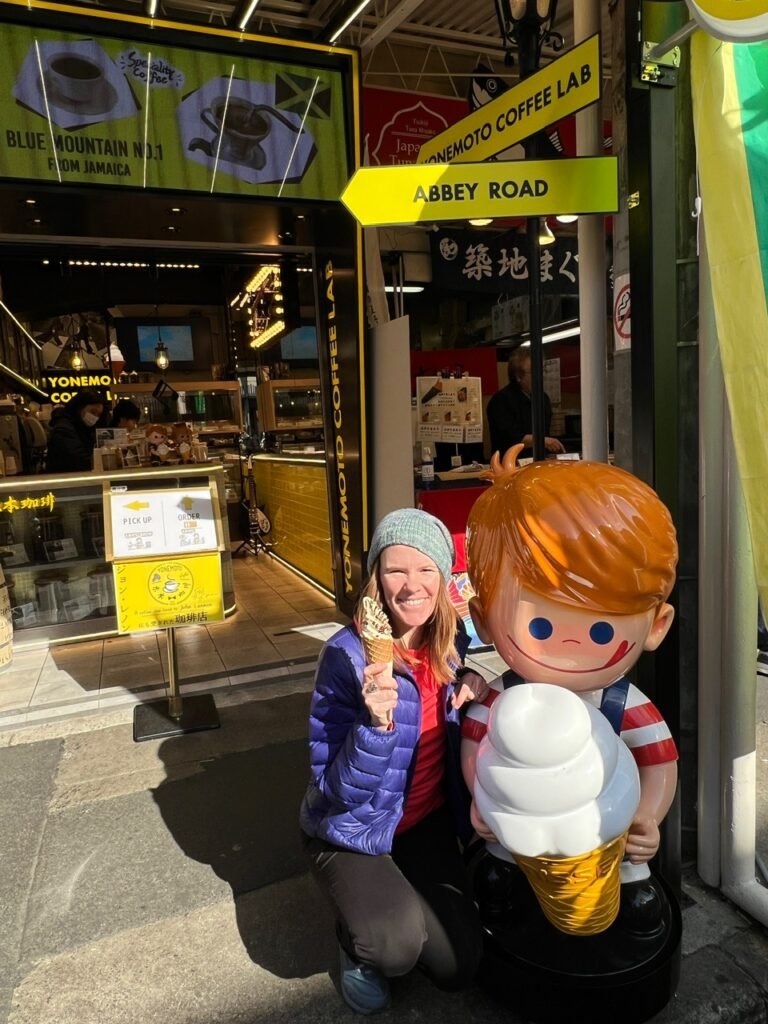
These enticing blocks that look like cheese at first glance are actually egg omelets which makes them a bit less enticing…at least to us. Not our fav. For dessert instead we chose mocha ice cream from Yonemoto, also known as John Lennon’s favorite cafe in Tokyo when he was hanging out with Yoko Ono.

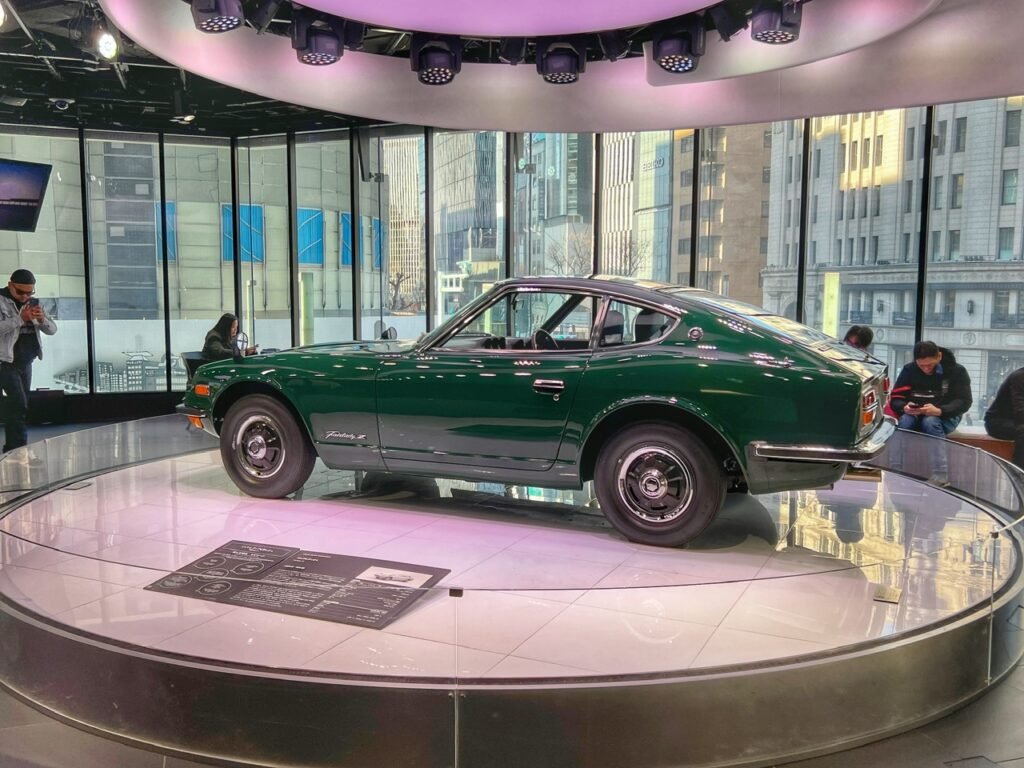
They also have a fetish for all things one-upped over the rest of the world. The toilet is one example. This is another at Nissan Crossing. A car with room for a recliner and chauffeur and a piano in the back. Because…why not? 🤣 At Nissan Crossing, we got to see other models of unique Nissans including the 1969 “Datsun Fairlady,” which was transformed from a convertible to a GT car in which a driver could ride comfortably and enjoy cruising…
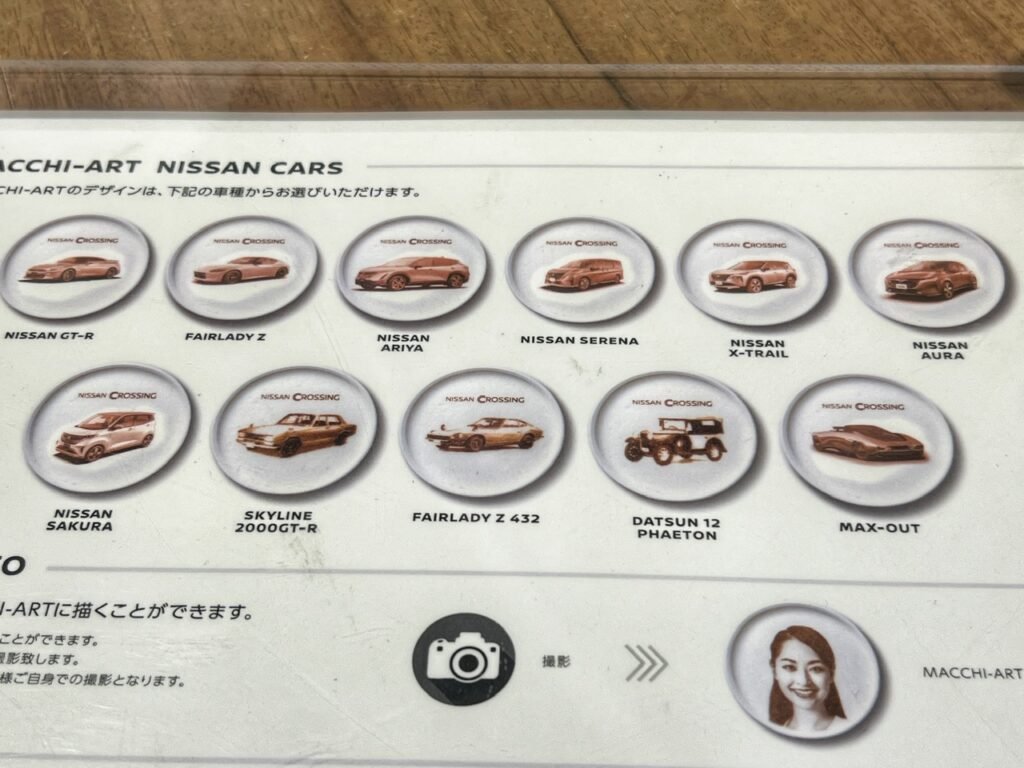
…or if the cars themselves bore you, you can enjoy a latte in their cafe with a Nissan of your choice made in “Macchi-Art” foam on top.
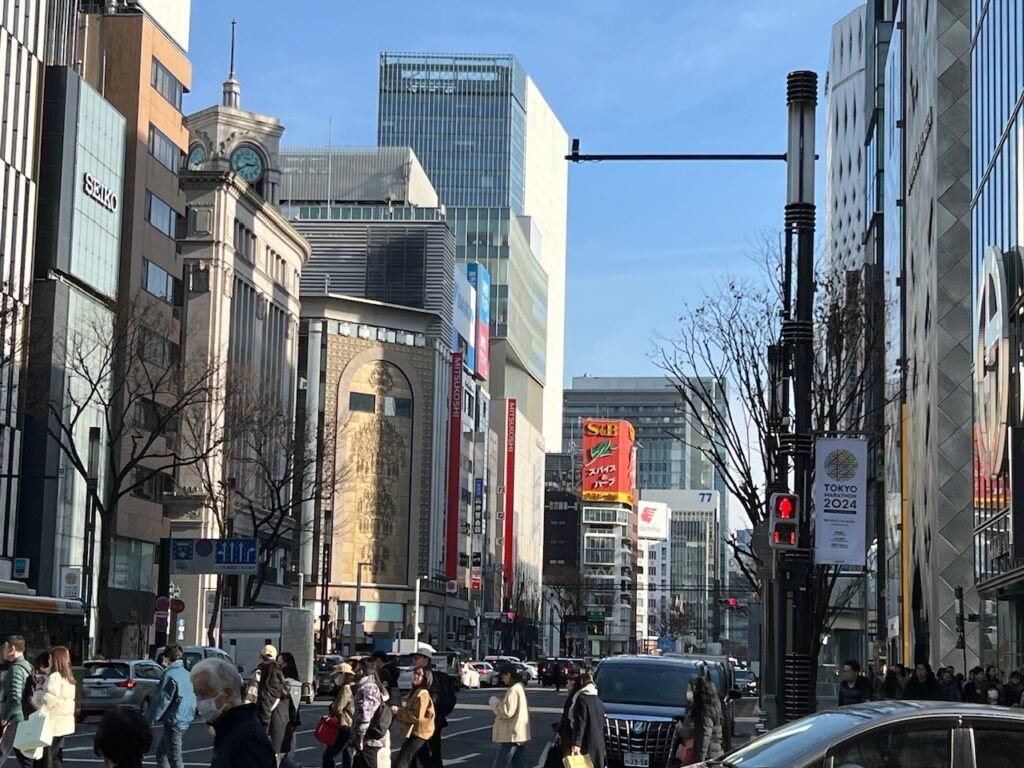

The Ginza neighborhood is full of eclectic modern architecture, like this skyscraper made entirely of glass blocks.
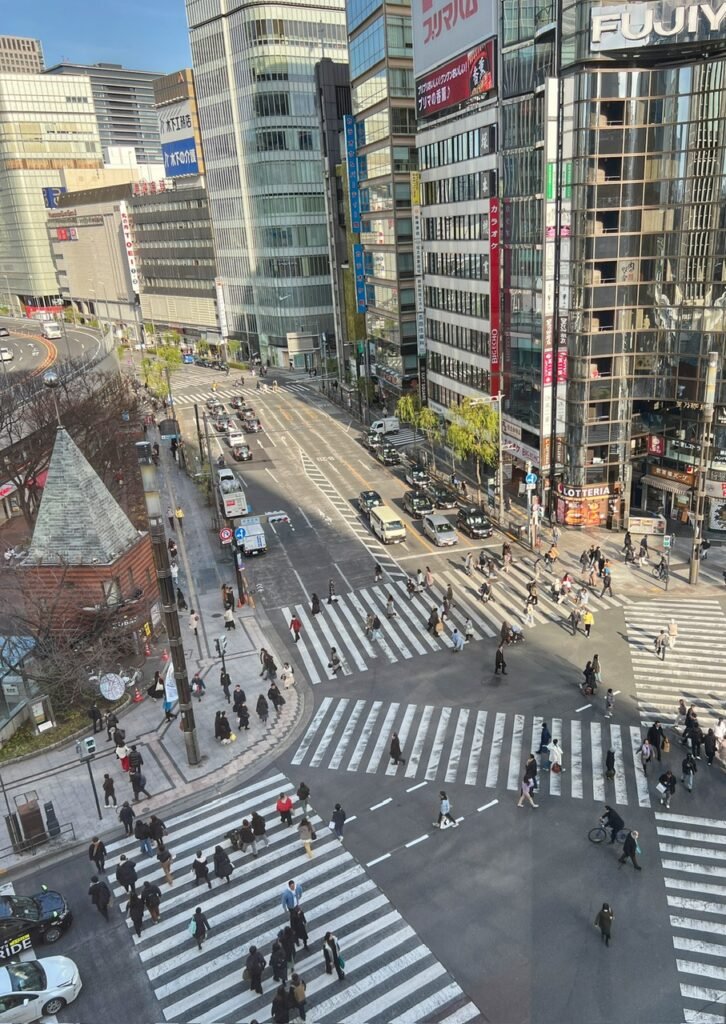
Sukibayashi Crossing as seen from inside a nearby mall. It’s not quite as crazy as the notorious Shibuya Crossing, but it’s a decent appetizer.
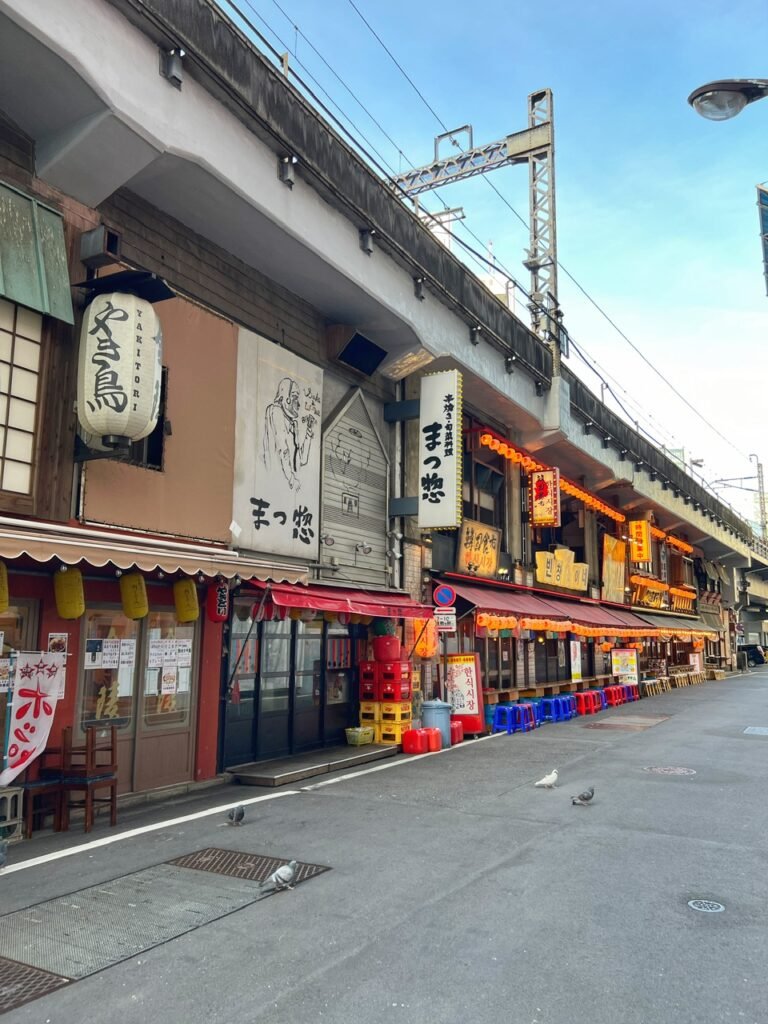

Underneath the mass of rail lines near the New Tokyo Beer Hall in Ginza you can find the entrance to a magical world, which kinda looks like a darkened and slightly creepy alley. You may have to remind yourself that the city has the fifth lowest crime rate of world metropolises before moving forward.
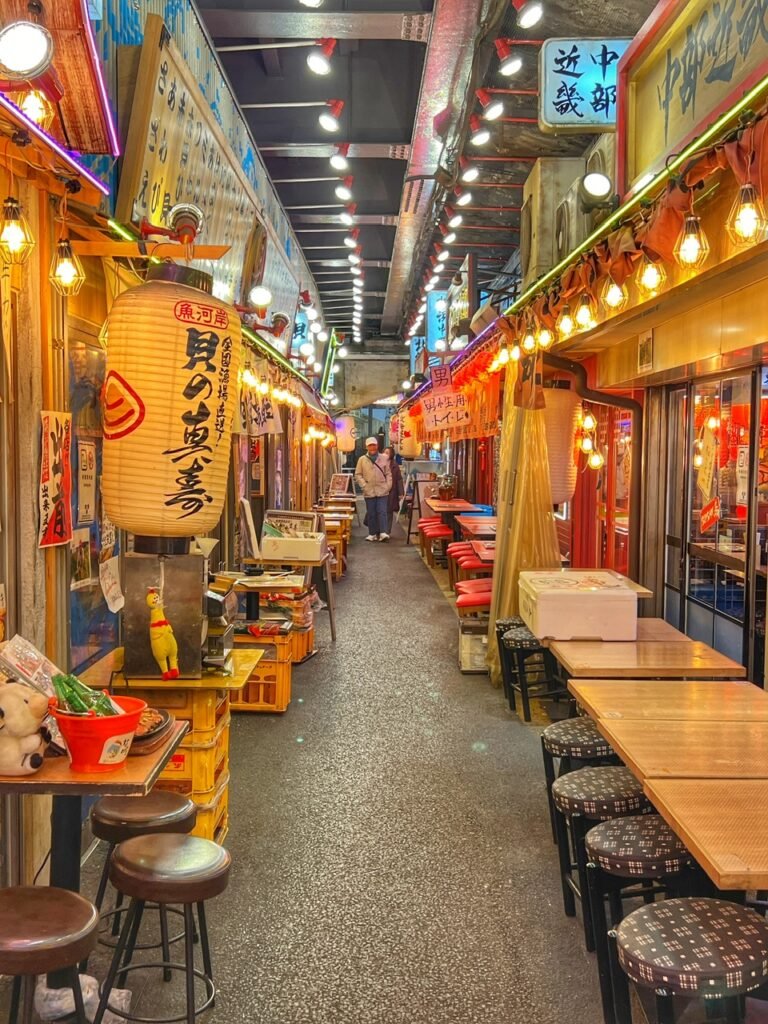
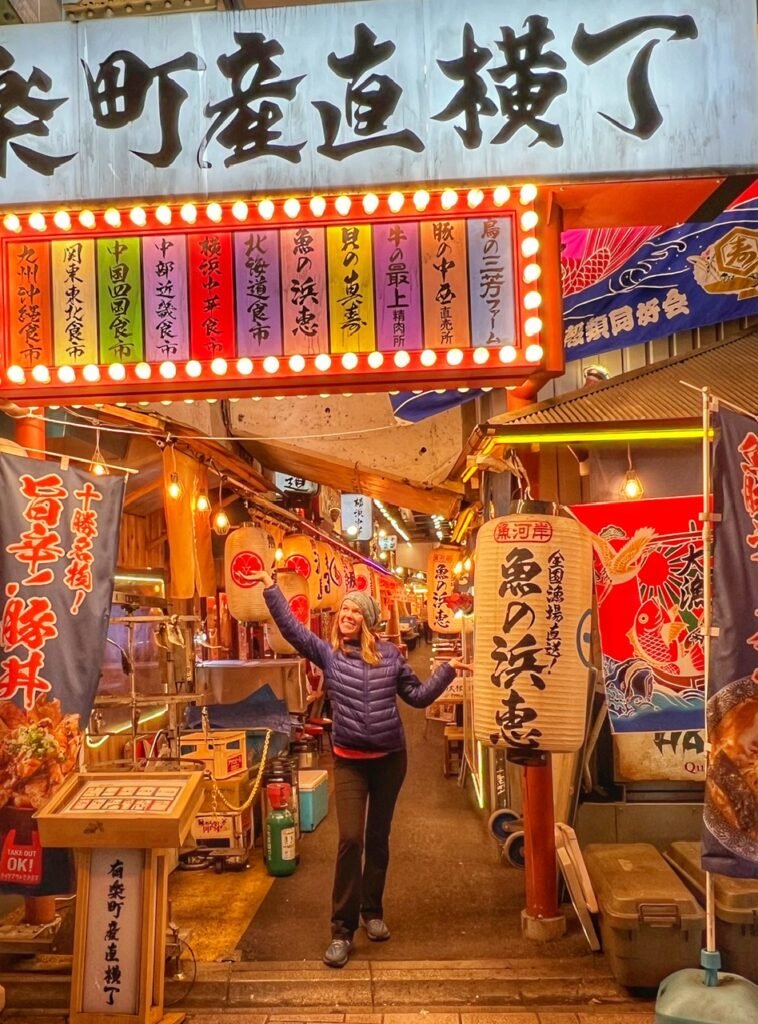
You’ll be glad you did, however, because soon you’ll emerge into a brightened and welcoming corridor of the most cozy restaurants. We marked it on Google under “Yurakucho Sanchoku Inshokugai / Yurakucho Farm to Table Dining Alley” to come back when we’re hungry. We emerged from the front entrance, which is far more welcoming but not nearly as mysterious.

Near here, we crossed paths with Japan’s most terrifying creature…Godzilla…who is portrayed at left for his 70th birthday portrait at 394 feet. Like many things in the world, he has grown substantially because in the original 1954 film, he was a chintzy 164 feet. Although Hollywood has tried to nab him many times, including through his own Hollywood star, he is a registered citizen of Japan. (Movieweb .com)
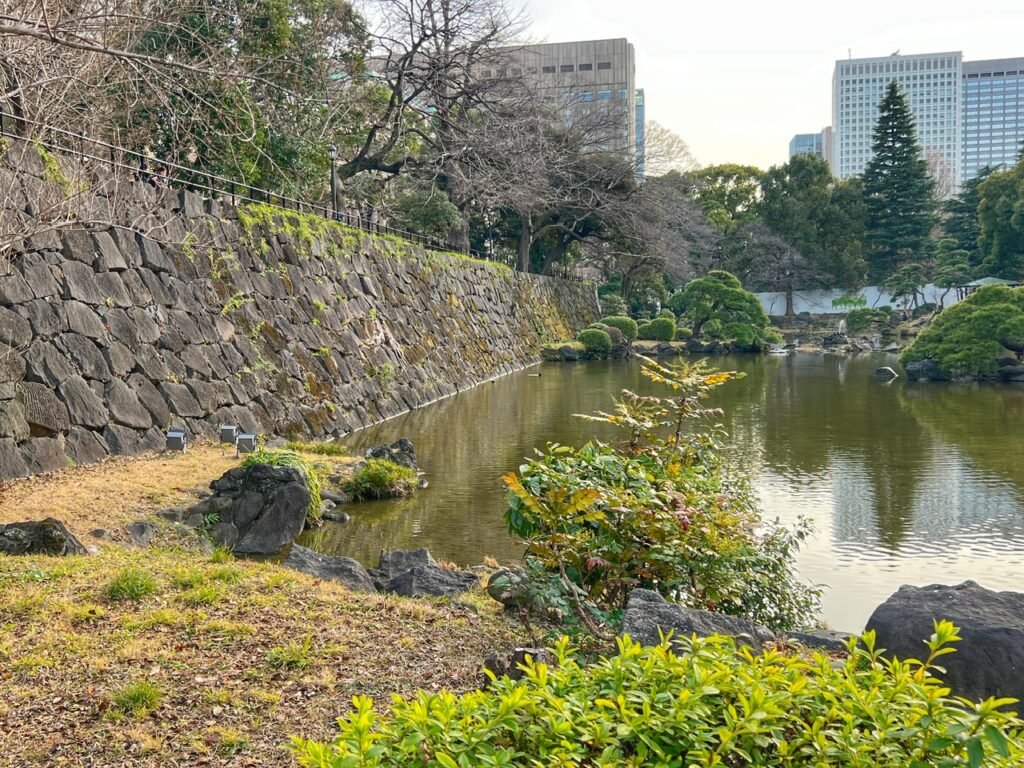

Godzilla chased us to Hibaya Park and Shinji-ike Pond, which used to be a moat of the Edo Castle, and was converted into a pond to preserve its appearance when it was constructed.
Within the park one can find a robustly made cast-iron drinking fountain which dates back to the time Hibiya Park opened in 1903. Its unique shape allowed horses also to drink from it, evoking a time when horses and oxen played an important role in land transport.
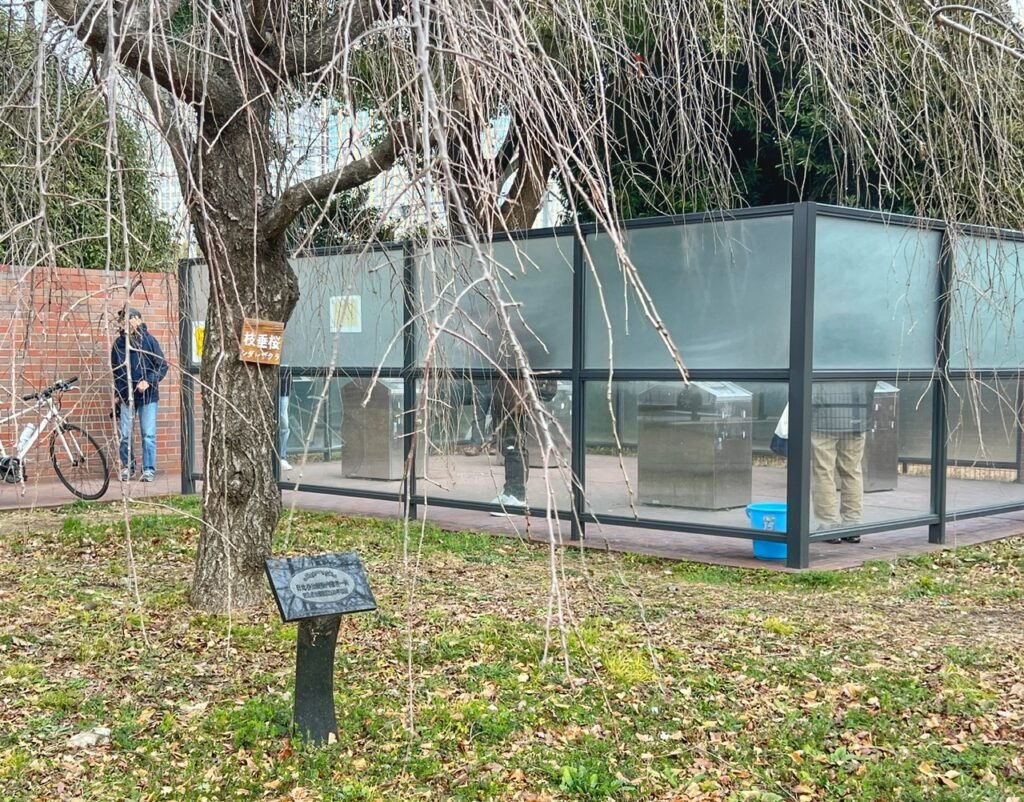
In this park, en route to our last stop, we noticed an open-air smoking section. In a park. Inside the smoking section were vacuums that literally sucked the smoke out of the “fresh” air. The next day we went to a restaurant that still allowed smoking. Hmmm.
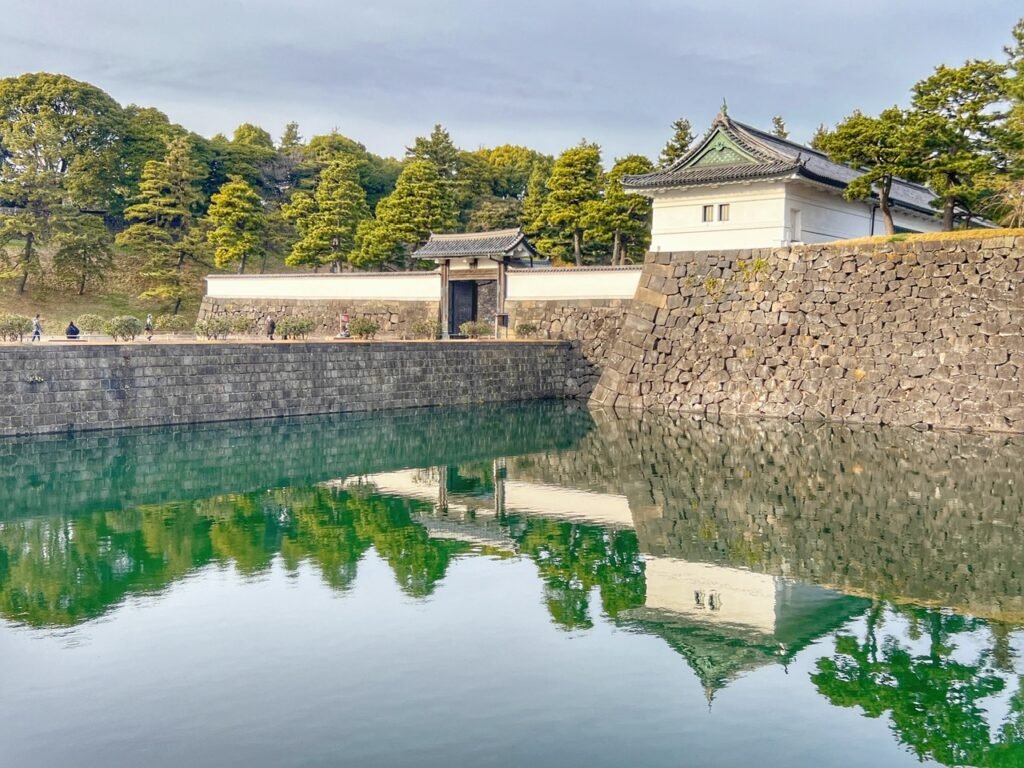
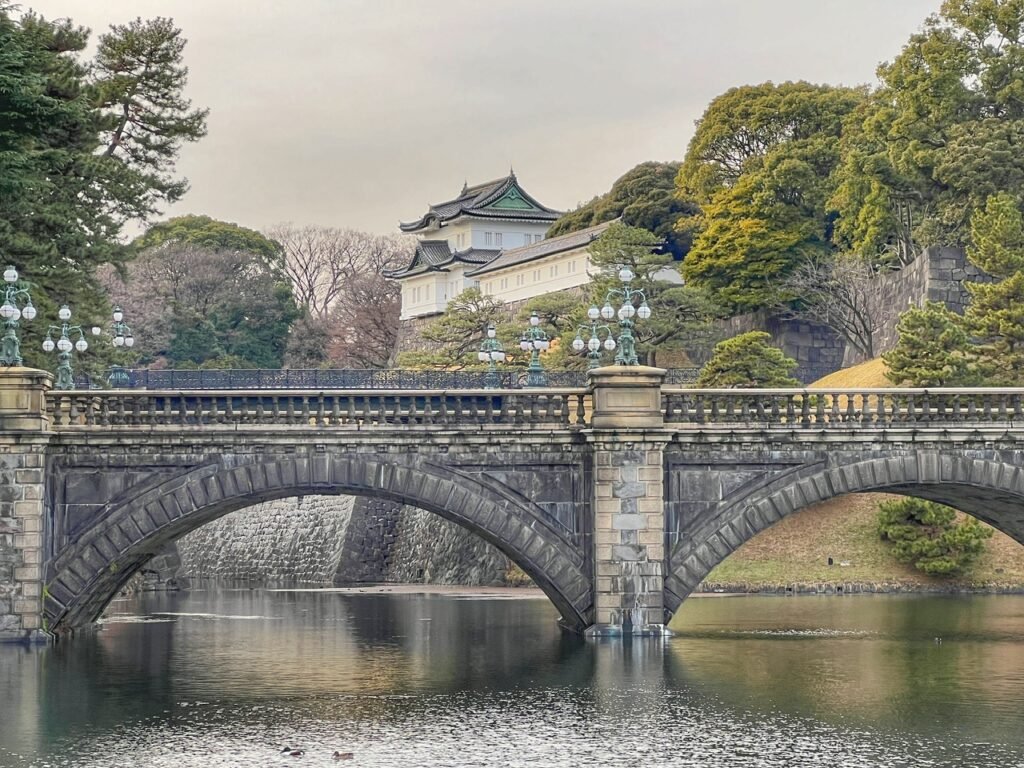
The Imperial Palace grounds, or the home of Japan’s emperor (a guy who today has no reserve power whatsoever) takes up an astounding chunk in the middle of Tokyo and remarkably has absolutely none of the city’s 121 miles of subway lines plunged underneath.
The most popular portrayal of the Imperial Palace is this view of the Stone Bridge with the Main Gate on the left, the Iron Double Bridge behind it, and the Fushimi watchtower in the distance. Many people think this watch tower is the actual watch tower, but if you read the plaque you’ll find out it’s actually way further back in the complex which is nearly half a square mile.
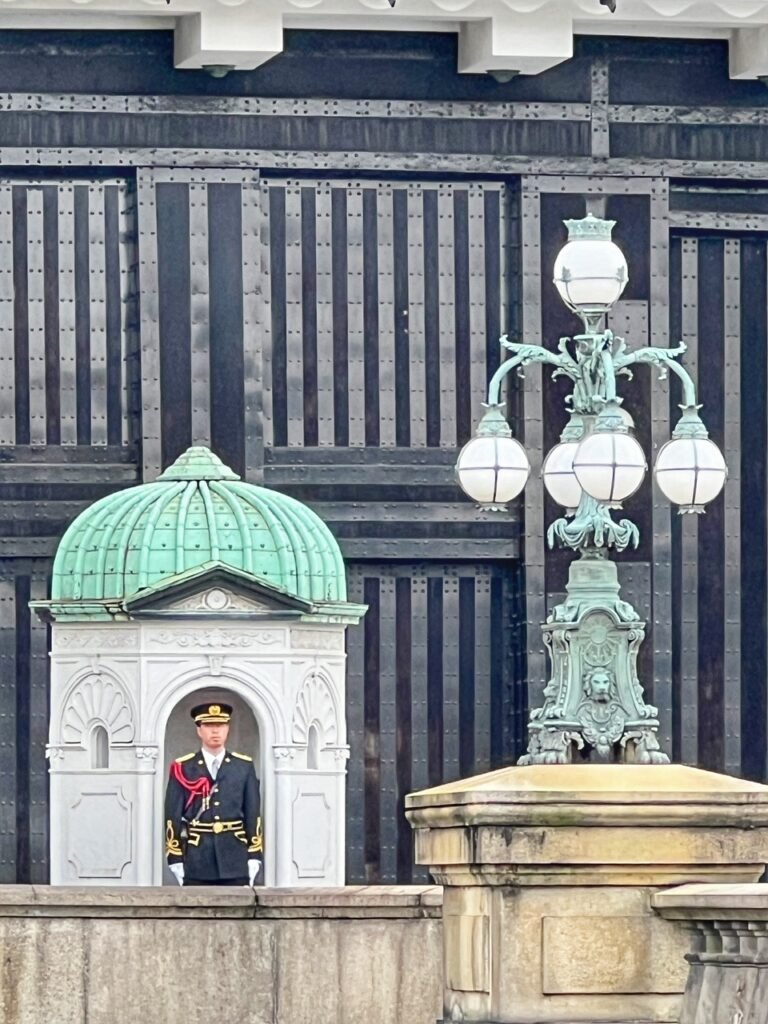
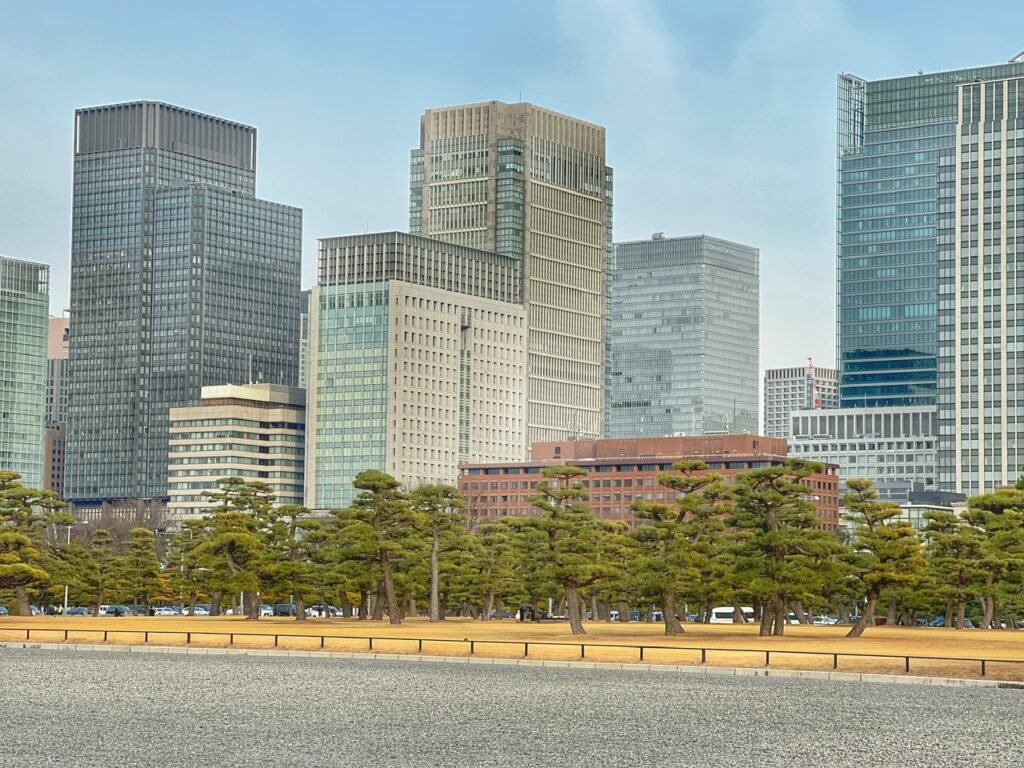
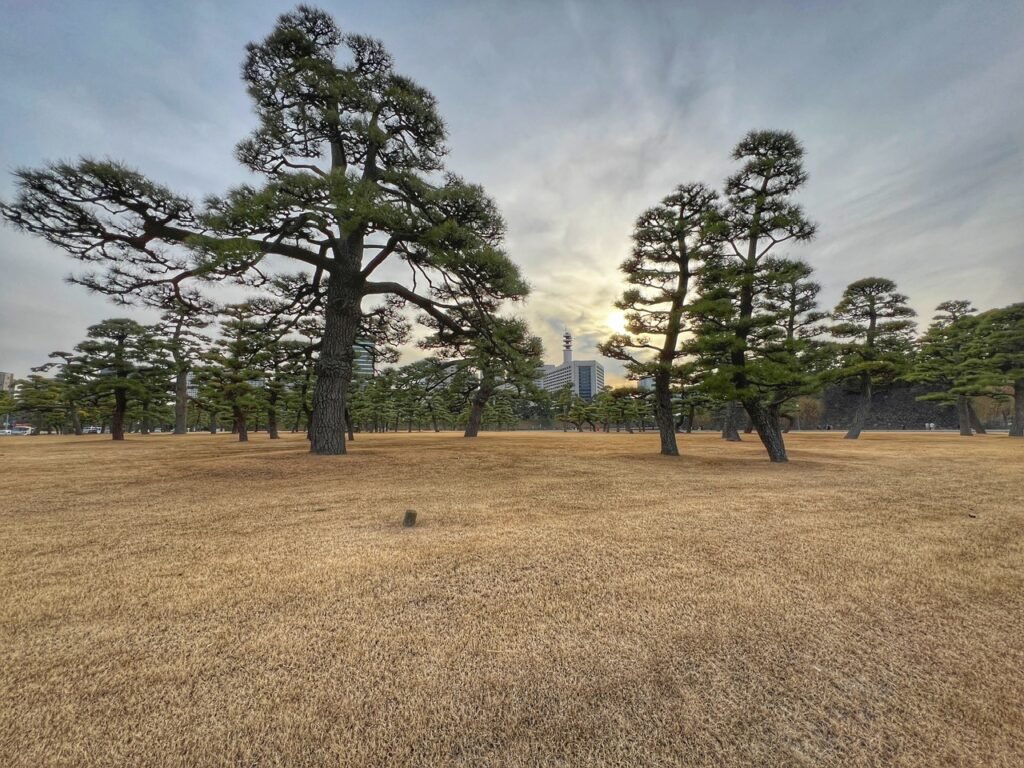
A guard doing what he does best at the Main Gate. It was about this time we got shooed away because the complex closed at 4:00.
The striking row of perfectly coiffed pine trees against a metropolitan backdrop. We did dig the minimalism.

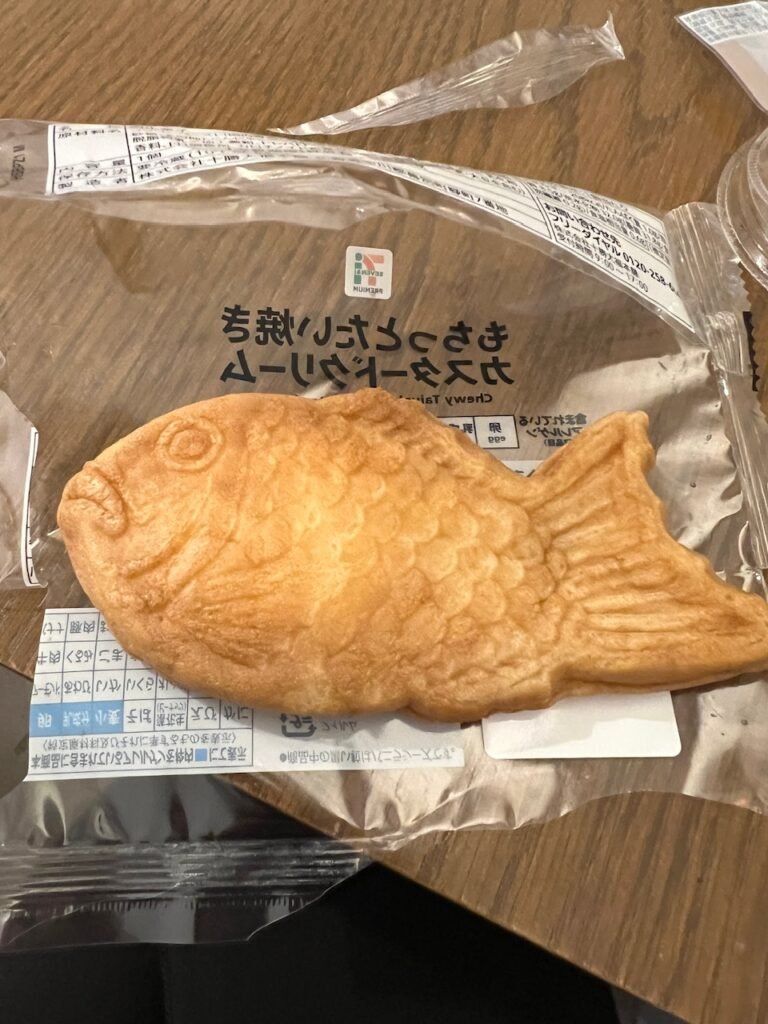
We also dug this popular cartoon cat named Mofu (meaning fluffy)sand with a strawberry for a hat, sitting on a strawberry cake and the slew of grown Japanese people shopping for items with her on it.
Speaking of novelty items we also discovered this custard stuffed fish at the 7-Eleven called a Taiyaki. The texture is really bizarre and satisfying, much like the raw sushi topped versions.
Day Two: Asakusa & Ueno Neighborhoods
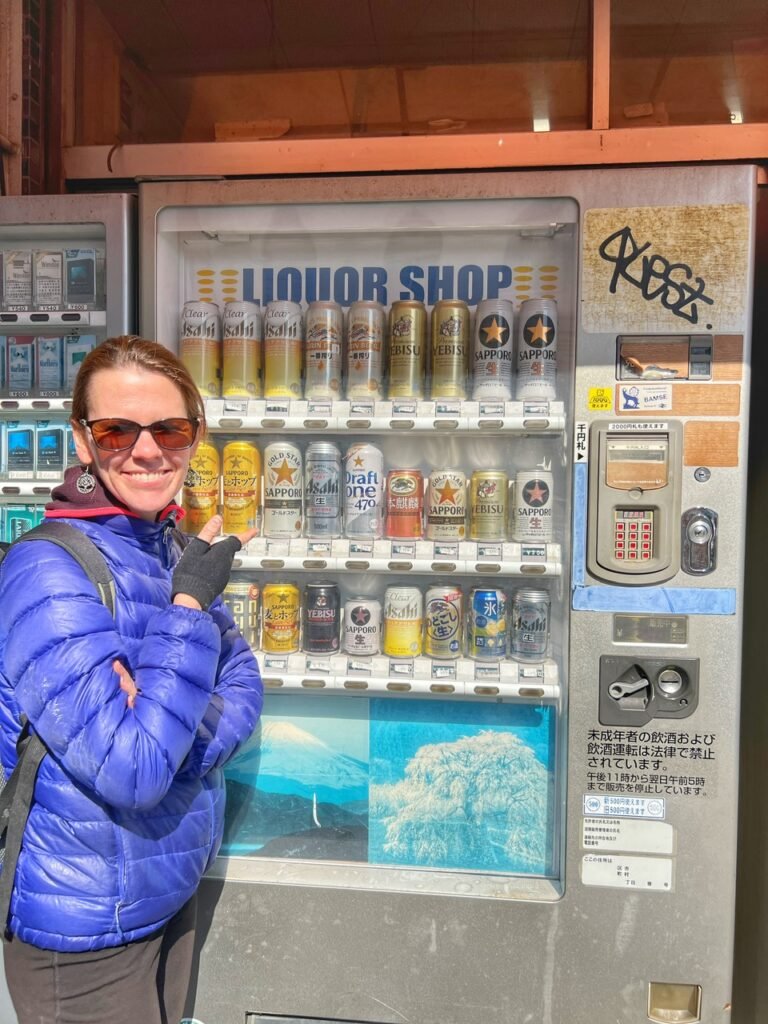
For our second full day in Asakusa, we left our bags at Plat Hostel and headed out for a traditional soba noodle brunch in an authentic underground nook, had a much less pleasant second visit to the slam-packed Sensoji Temple to read our fortunes, and had a wander down Kapabashi Street, also known as Kitchen Town.
And score! We found our first beer vending machine! You might ask, how do they keep underage children from drinking it? There are ID checkers on some of the machines, but apparently many of them don’t work. But, overall they evidently just trust those under 20 not to use them because if they do, they’d bring shame to their family. Mind-blowing…
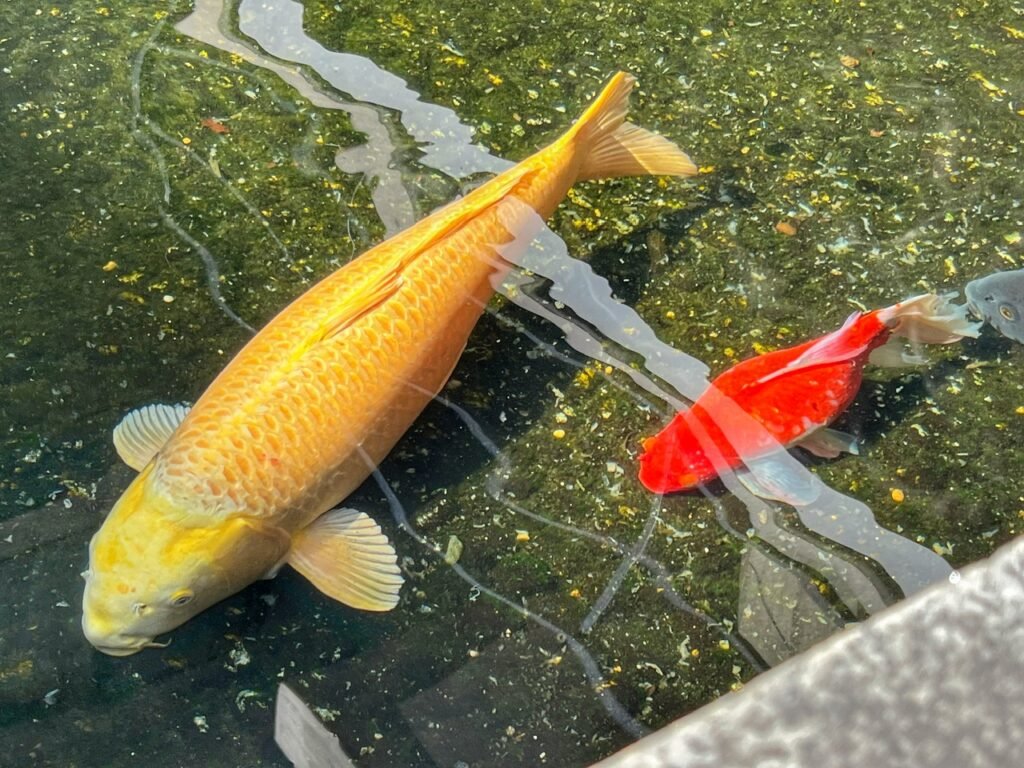
It’s not rare to find koi, or colored carp, outside of temples or shrines as they are a sacred fish. They are seen as a symbol of perseverance and strength and can live to be very old….the oldest ever 226 years. (Japan Travel)
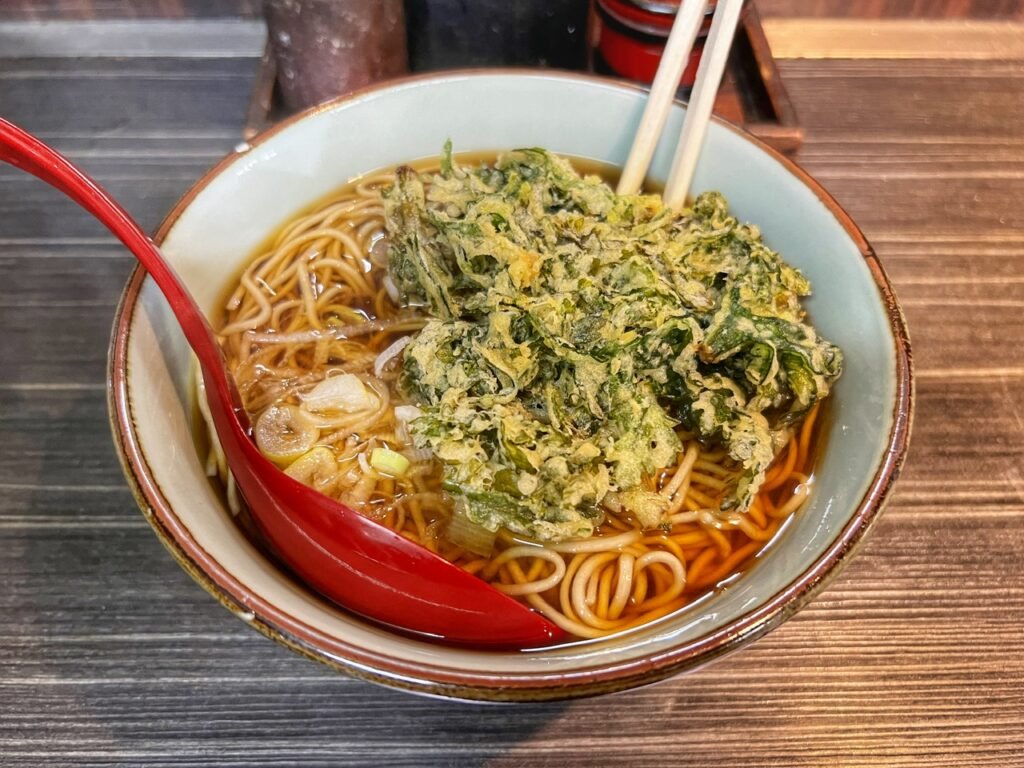

After a pricier meal day on day one, it was time to score some cheap eats so we headed to the inconspicuous Asakusa Underground (found on Atlas Obscura) which is the oldest underground shopping street in Japan dating from 1955 and seemingly frozen in time with dripping pipes exposing the guts of the city, a stale and funky smell and low ceilings. But all this totally adds to the atmosphere and makes you feel like you’re getting a true off the beaten path experience.
Away from the crowds, we grabbed some soba noodles for about $3.50 each at Soba Udon Manju Asakusa amongst a handful of locals. Mandy’s choice included fried chrysanthemums on top…which tasted a bit like kale chips. Greg’s had sweet potatoes in it and some mystery white foam.
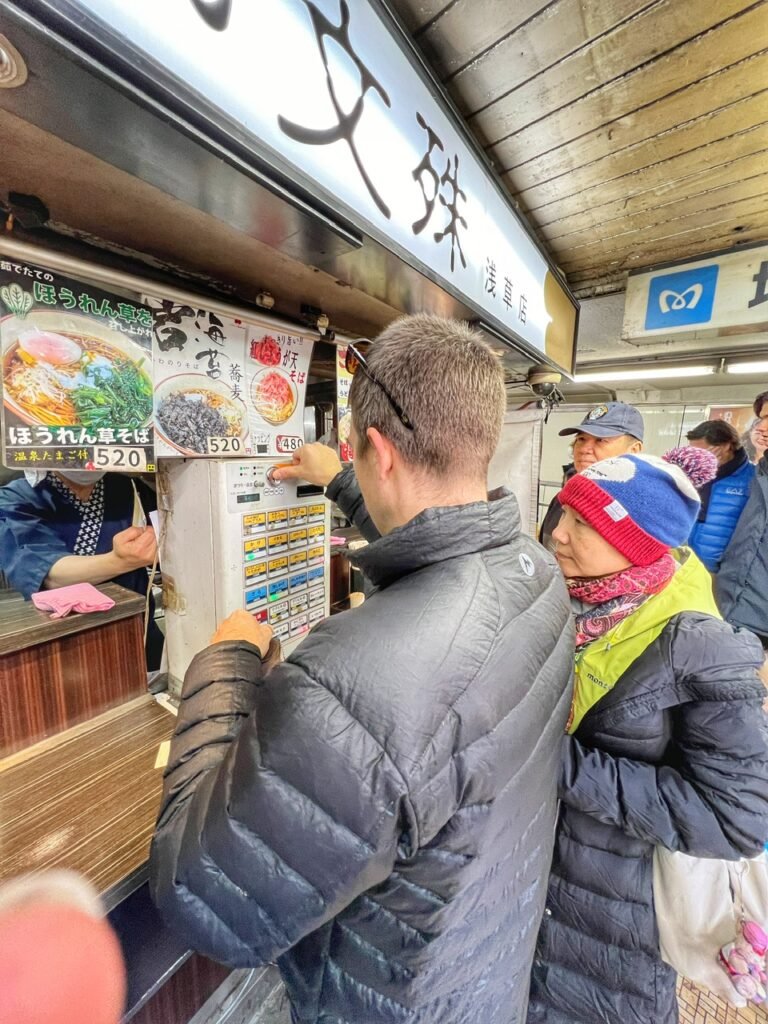
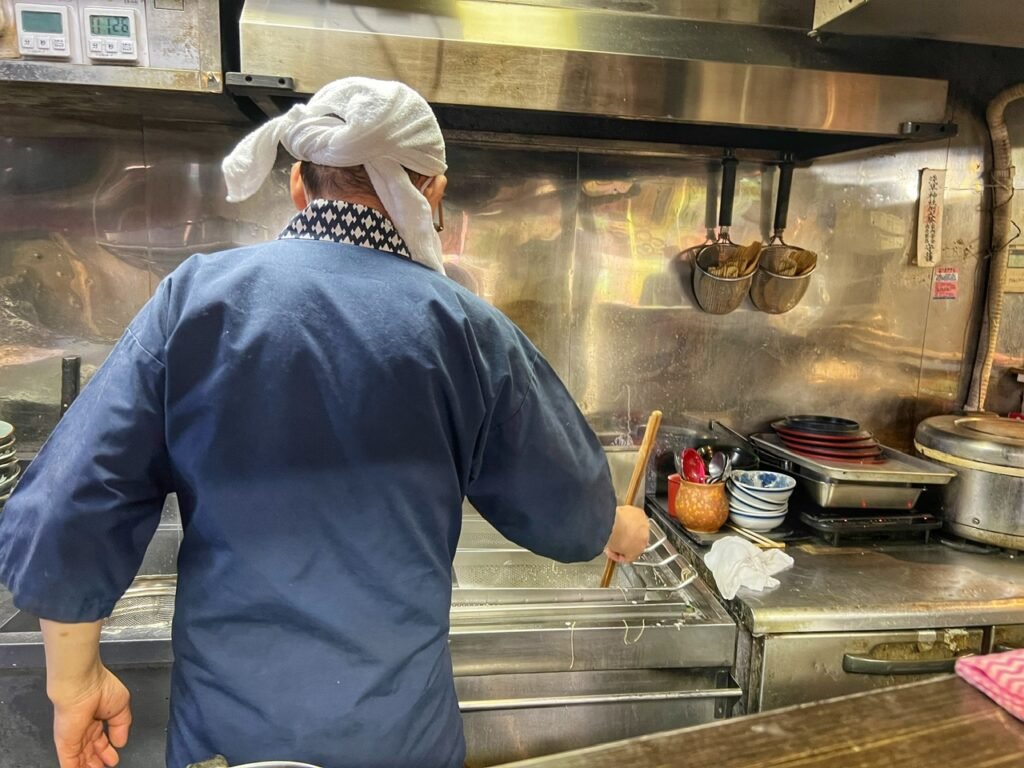
Ordering our actual food was also a bit of a mystery. You have to first translate the menu with Google Camera, then once you make your selection find the corresponding squiggly marks on the small machine where you deposit your change, then a ticket spits out. Fortunately a kind local lady (to the right) who spoke a little English helped us figure out all this, otherwise we may have been standing there all day. 🤣
You then give your ticket to the chef who begins whipping up your bowl immediately in the adjoining kitchen.
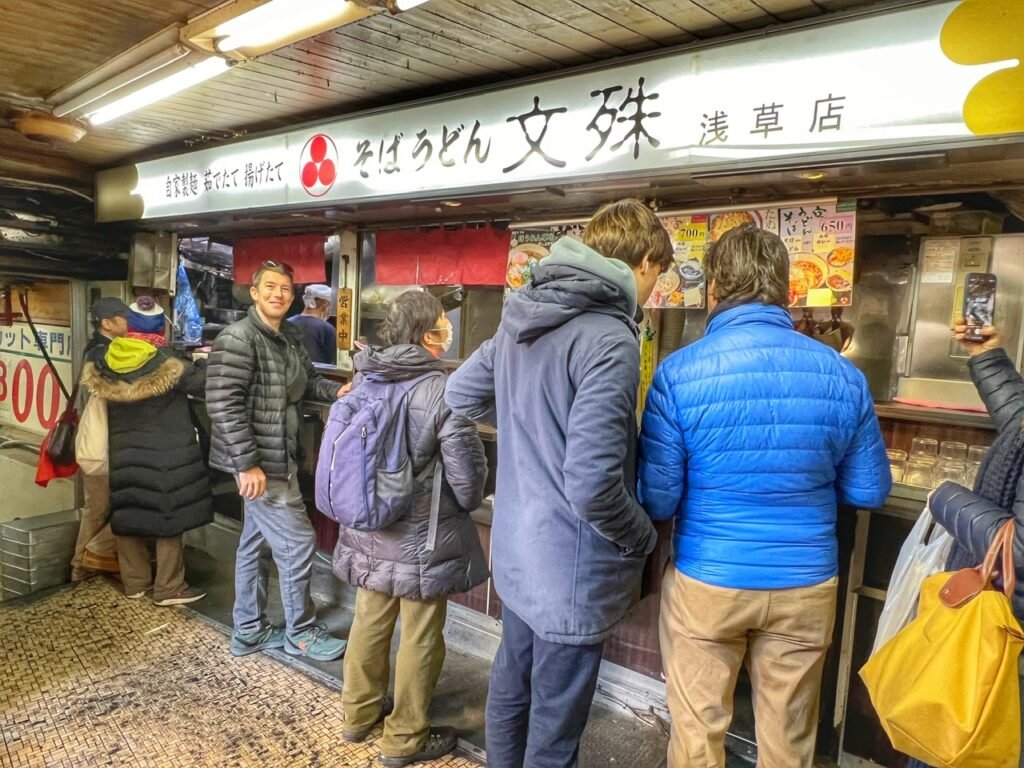
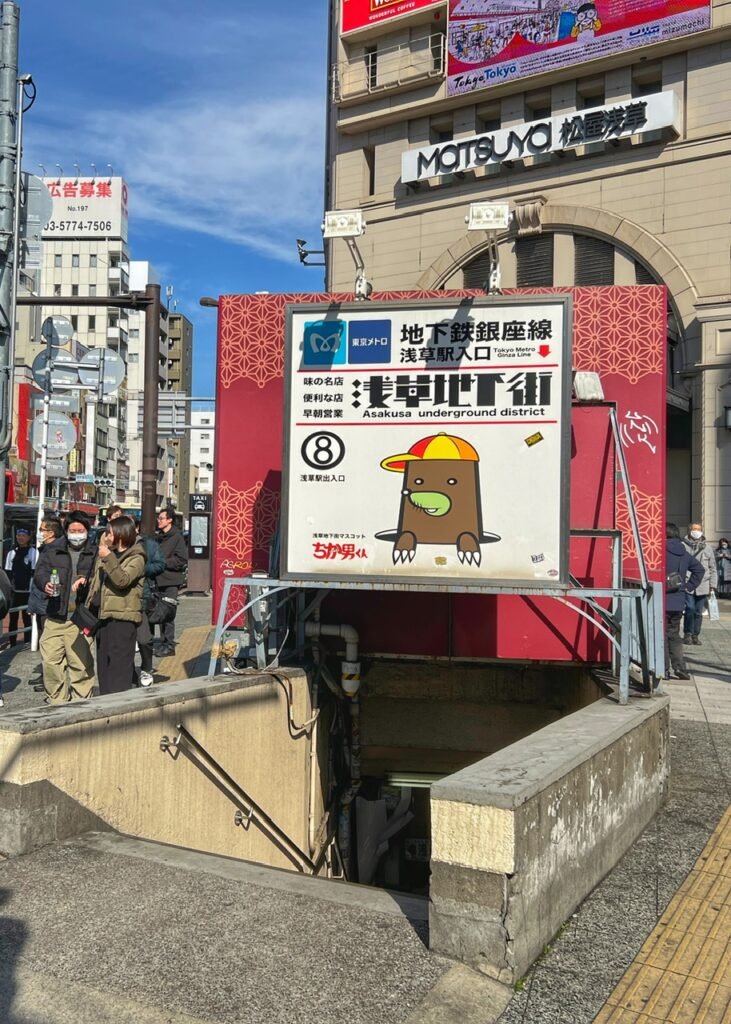
Finally, you hoover your food standing up at the counter, and apparently the louder you slurp, the more compliments you are giving to the chef. So, we decided, why not?! When in Tokyo…
By the way, the entrances to the Asakusa Underground are hardly noticeable unless you know where to find them. This little beaver might help…
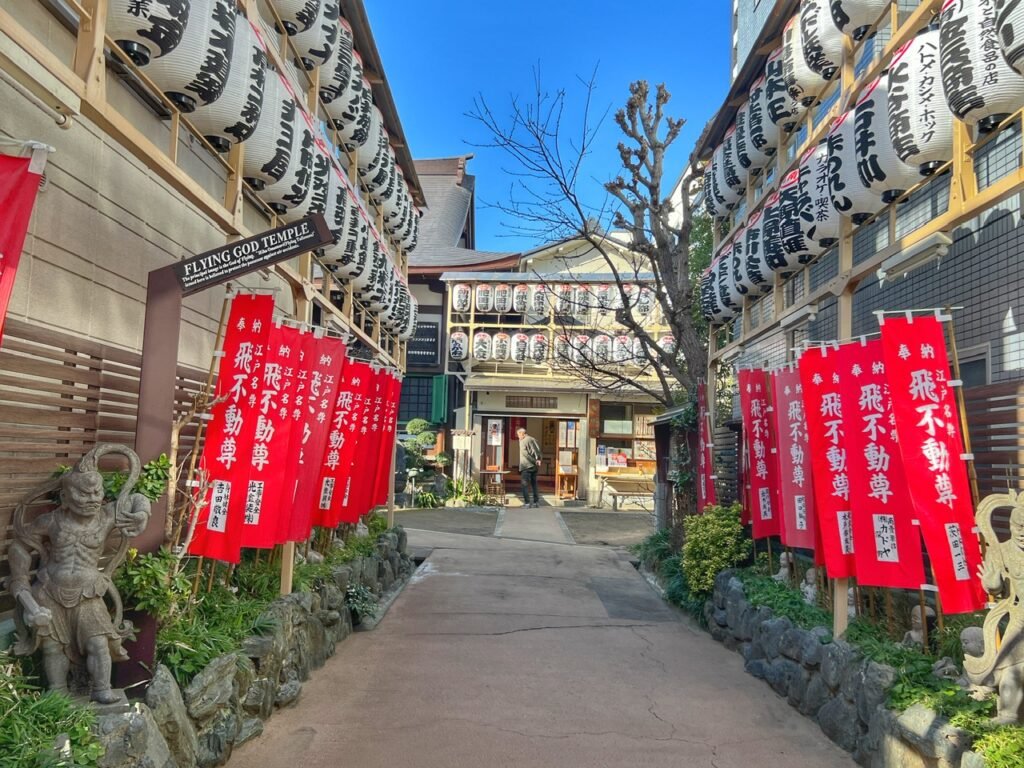
The entrance to the “Flying God Temple” was near our hostel. According to the Shinto religion, this is the god you should visit when preparing to take a trip. Since we’re always preparing to take a trip we figured we should pay our respects to this guy.
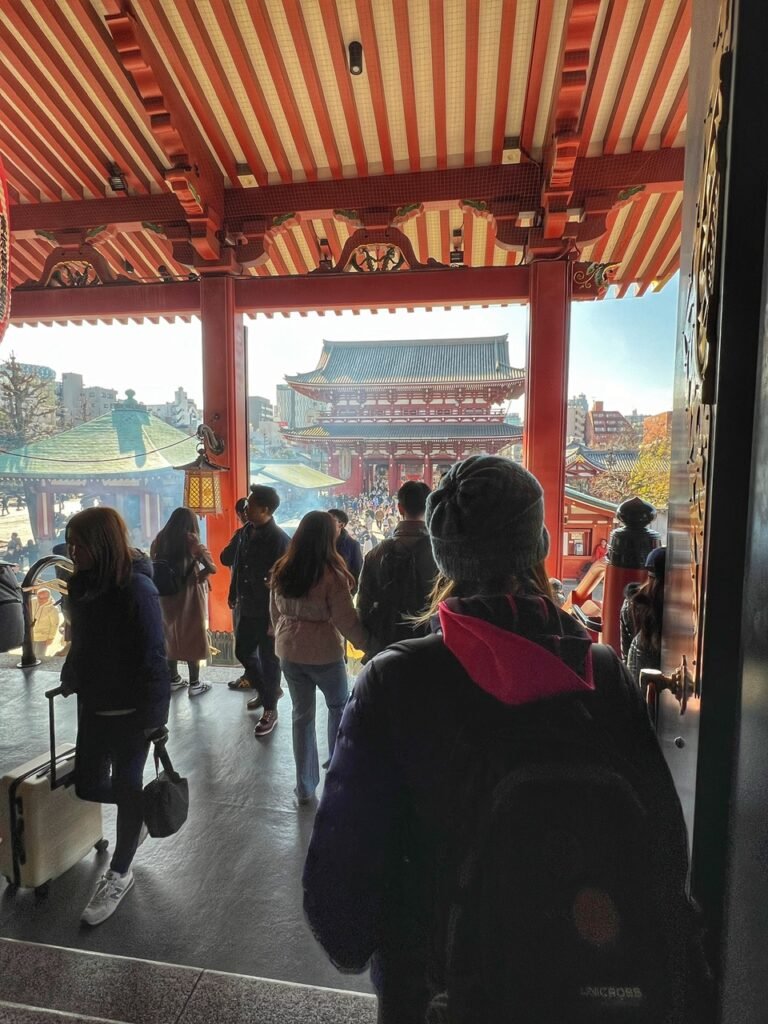
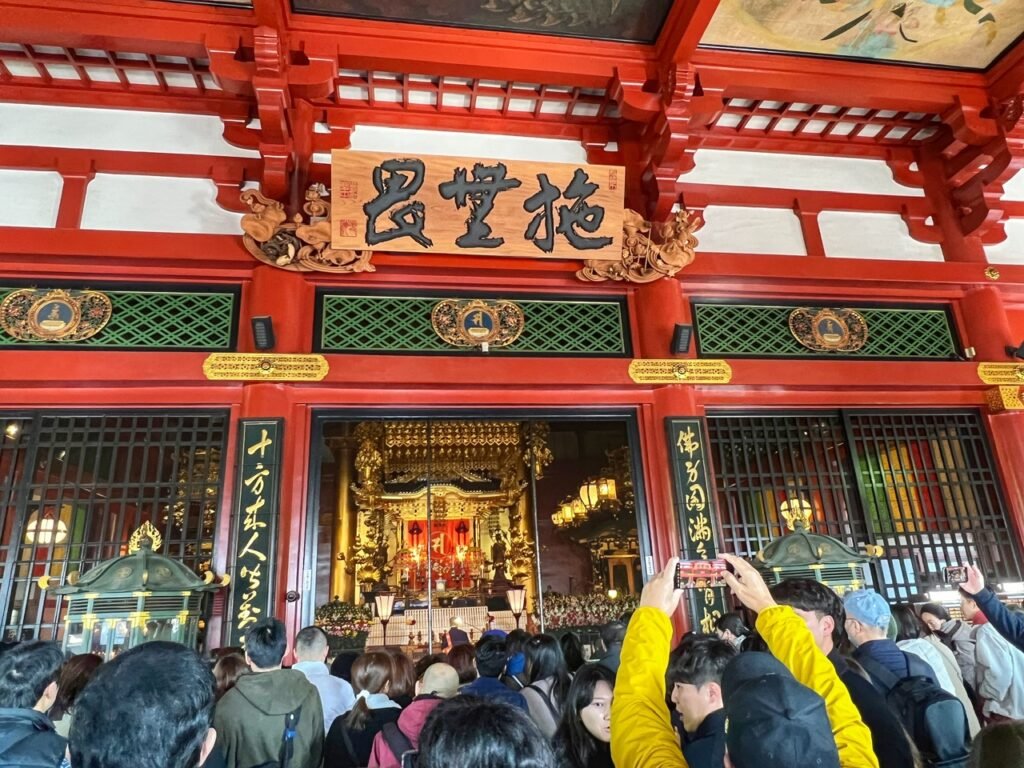
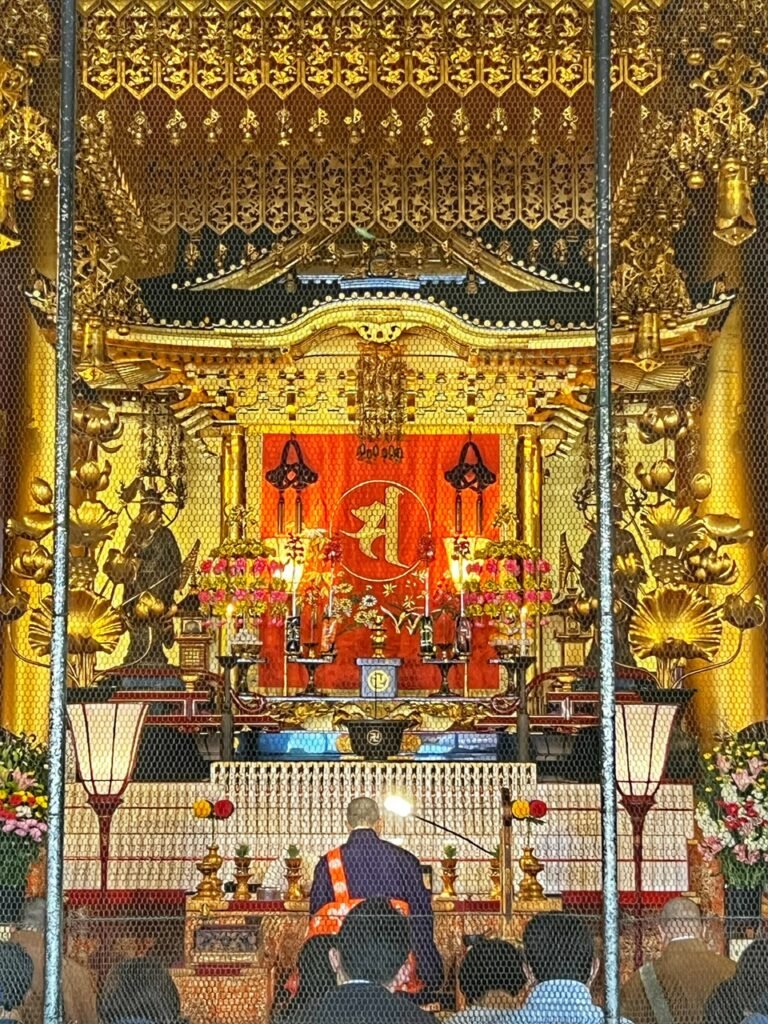
Remember the quiet, desolate and gorgeous temple from the other night? It turned into an obnoxious madhouse on Saturday morning at 10, which also corresponded to the start of Lunar New Year. As much as we enjoy getting shoved by a slew of pushy Chinese tourists, and standing in a sea of selfie sticks, we kinda preferred the first night. We did get to peek inside the actual temple, however.
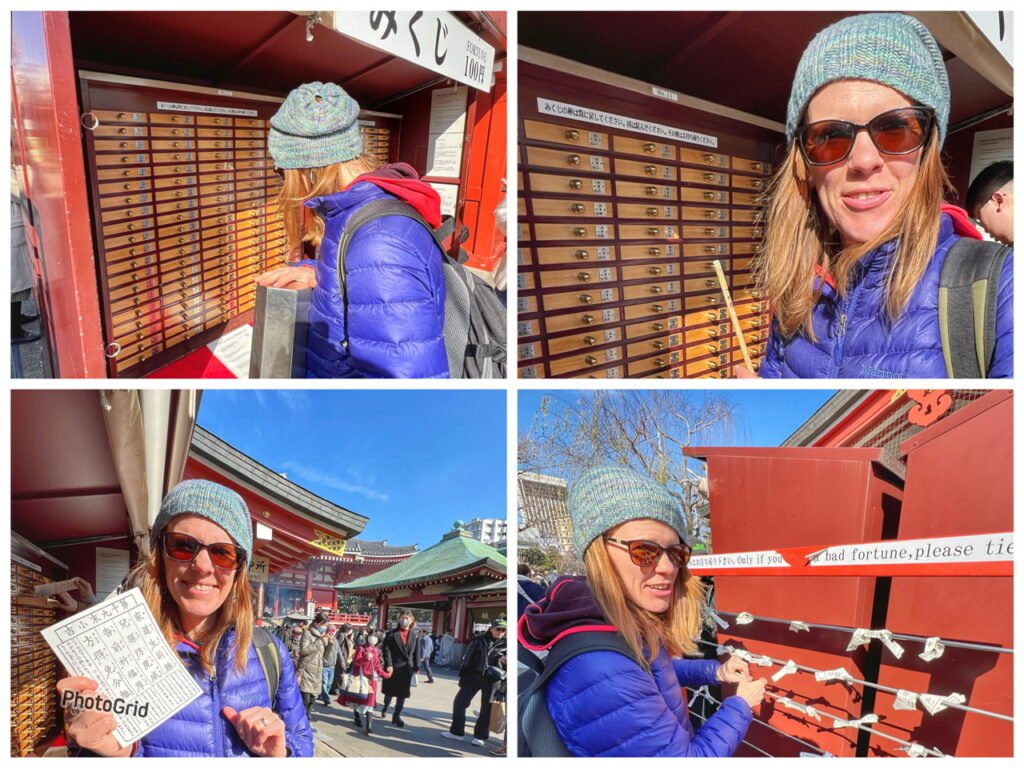
Also, this time we brought our 100 yen to read our fortune…
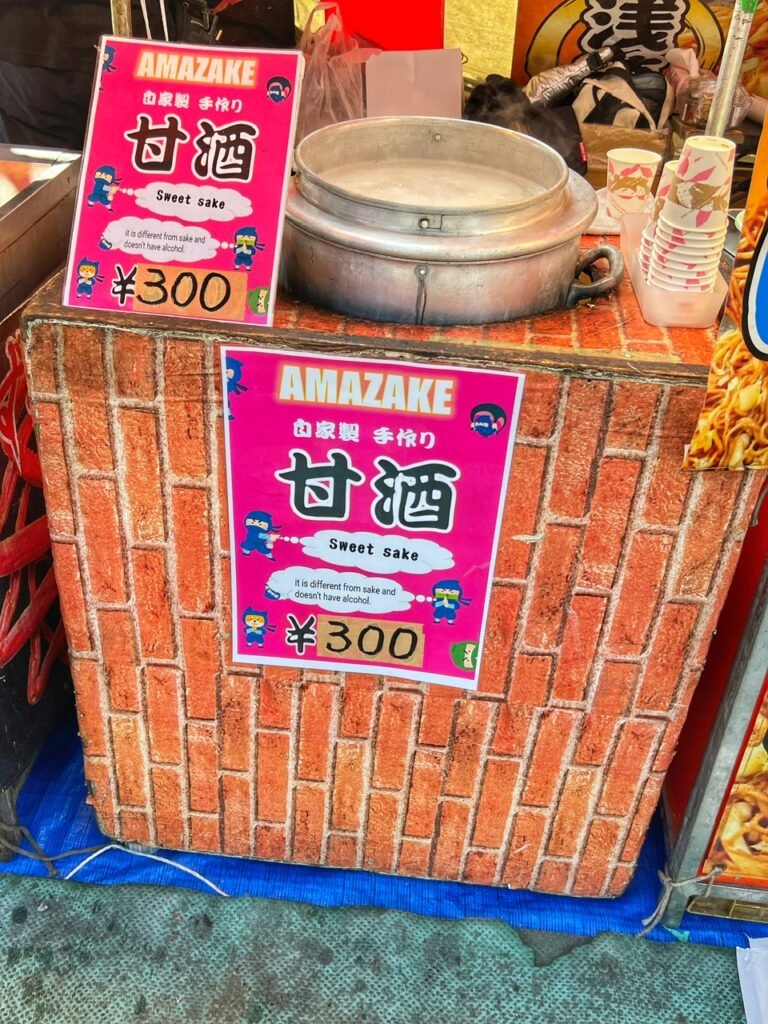

Afterwards, we got wooed by the tourist goodies and bought some sweet sake for the same price as our noodles. It was non-alcoholic and kinda sucky, although the view wasn’t too shabby.
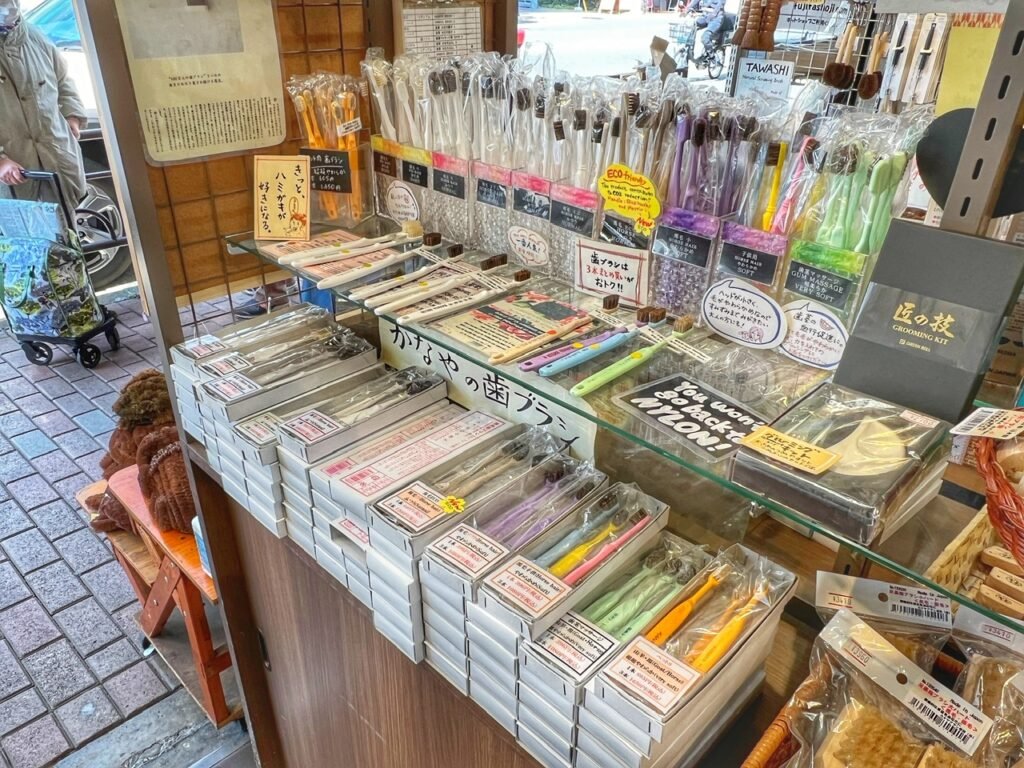
From there, we walked over to Kapabashi Street, also known as Kitchen Town, which is where you can find all things for your kitchen. Obviously we don’t have a kitchen, or even a cupboard to our name, so we’re usually not big shoppers for this kind of thing. But shopping in Japan is a very different experience…because you’re constantly gazing around in awe wondering why you didn’t think of something. For example, an entire store devoted to brushes. Any kind of brush you can imagine.
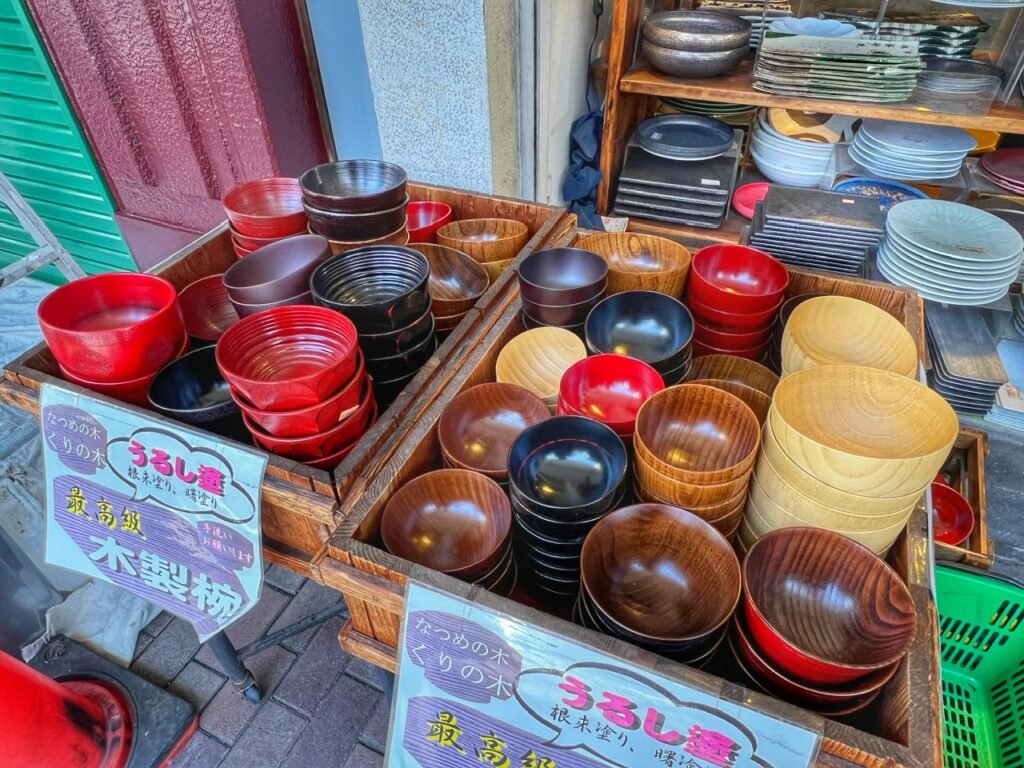
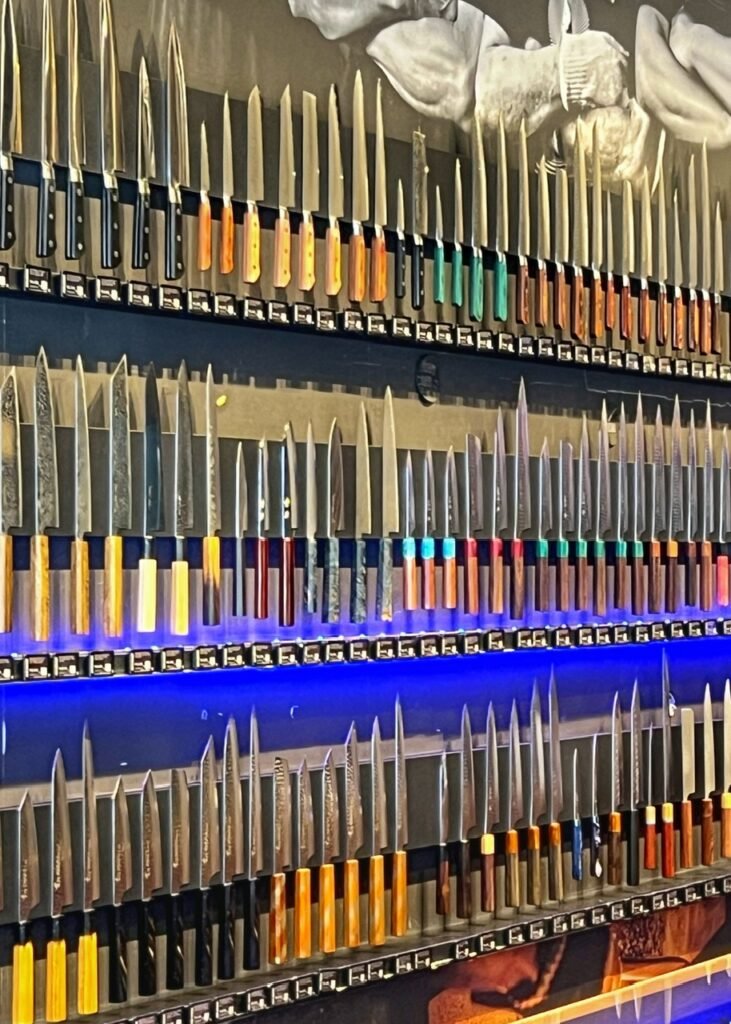
The cutest bowls, and a whole store of the finest quality Japanese knives.

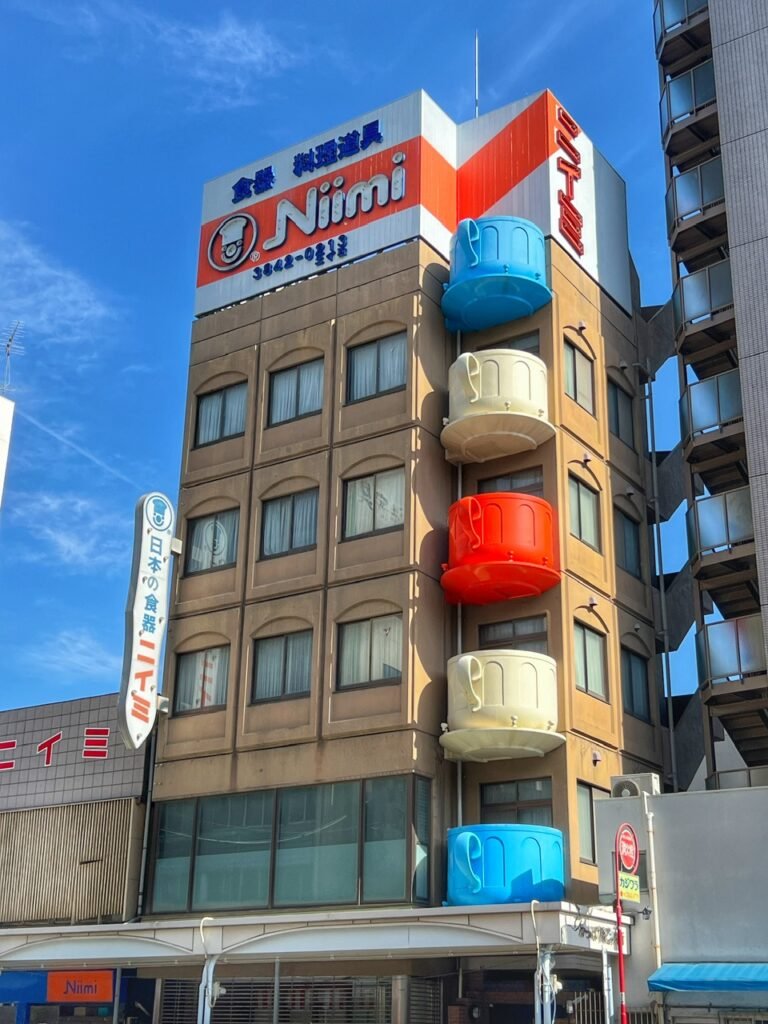
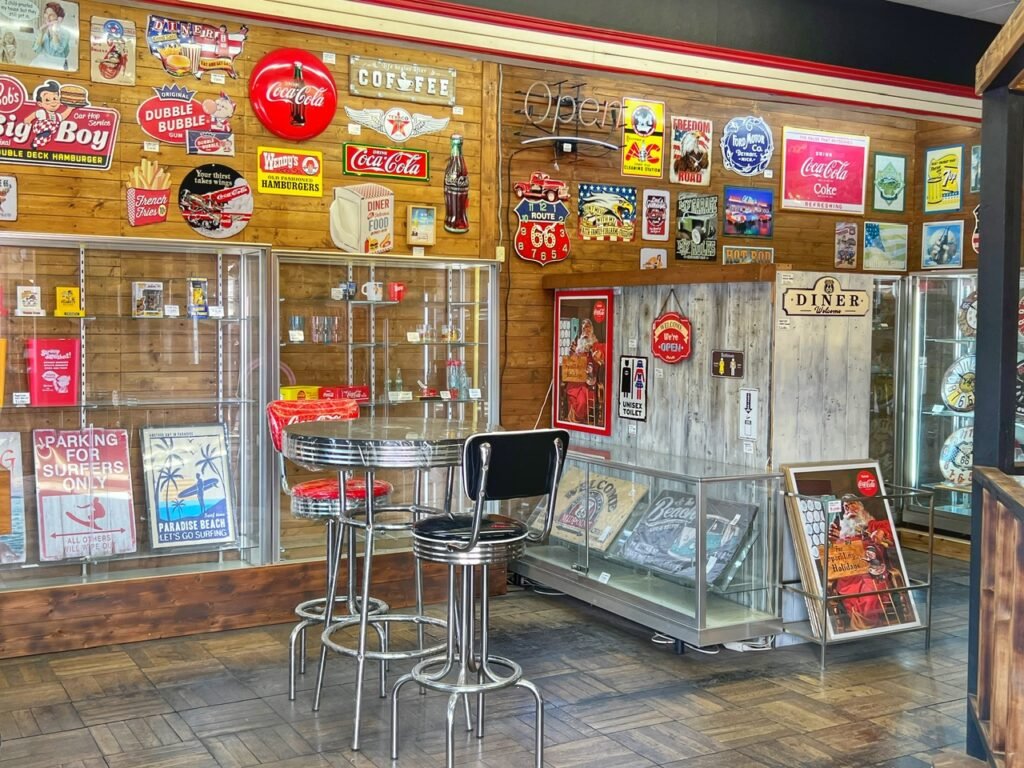
If goods are not of interest, there’s also a giant chef head, some tea cup balconies, and even a store devoted to all things Americana.
For the second half of day two, we walked from Asakusa to the Ueno neighborhood. Here we laid eyes for the first time on the notorious Fugu sushi fish popularized to the west by Homer-San Simpson, soaked in the flowers at a plum blossom festival, watched some fierce swan boats on Shinobazu Pond, gallivanted our first department store, (which threw Macy’s out of the water), devoured our first merry-go-round sushi with the locals, and ended at a Couchsurf with an incredible Egyptian family on the outskirts of the city.
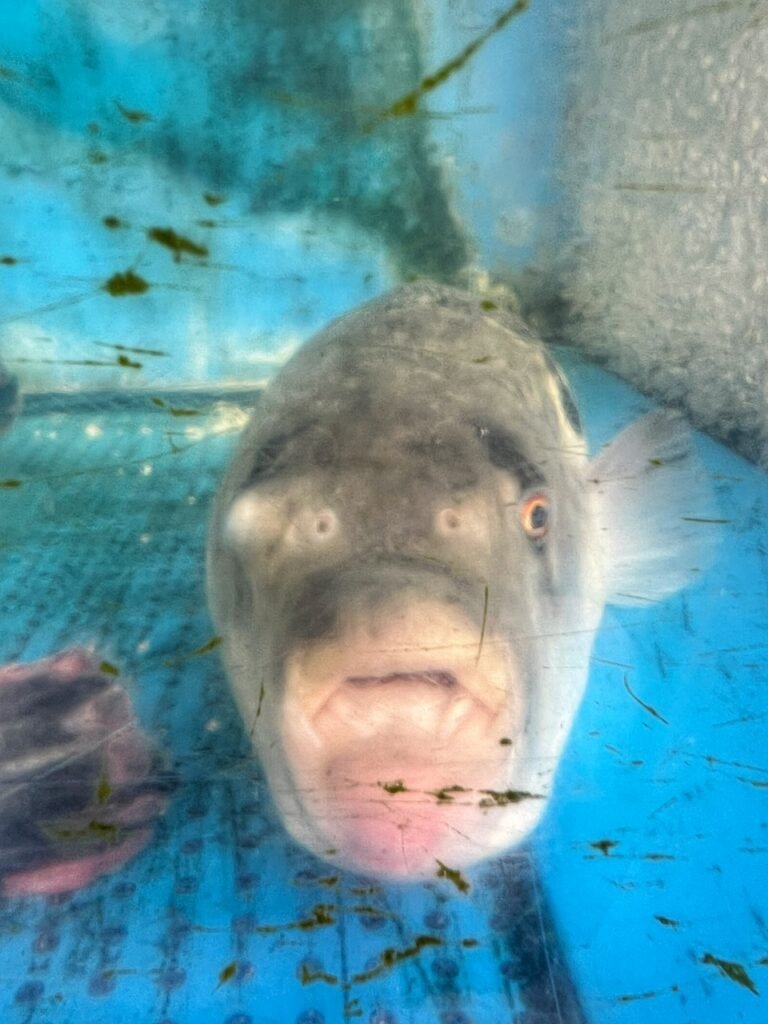
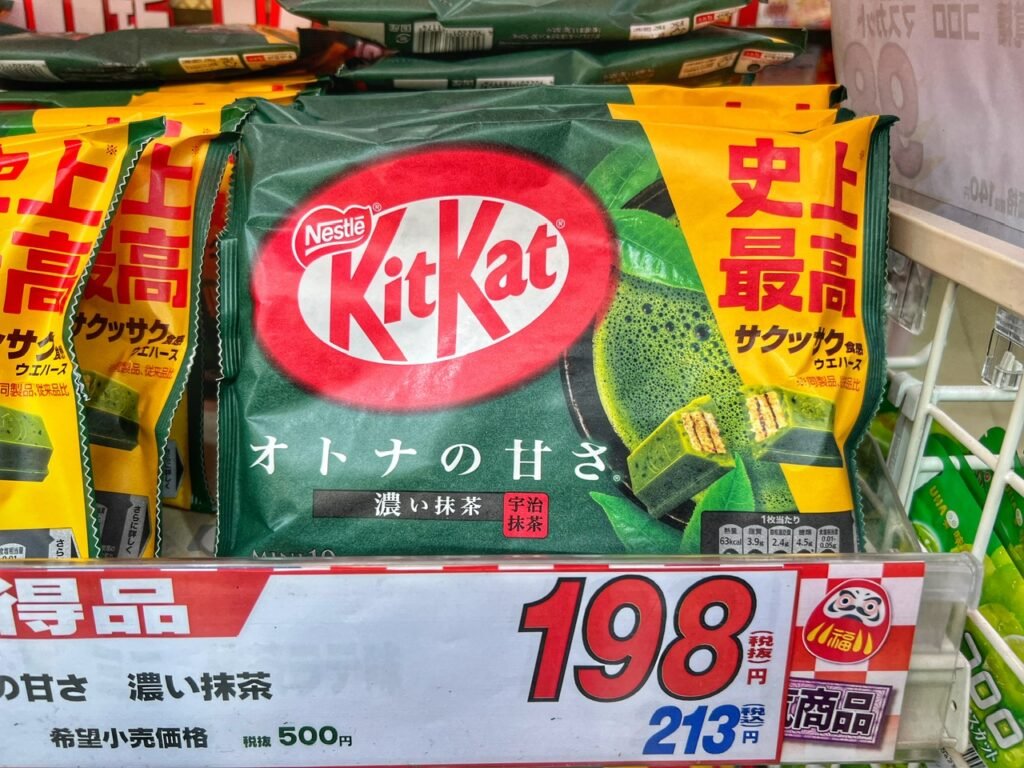
One of the most unusual things to eat in the world, and also potentially one of the most dangerous, is fugu Japanese pufferfish sushi. Not all, but the most desired sub-species of fugu contain toxins 1000 times deadlier than cyanide that can kill if not properly prepared so it’s absolutely necessary if you choose to eat it, you do so from a licensed chef, which Tokyo has hundreds.(Japan Travels_com) It’s also very pricey and seen as a luxury item giving us two reasons not to chow down. Ah, but aren’t they cute and snuggly looking?! 🤣
If you fancy something different and aren’t into deadly fugu, consider picking up a matcha (green tea) flavored anything. This one in Kit Kat form.
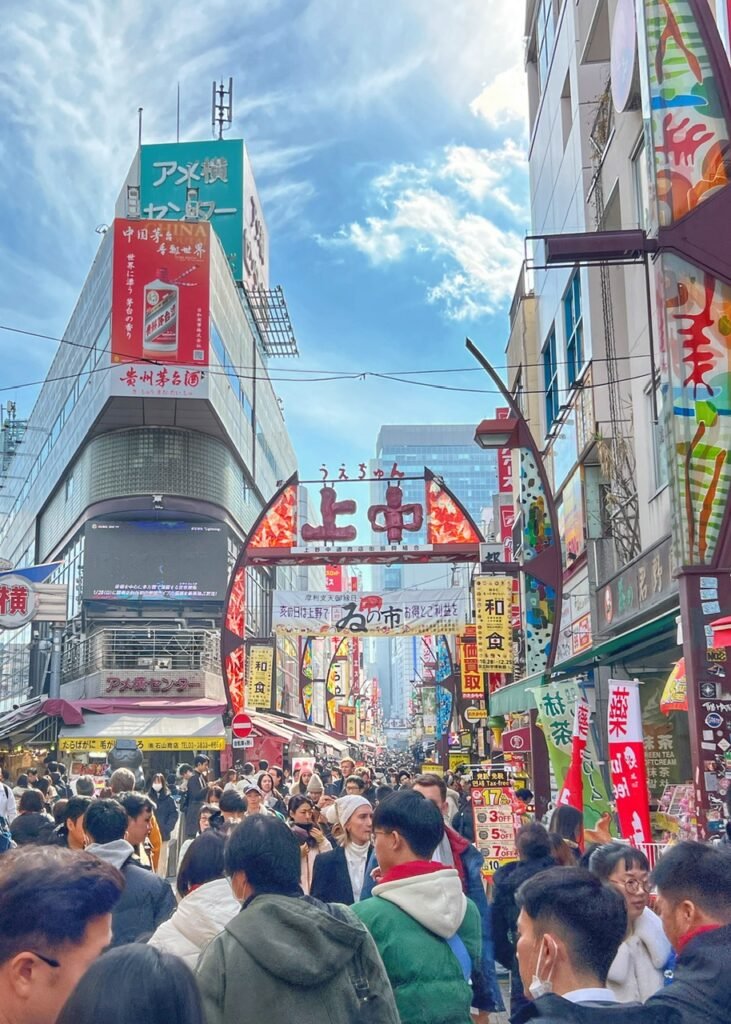
The entrance to Ami Yokocho, a bustling and vibrant shopping street. Prepare to stay to the left and ride along with the crowd. Now THIS feels like Tokyo!
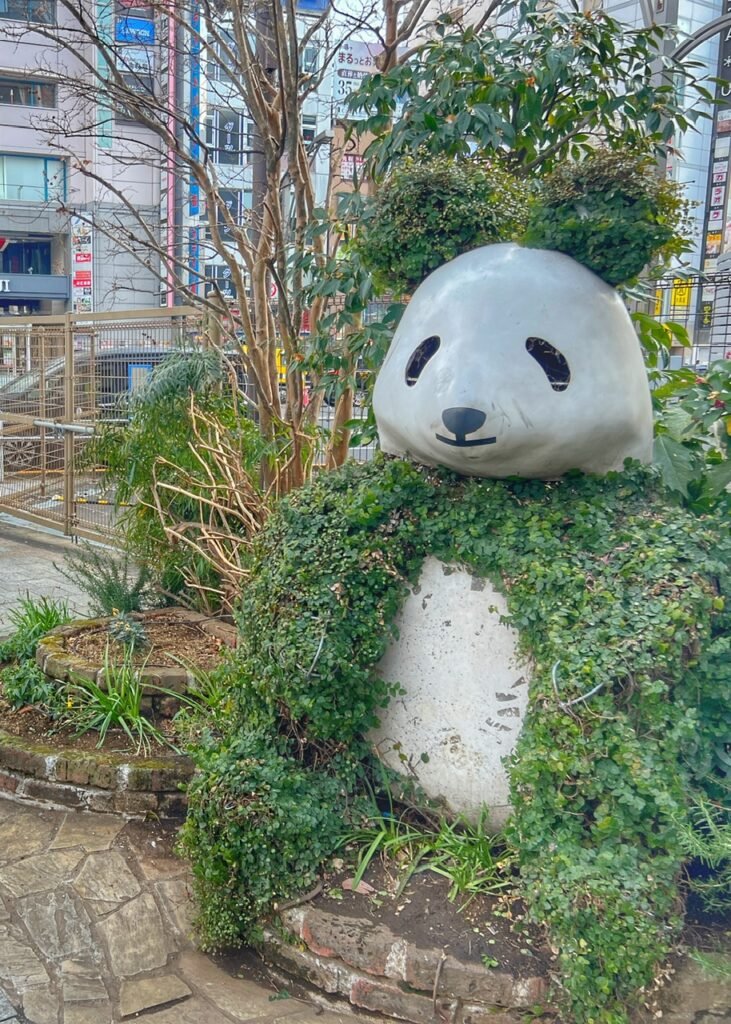
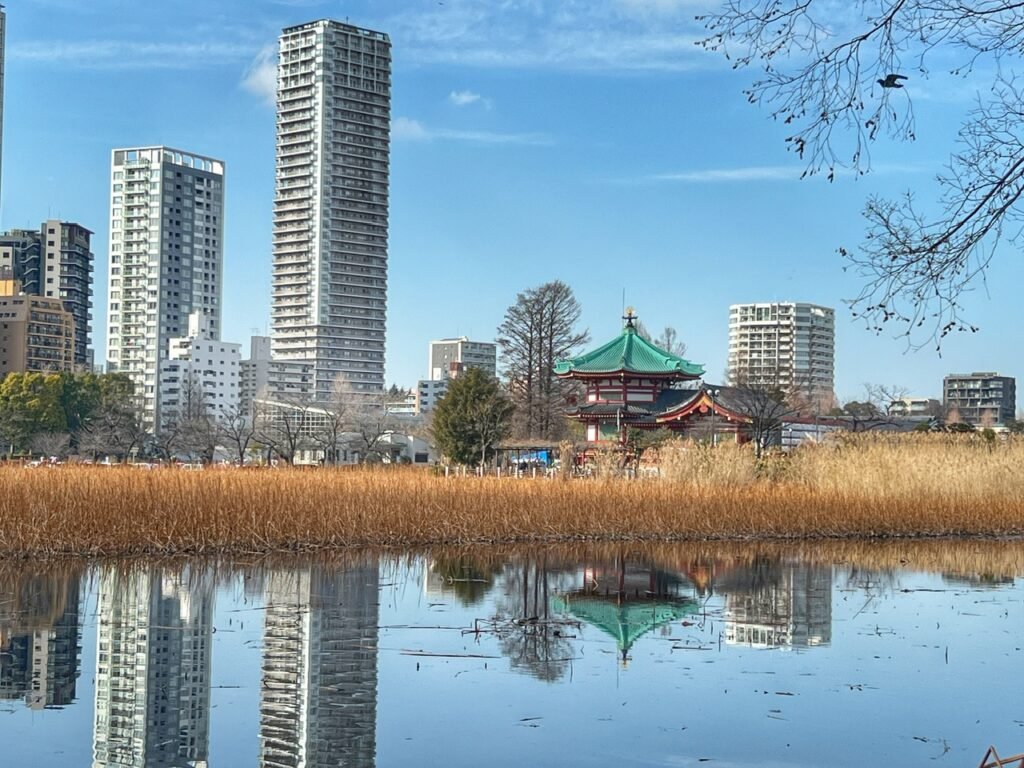
Shinobazu Pond is part of Ueno Zoological Park, which is the oldest zoo in Japan. Although we didn’t enter the zoo, we enjoyed the free boardwalks and sightseeing around the area.

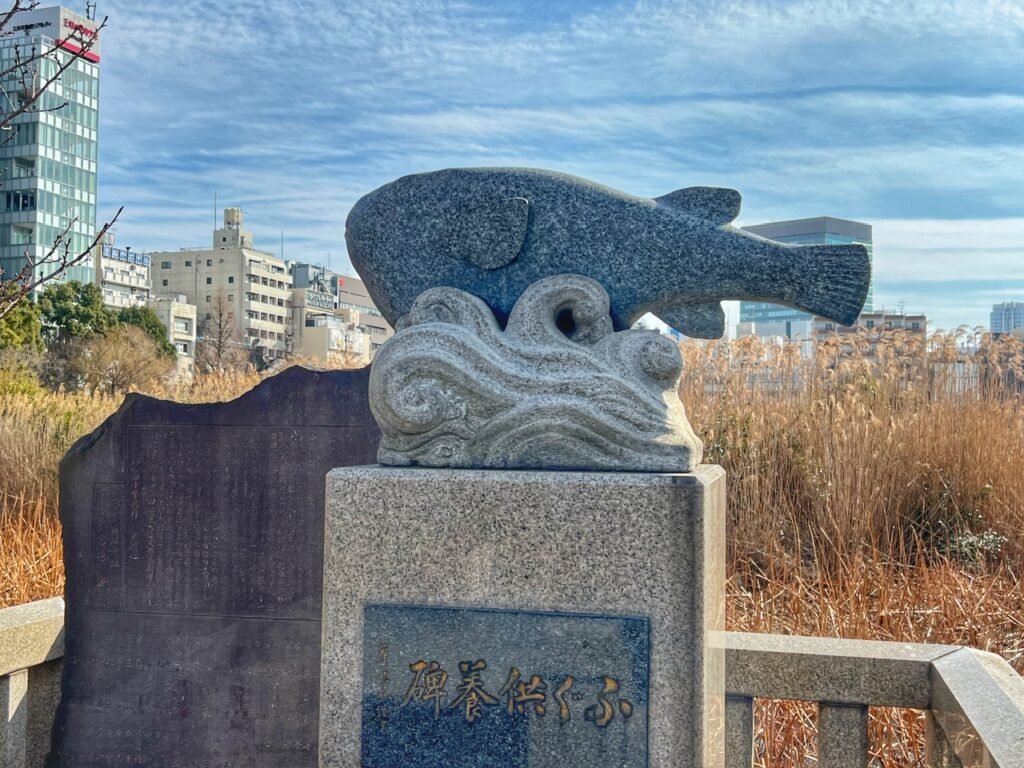
Meats on sticks are a staple of Japanese street food. But rather than corn dogs, they have shells, octopi, and “foot of squid.” Perhaps they mean tentacles?! 😂
And, just so we couldnt fugoot about it, we ran into the Fugu Tsuito-hi, or the Blowfish Memorial. It was dedicated by the Tokyo Fugu Cuisine Association to the spirits of the fugu. The monument is offered in gratitude, and in the hope that there are no future deaths by poisoning. (Atlas Obscura)
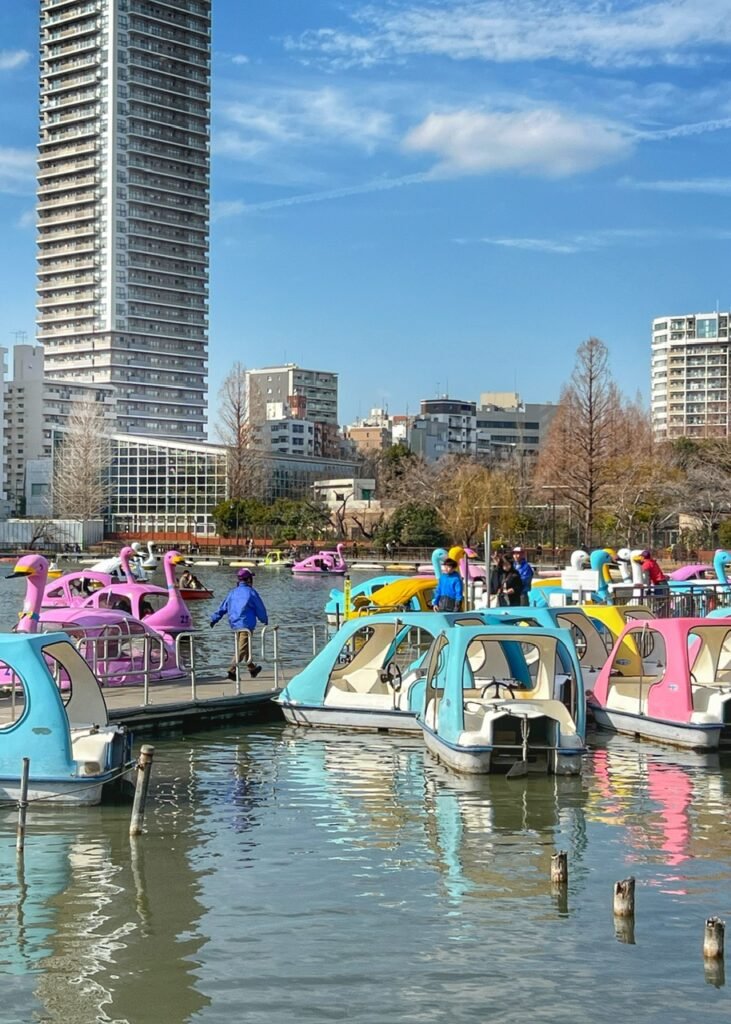
We also hoped there was no deaths by swan boat drivers in the pond. That flock looked pretty frisky. The price to ride for an hour was 800 yen or about $5, which seemed pretty reasonable.


Moving on, we arrived to the Yushima Tenmangu temple, or site of some plum festival activities. To the right you’ll notice many small wooden plaques hanging on the wall. These are called Ema on which Shinto and Buddhist worshippers write prayers or wishes. Ema are left hanging up at the shrine, where the kami (spirits or gods) are believed to receive them.
A perfectly styled bonsai bush. Like the Homer Simpson fugu episode, our mind embarrassingly reverts to our western upbringing when Mr. Belding mutilates a Bonsai plant in “Saved by the Bell.”

Another Japanese scene is another kind of vending machine…this time for ice cream. We were disappointed the only kind of unusual flavor was green tea. Also, not sure why the local looks like Seventeen magazine…
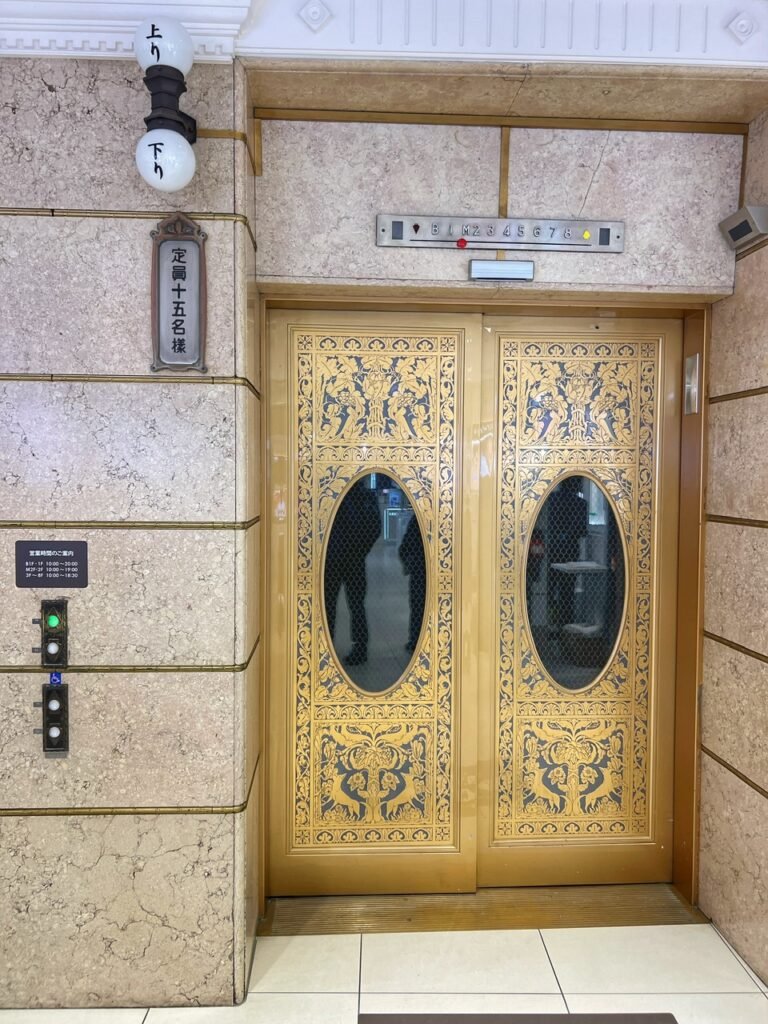
Our next stop took us to the Matsuzakaya Ueno Department Store, which is well worth a wander. We didn’t have time or stamina to explore all ten(!) floors, but certainly wanted to take the ornate historic elevator to the bottom floor so we could look for a gift for our Couchsurfing host.
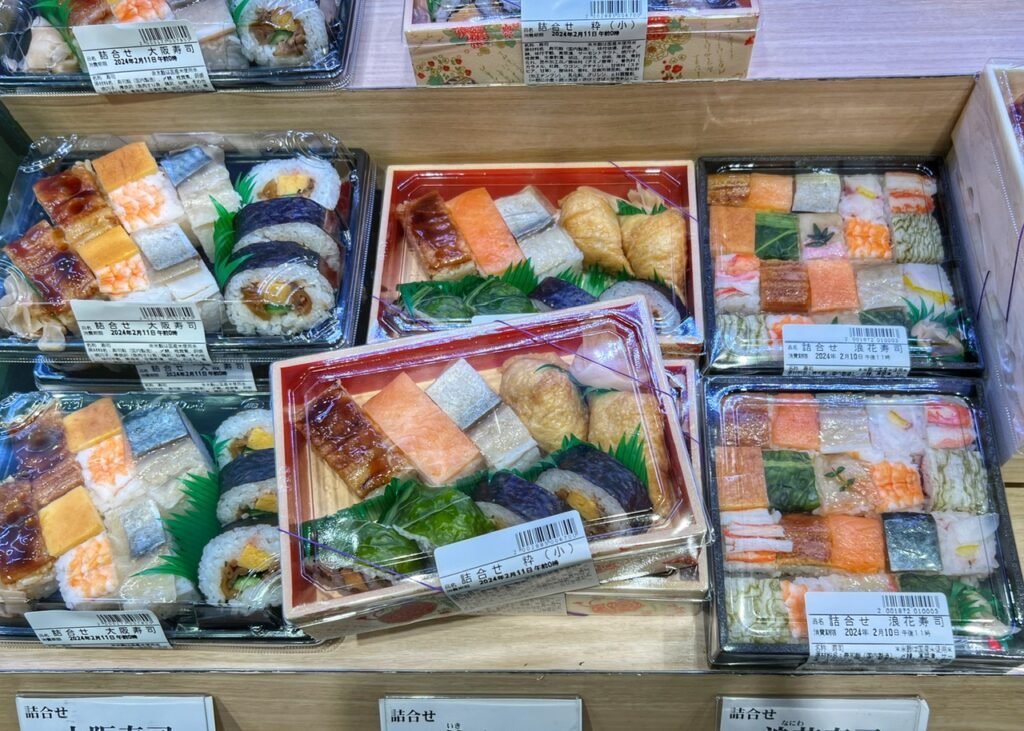

On the bottom floor one can find all kinds of to-go bento boxes and other speciality goods, as well as a regular grocery. We have to admit, we were a bit relieved to not have to navigate the supermarkets in Japan regularly because there would be a serious learning curve. 🤣
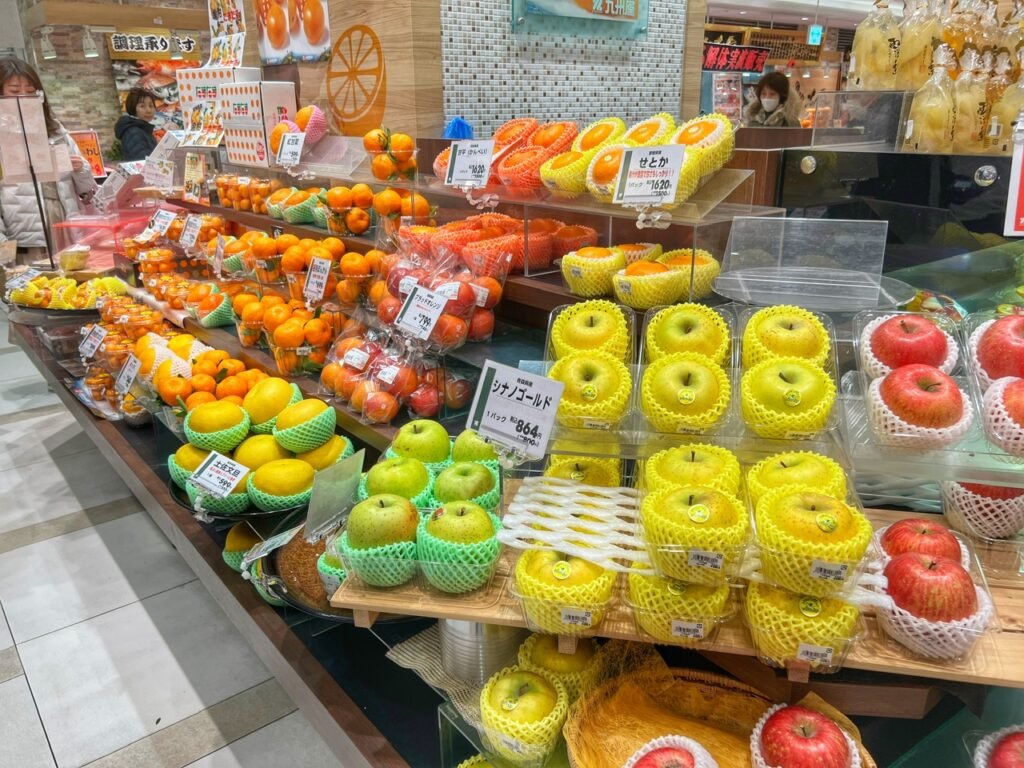
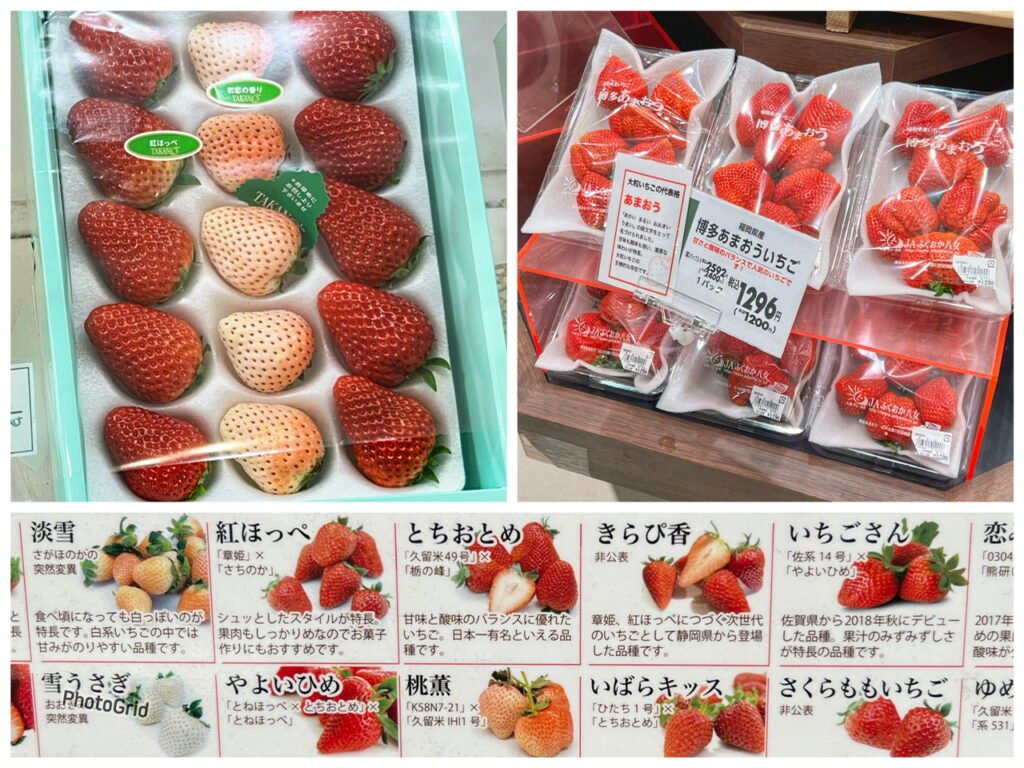
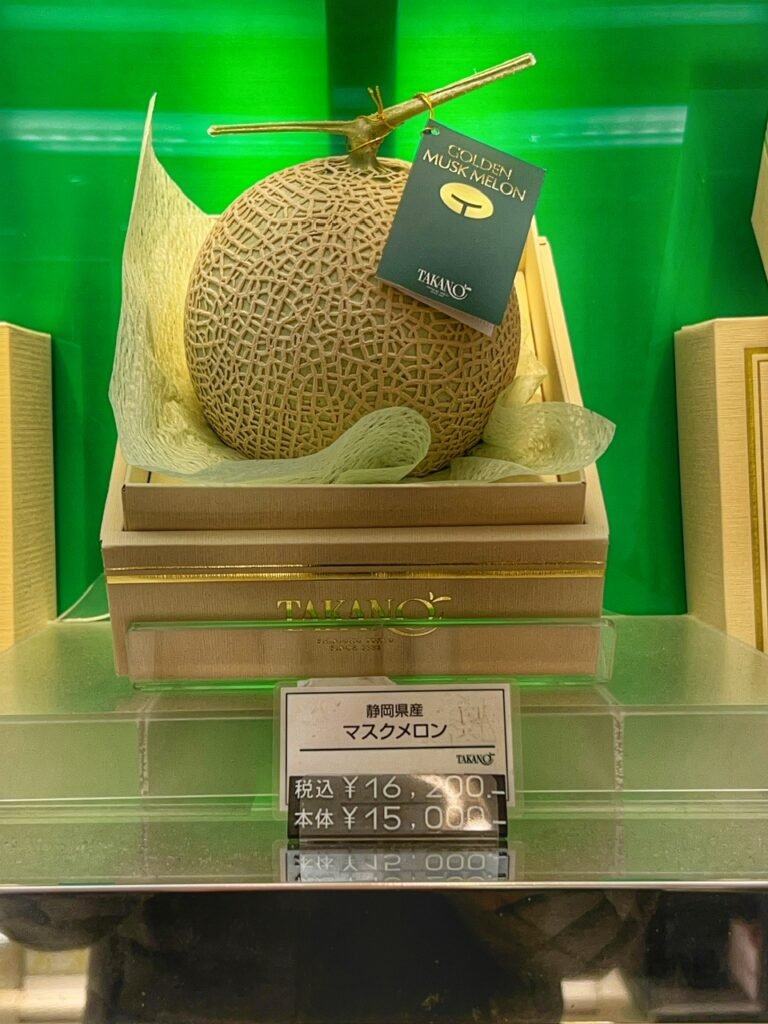
We are also aching for fruit…any fruit…it was so insanely expensive here and is treated as so with individually foam wrapped apples so perfect they belong in Eden, and strawberries packaged like chocolates for your Valentine. The box at top left of 15 was 6000 yen, or $40. The regular grocery store ones at right was 1300, or $9. The bottom features a menu of all the different types of Japanese strawberries from white to pink to rich red. Undoubtedly a Valentine marketers’ (healthy) dream. We may have to break down and buy some eventually because we did read they’re worth all the fuss, particularly the white ones.
We also wouldn’t be buying this golden musk melon. It’s priced at 16,000 yen, or $107, so instead we’ll hold out for the $.50 variety in SE Asia.
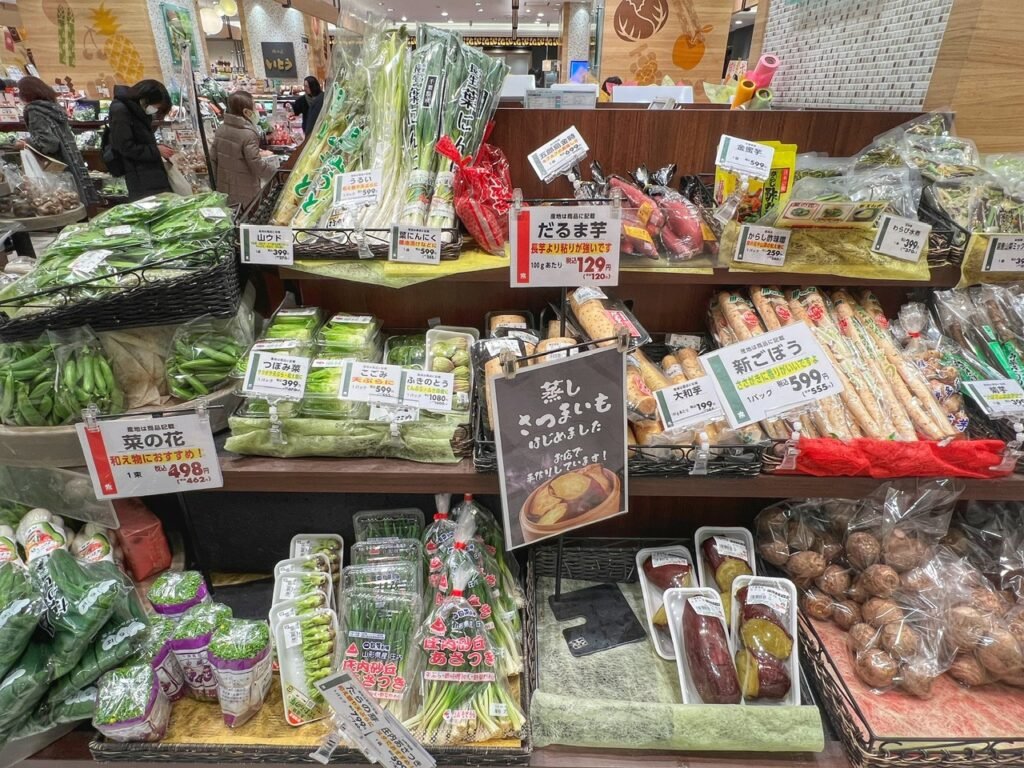
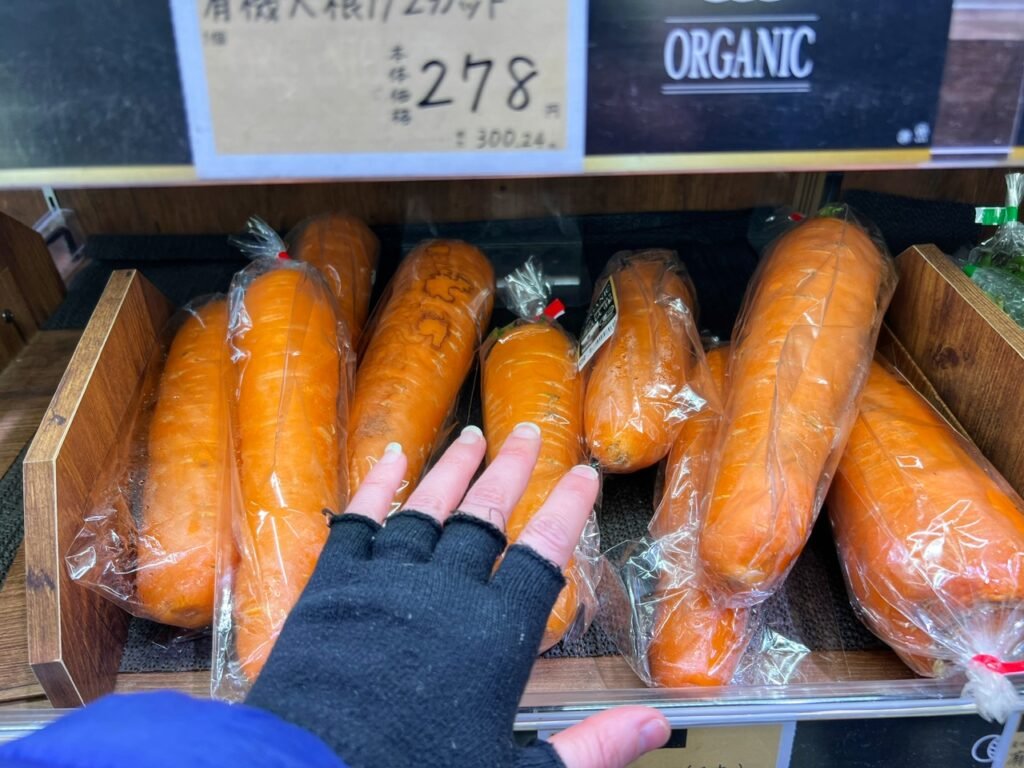
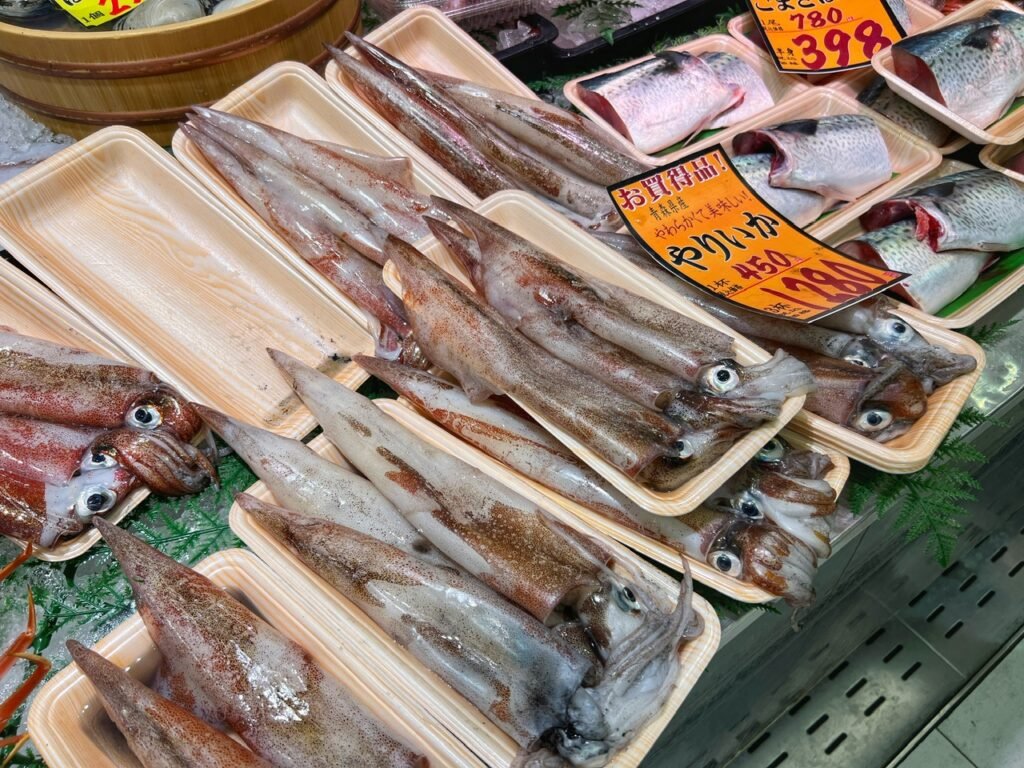
Fortunately, veggies at the market seem priced more like the US, and therefore, a little less desirable. (Aren’t they always?🤣) But what we most sad to see was all the plastic. In fact, this has been an ongoing issue we’ve noticed since our arrival in Japan. But that is one hefty plastic packed carrot for about $1.80 each! Also, is it just me, or are we getting stared at?
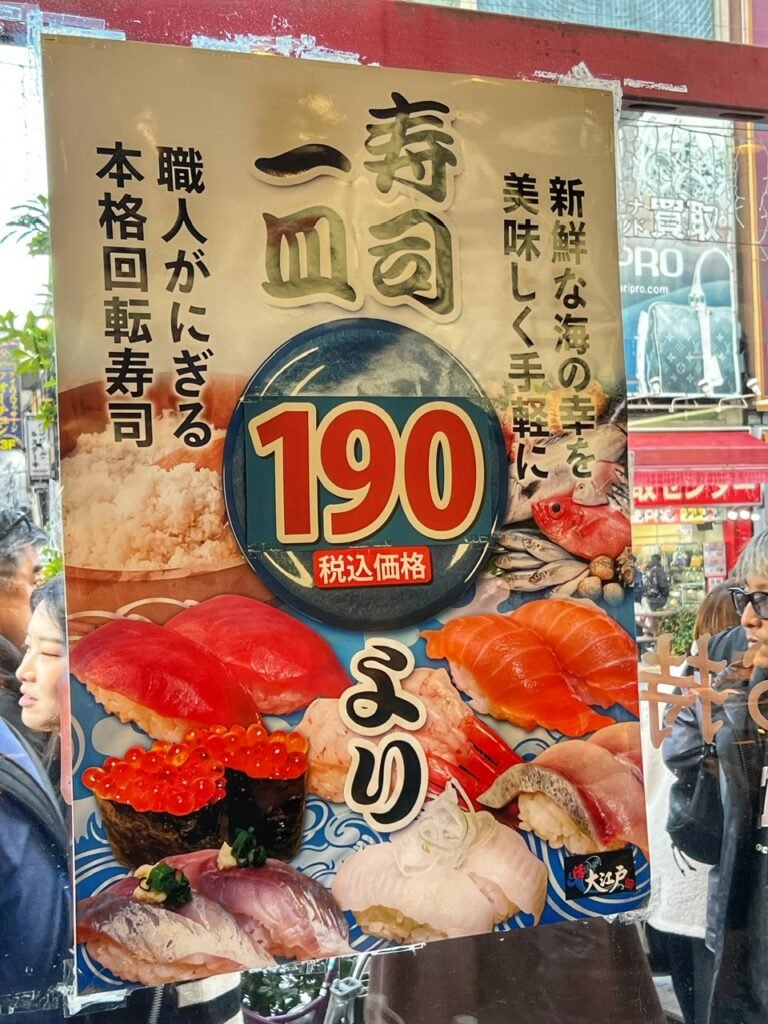

Moving on, we were excited to try our first Merry-Go-Round Sushi restaurant at Oedo Okachimachi where every plate is 190 yen ($1.20) or far cheaper than a carrot. Despite being the only Euro-mutts in the room, we were welcomed in with fervor and smiles and ushered to stand along the side until a spot for two opened.
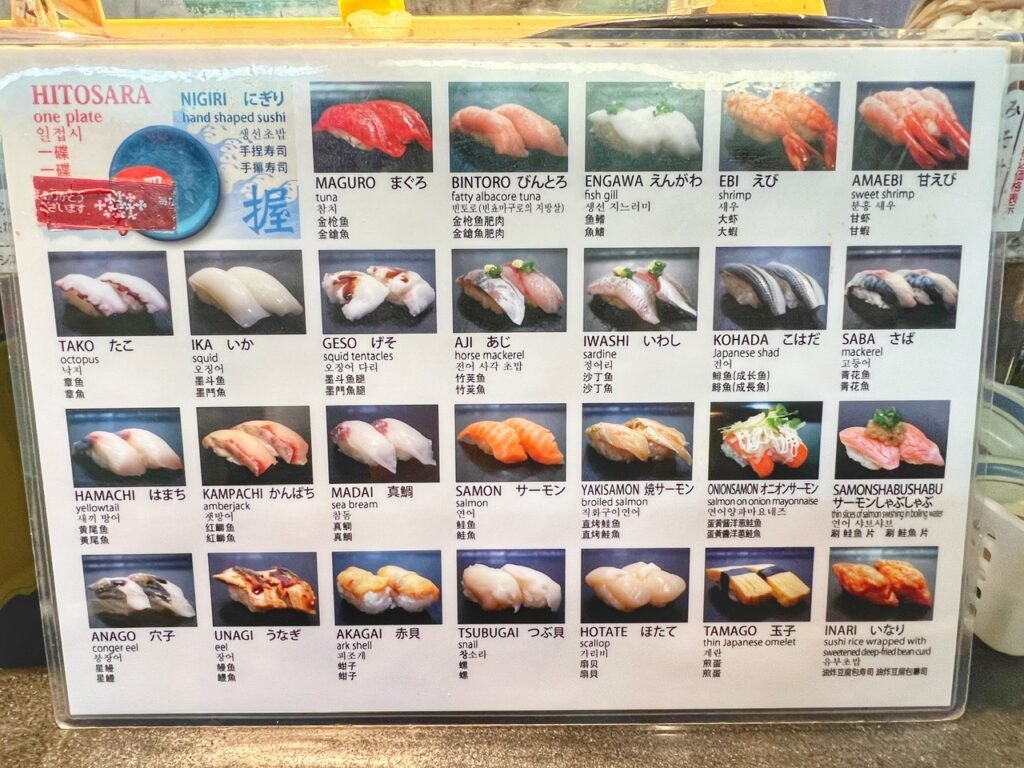
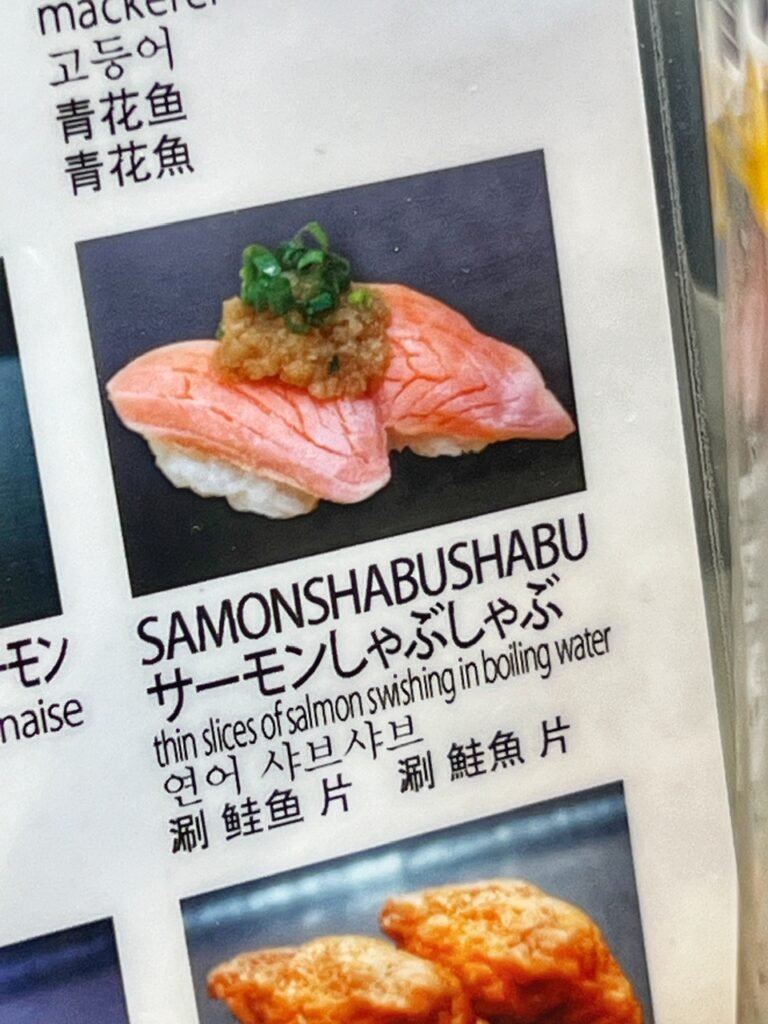

And once seated, we were presented with an English menu. Not that we needed it…because we just grabbed what looked good from the sushi moving sidewalk. They even had options like “thin slices of salmon swishing in boiling water.” The best part? The moving sidewalk also included a massive bowl of all-you-can-handle, sinus-clearing wasabi. So much better than the minuscule dollop of fake crap you often get in the States!
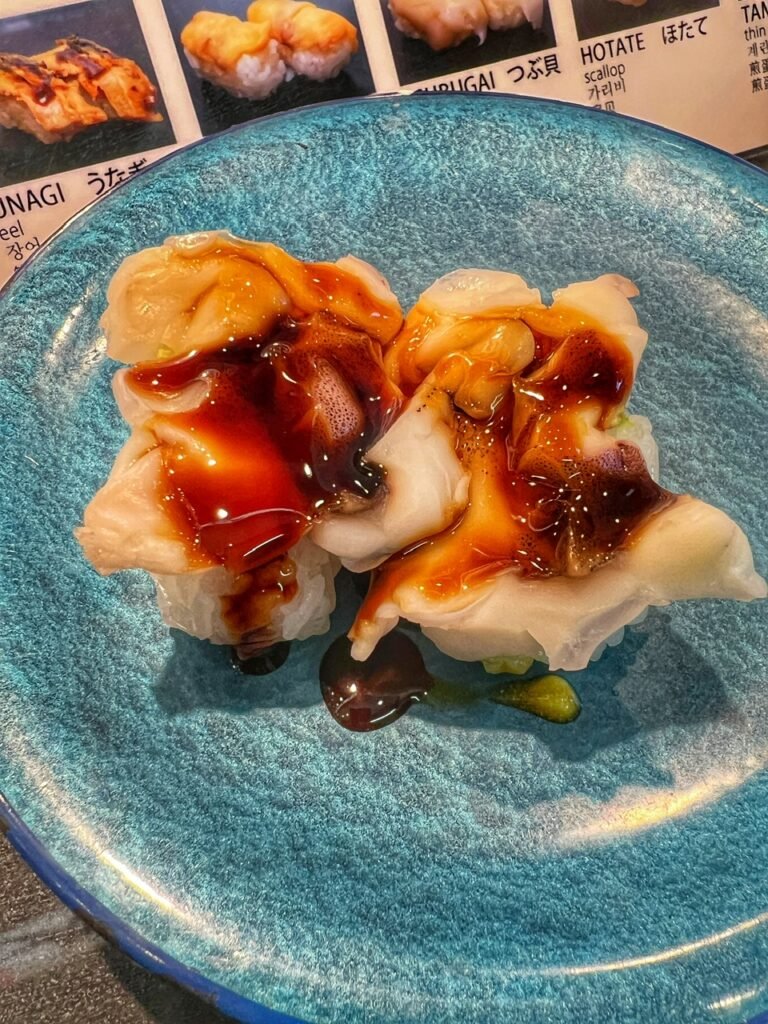
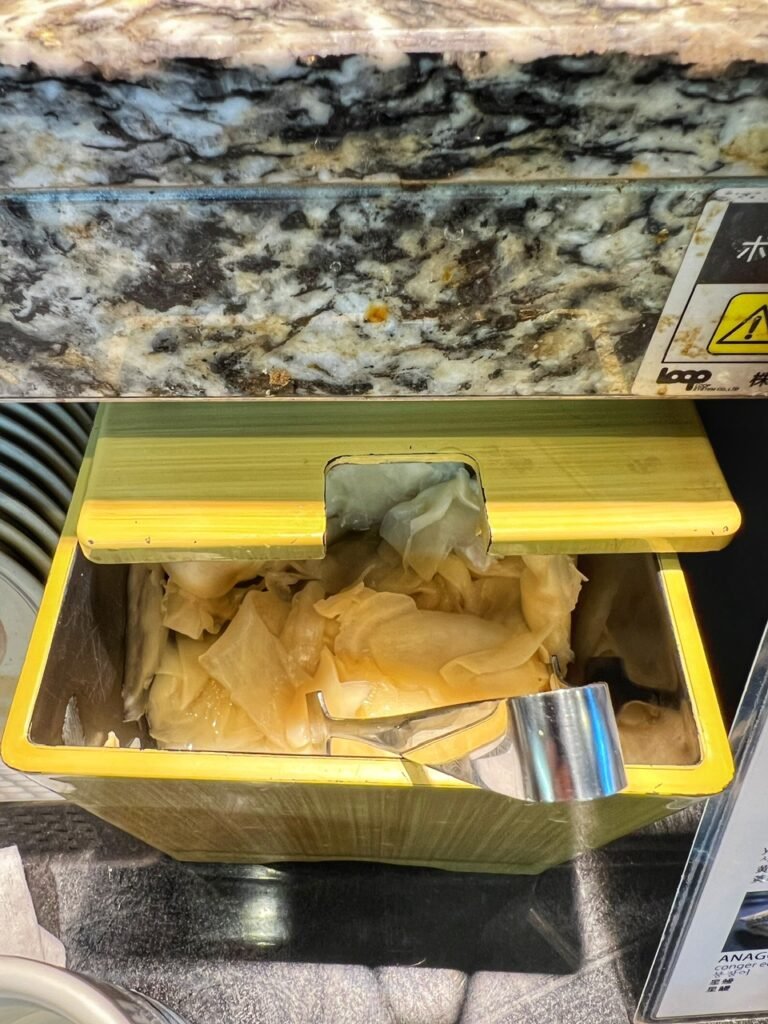
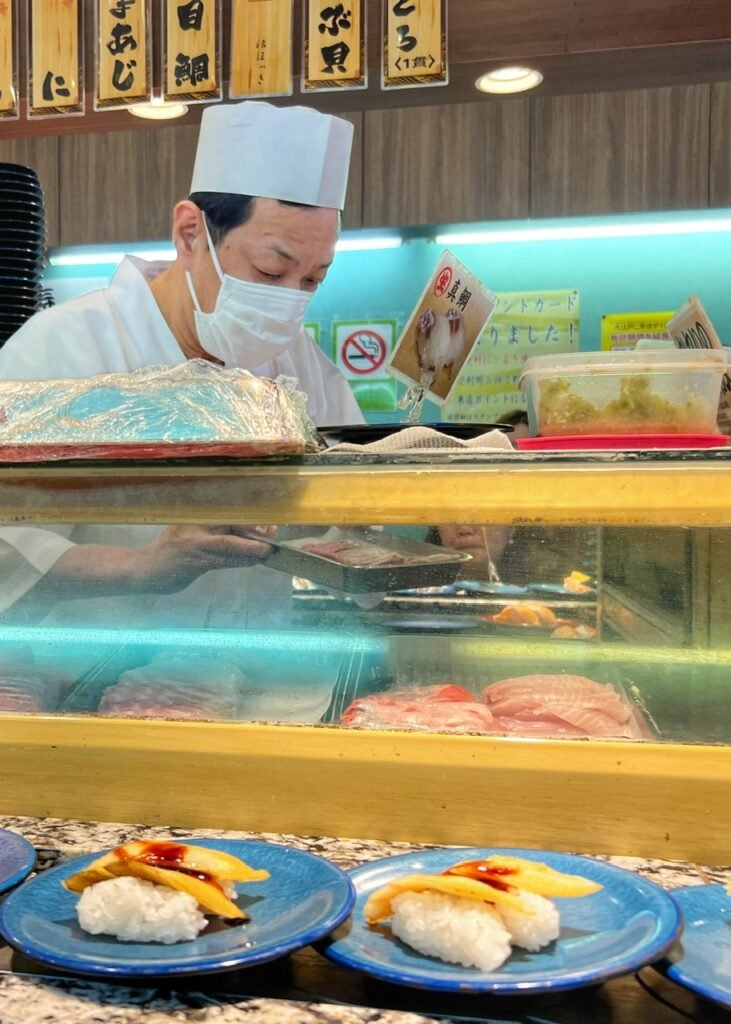
But, we stuck with mostly crowd favorites like tuna, eel and salmon, but did venture out and try some new ones like squid tentacles, washing it down with all-you-can-eat pickled ginger. It was all divine… and the guy behind the counter is actually Japanese and not Latino. 🤣
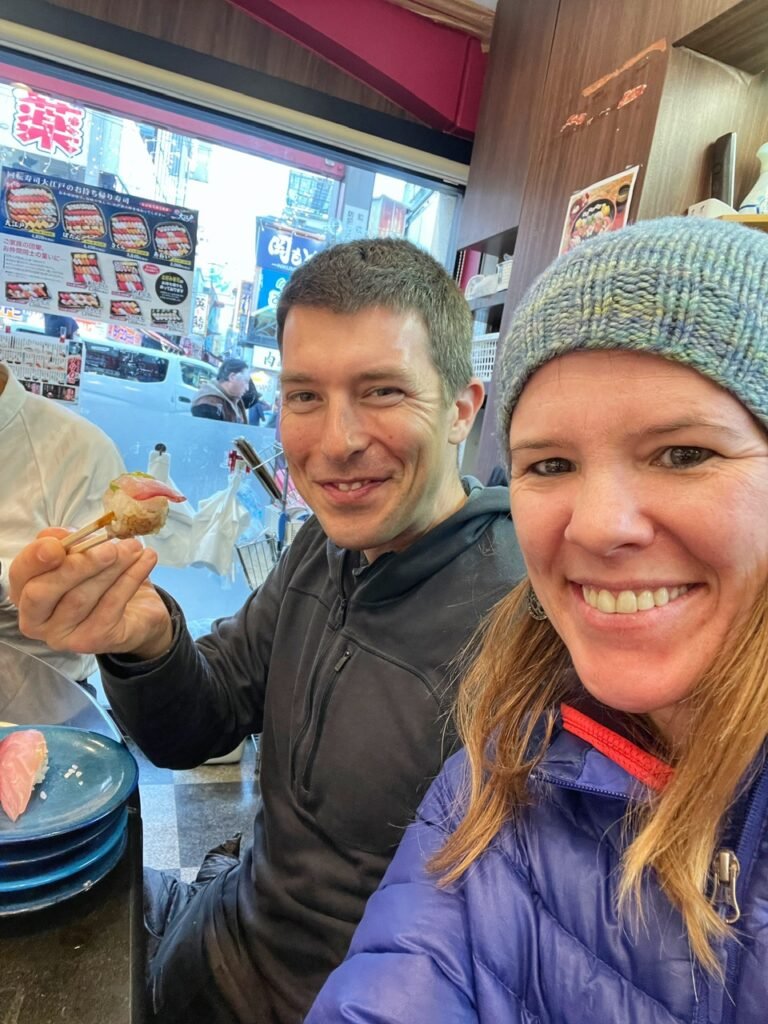
Sushi heaven! We walked out spending $12 for 7 plates and a beer. Plus, you don’t have to feel obligated to plop down an extra 25% because tipping is considered RUDE in Japan!!!

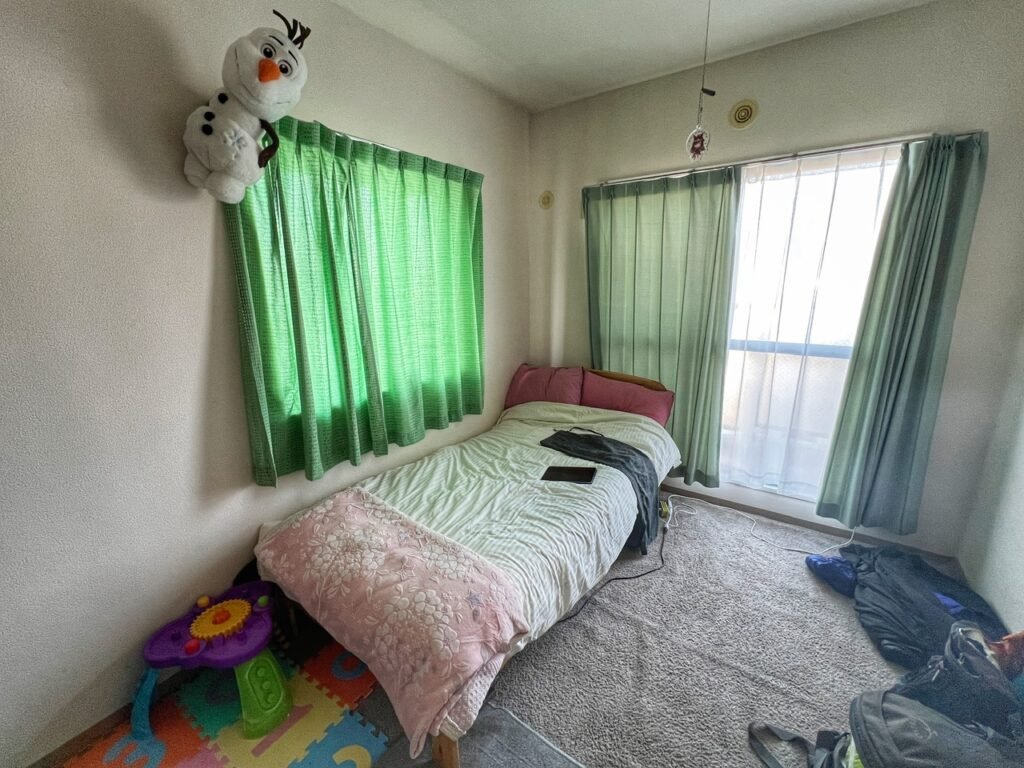
In order to get to our Couchsurf, we rode the subway more than an hour to get to the end of the line in Chuō Rinkan. There we found our sweet host family, Egyptian expats, Yara, Islam and 3 1/2 year old Lara, who have been living in Japan for six years. Islam is a translator for the Iraqi/Japanese embassy and Yara is an engineer. It was also absolutely remarkable to see Lara switching between Arabic, English and Japanese. Not only was she a polyglot, Lara was so sweet to give us her room for two nights! What a wonderful family!!
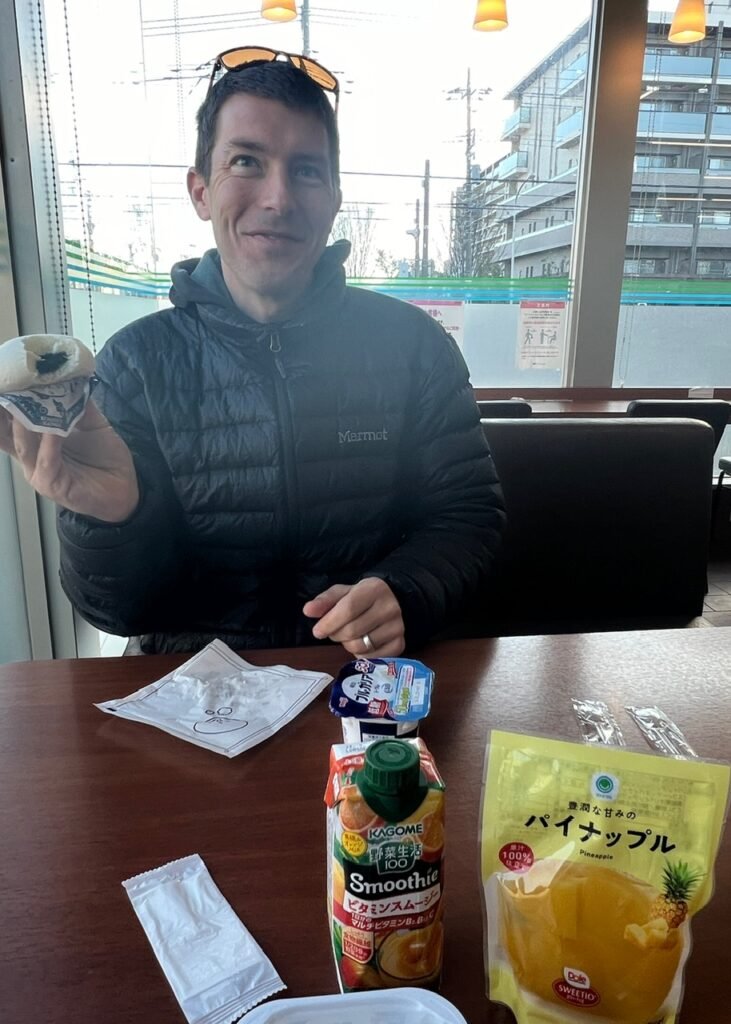
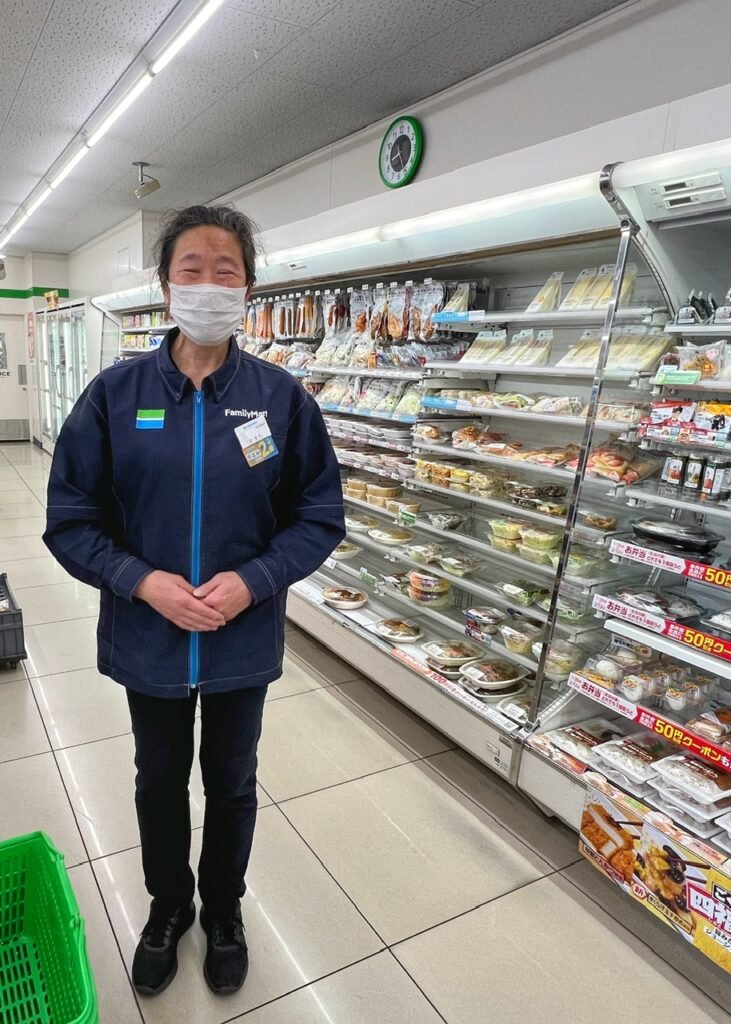
The next morning we visited the “Family Mart” convenience store for breakfast, which has regularly included yogurt, bagged pineapple and a mystery item. This time it was white, jiggly and filled with bean paste. Not as bad as it sounds. Promise. We like the Family Mart because it also includes an eating section so you don’t have to stand outside in the cold.
But the real reason we came back the following morning was basically just to visit this overly eager cashier who wouldn’t stop squealing, bowing and chattering indistinguishably when we approached her. She was absolutely thrilled when we dropped our few Japanese words and got even more ecstatic when Mandy asked to take her photo for our travel blog.
Day Three: Shibuya, Harajuku & a Mini Pig Cafe

If you’re feeling a little overwhelmed by the concrete jungle, in the middle of the vast mega city of Tokyo, one can find a stunning Shinto shrine, called Meiji Jingu, nestled amongst a welcome and expansive patch of forest complete with hiking trails and lots of opportunity for forest bathing. The shrine building was lost by fire during the last war, but was reconstructed in 1958, being supported by all loyal Japanese.
We, fortunately and unfortunately, arrived on a day that was a little more bustling than normal. February 11 is a day of special significance in Japan called National Foundation Day (Kigen Sai) and one of four major celebratory days unique to Japan. It’s the date that Emperor Jimmu, the first emperor of Japan, acceded to the throne in Yamato in 660 BC. The celebration we stumbled upon was held at Meiji Jingu, which is a shrine of national prayer for peace and prosperity. It was vibing with a unique energy from taiko drums, traditional music, parades and other pomp and circumstance.
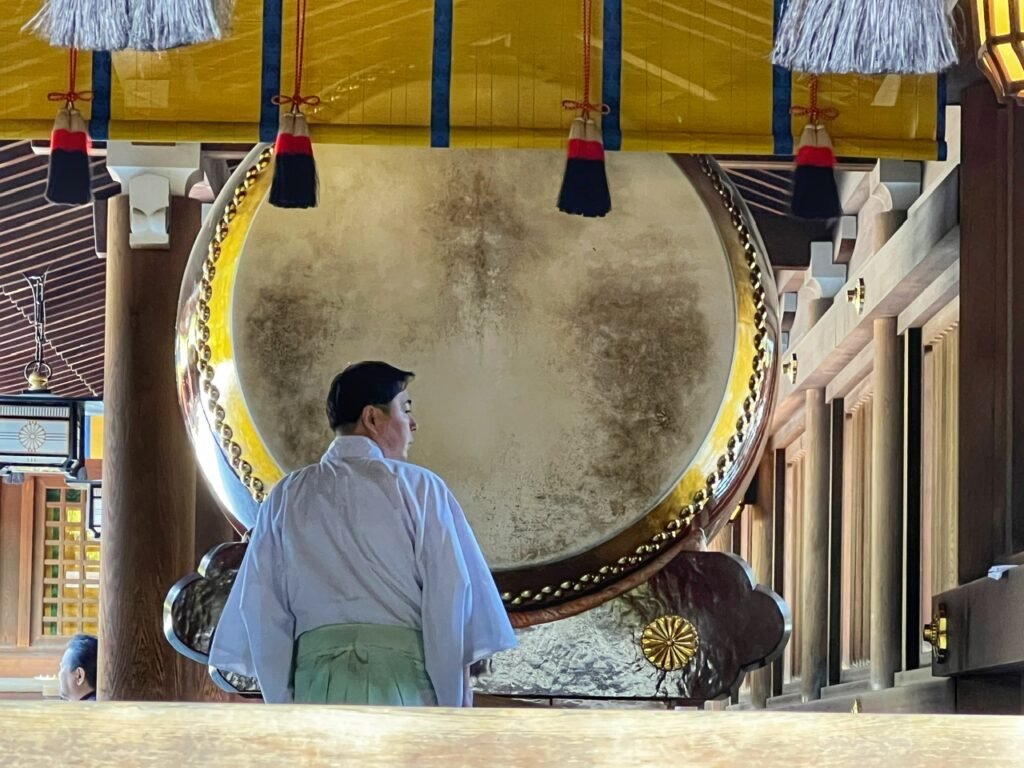
Although we didn’t know entirely (ok, at all) what was going on, we got (always politely) shooed aside with several other tourists when we stood around checking things out too long or accidentally getting in prayer lines. Oops. 😬
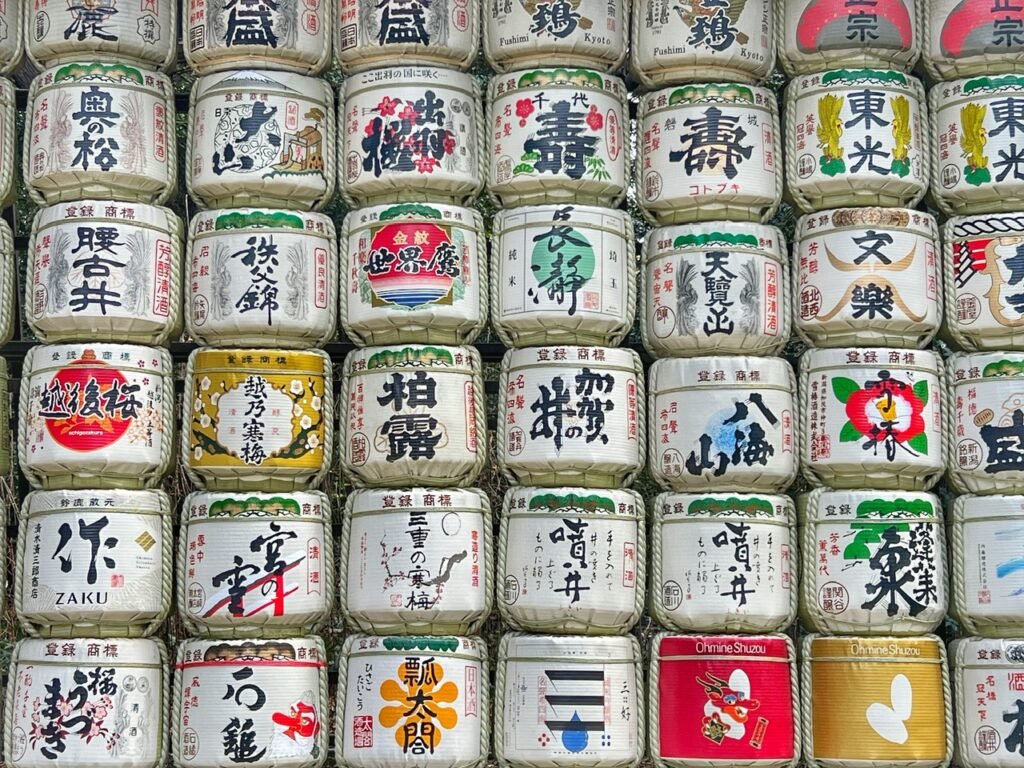
This wall of eye-catching sake barrels are offered every year to enshrined deities in the complex. Most notably to Emperor Meiji, whose divine soul is enshrined here at Meiji Jingu. He was particularly prominent because he led the industrial growth and modernization of Japan by encouraging various industries and supporting technological development.
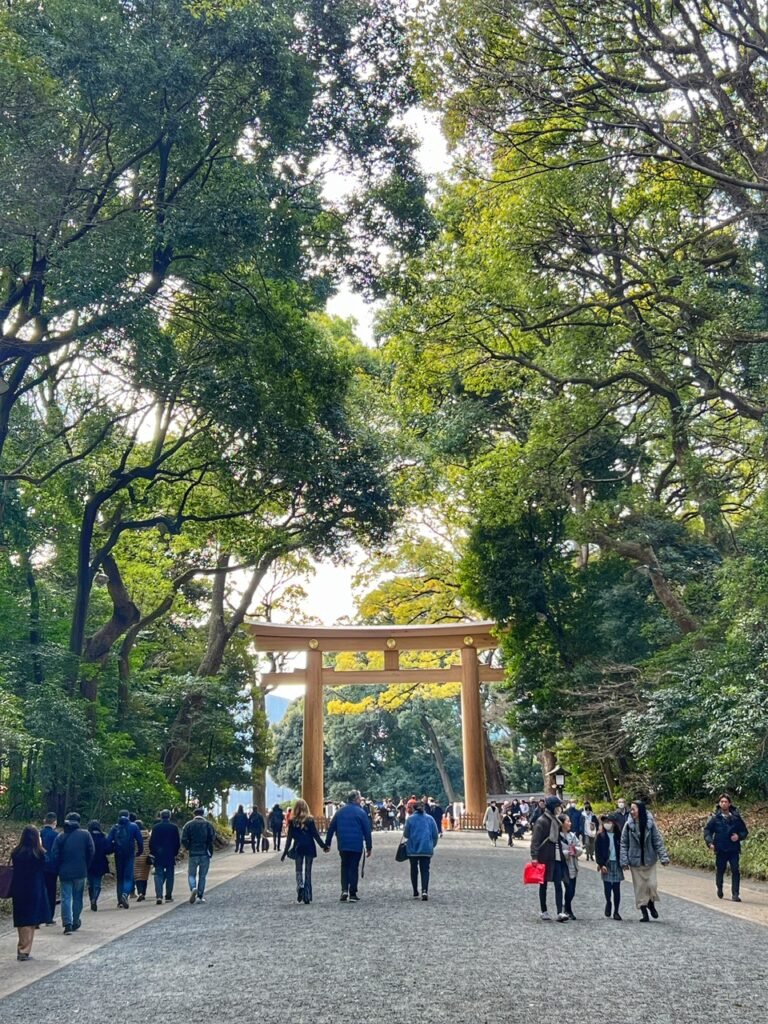
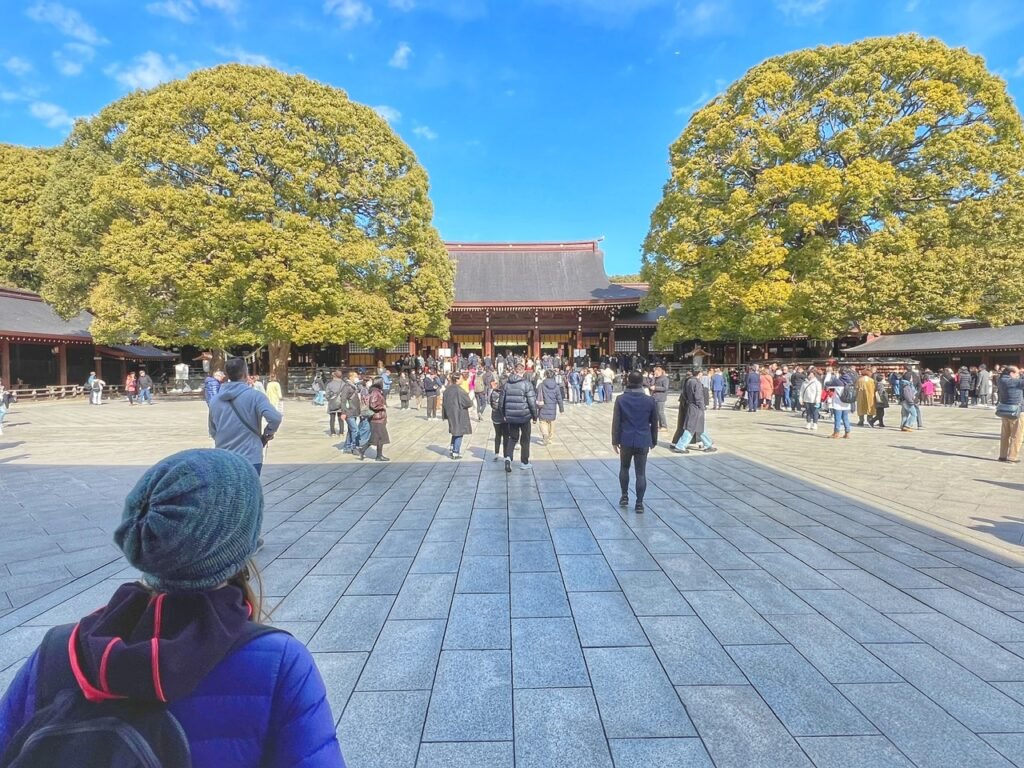
The entrance to the complex is so inviting after sitting on the subway for an hour! But, seriously, how do you prune a tree that tall to look like perfectly symmetrical jellyfish?
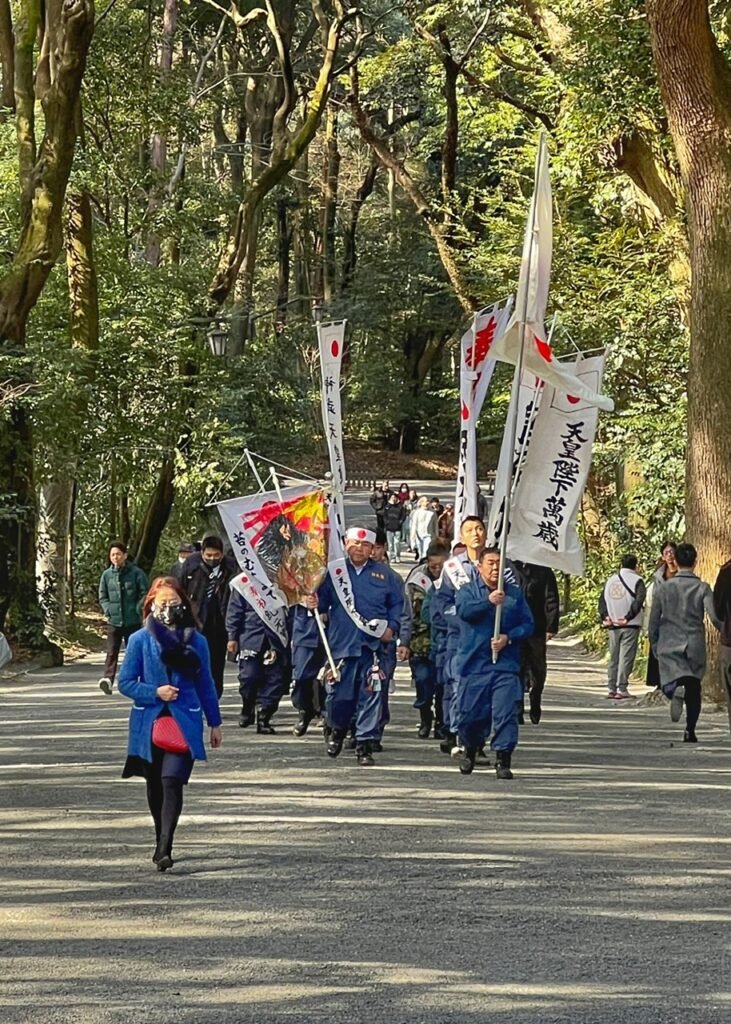
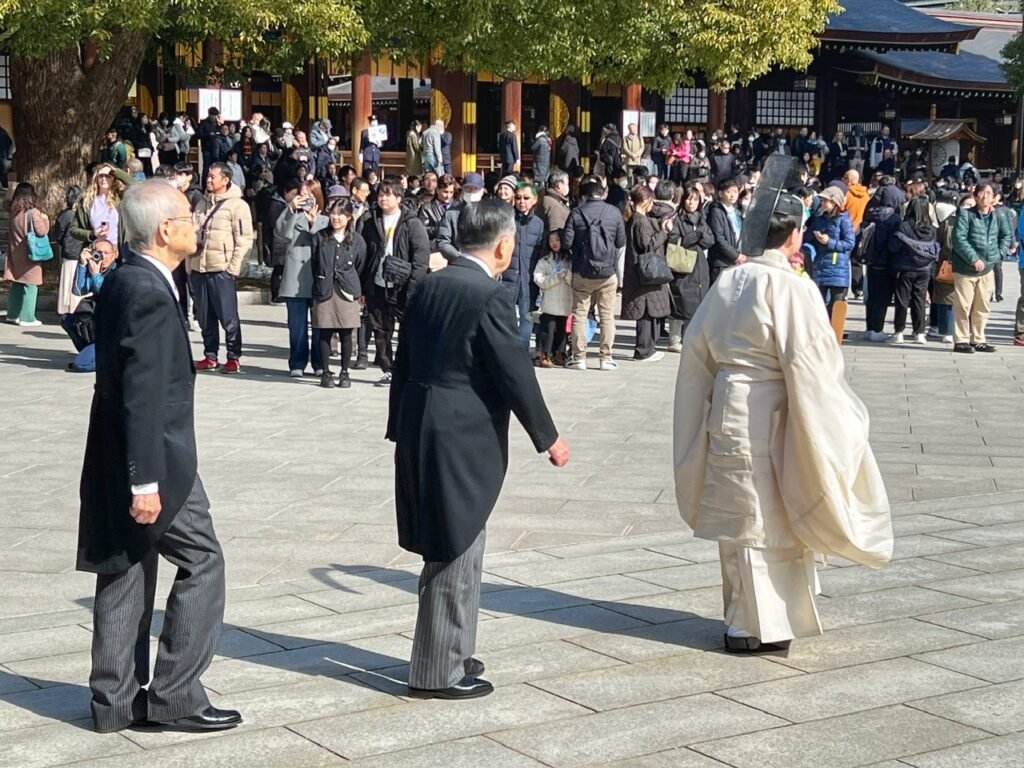
Some important looking people emerge from the forest, to be followed by a procession of some VIPs in front of the shrine.
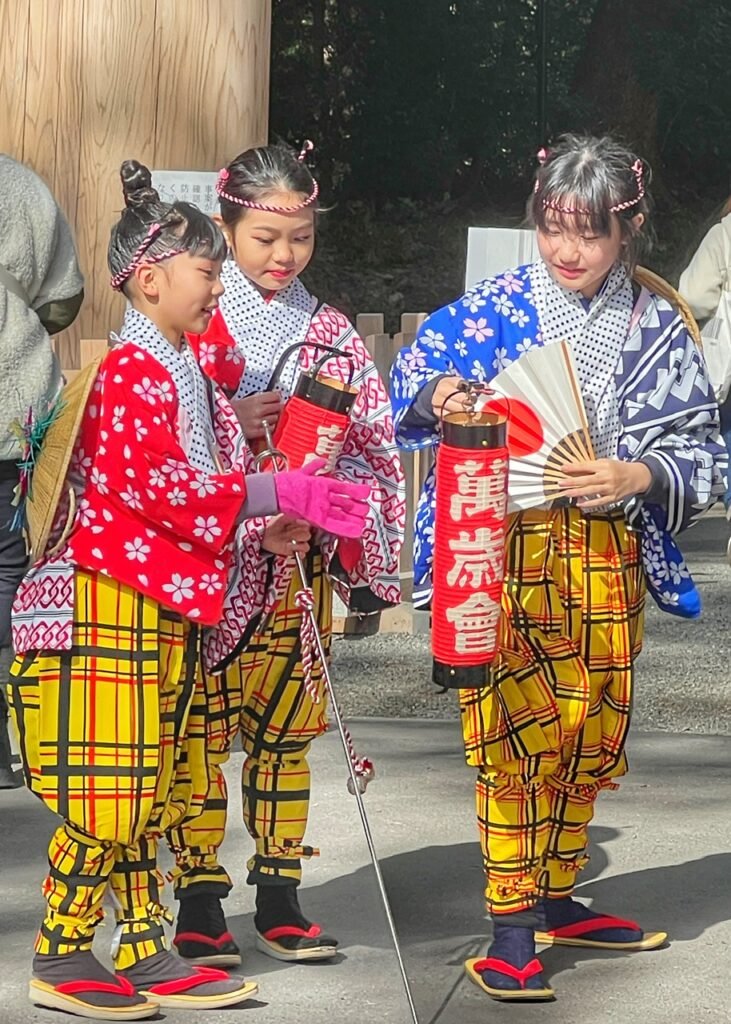
Young ladies looking very festive
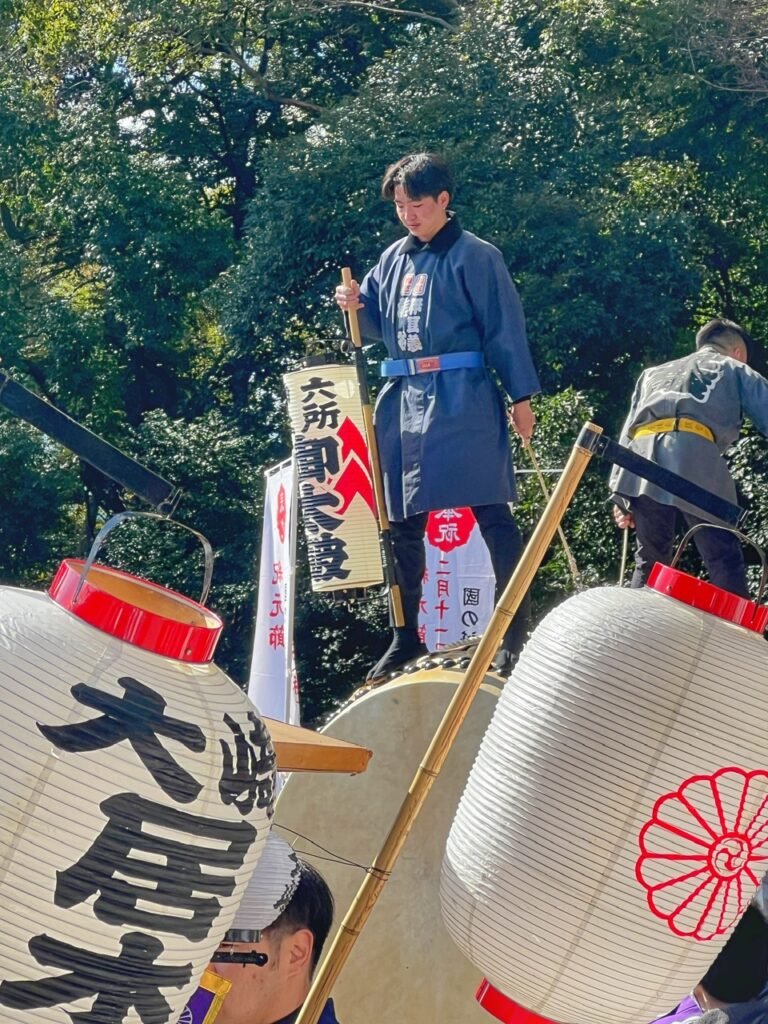
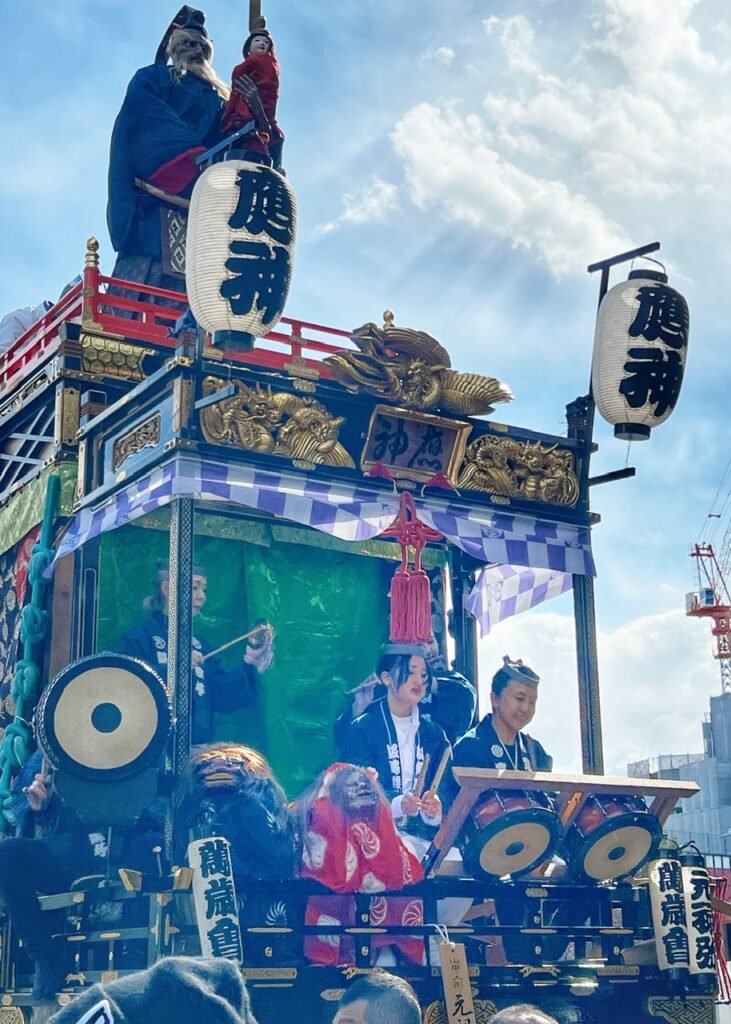
This guy was standing on a gigantic drum. Another guy was pounding it from below. Not really sure how he didn’t fall off from the vibrations alone. The beating sound could be heard from nearly a half a kilometer away.
We also got to experience our first in-person Japanese taiko drumming, known as “the heartbeat of Japan” at the celebration which was up on an elevated parade float platform. Taiko has been a part of the Japanese culture for centuries. Centuries ago, taiko was used predominantly in the military arena but today it’s simply tradition. We adored watching the animated expressions on these girls’ faces and the accompanying gyrating puppets, which we believe are called Bunraku. The energy was palpable!! So glad we stumbled upon this event!
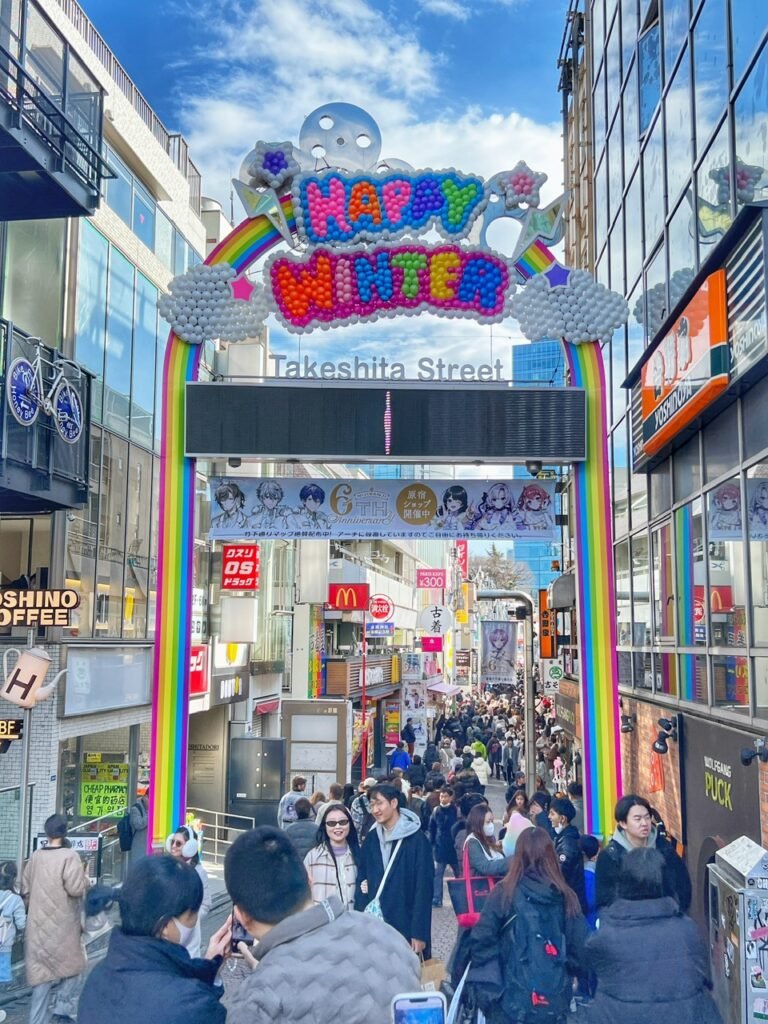
After a lively Sunday morning at Meiji Temple, we were off to search for Tokyo weird and some more free activities in the Harajuku neighborhood. Sunday, it turns out, is a perfect day for this because it’s the day that all the teeny and tweeny boppers parade Takeshita Street in their most trendy threads and wildly unsuitable footwear, which they’ll pay for in 30 years. So, if you’re willing to do a little crowd surfing, the people watching is superb. We also visited some very eclectic and entertaining shops, sampled some must-have non-Japanese cuisine, did not receive sexual services from a man-sized rabbit, checked out some street art and felt briefly nostalgic for the city we recently left behind.
The entrance to pedestrian-only Takeshita Street takes you down an avenue personified by all things “cute,” which is probably why the Japanese teens flock here in their most fashionable get-ups. It is known for wacky, youth-driven shops selling colorful and crazy clothes and accessories, as well as an immense selection of fluffy and sugary crepes.
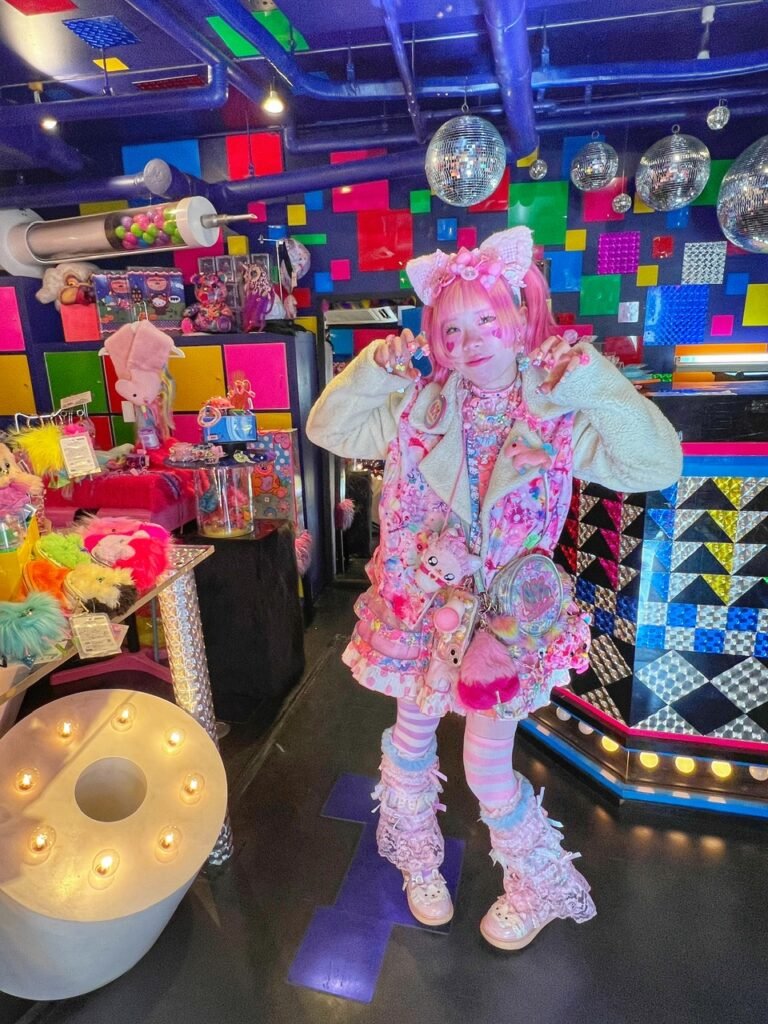
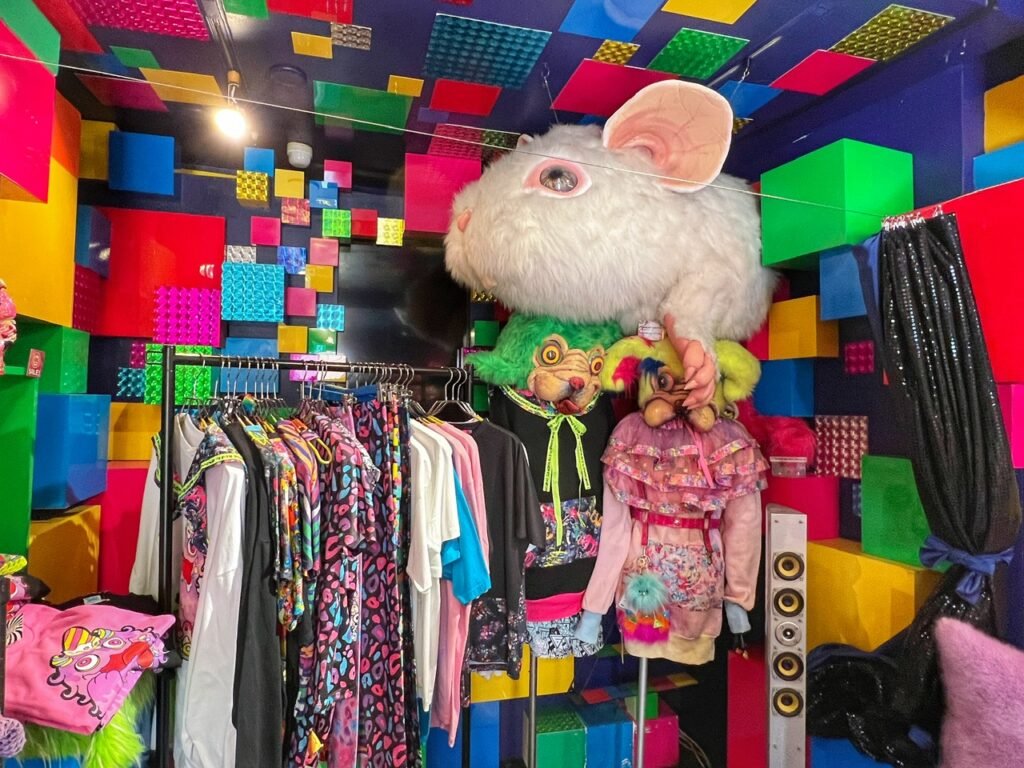
Although you’ll find lots of “cute cute” on Takeshita, at 6% Doki Doki, you can find the extreme version of kawaii, which is the Japanese pop culture term for “appealing in an endearing way.” The flamboyancy certainly gave us a surprising jolt when we climbed the stairs into this rainbow-coated wonderland where everything is staring at you that looks like the 1980s tossed its cookies. We were then greeted by this salesgirl who looked like a living doll from the same era with a touch of Weird Barbie sprinkled in. Any six-year-old would undoubtedly be enamored. 🤩 Can you imagine how long it takes her to get ready?! By the way “Doki Doki” is an expression often used in anime, but it means a heart which is beating fast.
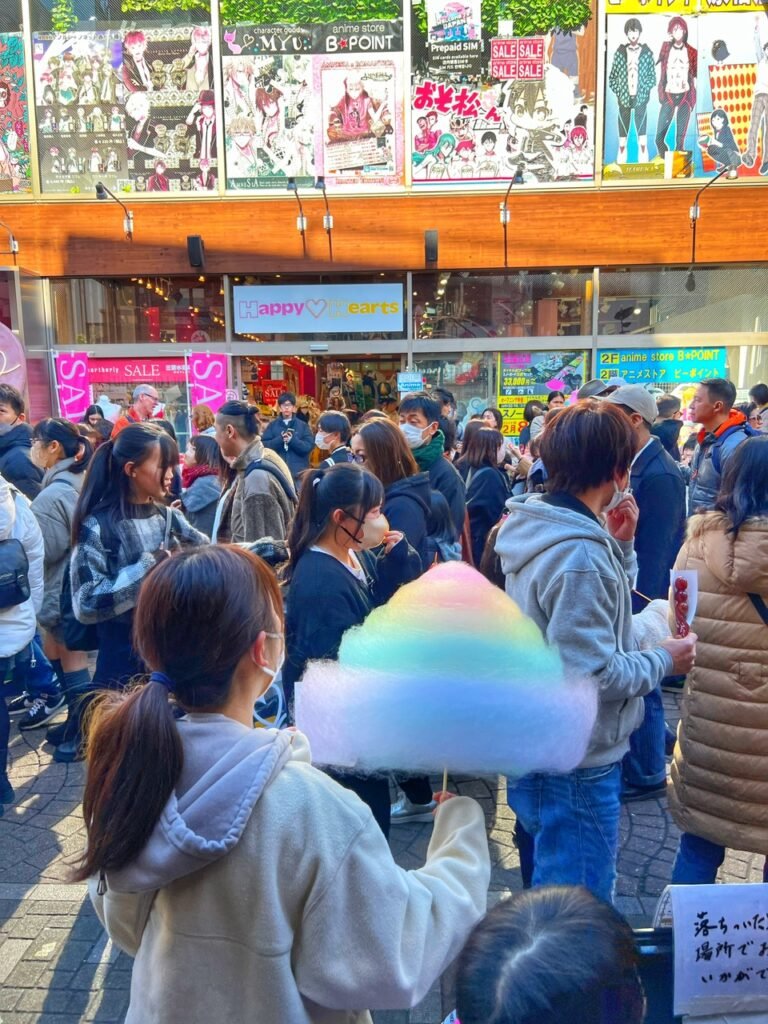
The color doesn’t stop back on Takeshita Street, including this dazzling dome of cotton candy.


As per normal in Japan, the crepe shops have rows and rows of life-like plastic versions to entice you with their broad selection while standing in line. The majority are sweet but a few savory ones are mixed in as well. We settled on the banana, cream and custard concoction for about $4, which Mandy anteater to excavate the final morsels from.
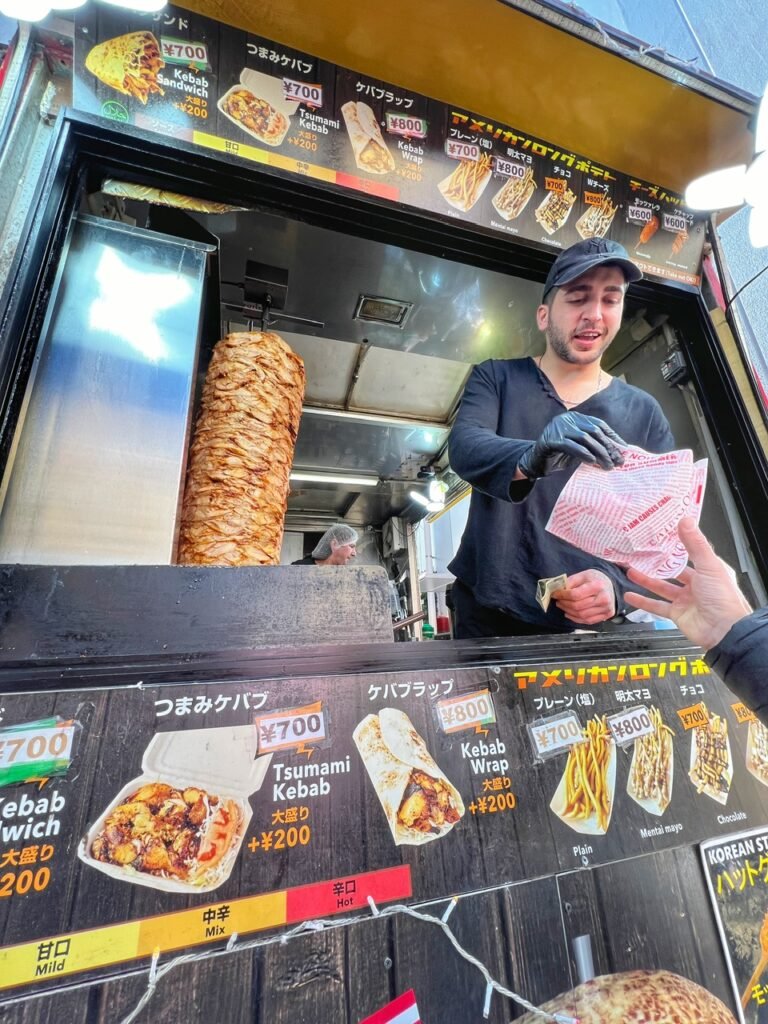
After the crepe, we needed something more substantial so we met a Japanese Turk who sold us a chicken gyro for about $4.60.
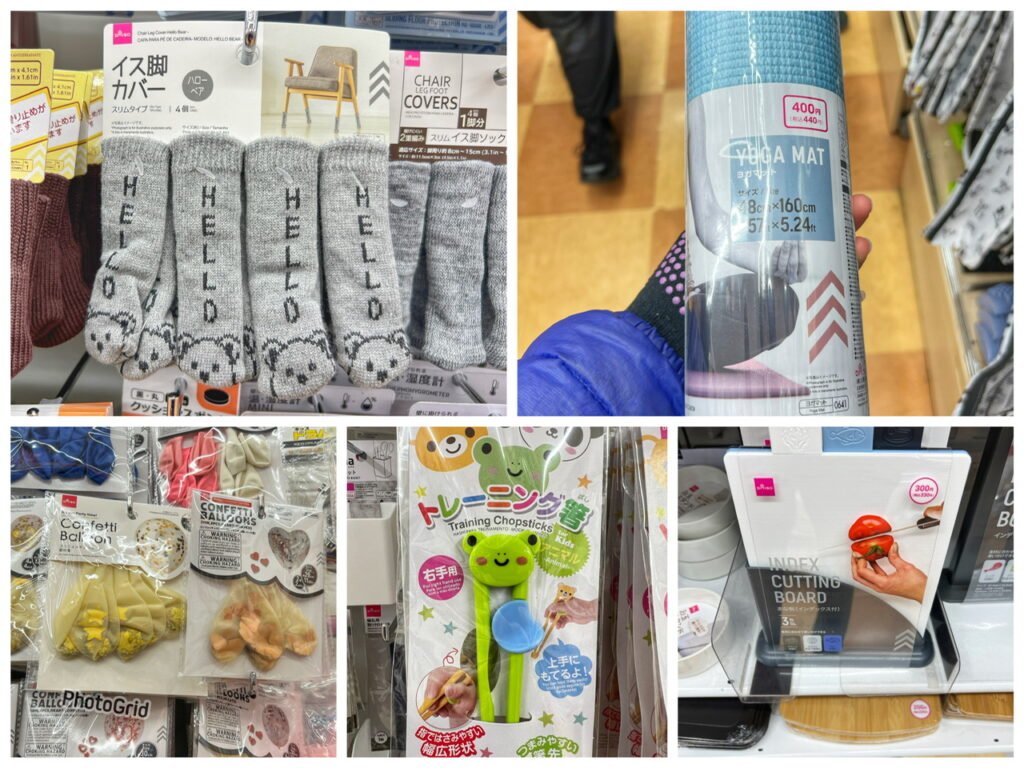
With full bellies, we turned our attention to more shopping, or rather wandering in shops and whispering to each other, “Look at this!!” When in Tokyo, make sure you stop in Daiso which is their version of a much more fascinating dollar store. As we hope you are seeing, Japan doesn’t have to be expensive!!! Goodies we enjoyed:
- Socks that say “hello” for your chair or travel legs
- A yoga mat for 400 yen, or about $2.60, certainly the cheapest we’ve ever seen
- Balloons with confetti already inside. Mandy, as a former event planner, couldn’t believe this dream as she thought about the times when she hand-filled balloons with confetti.
- Training chopsticks for kids, or tourists that keep asking for a fork (fortunately not us🤣)
- Index Cutting boards labeled with what you’re supposed to cut on them for $2.
- Fortunately, we walked out with sensible purchases which included a new storage bag for our spices, and 3 contact cases for Mandy. ($1.75 total).
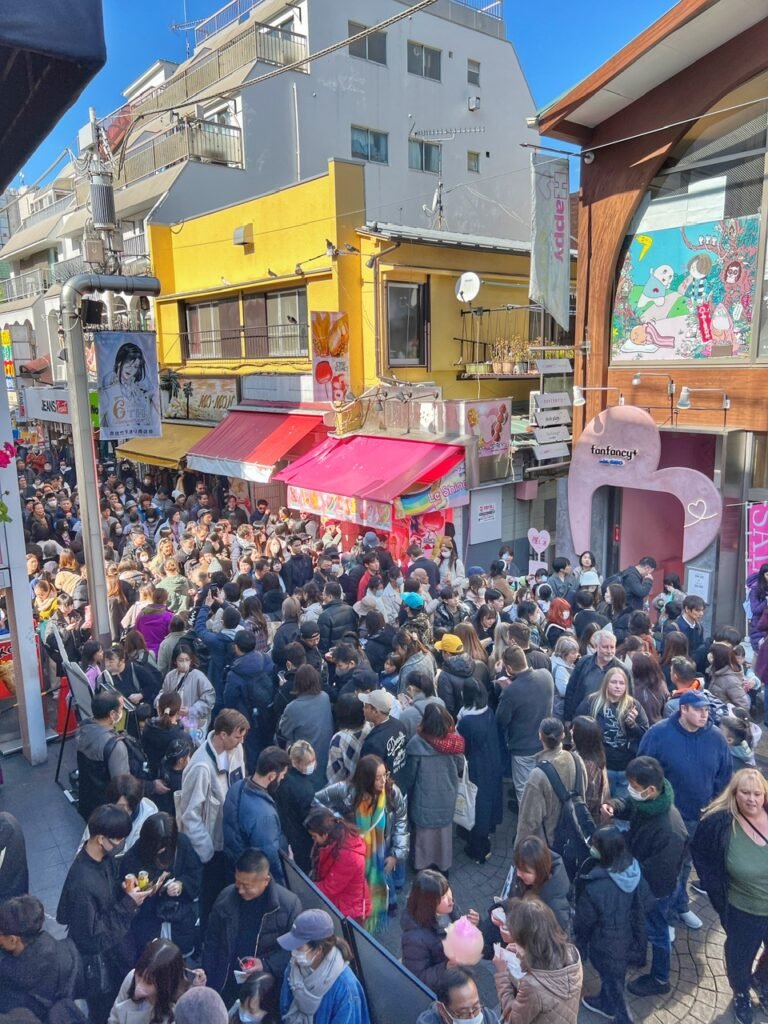
The crowds at Takeshita Street were pretty crazy by mid-day on Sunday!
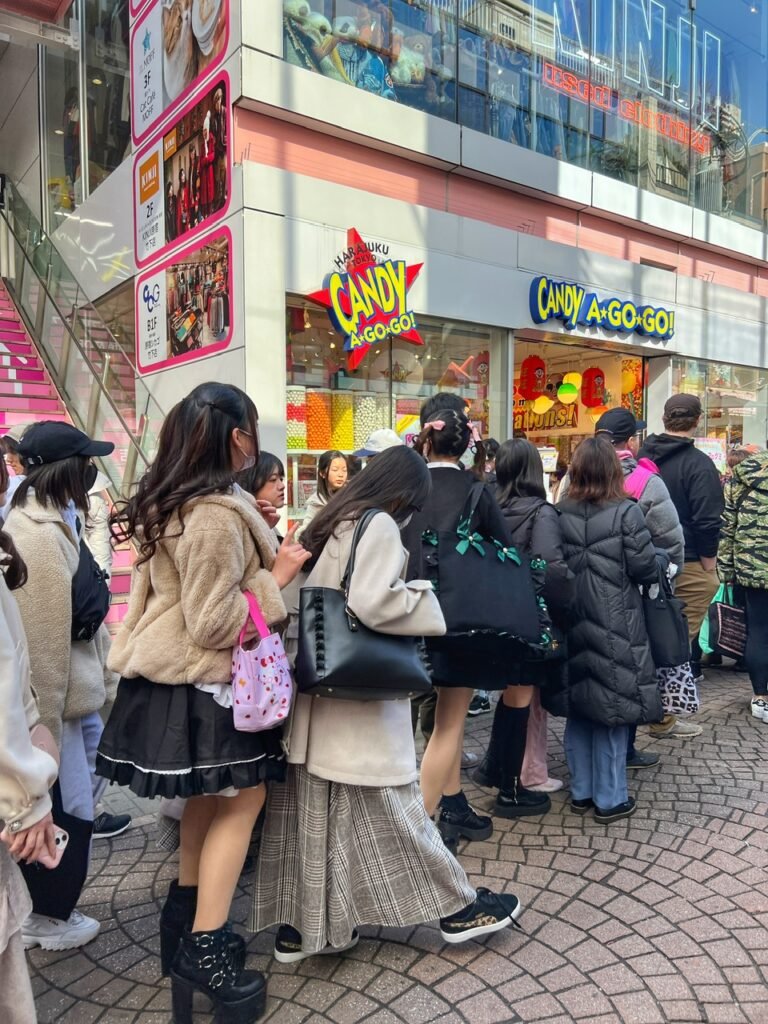
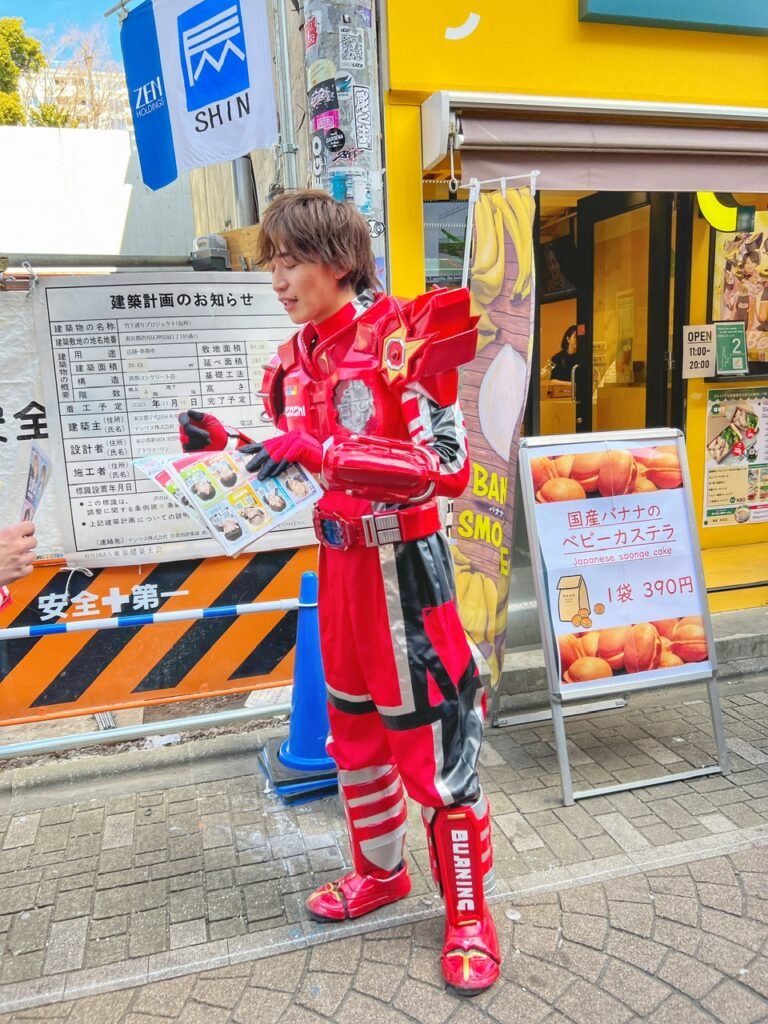
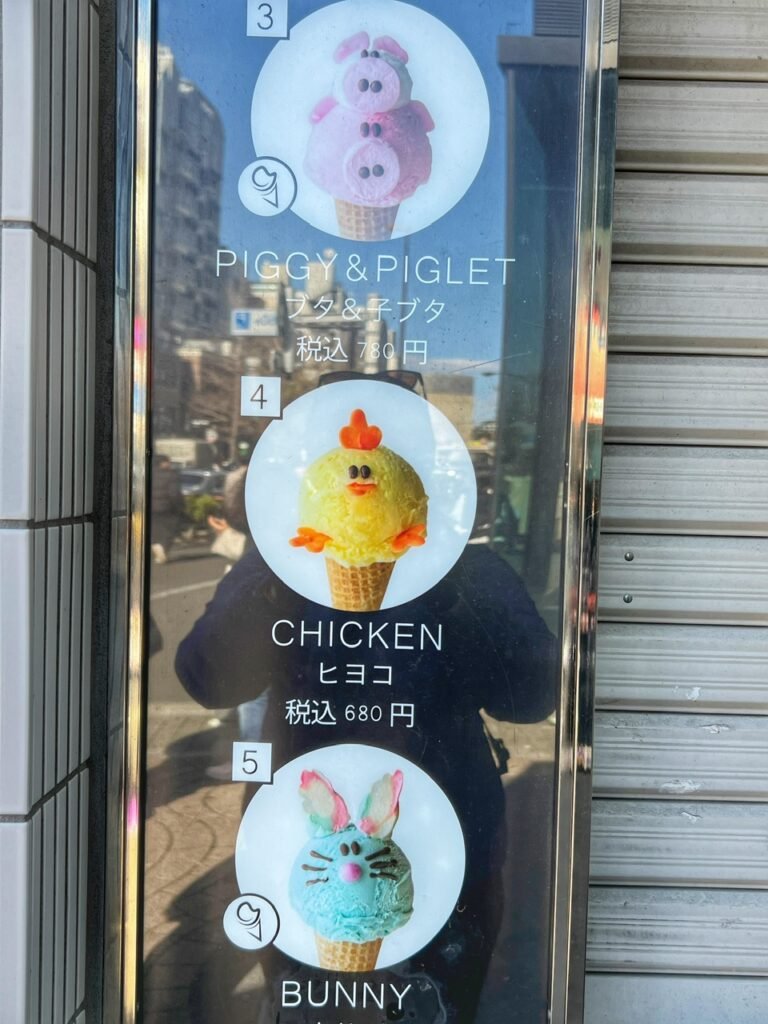
Everyone wanted to check out the short skirts and practical footwear, the cute boys that need no transforming, and the non-vegetarian version of ice cream.
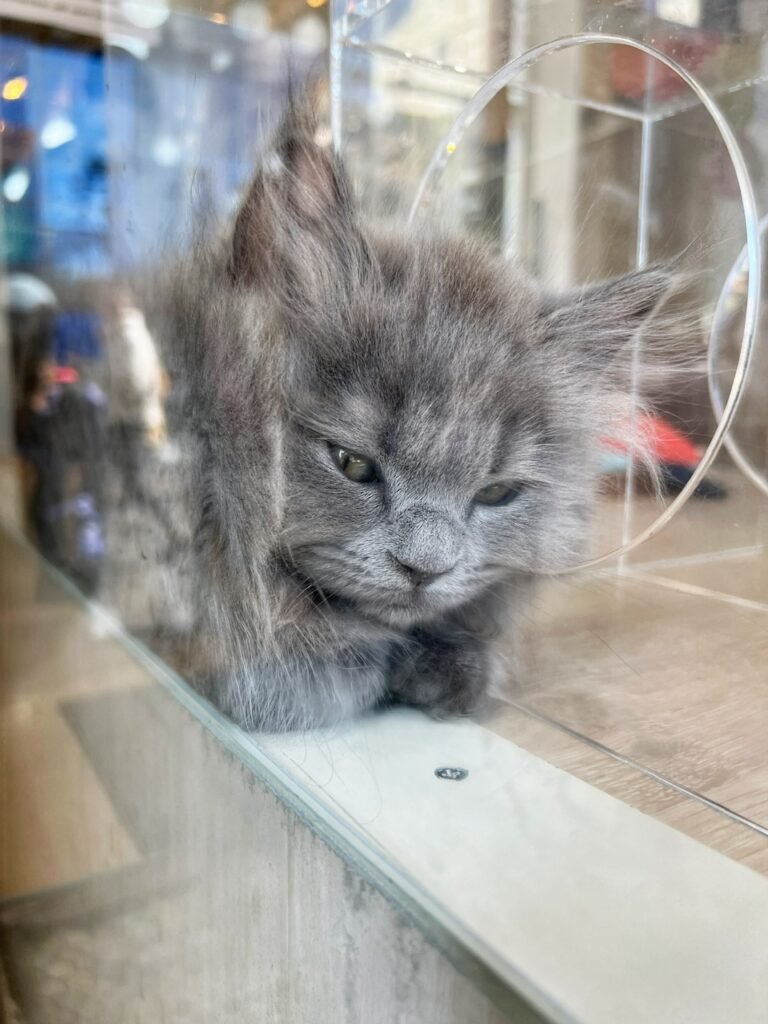
Oh, and the absolutely irresistible kittens in the pet store windows. We found it absolutely endearing (ok hilarious) to listen to the young Japanese girls fawn over the animals. To us, they sound like, “oiiii….bing bong bing bong bing!!” 🤣
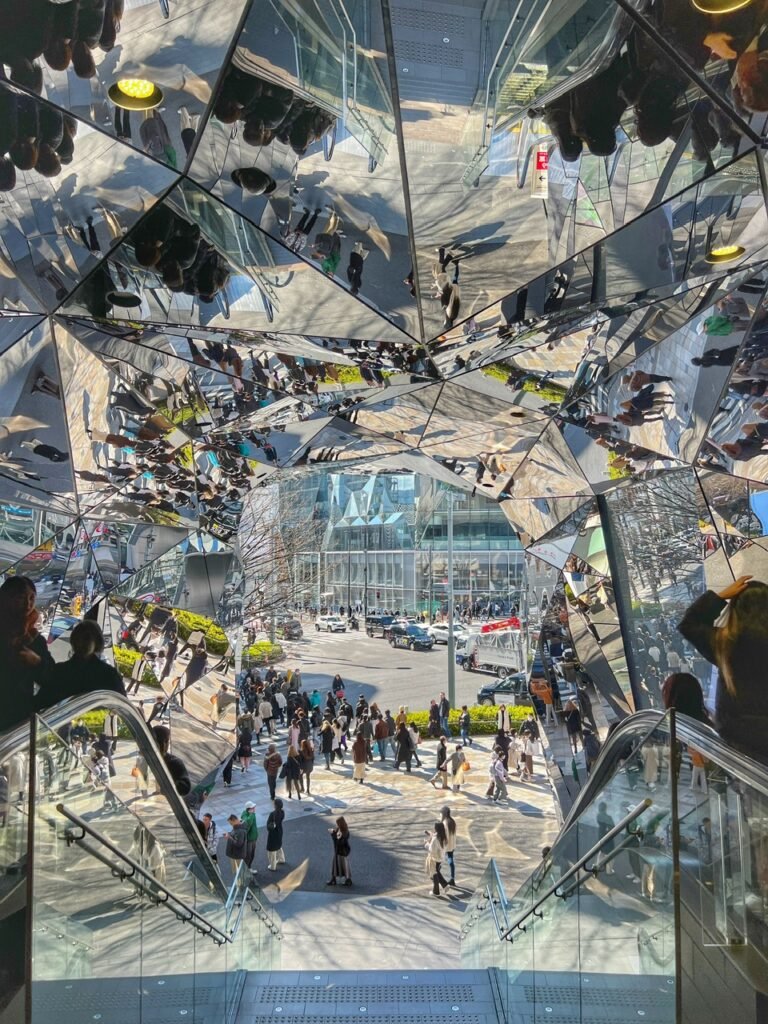
If you wanna feel like you’re inside a kaleidoscope, make sure to take a ride on the escalators at Tokyo Plaza near 6% Doki Doki.
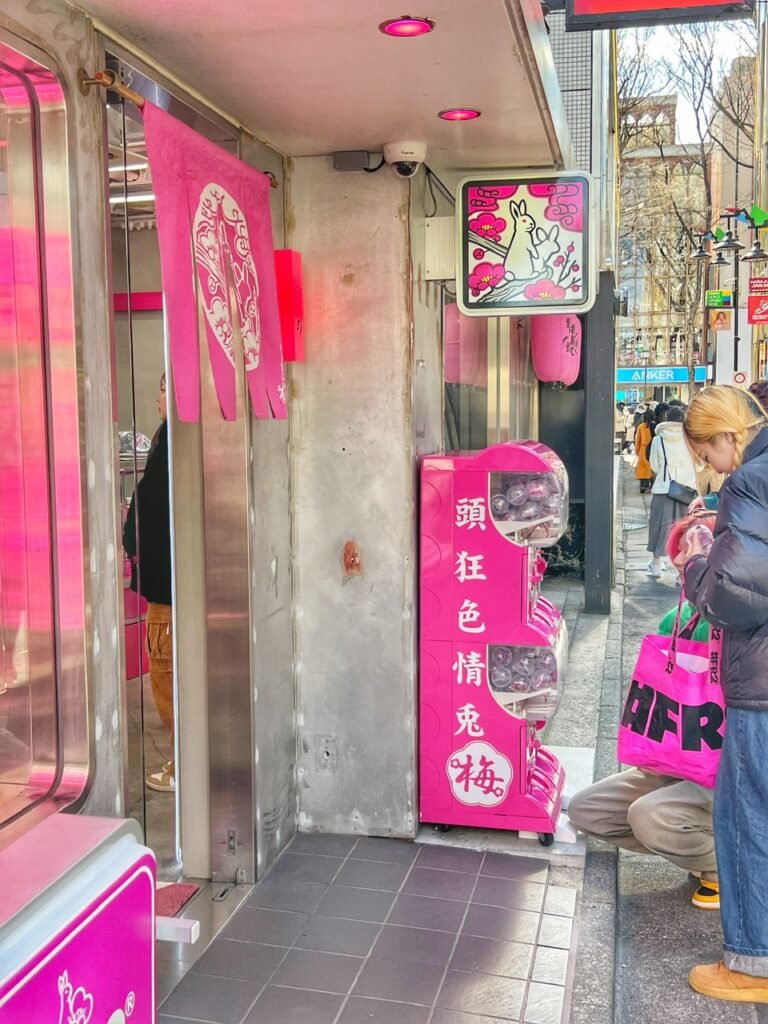
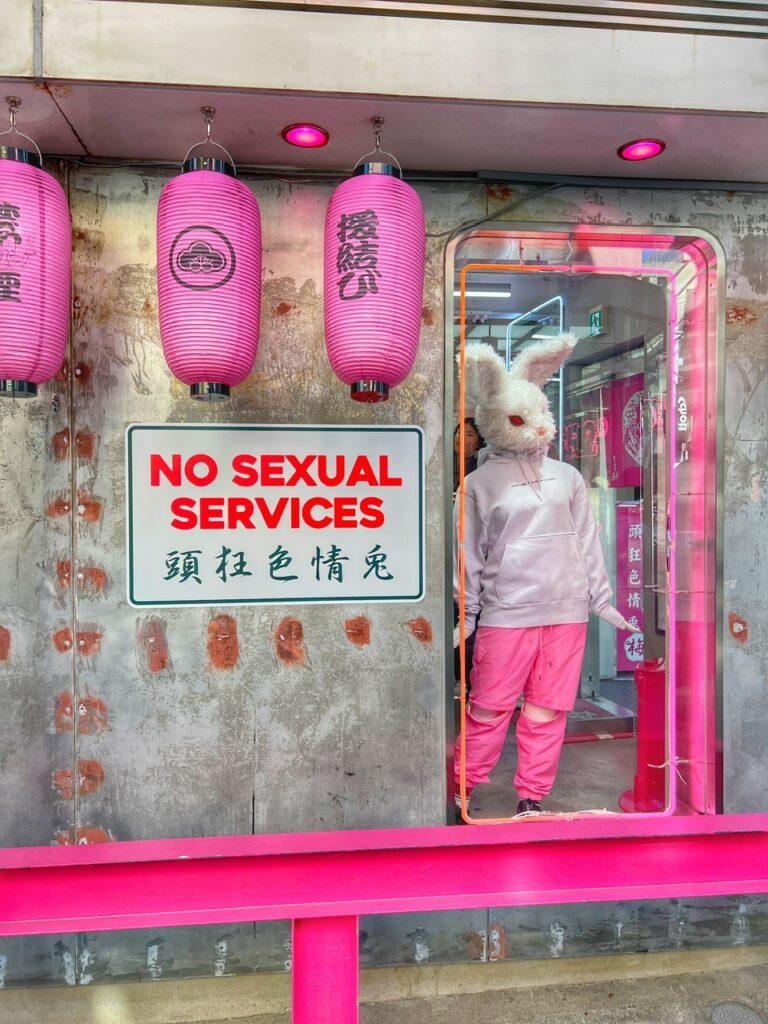
After the escalators, we rounded a corner to find a hot pink shop with bunnies humping on its sign. Fortunately, the accompanying window display clarified the question we were beginning to wonder.
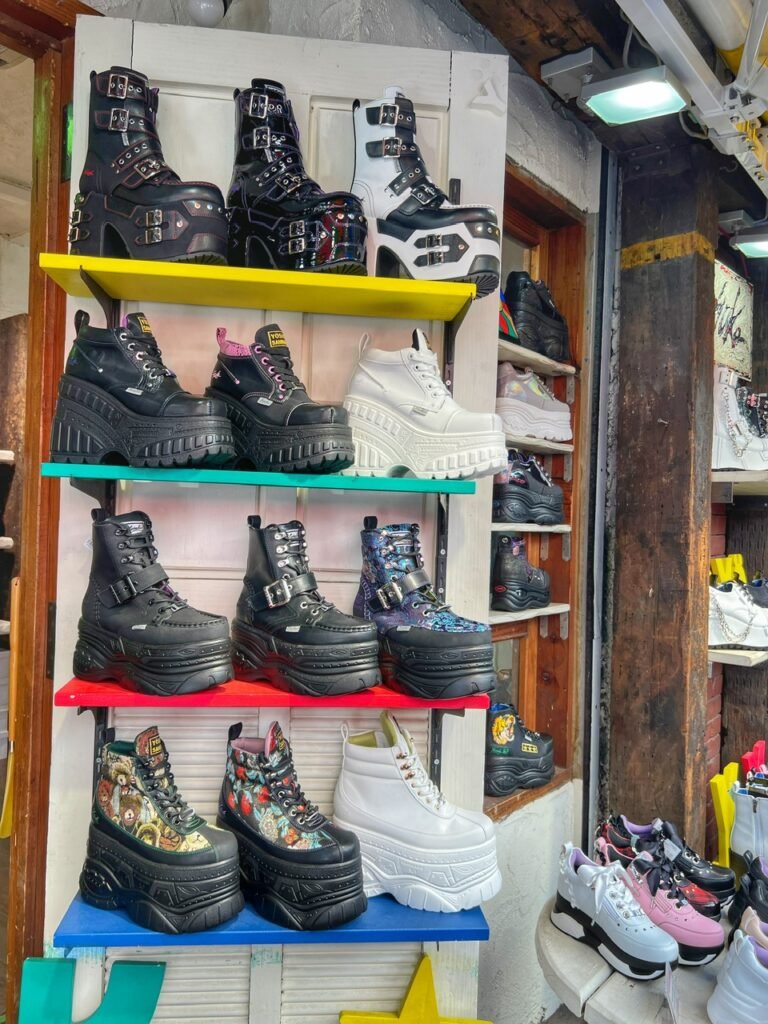

Do you think they’ll fit in our backpacks? And other recommendations in…how to dress like an anime character.
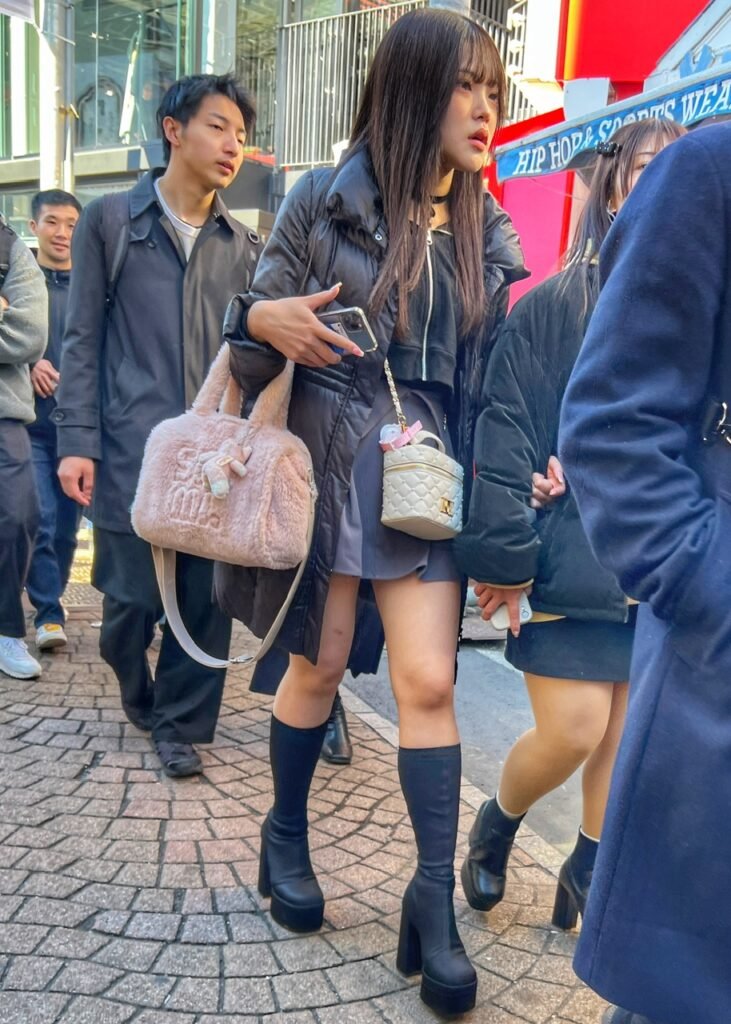

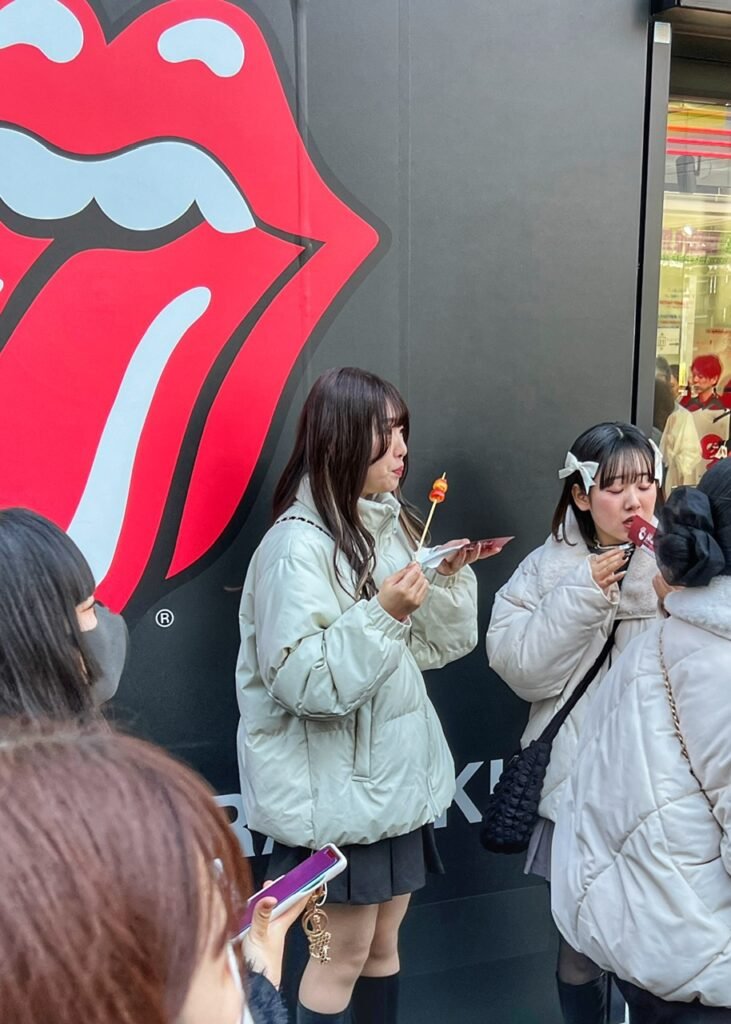
It’s really too bad it’s winter, because other than this classy young gal, I don’t think we absorbed the full shebang of the outfits with all these pesky coats.

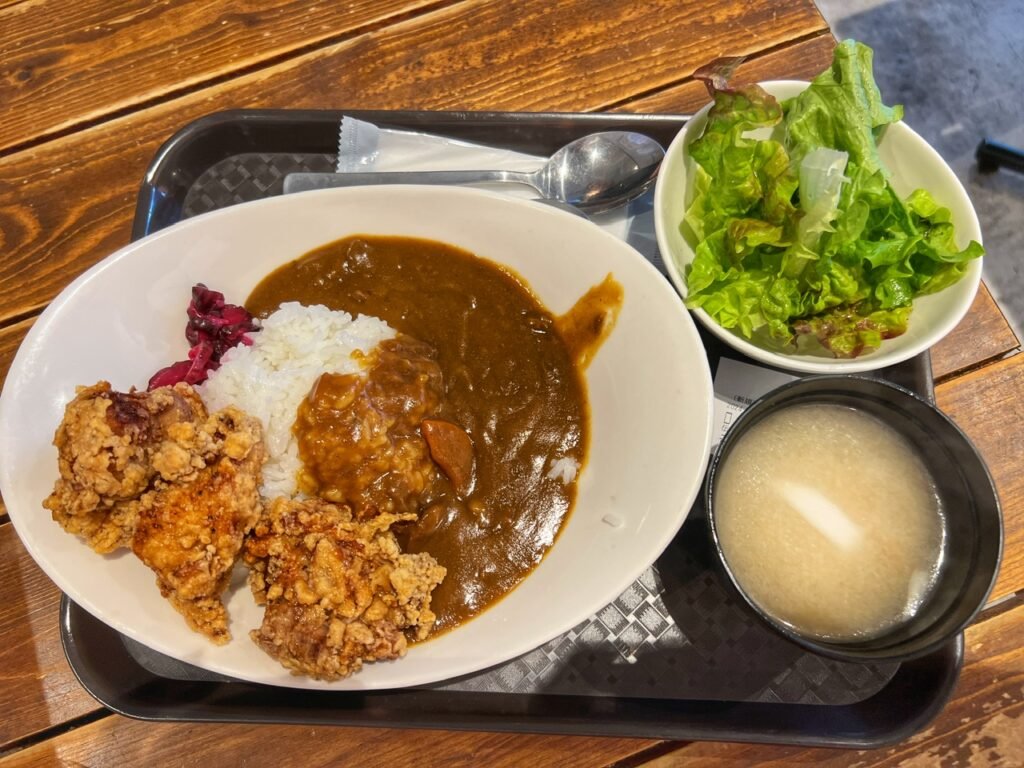
We took a break to go engage with some piglets (see below) before moving on to linner, at Sunhouse, also known as the first restaurant we had entered that bizarrely allowed…what’s that smell….smoking?! This is in the same city that has smoking pods in outside parks that sucks smoke out of the fresh air, and telephone booth-style social isolation tanks for those who choose to smoke. Anyhow, the contrasts are peculiar.
Anyhow, we were starving so we ordered our first Japanese Curry, which was made with fried chicken. If you’ve never had Japanese curry, it’s amazing and tastes like American gravy mixed with curry. The cost of the dish was $5.80. Again, no tip because that would be rude! Who says Tokyo is expensive?!

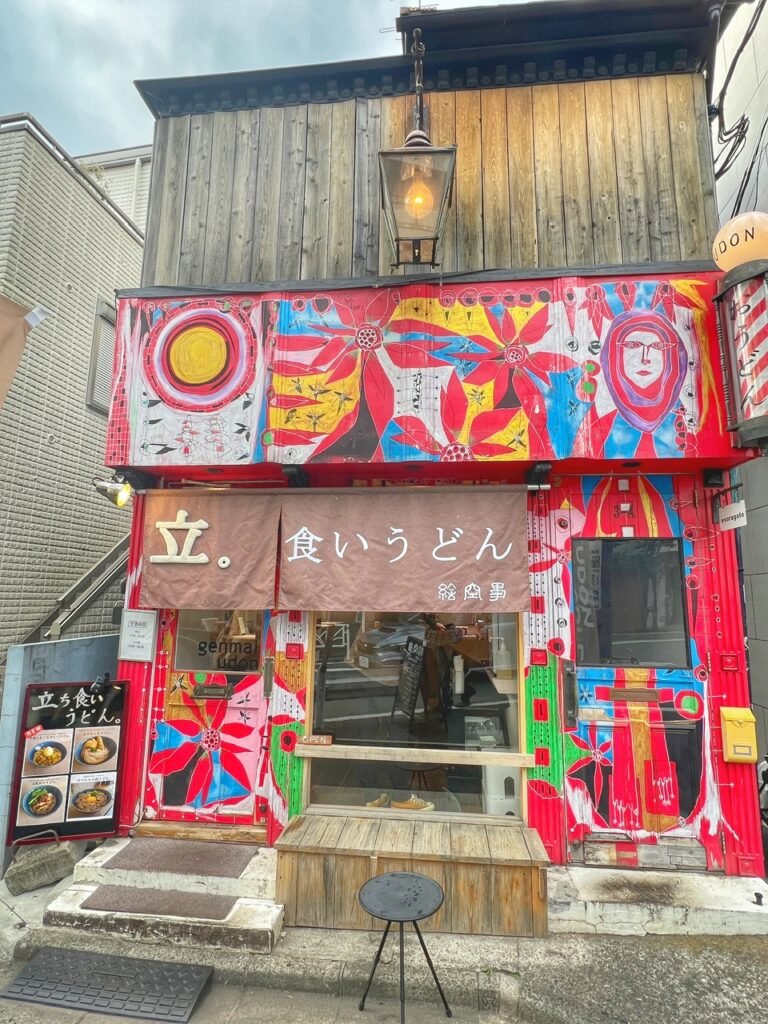
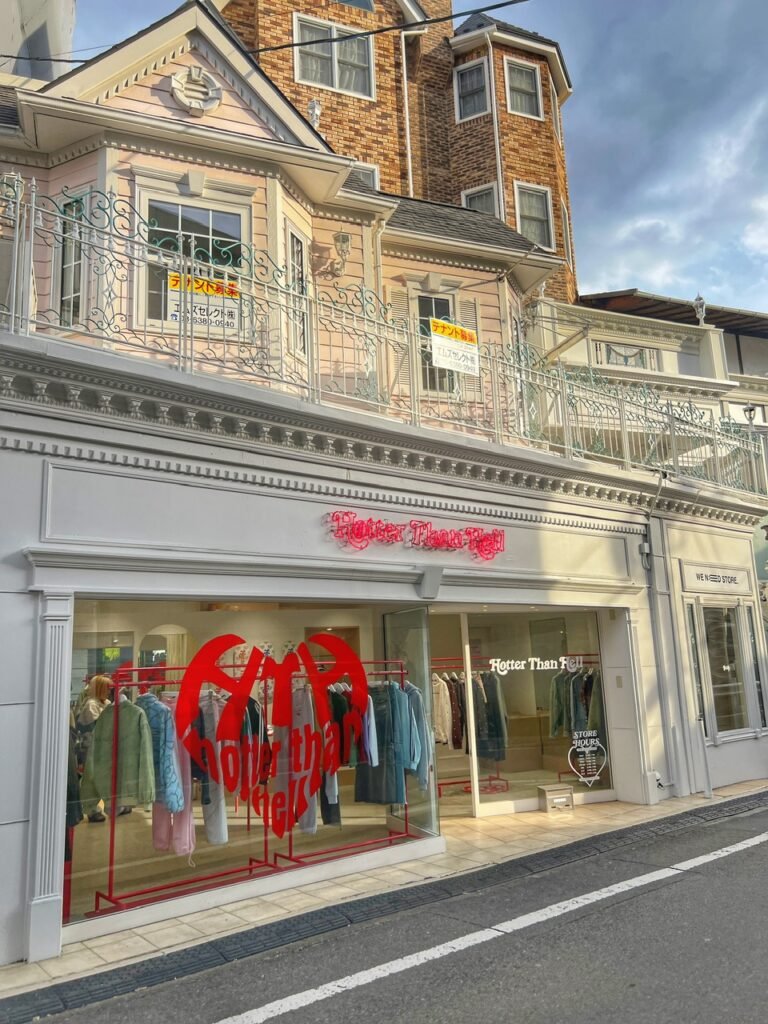
Wandering through an official entrance to the Harajuku neighborhood, an onto the famous 1/2 mile runway called “Cat Street.” We thought it might be called this because of mischievous street cats or funny cat paraphernalia, but turns out it was named in honor of cat walks, where models sashay up and down in their best threads looking into the very elegant shops, like Chanel, that align there. We saw no one that even remotely resembled a model…
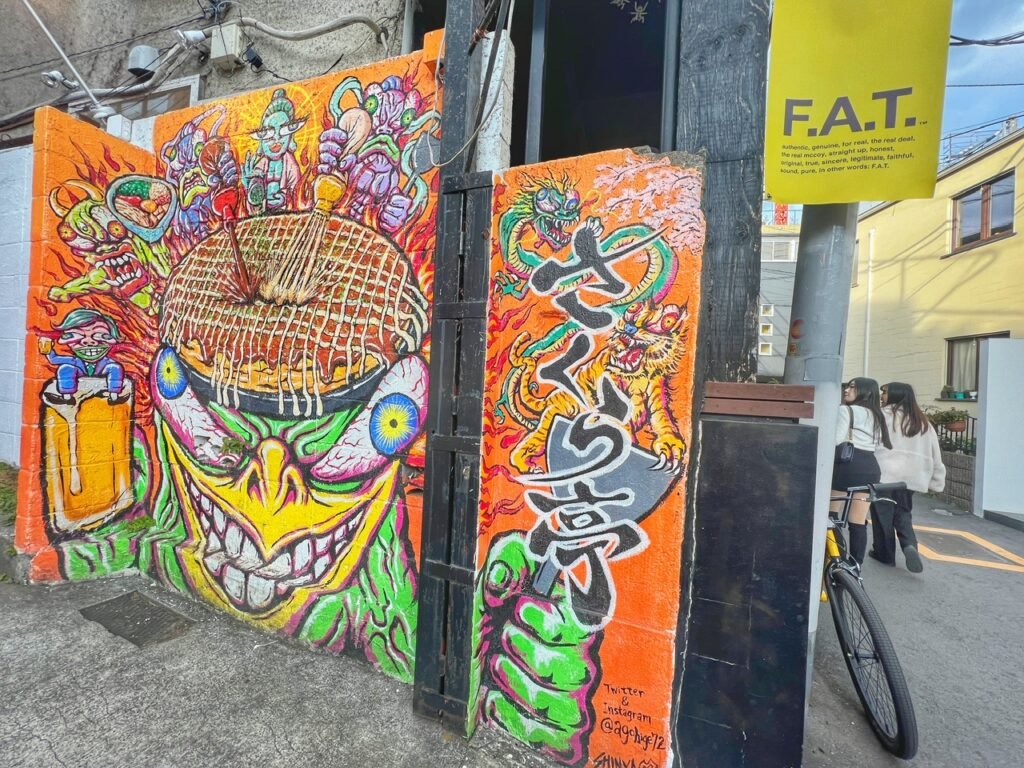

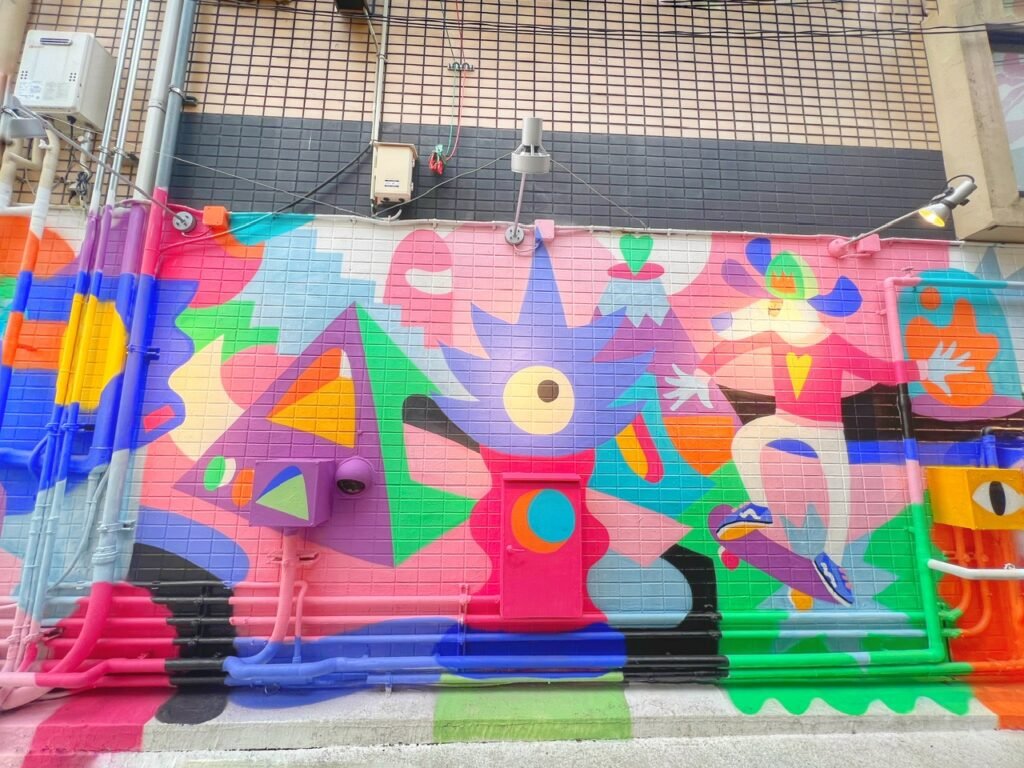
…but we did see some animated street art, the smoking telephone booths…
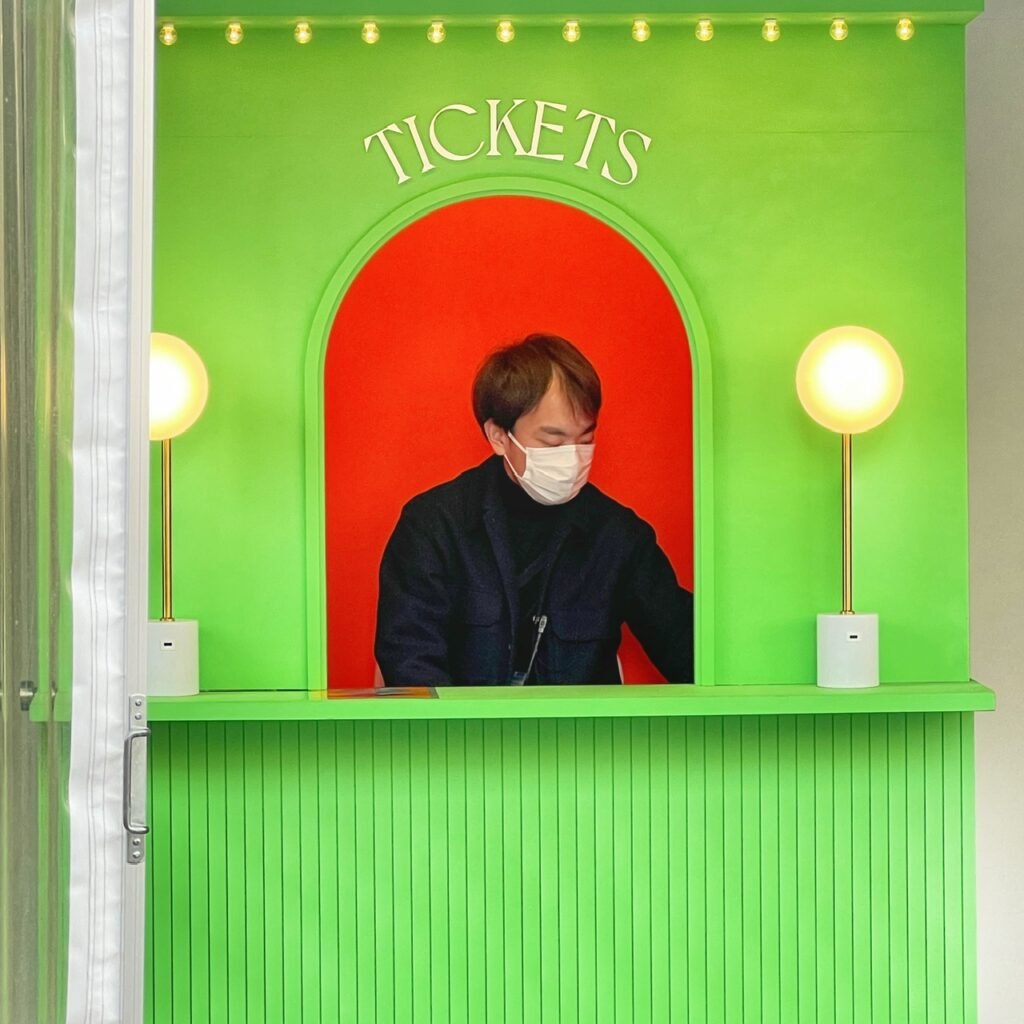
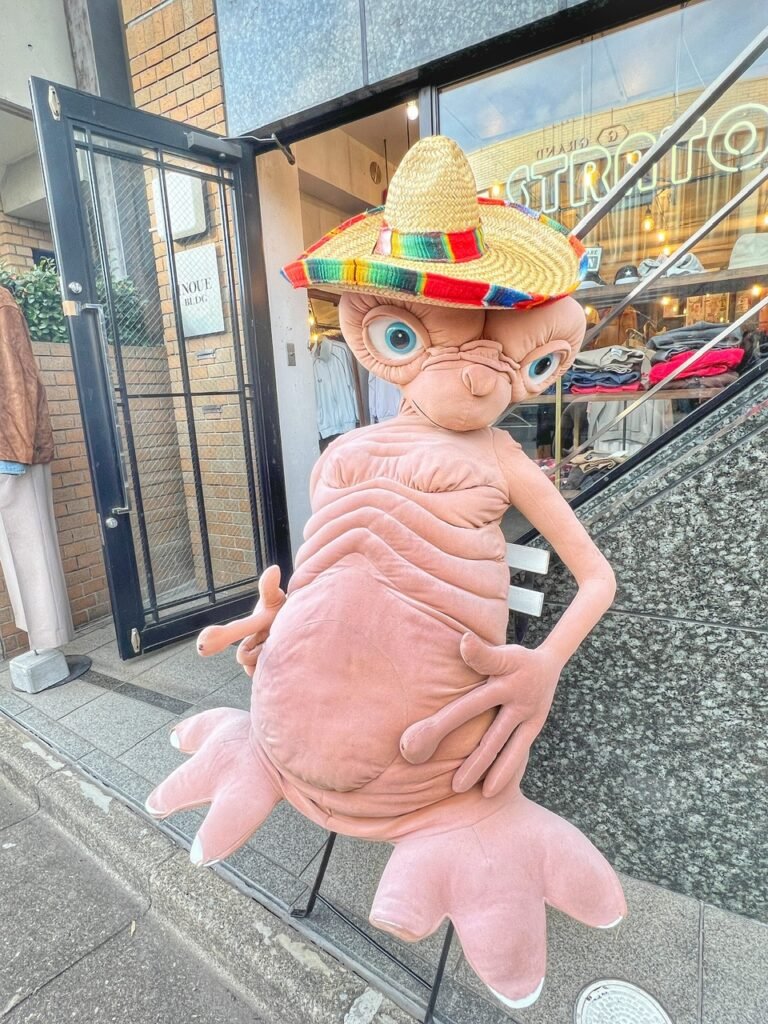
And…also saw a man in a ticket window which clearly looked fake, near an illegal alien in a sombrero (better call the feds)…
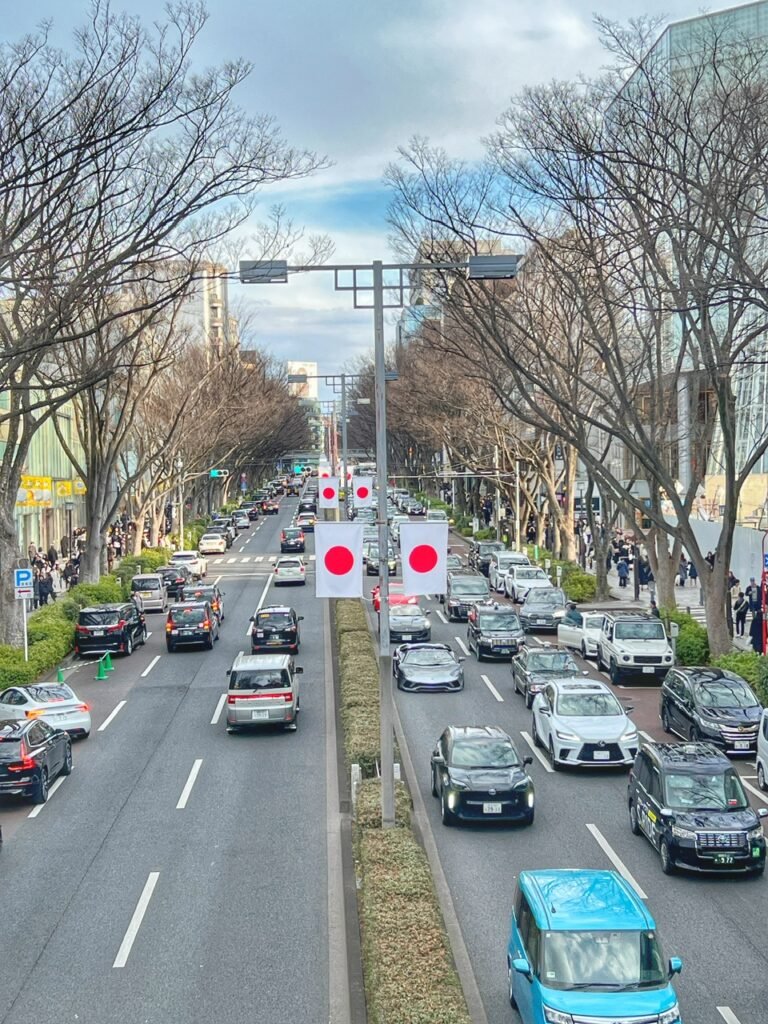

A pedestrian overpass shows some of the traffic below. As you can see, cars drive on the left in Japan. All the traffic we’ve seen has been incredibly light because apparently only 12% of the trips taken in the city are using a car. Tokyo has the most-used public transit system in the world — about 15 million people each day. (Japan Railway Review.)
We then thought we might stop for a craft beer at a familiar brewery called PDX Taproom. However, it was full of Americans and a beer was over $10 bucks so we opted out! 🤣
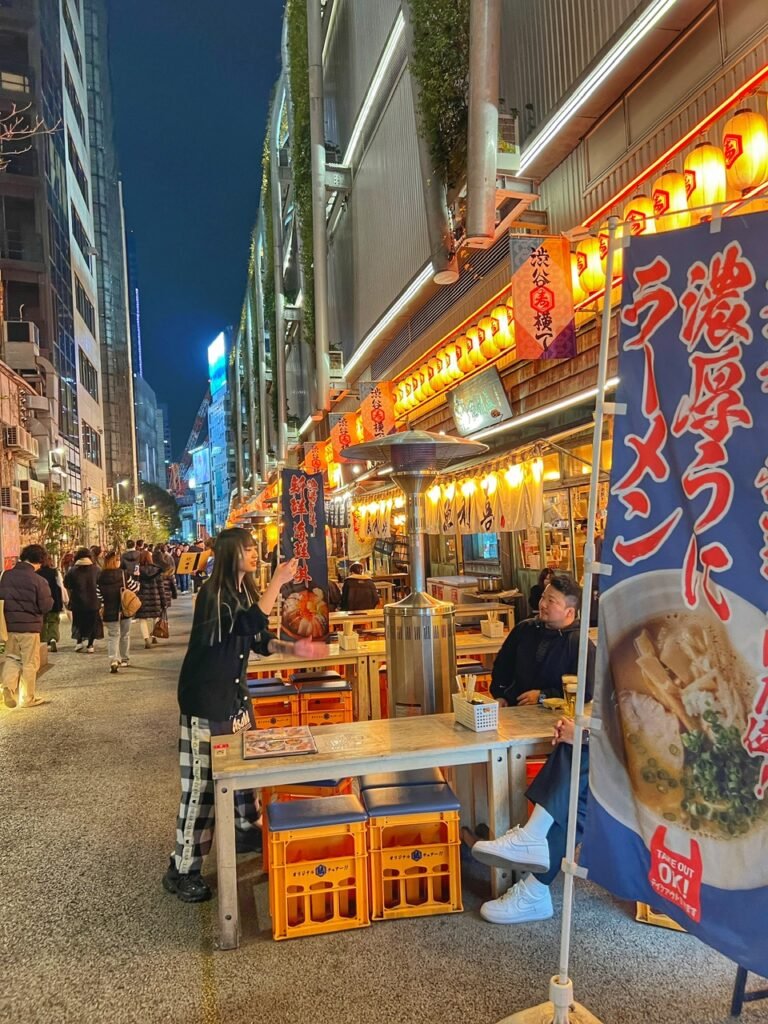
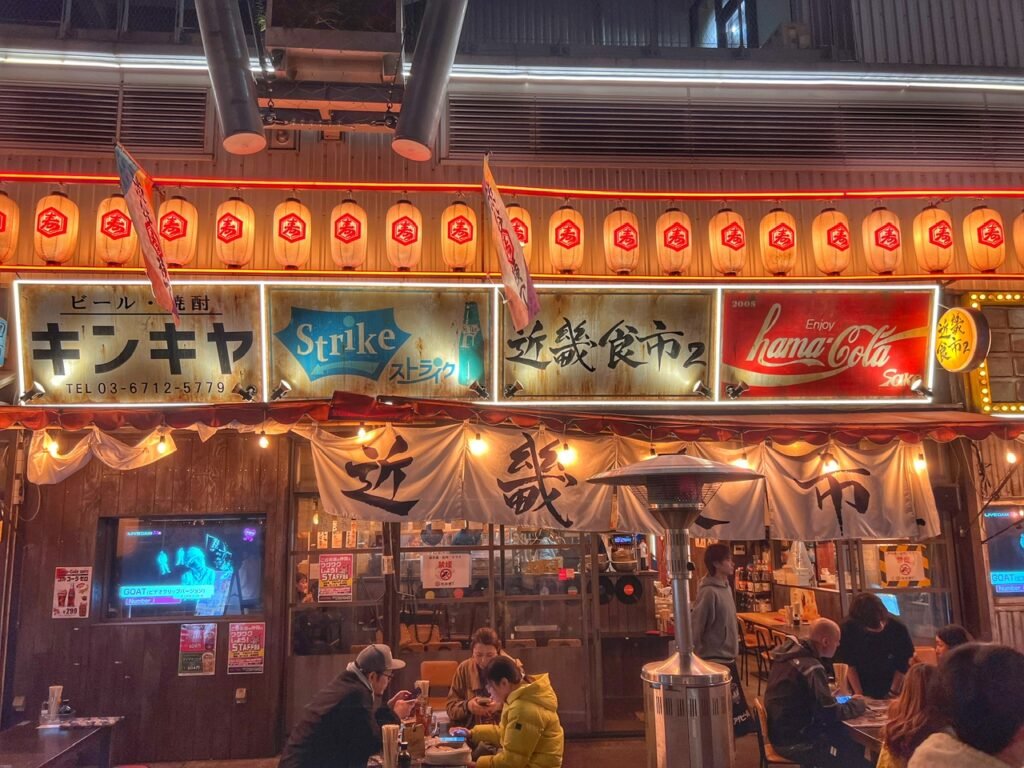

Shibuya comes to life as the sun goes down. The low lights and lanterns make these restaurants so inviting. Now this is Tokyo…looks like a scene from Blade Runner.
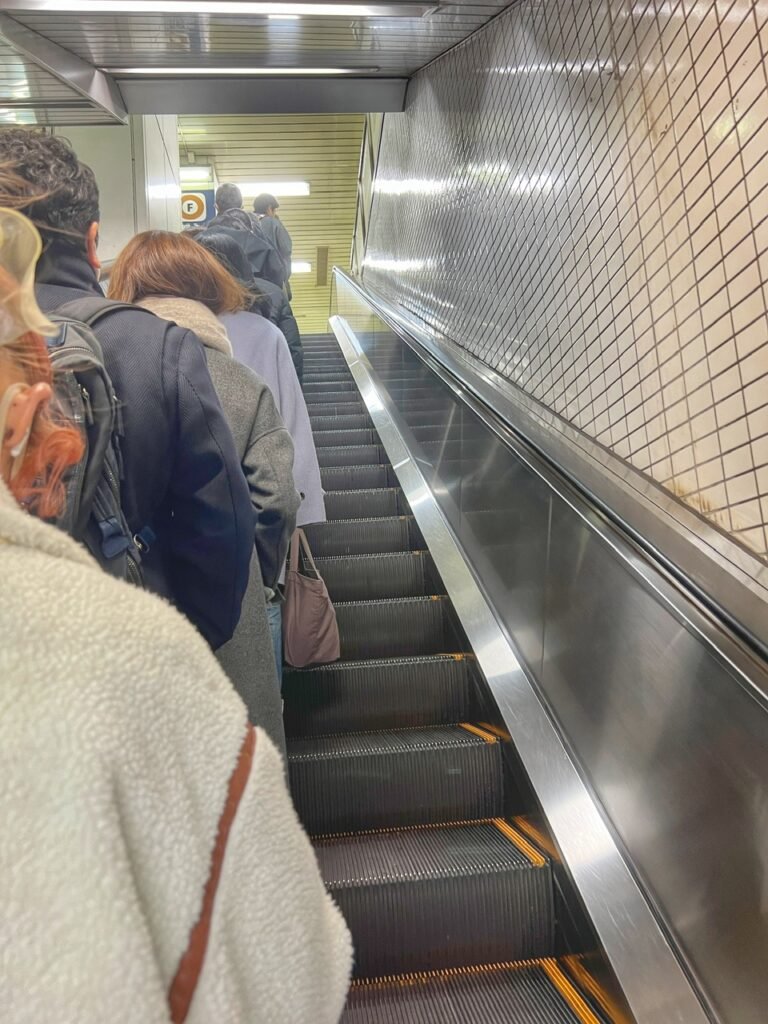
Heading home for the night, we join a queue on the escalator. Japanese people are always abiding by the rules and standing on the left and walking on the right, never being pushy and letting you go before the them. They might be the most polite culture we’ve run across.
MiPig Cafe
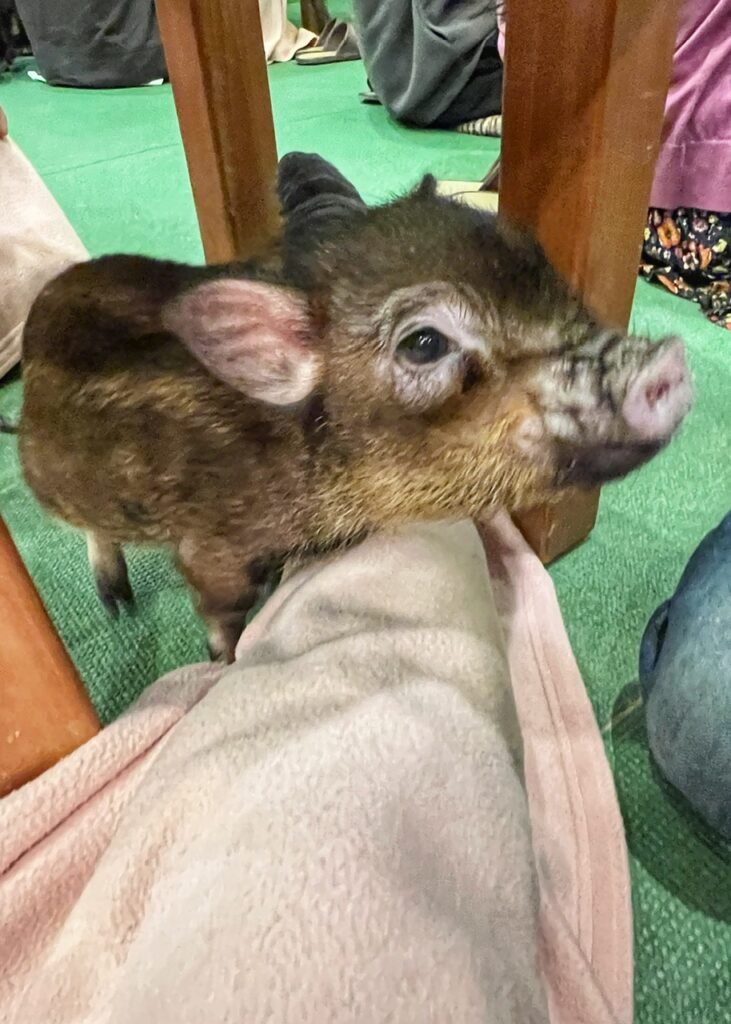
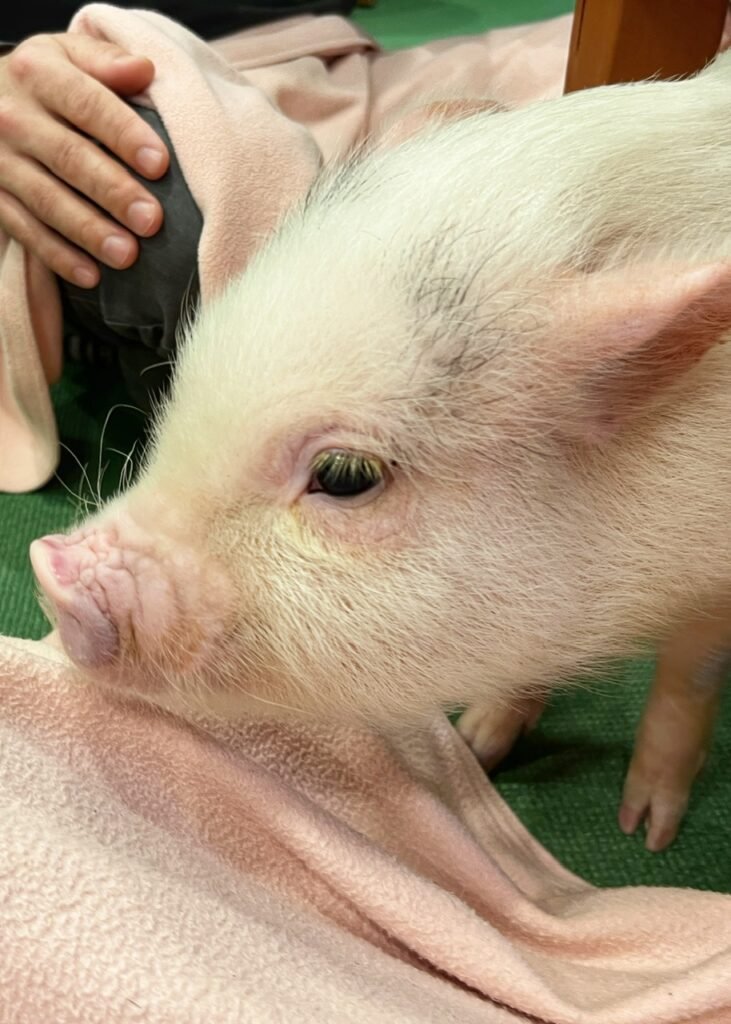
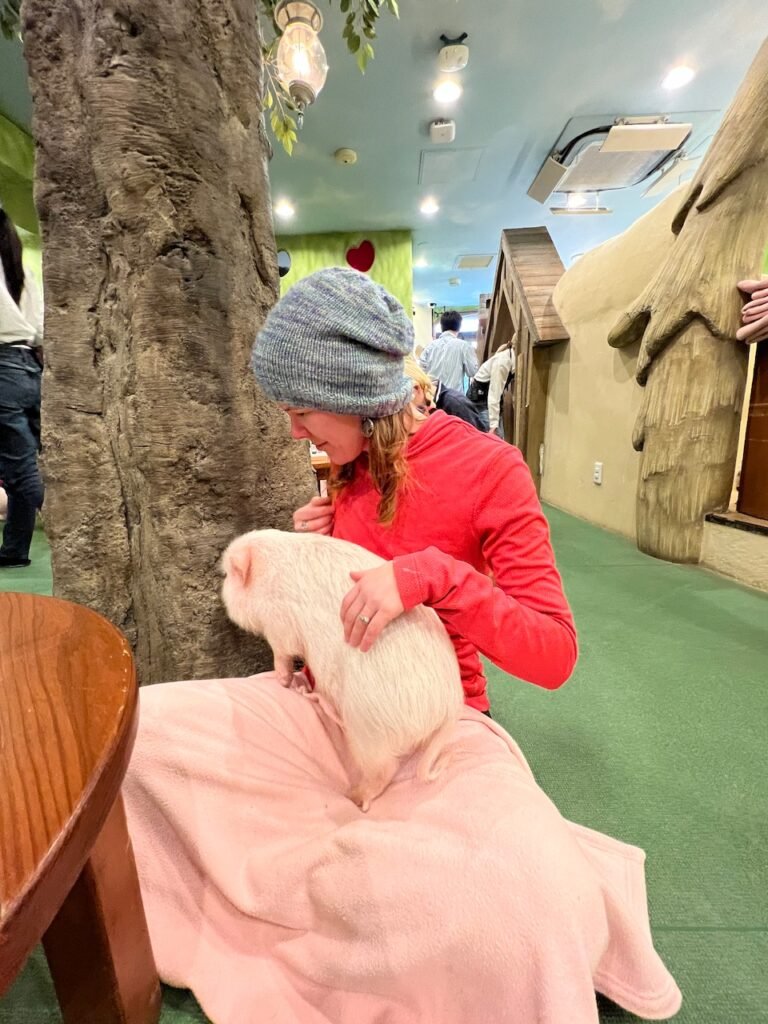
Ahh…there’s nothing like an afternoon caffeine fix with a snuggly…pig(?)…on your lap. Although they have and adore classic Cat Cafes in Tokyo, which have expanded globally, they are kind of old school now. Trending now are basically animal cafes for everything else….puppies, hamsters, rabbits, hedgehogs, owls, foxes, penguins, capybaras, otters, and what we chose…teacup, or “micro” pigs as they call them in Japan.
We narrowed down micro pigs from over 20 types of animal cafes because it’s an animal Mandy has always been obsessed with, but never got to spend time with.
Also, beforehand, we did question the ethics of whether a traditionally undomesticated animal, like an owl or fox should rather be social distancing and not mixing with the public, and we liked the mission of MiPig which assures that their adult pigs head to the home of a new family and not a dinner plate.
However, at MiPig, micro micro babies to adult ones live in harmony, and you are a friend of them. It’s also a training place to learn to socialize, and after learning how to deal with humans and other micro pigs, they will happily live with their new family.
Micro pigs are tiny pigs which originated in the UK. They are a smart, adorable, and clean animal. As well as being able to learn verbal commands, they know right where their toilet is, which Mandy was a little relieved to know wouldn’t be on her pale pink blankied lap.
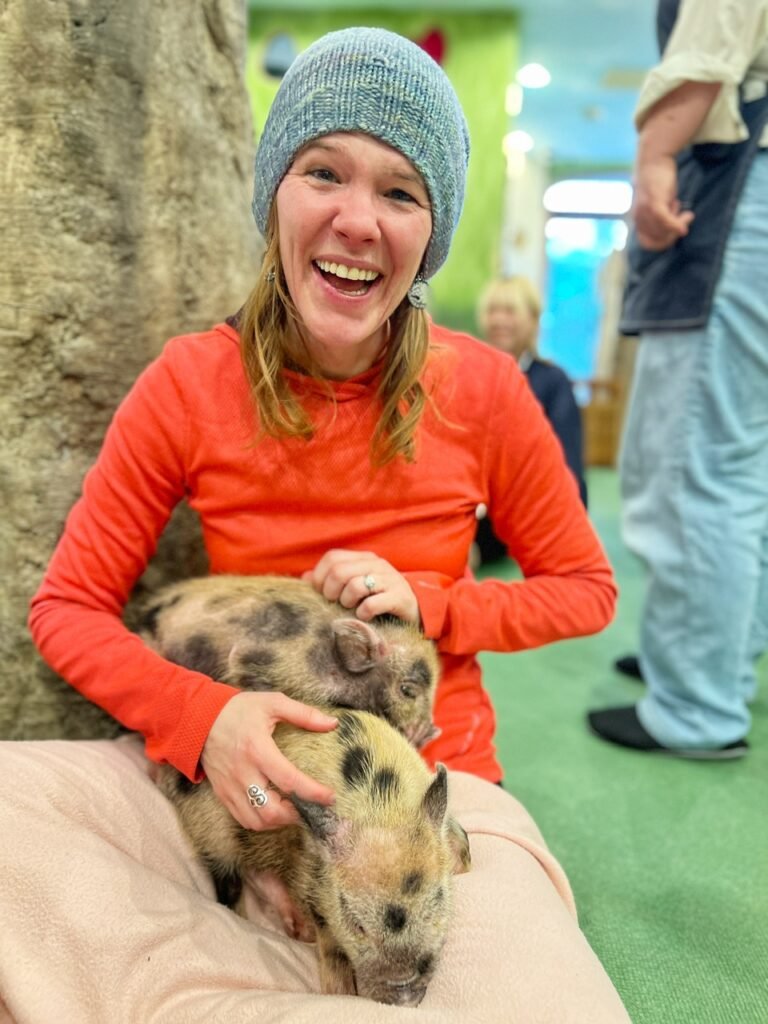
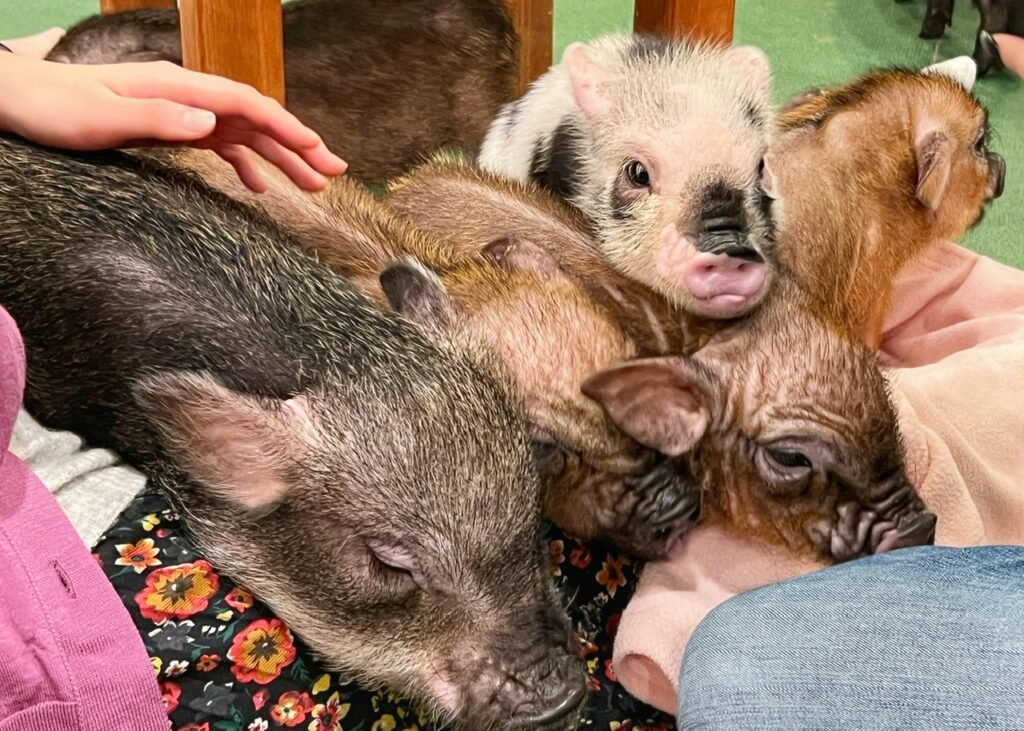
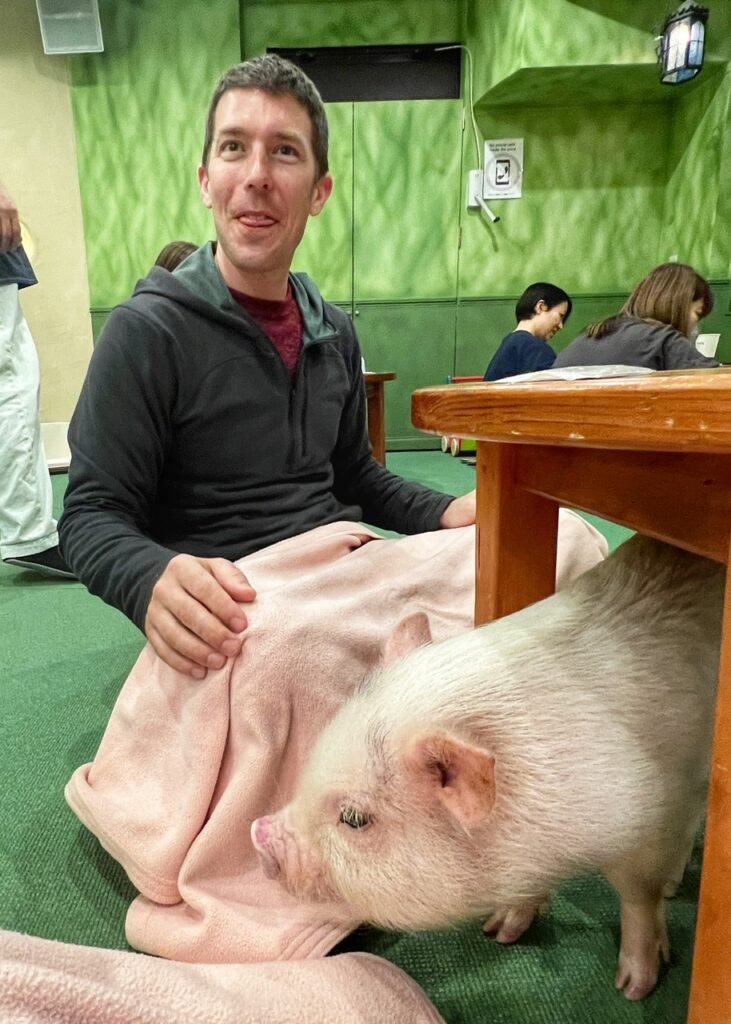
And then, with a few very satisfied snorts, two babies decided to snuggle down on her lap for our entire allotted thirty minutes. Not that she minded. Although she was a little envious of our neighbor who had six. And poor Greg was still waiting with an open lap!
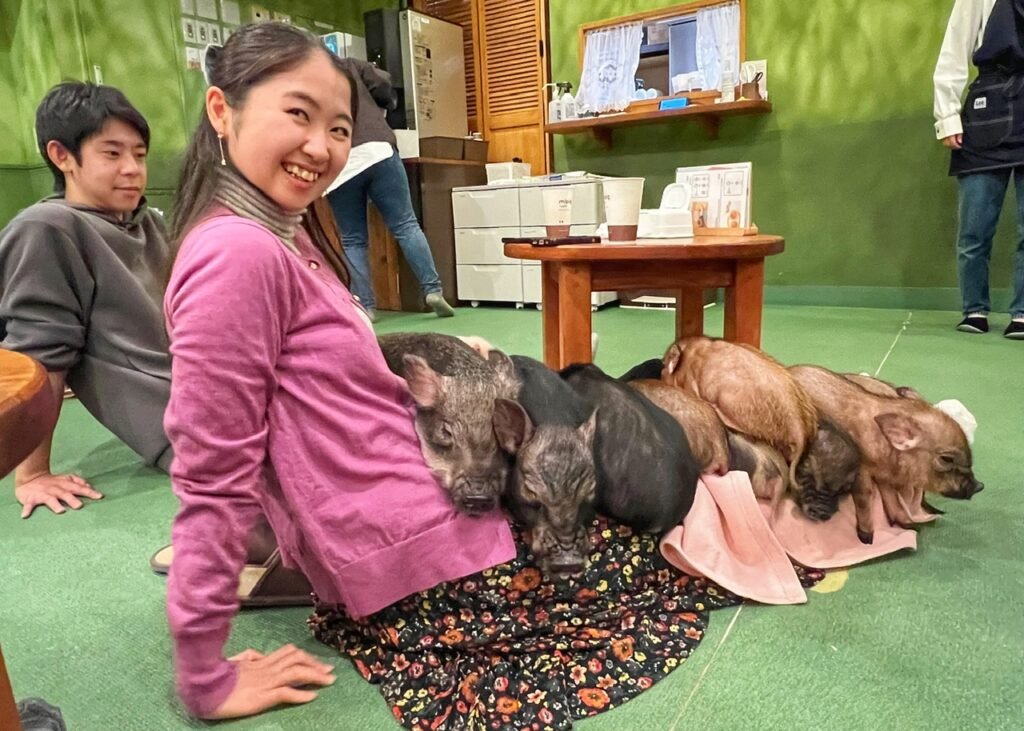
Our neighbor was in hog heaven.
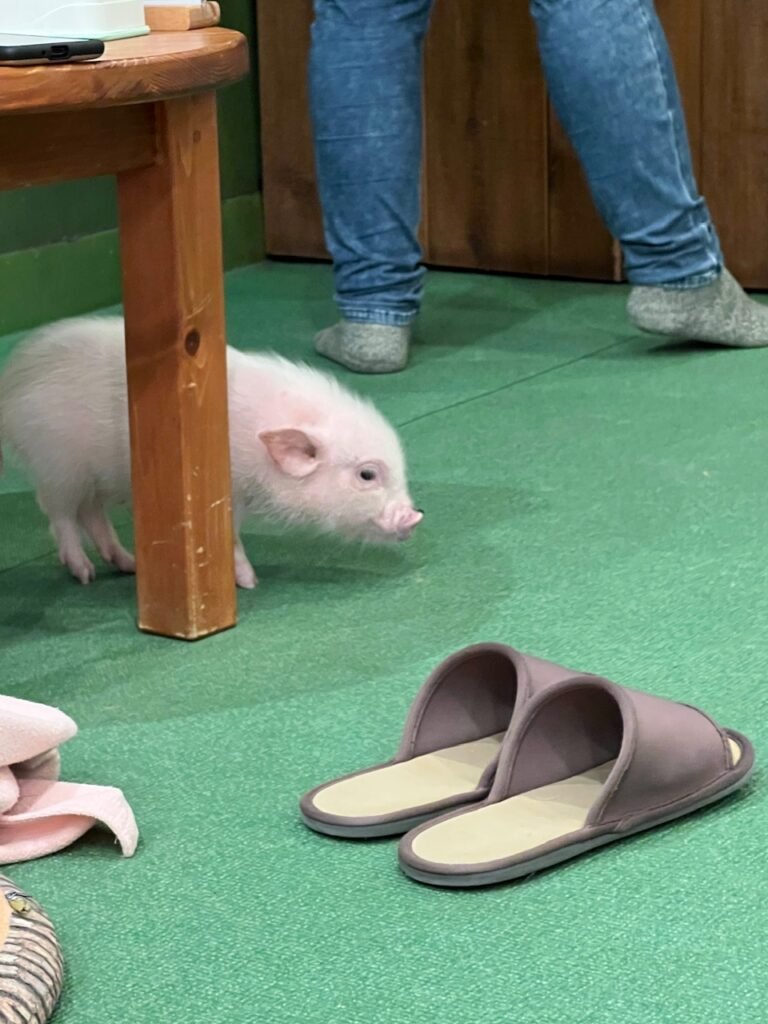
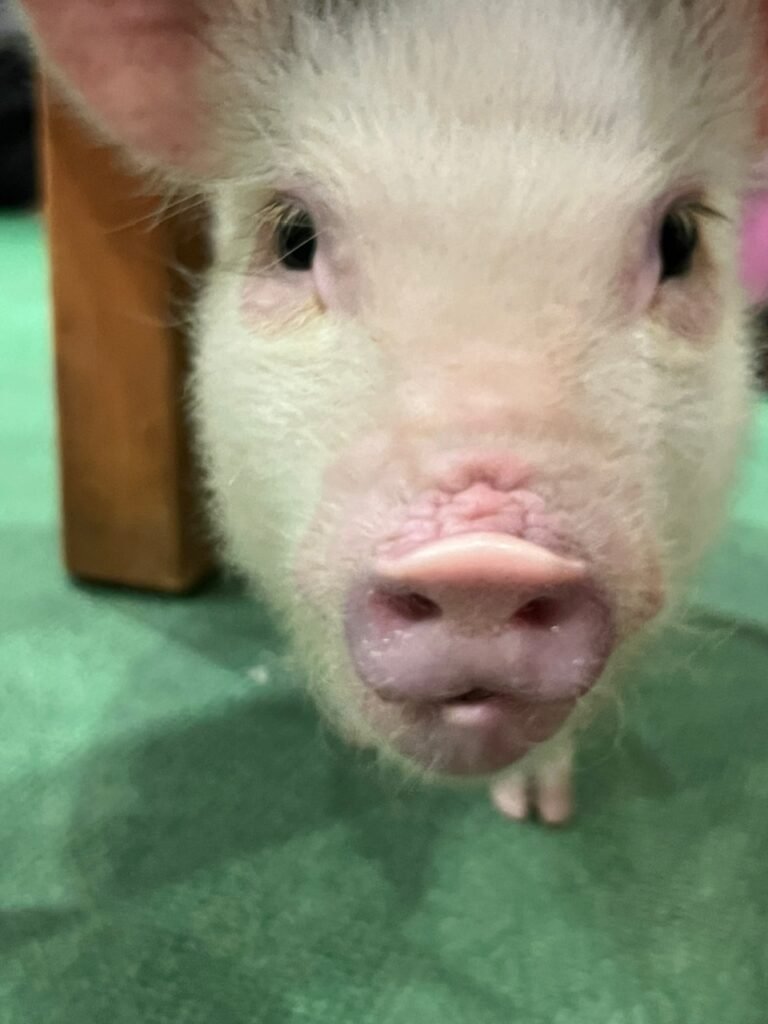
To go to MiPig you need to make a reservation in advance. It costs about $15/person for a half hour time slot. But for us, this kind of animal experience was well worth the splurge.
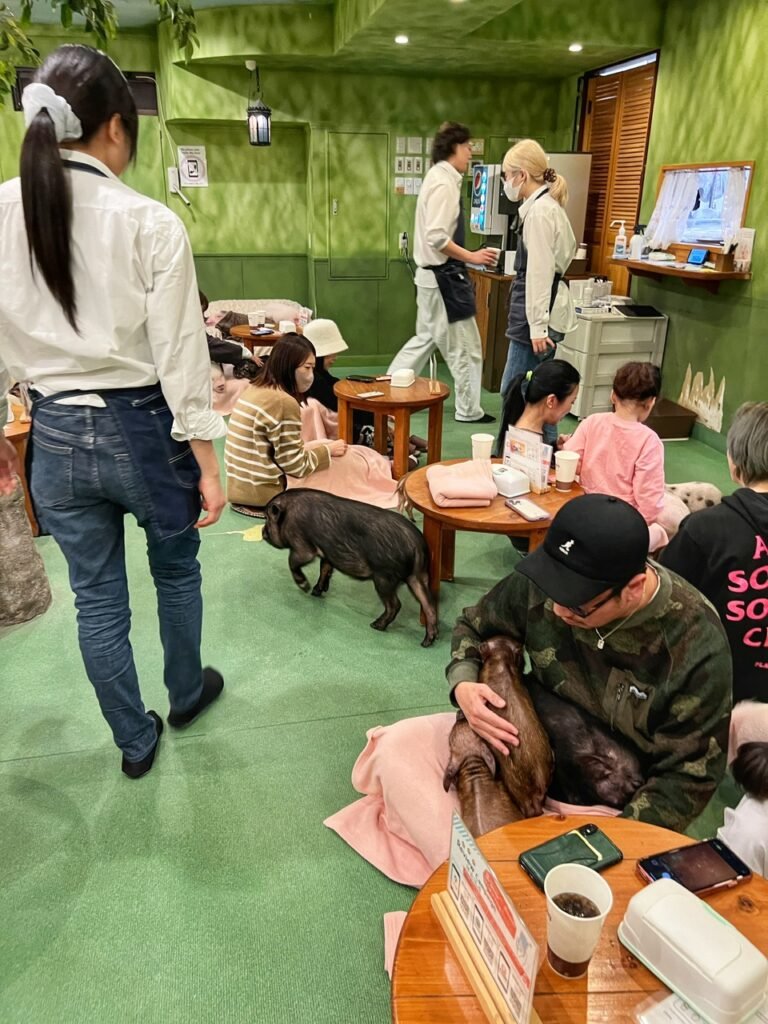
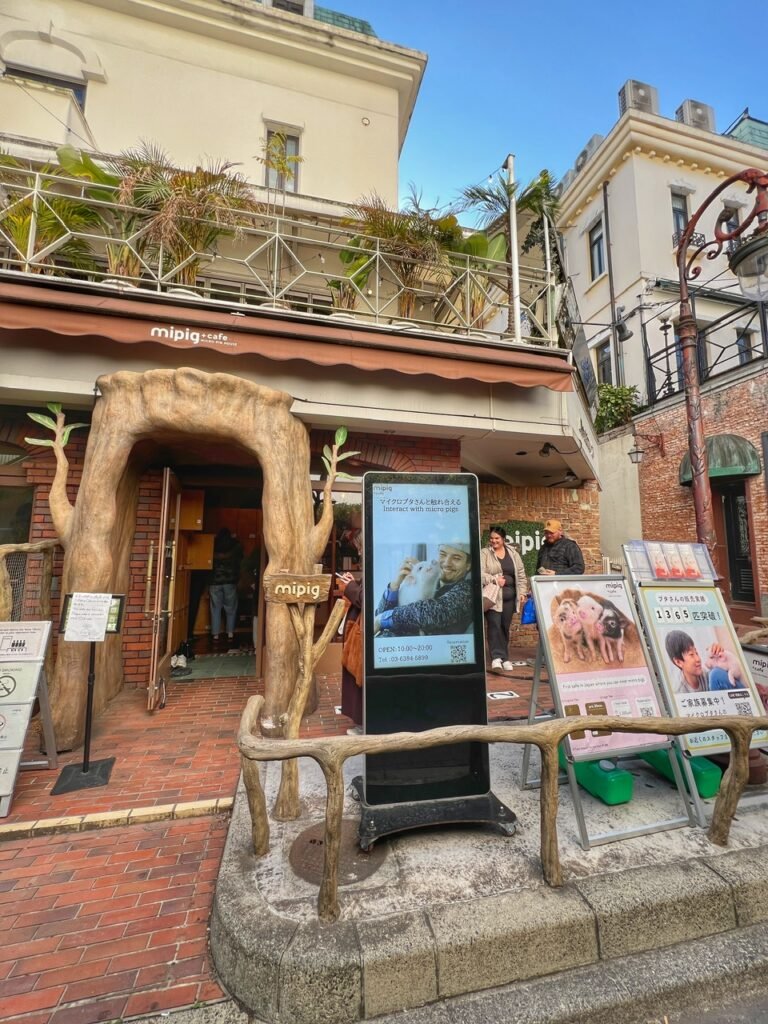
The staff walks around to help guide the piggies to laps with feed, and of course enforcing the rules which includes not picking them up or touching them on the nose.
The outside of MiPig is indiscrete. We thought there might be a paparazzi of cameras looking through the window at us like in some cat cafes, but they handled the privacy issue well.
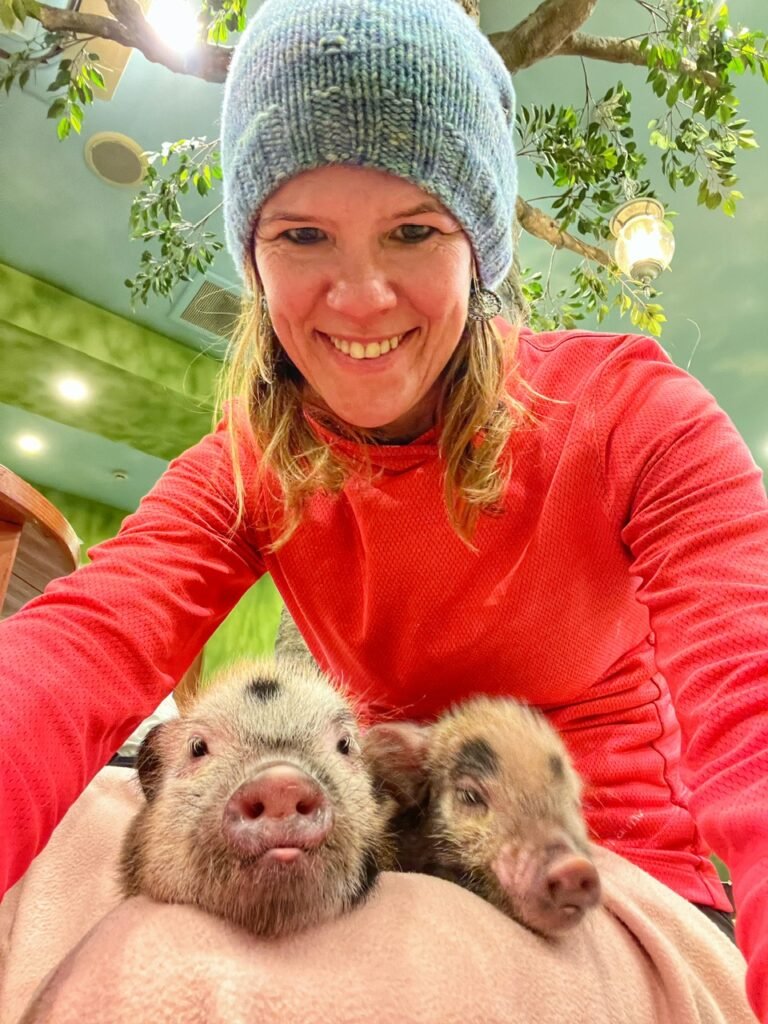

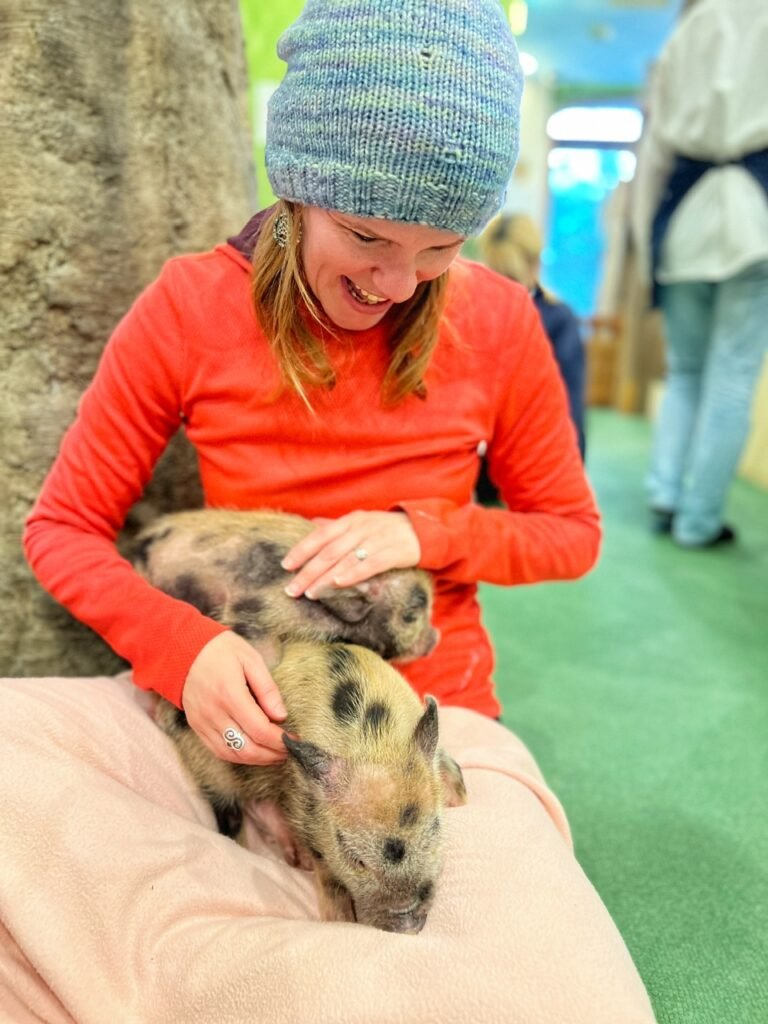
For the record, it’s really not that easy to take a selfie with two dozing piglets on your thigh.
Day Four: Tsukishima District
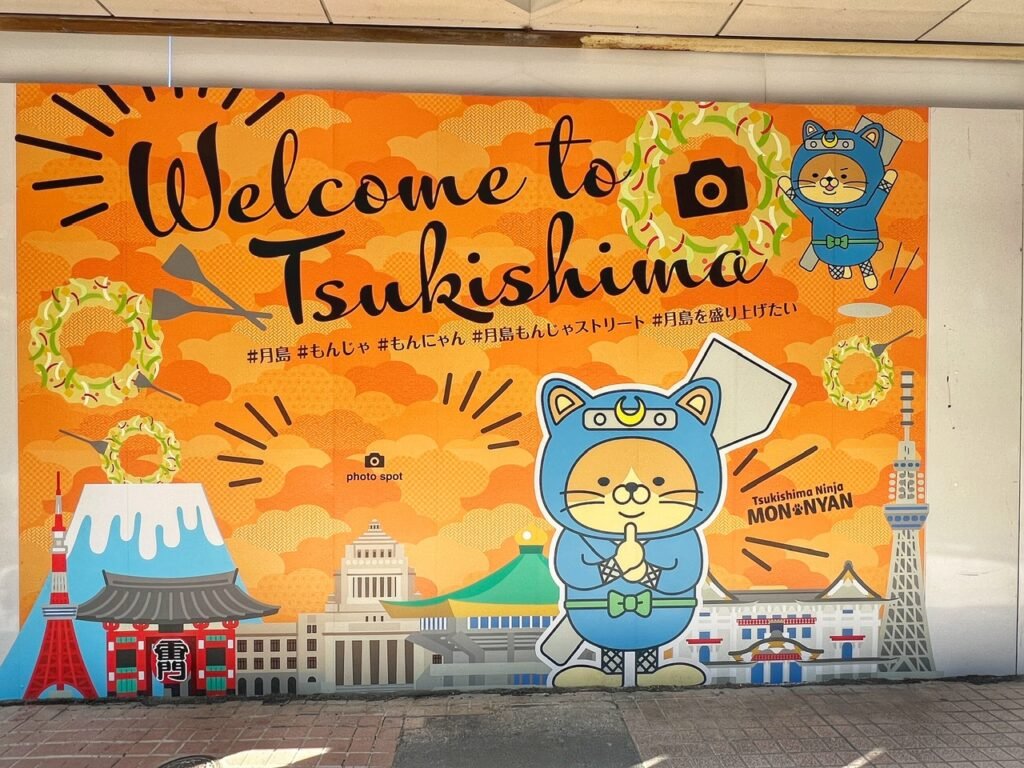
By day four, we were growing a little weary from the fast pace and endless crowds of this mega city so it was no surprise that Mandy fell asleep twice during kabuki theatre truly getting her $8 worth. We also had a new experience of eating Monjayaki over a personal grill in the Tsukishima District and sharing squid with local girls at the adjoining table. After this, exhausted, we decided to stay in our well earned private hotel room in the most unattractive kimonos from 4:00 pm on.
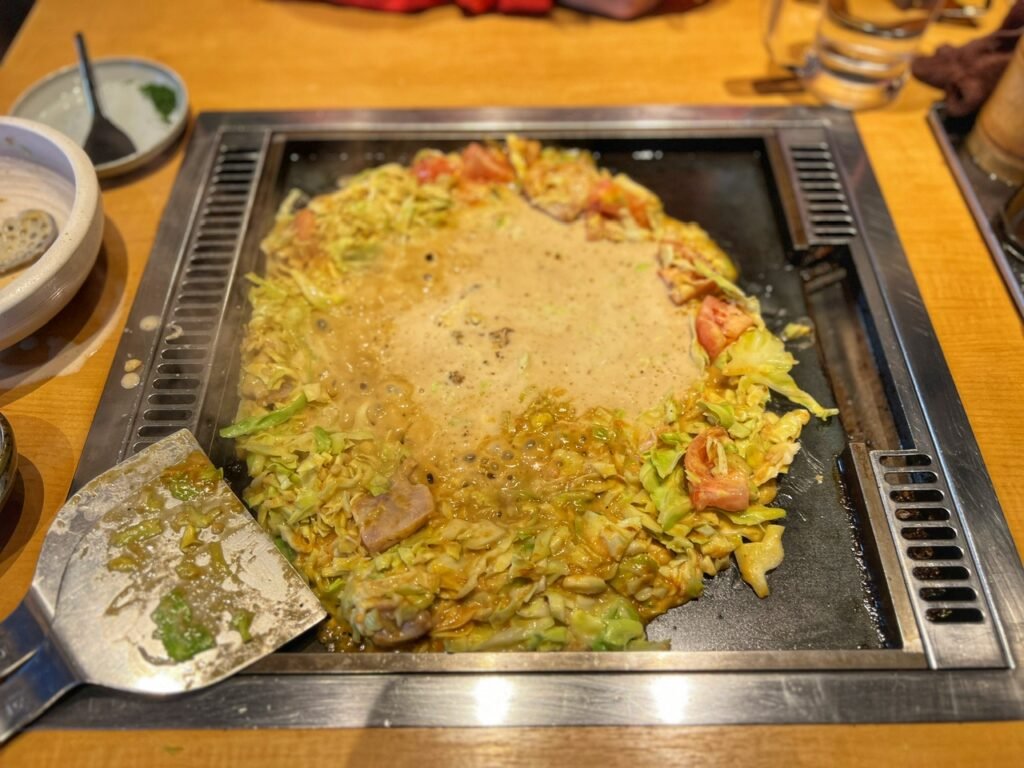
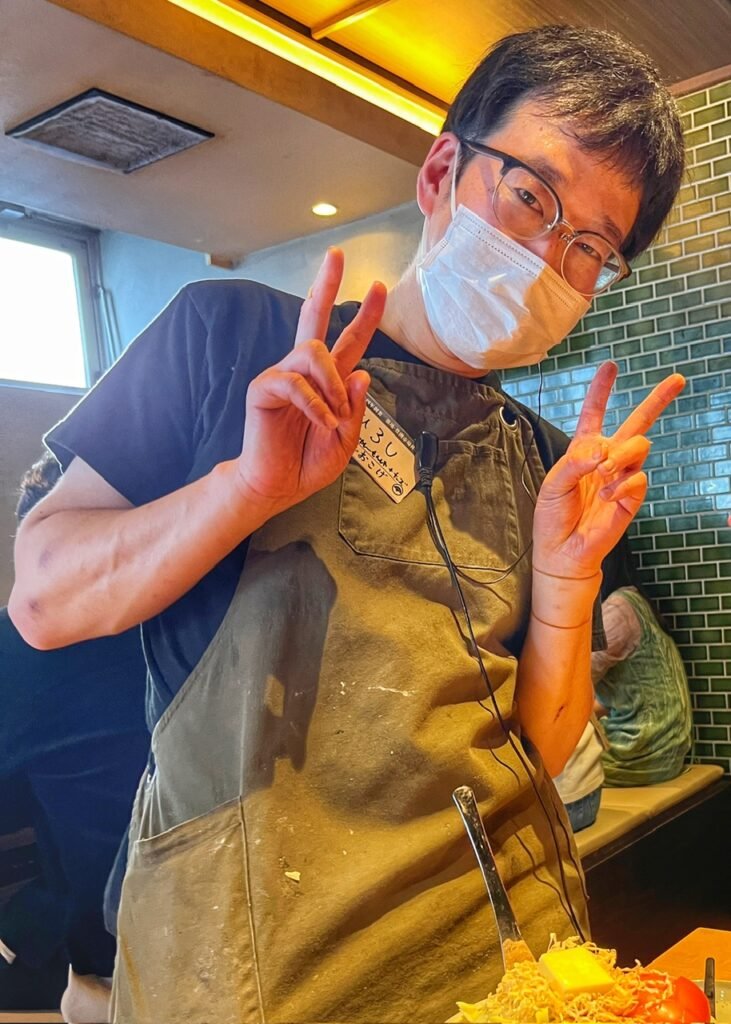

If you’re looking for a true local experience where you won’t find English menus or many foreign tourists, head to “The Tsukishima District” known for its 80+ eateries that serve monjayaki, or monja, for short.
Monja is a pan-fried batter dish popular in the Kanto region (around Tokyo). It’s not the most appealing dish…at all…but fortunately tastes better than it looks. The dish is often compared to Okonomiyaki, which is originally from Kansai region (around Osaka). Monjayaki comes with various ingredients similar to Okonomiyaki (chopped vegetables and meat) but has much runnier batter mixture combined with water and dashi stock.
As is common, our waiter and chef combo deal named Takahiro spoke enough English to put our 10 Japanese words to shame. Also as is common, he was more than ready to get his photo taken. Mandy is ready too, although she has no idea what for! 🤣
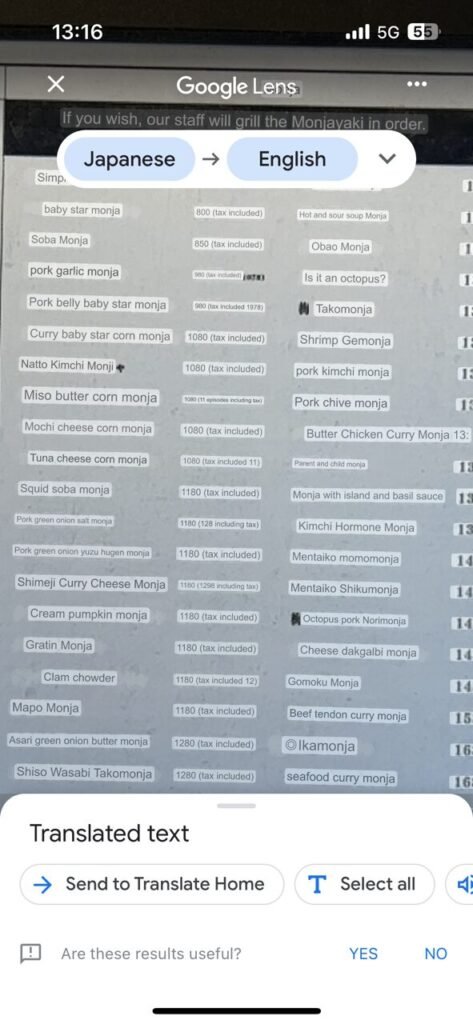
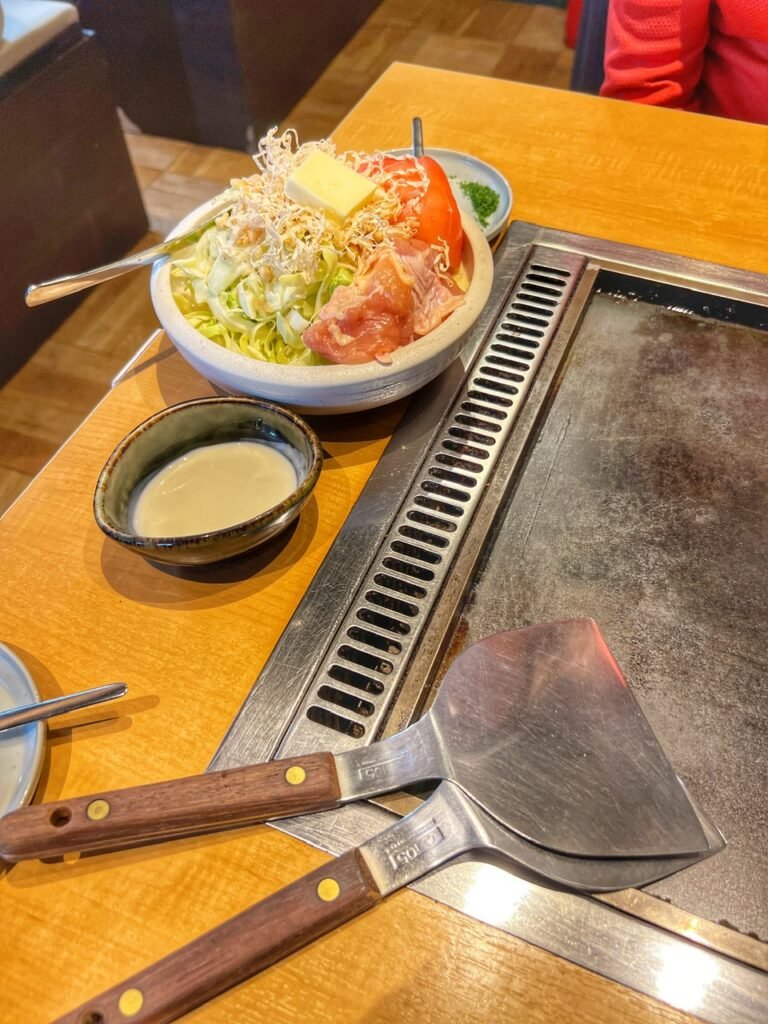
Part of the menu, which was an endless list of squiggles. Thank god for Google Translate. As usual, the menu was loaded with pork and the chewy type of seafood options. Mandy doesn’t eat anything with four legs, so we compromised on a butter chicken curry. Because curry is always a safe choice, right? Condiments in Japan: Ichimi (chili spice), soy sauce, seaweed flakes and oil. Our food has arrived, raw and in bowls.
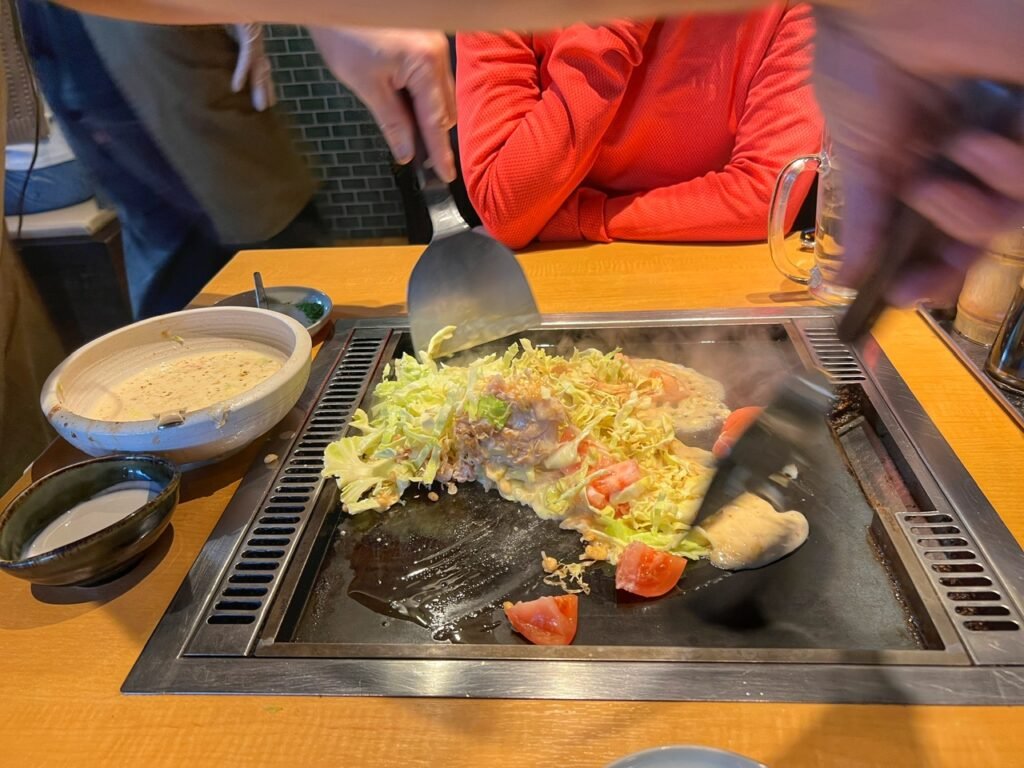
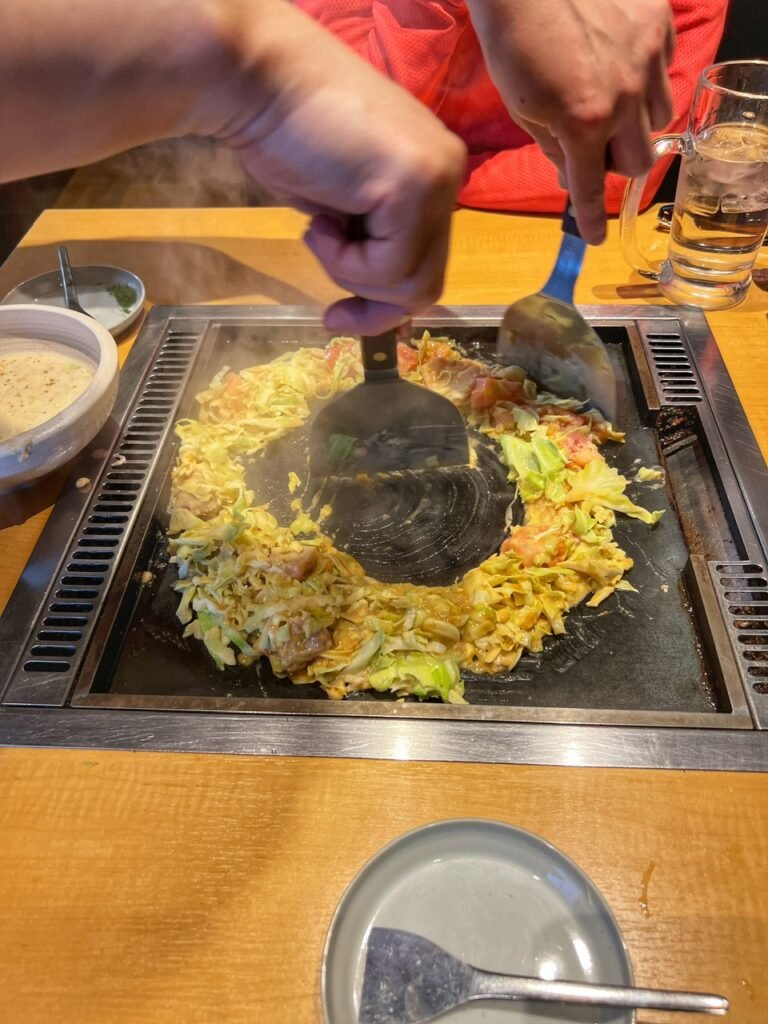
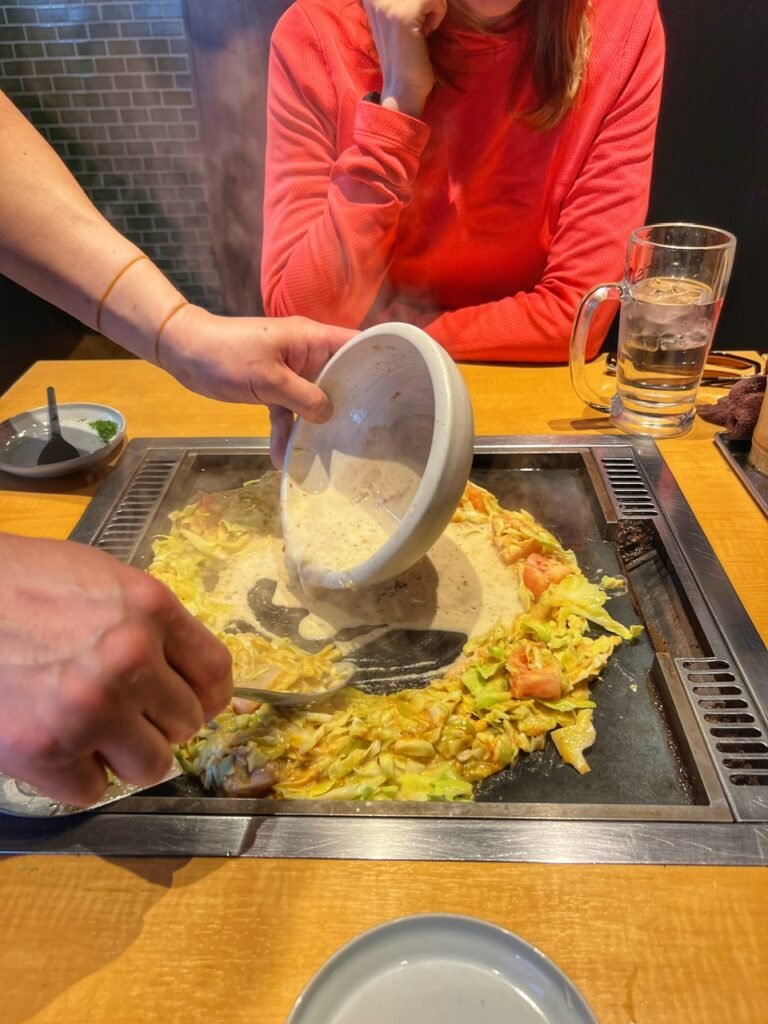
After Takahiro lathered the griddle with butter, he dumped all the ingredients on. He then chopped and stir fried the ingredients with a spatula, eventually making a ring-shaped chicken and veggie donut. In the middle, he poured in the curry cream until it thickened.
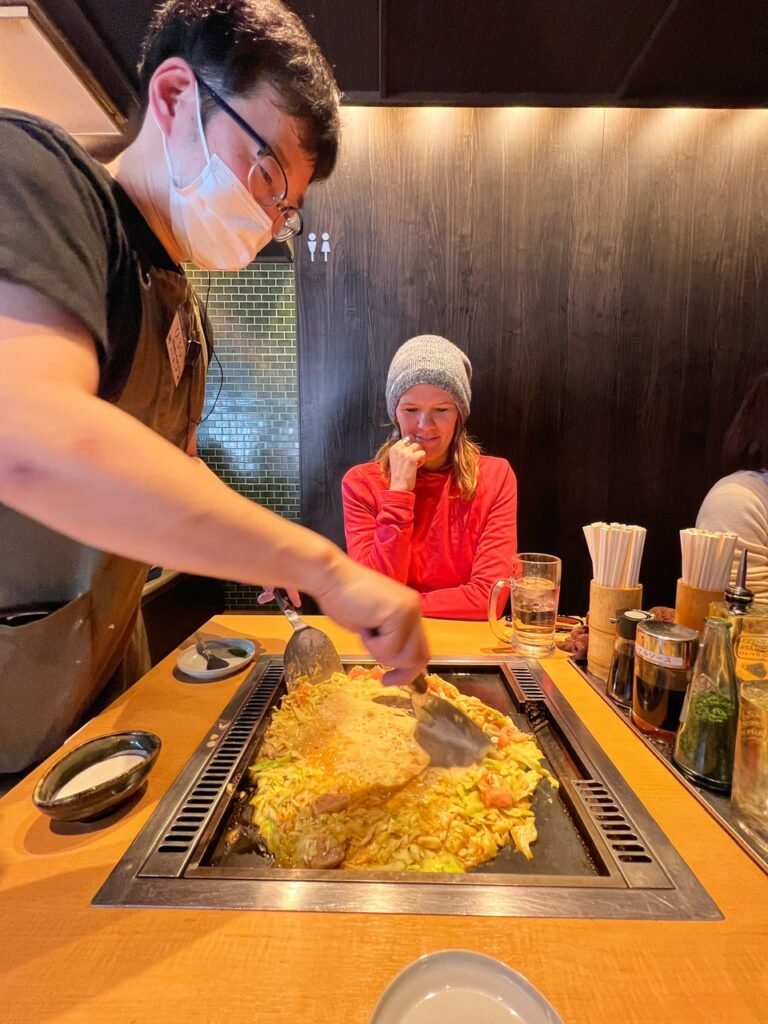
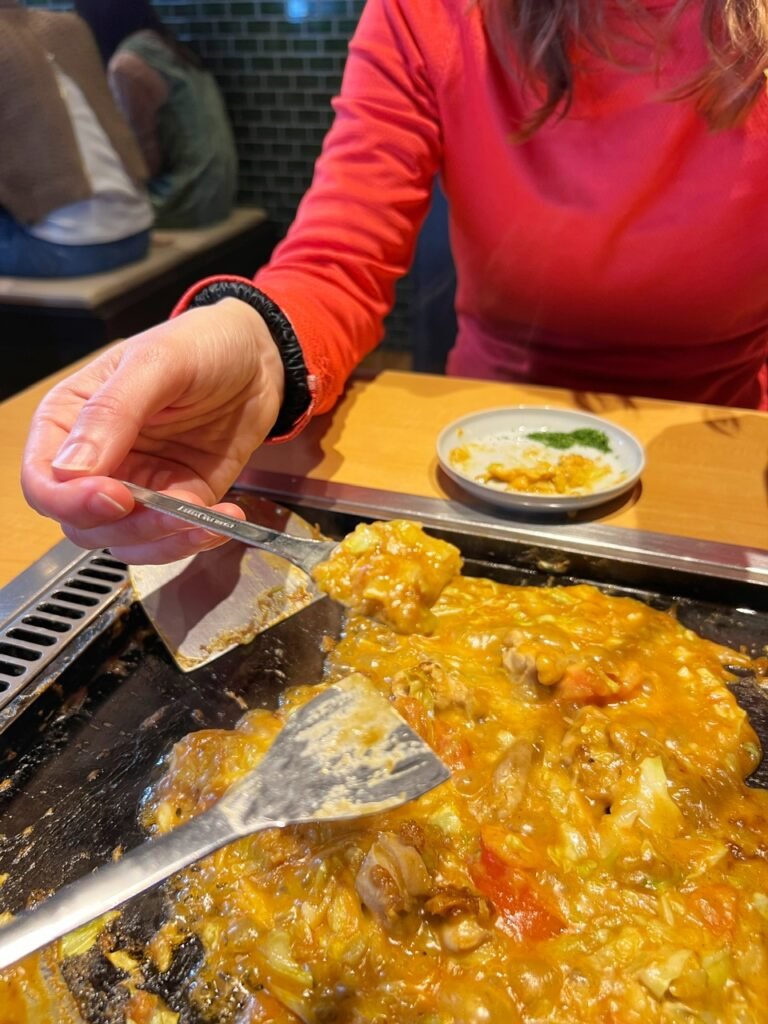
He whipped the ingredients and the cream together, spreading thinly to complete the dish. We then used the tiniest of food scraper thingies to shovel rapidly it our food holes before it plopped in a giant mess below. The taste was…delicious, but eating anything that slow takes some adaptation and skill. A spoon would have been a lovely bonus feature.
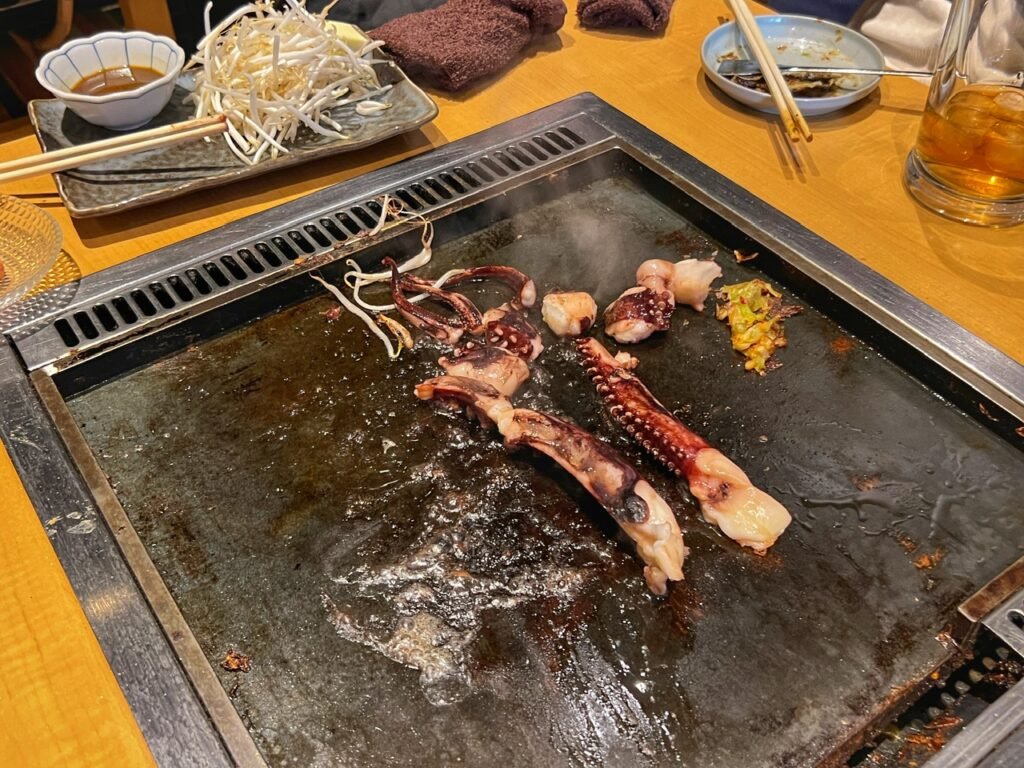
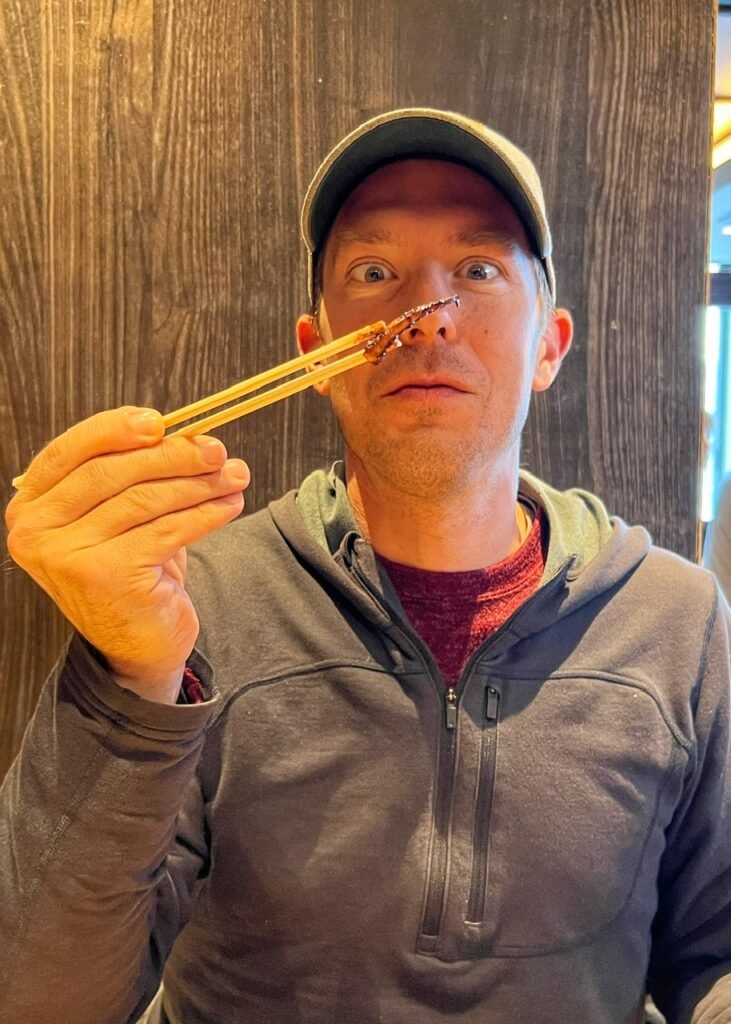
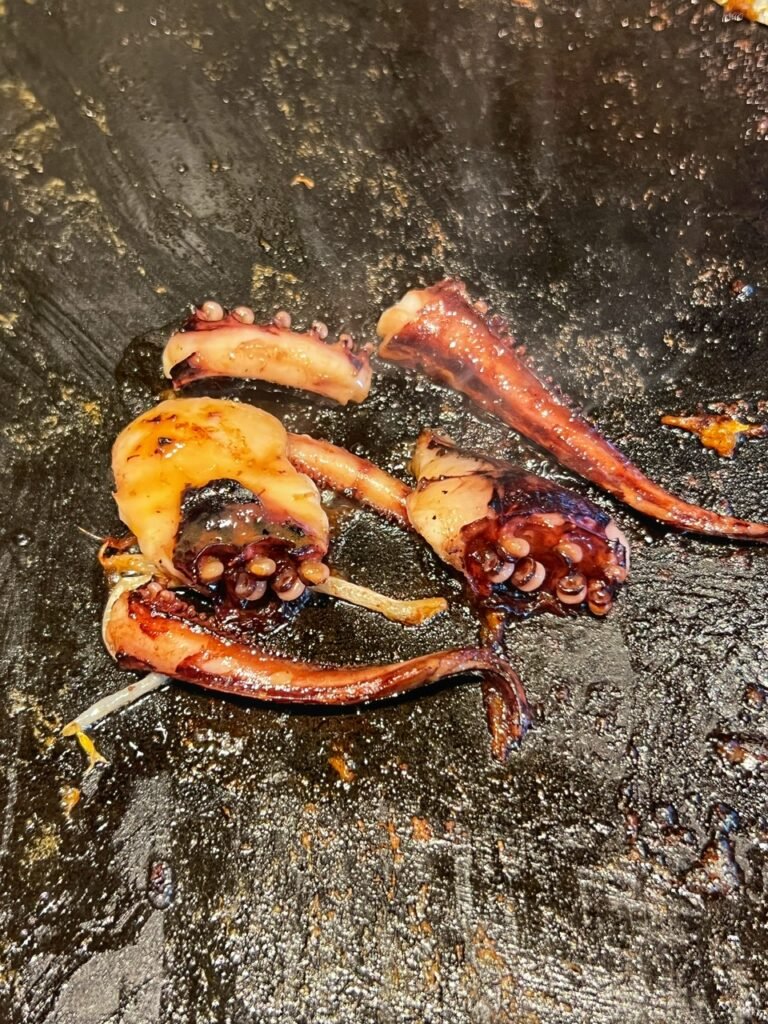
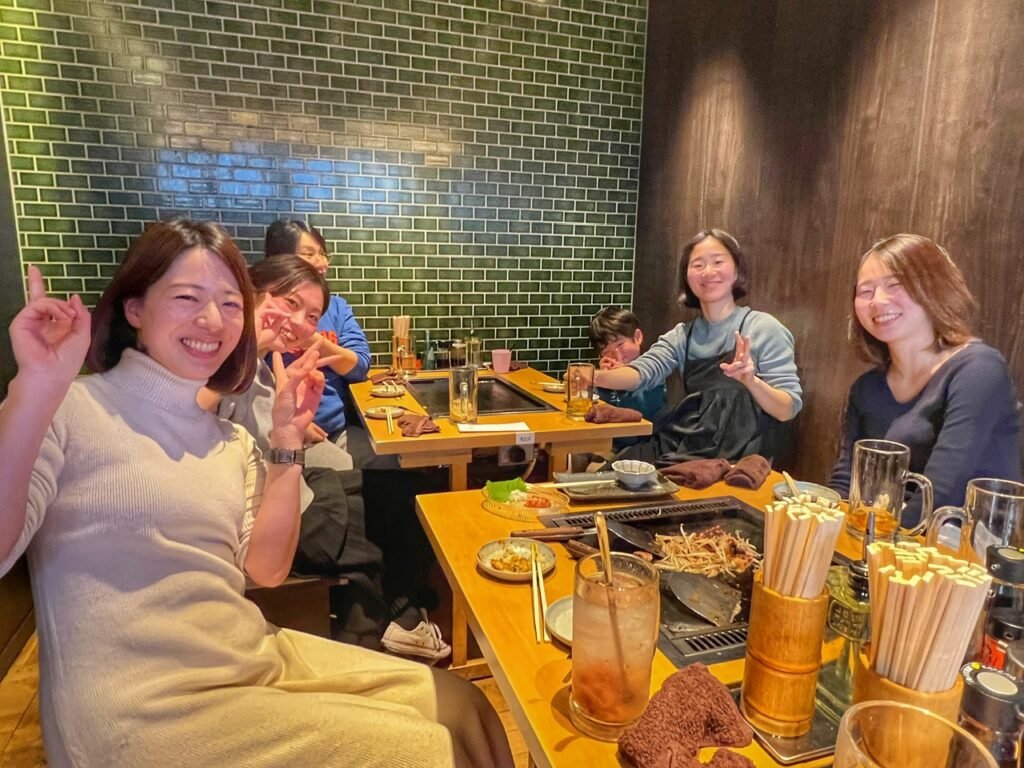
We then noticed our neighbors had something a bit more adventurous. So, of course when they saw Mandy peering, our new friends offered us a taste of their grilled buttery rubber bands; errr… squid! And this is no neatly packaged fried calamari that you get in the States. “Itadakimasu!!!” which means Bon appetit in Japanese.
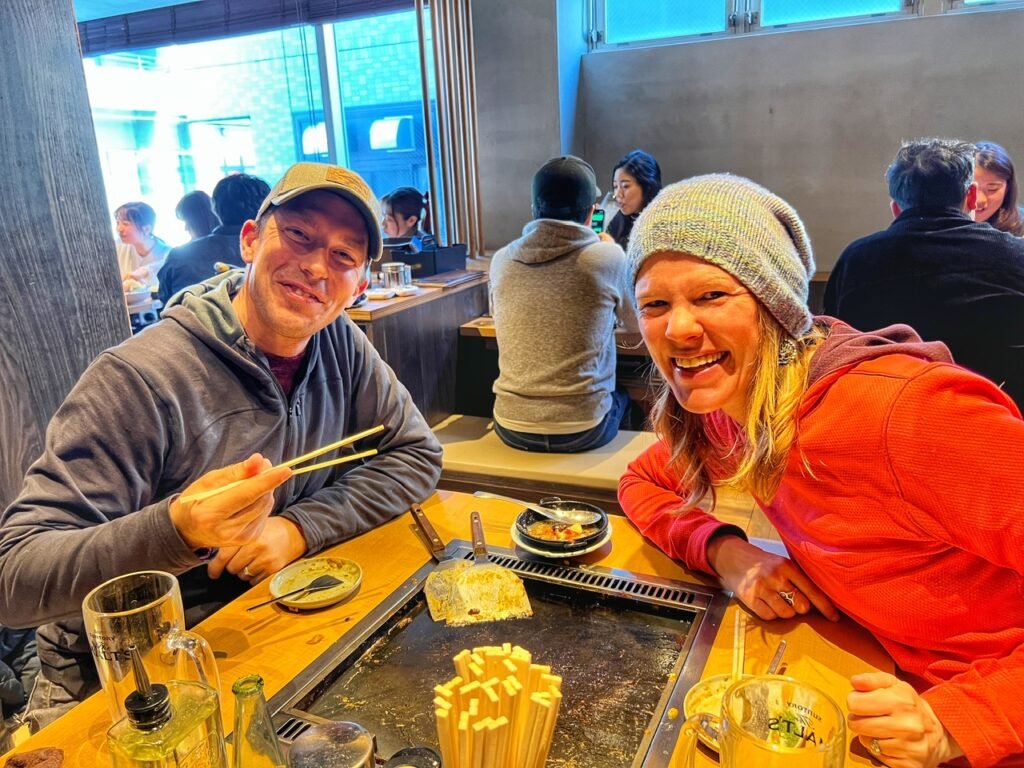
Wrapping up our monja meal.

On the street we stumbled upon a new vending machine much more disturbing than the squid…one completely packed with whale products. Japan…along with Norway and Iceland are three countries which still allow commercial whaling. This was certainly the first we’d seen in vending machine form.
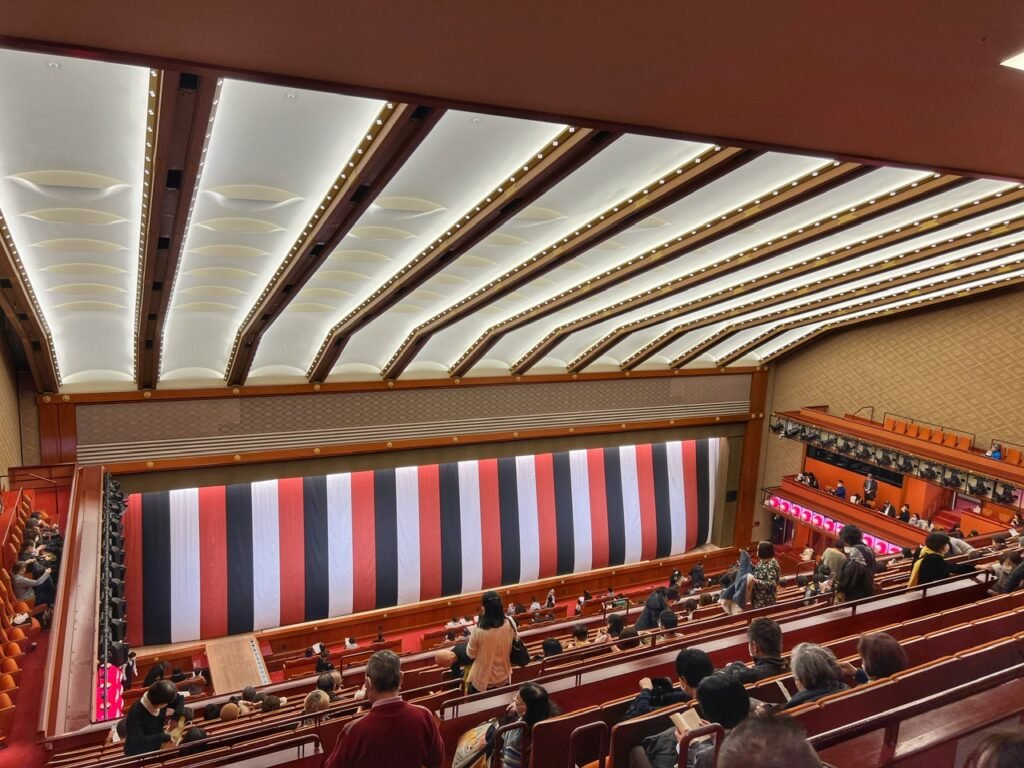
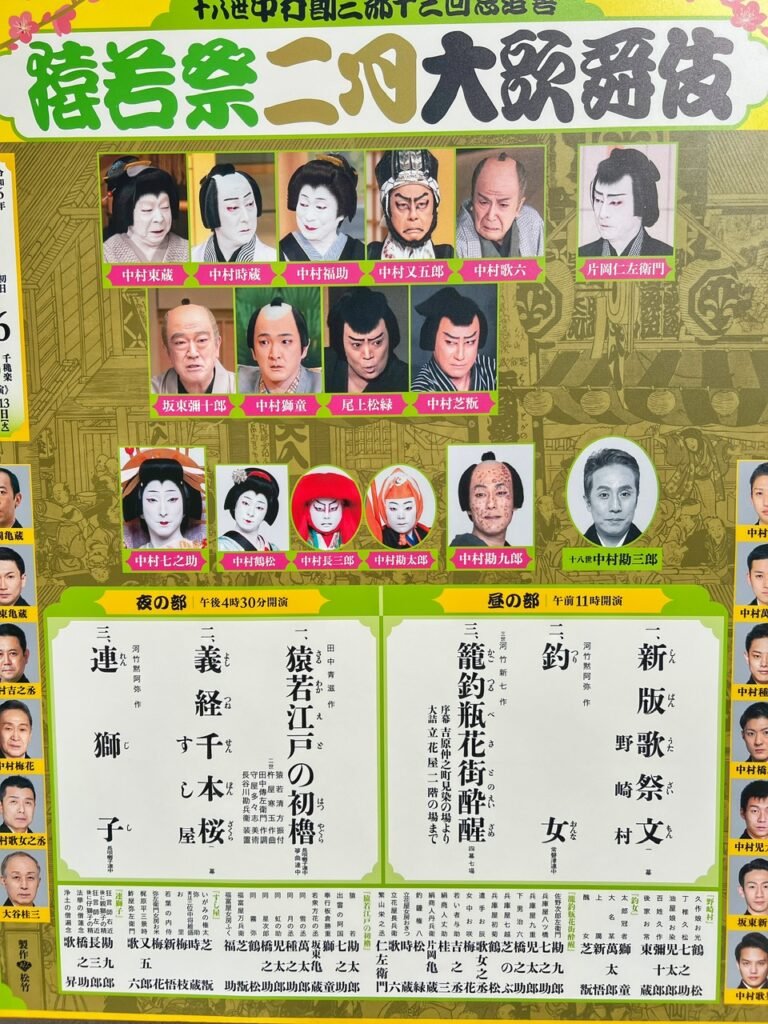
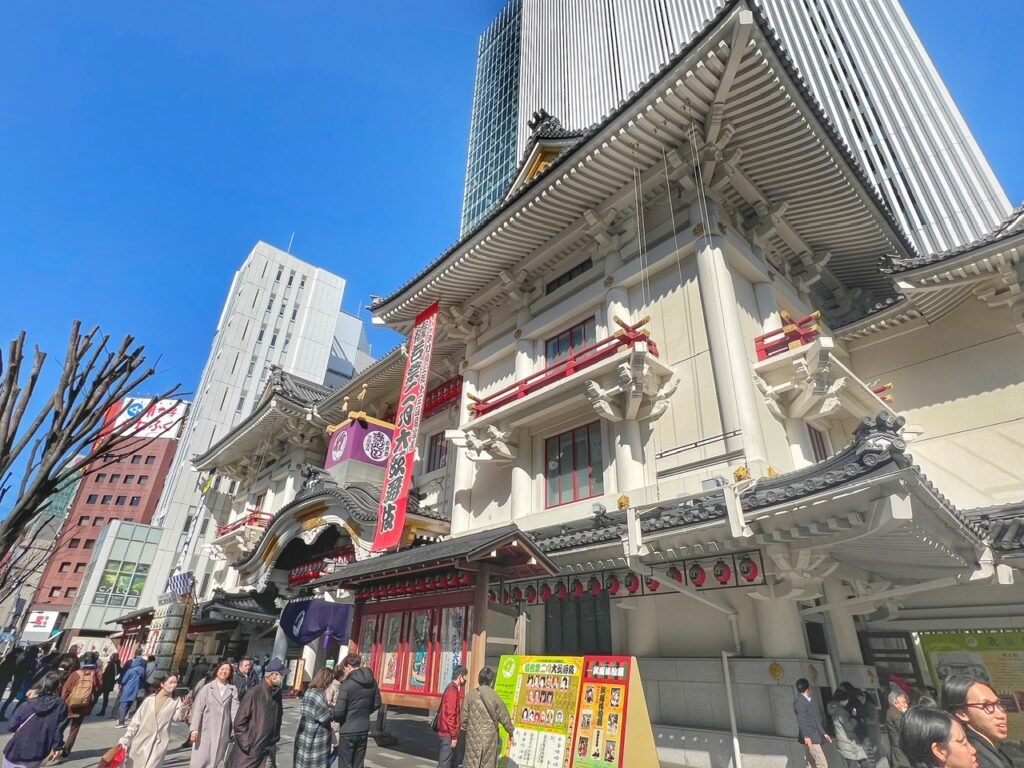
We arrived a bit full to the Kabuki Theatre where you were fortunately able to sign up for only one act lasting an hour and 20 minutes for $8/person rather than a whole indecipherable dramaturgy. With this privilege, you also get to sit in the rafters with the cobwebs after signing a ten page contract that you will not take video or photos. (A joke…there are no cobwebs in this country, but it is clear you are NOT to so much as place your hand on your phone or you will be deported.)
Kabuki plays date from the early 1600s and are one of Japan’s great performing arts, which is why we wanted to give it a shot. They are about historical events and moral conflict in relationships of the heart. The actors speak in a monotone and soothing voice and are accompanied by soothing and strumming traditional instruments…”a blissful and inevitable setting for a snooze, especially when you understand nothing,” proclaimed Mandy after the show. (For the record, she wasn’t the only one.) Greg, having stayed awake, thought it was a quintessential Japanese experience and found it absolutely worthwhile. It’s very different. The Kabuki stage is equipped with several gadgets, such as revolving stages and trapdoors through which the actors can appear and disappear. (UNESCO_org)
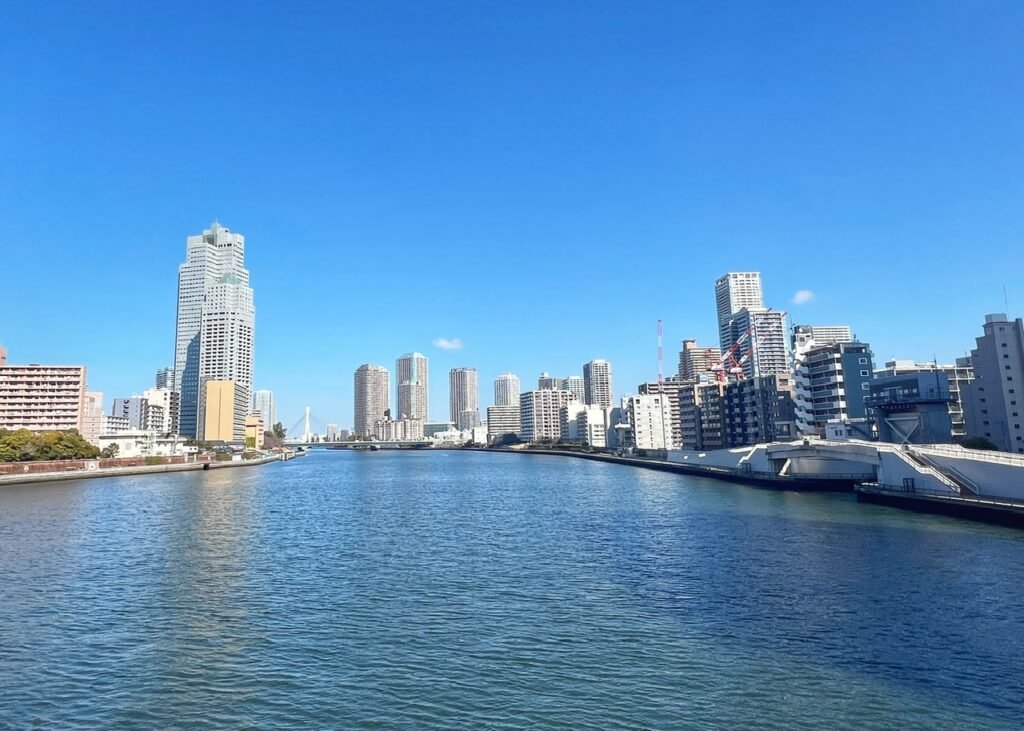
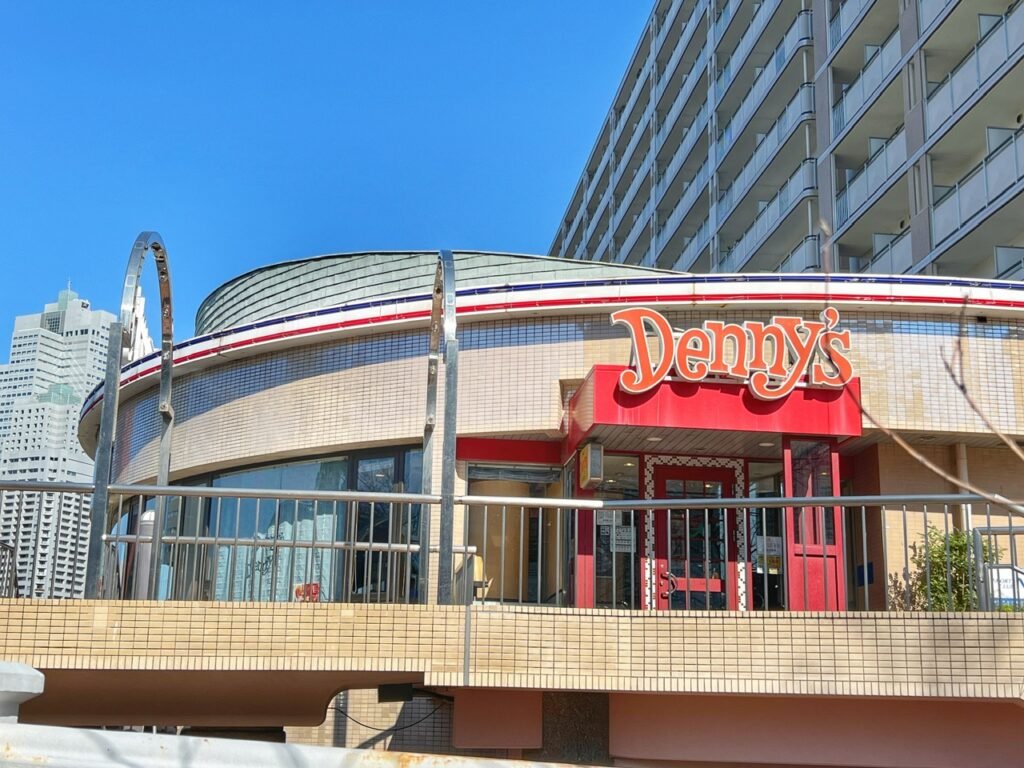

Another river view, where we stumbled an American icon….which was packed…with white people. 🙄 It was time to head to our hotel, but first we had to get there. Good thing Tokyo has helpful (and a bit condescending🤣) signs around like “How to Get on the Bus.” Fortunately, the subway goes everywhere so we didn’t have to maneuver that animal.

Determined to keep our stomachs in Japan, we bought something that looked pretty tame for dessert and did not include beans, matcha or sesame. It’s melon pan, which has a crunchy sugar-coated shell and a fluff monster middle. It’s named because of the criss -crossed pattern that looks melon-ish, not because of its taste. “Pan” comes from the word bread in Japanese which was derived from Portuguese. Do yourself a favor and grab one of these treats while in Japan!


At last we arrived to our own teeny quiet room, and private bathroom for the night at the Almont Inn in Nihombashi. We got it on Hopper and it cost $28.71 after a $25 referral credit discount. What a score! It also included a breakfast, loads of bathroom amenities…

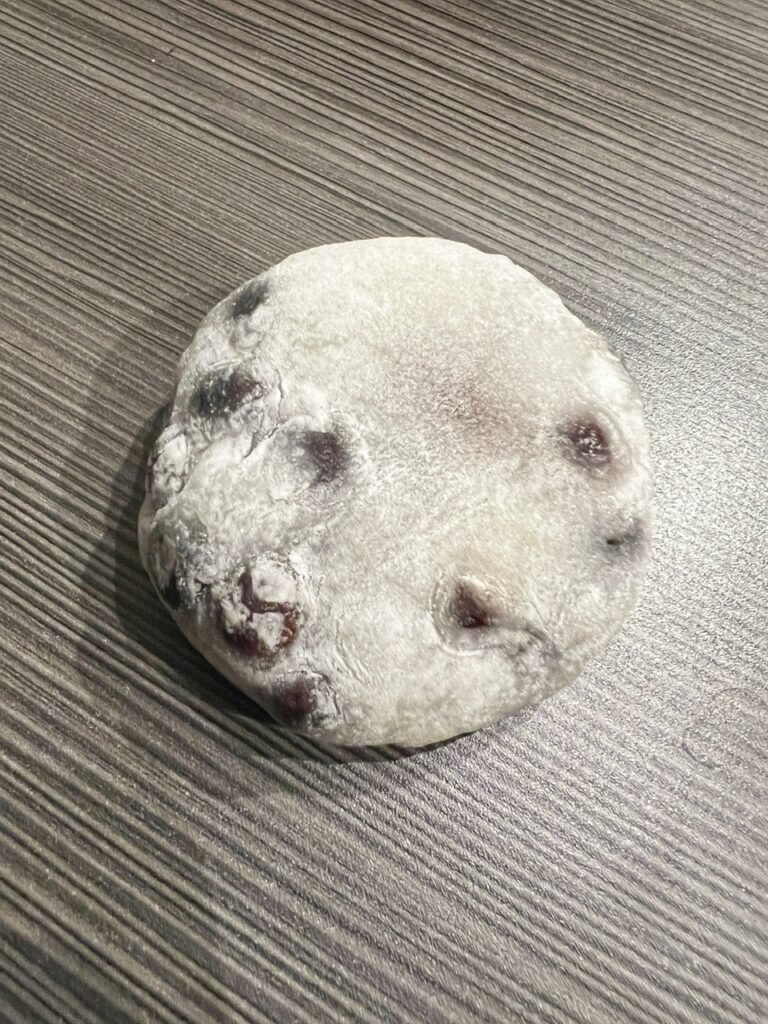
…and our first official kimonos and slippers. That night, we sat in our kimonos and enjoyed convenience store food in our room from our new find called, “My Basket,” which blows westernized Lawson and 7/Eleven out of the water on pricing. We even got four bananas for 120 yen, or $.80, compared to $1 each at 7/Eleven. We’re learning. Dessert that night included a new fav, which is not a weird looking chocolate chip cookie. It’s actually a milk powdered whipped bean treat. The outside feels oddly like skin making it strangely floppy and texturely pleasing.
That night we had a wonderful night sleep and were off on the next adventure in the morning…to Snow Monkey Land!


